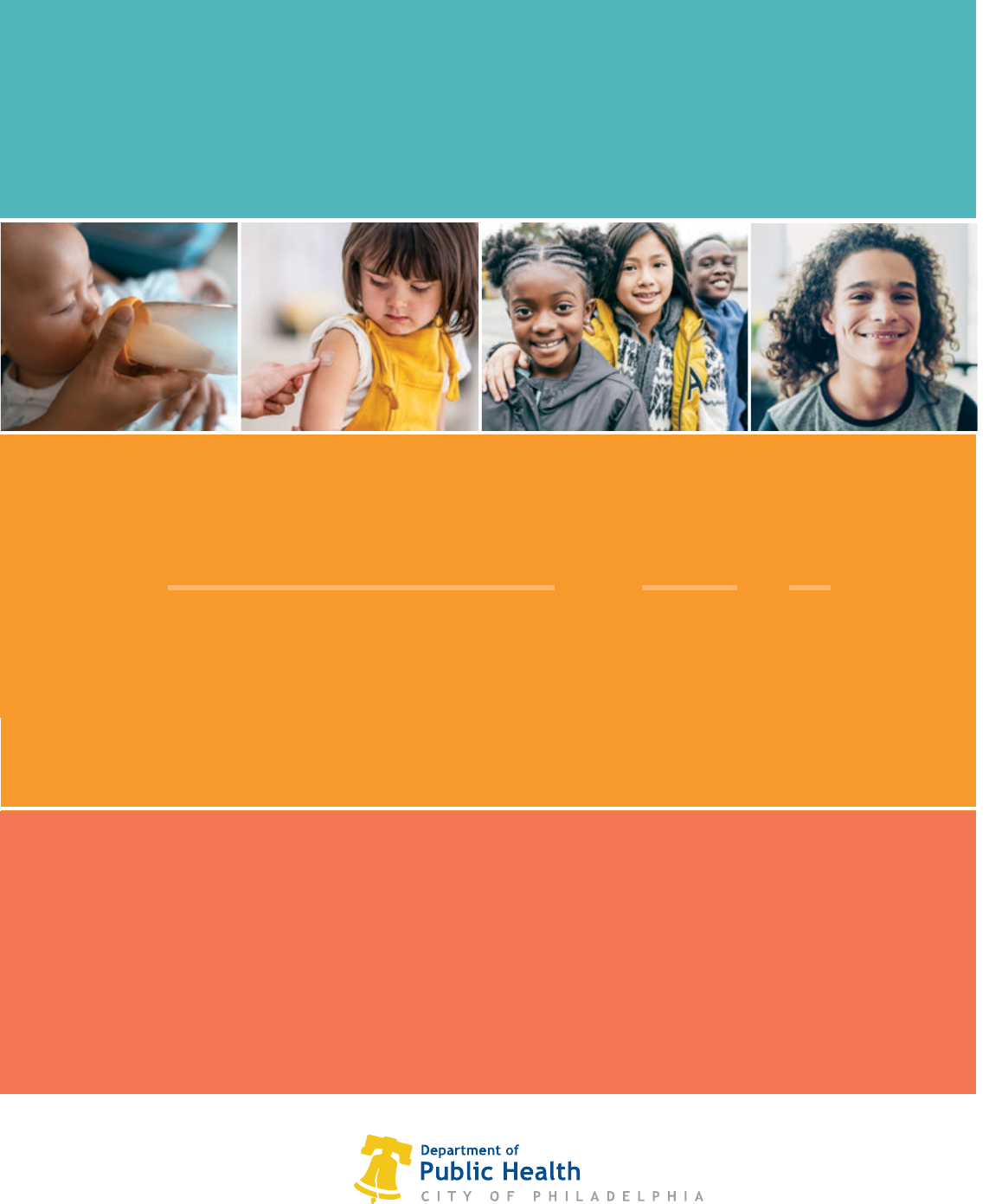
Growing Up
PHILLY
THE HEALTH AND WELL-BEING OF PHILADELPHIA’S CHILDREN

2 GROWING UP PHILLY: The Health and Well-being of Philadelphia’s Children
EXECUTIVE SUMMARY
Every child deserves to grow up in a healthy and nurturing environment. Experiences during
childhood such as poverty, poor nutrition, or exposure to environmental hazards can shape
and impact future health. Despite advances in pediatric care and public health efforts, poor
and racial/ethnic minority children still face a disproportionate burden of chronic disease,
premature death, and preventable illness. Growing Up Philly provides a summary of the
health and well-being of Philadelphia’s youngest citizens from birth to adolescence. As
the report shows, the health of Philadelphia’s children reflects the social and economic
problems they face, but also contains evidence of progress.
KEY FINDINGS:
1
2
3
» Prenatal care and
breastfeeding initiation have
increased by more than 50%
over the past decade.
» Preterm birth has slowly
declined by 15% over the
last decade to 11.1%.
» More than three-fourths of
children were up-to-date
with all five recommended
vaccines upon school entry
in the 2018-19 school year.
» In 2018, only 3.1 percent of
children did not have health
insurance coverage, which
was lower than the national
average (5.5 percent).
» Substantial declines in unhealthy behaviors such as cigarette
smoking and alcohol use have decreased by 87 percent and
46 percent, respectively, among youth since 2001.
» Non-Hispanic black and
Hispanic children had the
highest rates of asthma
-related hospitalizations,
with rates 5 to 6 times
higher than non-Hispanic
white children.
» More than 80% of childhood
deaths occurred in non-
Hispanic black and Hispanic
children.
Perinatal indicators,
immunization rates, and
health insurance coverage
have been improving.
There have been
improvements in teen
risk behavior indicators.
Across most health outcomes
and indicators, racial/ethnic
disparities continue to persist.
Many of these disparities are
largely driven by inequities
in the distribution of wealth.
In Philadelphia, one in three
children lives in poverty and
one in two lives in a single-
parent household.
Growing Up Philly aims to increase public awareness of
children’s health and identify gaps in knowledge. This
information can be used to monitor progress, evaluate existing
programs, and finally to inform local decision-making.
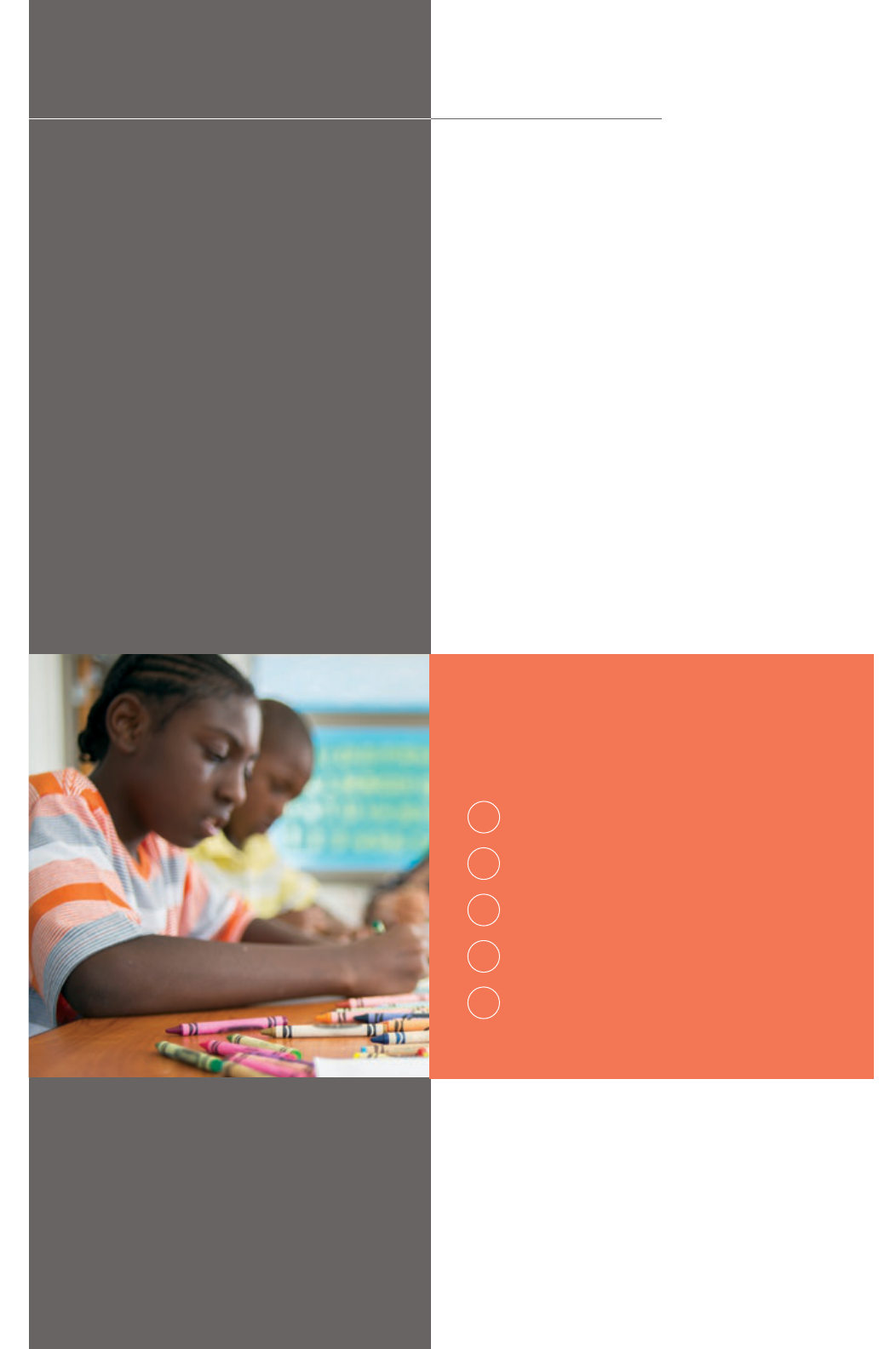
GROWING UP PHILLY: The Health and Well-being of Philadelphia’s Children 3
Summary Health Measures ...... 5
Health Outcomes ....................10
Behavioral Health ..................... 15
Health Behaviors
.........................21
Substance Use ........................ 25
Clinical & Preventive Care ........ 31
Physical Environment ............. 37
Social & Economic Factors ..... 40
INTRODUCTION
From the moment of conception, a child
grows in an environment that shapes his or
her long-term health.
During childhood, experiences such as poverty,
poor nutrition, or exposure to environmental hazards
can have lasting impacts on future health and
disease outcomes. In Philadelphia, racial/ethnic and
geographic disparities in children’s health reflect the
long history of discrimination and disenfranchisement
of communities of color.
Growing Up Philly summarizes the overall well-being
of Philadelphia’s children from birth to adolescence.
The Philadelphia Department of Public Health
developed this report to help healthcare providers,
city officials, decision-makers, parents, and
caregivers make well-informed decisions about
the city’s youngest residents.
Trends and patterns of several indicators
are summarized using various sources
of data across five areas:
HEALTH OUTCOMES
HEALTH BEHAVIORS
CLINICAL & PREVENTIVE CARE
PHYSICAL ENVIRONMENT
SOCIAL & ECONOMIC FACTORS
1
2
3
4
5
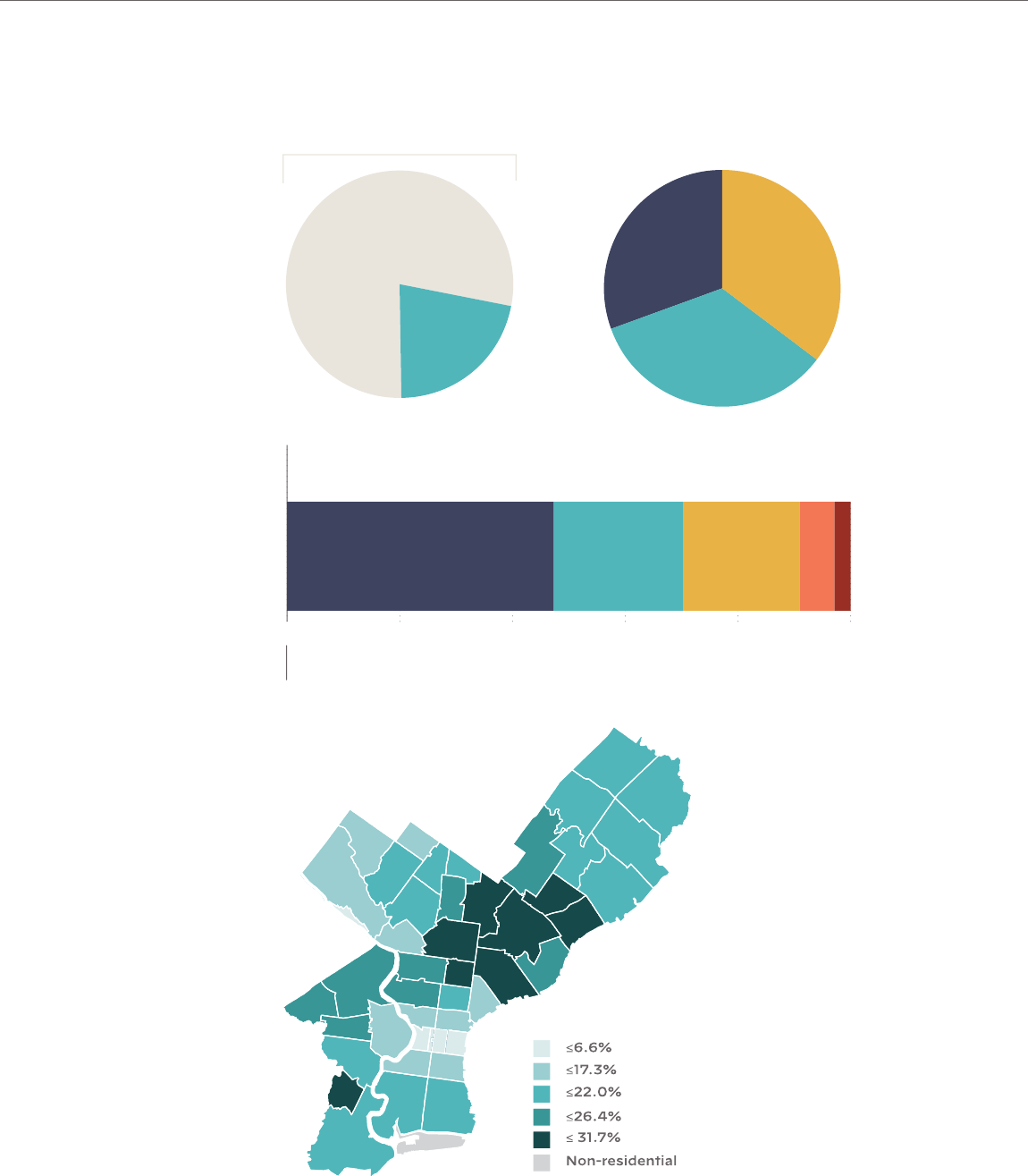
4 GROWING UP PHILLY: The Health and Well-being of Philadelphia’s Children
Age distribution
Race/Ethnicity
Leading cause of death among children
Child mortality rate
| per 100,000 children <18 years of age
Infant mortality rate
| per 1,000 live births
Children
ages 0-17
TOTAL POPULATION
OTHER*: 2.9%
ASIAN*
WHITE*
HISPANIC
BLACK*
0 200 400 600 800 1,000
Infectious Disease
Cancer
Drug Intoxication
Suicides
Motor
Vehicle Crashes
Cardiac Conditions
Congenital
Anomalies
Sleep-related
Infant Deaths
Homicides
Prematurity and
Perinatal Conditions
WHITE, ASIAN, OR OTHER
71.6%
BLACK OR HISPANIC
0 10 20 30 40 50 60 70 80
San Jose
San Diego
Los Angeles
New York County (NYC)
Kings County (NYC)
Bronx County (NYC)
Phoenix
Nationwide
San Antonio
Houston
Chicago
Dallas
Philadelphia
0
5
10
15
20
201820172016201520142013201220112010200920082007
Low birth weight
| by mother’s race/ethnicity
Preterm birth
| by mother’s race/ethnicity
Breastfeeding initiation
| by mother’s race/ethnicity
0%
2%
4%
6%
8%
10%
12%
14%
16%
201820172016201520142013201220112010200920082007
0%
2%
4%
6%
8%
10%
12%
14%
16%
18%
201820172016201520142013201220112010200920082007
0%
10%
20%
30%
40%
50%
60%
70%
80%
90%
100%
20172016201520142013201220112010200920082007
12.5
14.9%
7.3
9.9%
4.8
4.4
8.4%
7.0%
ASIAN*
HISPANIC
BLACK*
WHITE*
CITYWIDE
ASIAN*
HISPANIC
BLACK*
WHITE*
CITYWIDE
ASIAN*
HISPANIC
BLACK*
WHITE*
CITYWIDE
8.1
11.1%
14.1%
9.6%
8.4%
8.3%
11.1%
ASIAN*
HISPANIC
BLACK*
WHITE*
CITYWIDE
78.7%
79.6%
89.0%
86.0%
82.2%
Percent of population
that is under 18,
by zip code
0% 20% 40% 60% 80% 100%
47.3%
6.2%
20.7%
22.9%
19112
Children
12-17
34.1%
Children
6-11
30.4%
Children
<6
35.5%
Age distribution
Race/Ethnicity
Leading cause of death among children
Child mortality rate
| per 100,000 children <18 years of age
Infant mortality rate
| per 1,000 live births
Children
ages 0-17
TOTAL POPULATION
OTHER*: 2.9%
ASIAN*
WHITE*
HISPANIC
BLACK*
0 200 400 600 800 1,000
Infectious Disease
Cancer
Drug Intoxication
Suicides
Motor
Vehicle Crashes
Cardiac Conditions
Congenital
Anomalies
Sleep-related
Infant Deaths
Homicides
Prematurity and
Perinatal Conditions
WHITE, ASIAN, OR OTHER
71.6%
BLACK OR HISPANIC
0 10 20 30 40 50 60 70 80
San Jose
San Diego
Los Angeles
New York County (NYC)
Kings County (NYC)
Bronx County (NYC)
Phoenix
Nationwide
San Antonio
Houston
Chicago
Dallas
Philadelphia
0
5
10
15
20
201820172016201520142013201220112010200920082007
Low birth weight
| by mother’s race/ethnicity
Preterm birth
| by mother’s race/ethnicity
Breastfeeding initiation
| by mother’s race/ethnicity
0%
2%
4%
6%
8%
10%
12%
14%
16%
201820172016201520142013201220112010200920082007
0%
2%
4%
6%
8%
10%
12%
14%
16%
18%
201820172016201520142013201220112010200920082007
0%
10%
20%
30%
40%
50%
60%
70%
80%
90%
100%
20172016201520142013201220112010200920082007
12.5
14.9%
7.3
9.9%
4.8
4.4
8.4%
7.0%
ASIAN*
HISPANIC
BLACK*
WHITE*
CITYWIDE
ASIAN*
HISPANIC
BLACK*
WHITE*
CITYWIDE
ASIAN*
HISPANIC
BLACK*
WHITE*
CITYWIDE
8.1
11.1%
14.1%
9.6%
8.4%
8.3%
11.1%
ASIAN*
HISPANIC
BLACK*
WHITE*
CITYWIDE
78.7%
79.6%
89.0%
86.0%
82.2%
Percent of population
that is under 18,
by zip code
0% 20% 40% 60% 80% 100%
47.3%
6.2%
20.7%
22.9%
19112
Children
12-17
34.1%
Children
6-11
30.4%
Children
<6
35.5%
Age distribution
Race/Ethnicity
Leading cause of death among children
Child mortality rate
| per 100,000 children <18 years of age
Infant mortality rate
| per 1,000 live births
Children
ages 0-17
TOTAL POPULATION
OTHER*: 2.9%
ASIAN*
WHITE*
HISPANIC
BLACK*
0 200 400 600 800 1,000
Infectious Disease
Cancer
Drug Intoxication
Suicides
Motor
Vehicle Crashes
Cardiac Conditions
Congenital
Anomalies
Sleep-related
Infant Deaths
Homicides
Prematurity and
Perinatal Conditions
WHITE, ASIAN, OR OTHER
71.6%
BLACK OR HISPANIC
0 10 20 30 40 50 60 70 80
San Jose
San Diego
Los Angeles
New York County (NYC)
Kings County (NYC)
Bronx County (NYC)
Phoenix
Nationwide
San Antonio
Houston
Chicago
Dallas
Philadelphia
0
5
10
15
20
201820172016201520142013201220112010200920082007
Low birth weight
| by mother’s race/ethnicity
Preterm birth
| by mother’s race/ethnicity
Breastfeeding initiation
| by mother’s race/ethnicity
0%
2%
4%
6%
8%
10%
12%
14%
16%
201820172016201520142013201220112010200920082007
0%
2%
4%
6%
8%
10%
12%
14%
16%
18%
201820172016201520142013201220112010200920082007
0%
10%
20%
30%
40%
50%
60%
70%
80%
90%
100%
20172016201520142013201220112010200920082007
12.5
14.9%
7.3
9.9%
4.8
4.4
8.4%
7.0%
ASIAN*
HISPANIC
BLACK*
WHITE*
CITYWIDE
ASIAN*
HISPANIC
BLACK*
WHITE*
CITYWIDE
ASIAN*
HISPANIC
BLACK*
WHITE*
CITYWIDE
8.1
11.1%
14.1%
9.6%
8.4%
8.3%
11.1%
ASIAN*
HISPANIC
BLACK*
WHITE*
CITYWIDE
78.7%
79.6%
89.0%
86.0%
82.2%
Percent of population
that is under 18,
by zip code
0% 20% 40% 60% 80% 100%
47.3%
6.2%
20.7%
22.9%
19112
Children
12-17
34.1%
Children
6-11
30.4%
Children
<6
35.5%
Age distribution
Race/Ethnicity
Leading cause of death among children
Child mortality rate
| per 100,000 children <18 years of age
Infant mortality rate
| per 1,000 live births
Children
ages 0-17
TOTAL POPULATION
OTHER*: 2.9%
ASIAN*
WHITE*
HISPANIC
BLACK*
0 200 400 600 800 1,000
Infectious Disease
Cancer
Drug Intoxication
Suicides
Motor
Vehicle Crashes
Cardiac Conditions
Congenital
Anomalies
Sleep-related
Infant Deaths
Homicides
Prematurity and
Perinatal Conditions
WHITE, ASIAN, OR OTHER
71.6%
BLACK OR HISPANIC
0 10 20 30 40 50 60 70 80
San Jose
San Diego
Los Angeles
New York County (NYC)
Kings County (NYC)
Bronx County (NYC)
Phoenix
Nationwide
San Antonio
Houston
Chicago
Dallas
Philadelphia
0
5
10
15
20
201820172016201520142013201220112010200920082007
Low birth weight
| by mother’s race/ethnicity
Preterm birth
| by mother’s race/ethnicity
Breastfeeding initiation
| by mother’s race/ethnicity
0%
2%
4%
6%
8%
10%
12%
14%
16%
201820172016201520142013201220112010200920082007
0%
2%
4%
6%
8%
10%
12%
14%
16%
18%
201820172016201520142013201220112010200920082007
0%
10%
20%
30%
40%
50%
60%
70%
80%
90%
100%
20172016201520142013201220112010200920082007
12.5
14.9%
7.3
9.9%
4.8
4.4
8.4%
7.0%
ASIAN*
HISPANIC
BLACK*
WHITE*
CITYWIDE
ASIAN*
HISPANIC
BLACK*
WHITE*
CITYWIDE
ASIAN*
HISPANIC
BLACK*
WHITE*
CITYWIDE
8.1
11.1%
14.1%
9.6%
8.4%
8.3%
11.1%
ASIAN*
HISPANIC
BLACK*
WHITE*
CITYWIDE
78.7%
79.6%
89.0%
86.0%
82.2%
Percent of population
that is under 18,
by zip code
0% 20% 40% 60% 80% 100%
47.3%
6.2%
20.7%
22.9%
19112
Children
12-17
34.1%
Children
6-11
30.4%
Children
<6
35.5%
ABOUT PHILADELPHIA
Philadelphia has an estimated population of 344,091 children, representing 21.7 percent
of the City’s total population.
As of 2018, there were
122,512 children under
the age of 6 years, 117,310
children ages 6 to 11 years,
and 104,603 children ages
12 to 17 years.
SOURCE: 2018 American
Community Survey 1- Year Estimates,
US Census Bureau
Racial and ethnic minorities
make up the majority of
children in Philadelphia.
Age distribution
Race/Ethnicity
Leading cause of death among children
Child mortality rate
| per 100,000 children <18 years of age
Infant mortality rate
| per 1,000 live births
Children
ages 0-17
TOTAL POPULATION
OTHER*: 2.9%
ASIAN*
WHITE*
HISPANIC
BLACK*
0 200 400 600 800 1,000
Infectious Disease
Cancer
Drug Intoxication
Suicides
Motor
Vehicle Crashes
Cardiac Conditions
Congenital
Anomalies
Sleep-related
Infant Deaths
Homicides
Prematurity and
Perinatal Conditions
WHITE, ASIAN, OR OTHER
71.6%
BLACK OR HISPANIC
0 10 20 30 40 50 60 70 80
San Jose
San Diego
Los Angeles
New York County (NYC)
Kings County (NYC)
Bronx County (NYC)
Phoenix
Nationwide
San Antonio
Houston
Chicago
Dallas
Philadelphia
0
5
10
15
20
201820172016201520142013201220112010200920082007
Low birth weight
| by mother’s race/ethnicity
Preterm birth
| by mother’s race/ethnicity
Breastfeeding initiation
| by mother’s race/ethnicity
0%
2%
4%
6%
8%
10%
12%
14%
16%
201820172016201520142013201220112010200920082007
0%
2%
4%
6%
8%
10%
12%
14%
16%
18%
201820172016201520142013201220112010200920082007
0%
10%
20%
30%
40%
50%
60%
70%
80%
90%
100%
20172016201520142013201220112010200920082007
12.5
14.9%
7.3
9.9%
4.8
4.4
8.4%
7.0%
ASIAN*
HISPANIC
BLACK*
WHITE*
CITYWIDE
ASIAN*
HISPANIC
BLACK*
WHITE*
CITYWIDE
ASIAN*
HISPANIC
BLACK*
WHITE*
CITYWIDE
8.1
11.1%
14.1%
9.6%
8.4%
8.3%
11.1%
ASIAN*
HISPANIC
BLACK*
WHITE*
CITYWIDE
78.7%
79.6%
89.0%
86.0%
82.2%
Percent of population
that is under 18,
by zip code
0% 20% 40% 60% 80% 100%
47.3%
6.2%
20.7%
22.9%
19112
Children
12-17
34.1%
Children
6-11
30.4%
Children
<6
35.5%
SOURCE: 2018 American Community Survey 1- Year Estimates, US Census Bureau *Non-Hispanic
SOURCE: 2014-2018
American Community
Survey 5-Year Estimates,
US Census Bureau

Summary
Health
Measures
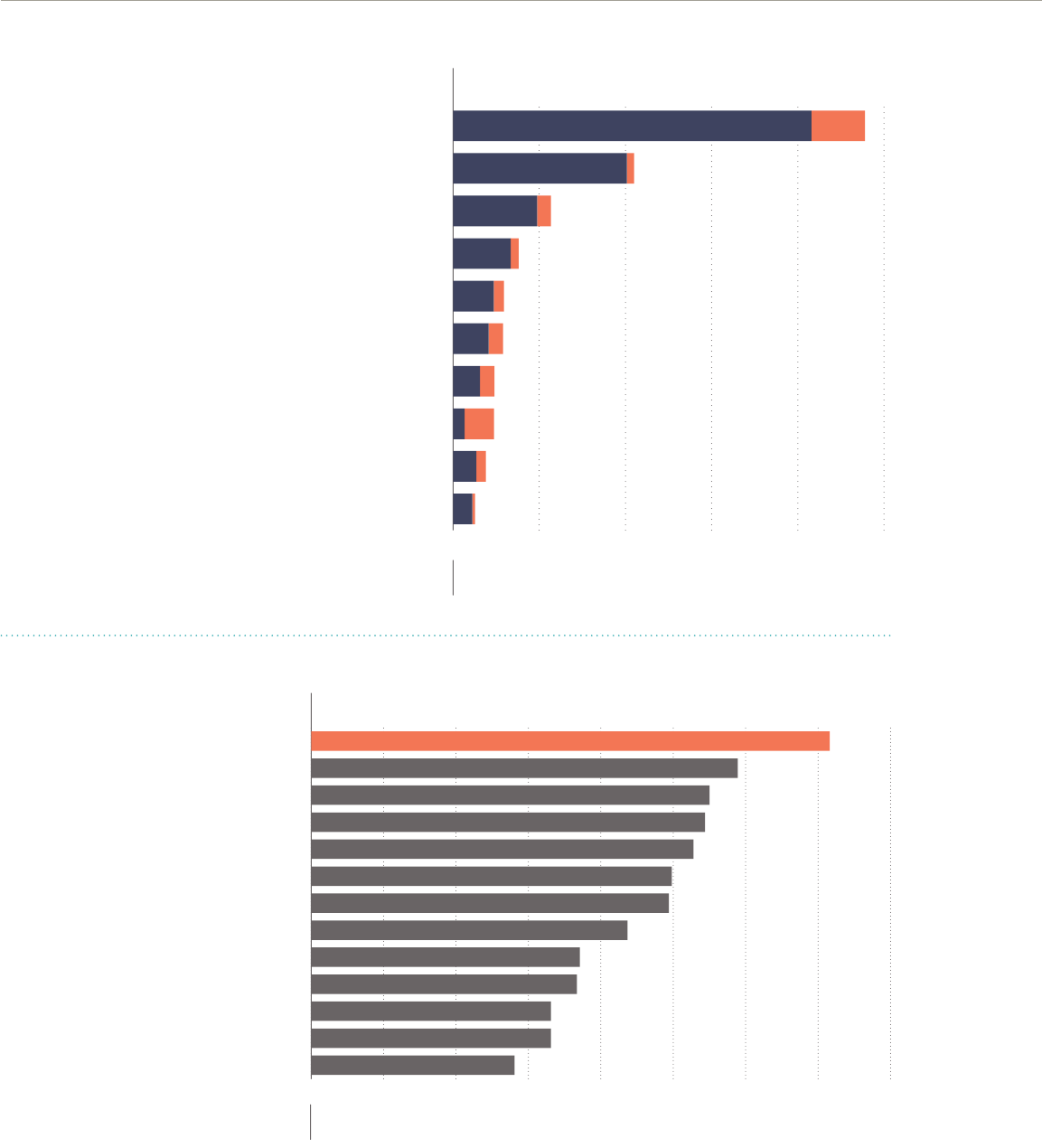
6 GROWING UP PHILLY: The Health and Well-being of Philadelphia’s Children
Age distribution
Race/Ethnicity
Leading cause of death among children
Child mortality rate
| per 100,000 children <18 years of age
Infant mortality rate
| per 1,000 live births
Children
ages 0-17
TOTAL POPULATION
OTHER*: 2.9%
ASIAN*
WHITE*
HISPANIC
BLACK*
0 200 400 600 800 1,000
Infectious Disease
Cancer
Drug Intoxication
Suicides
Motor
Vehicle Crashes
Cardiac Conditions
Congenital
Anomalies
Sleep-related
Infant Deaths
Homicides
Prematurity and
Perinatal Conditions
WHITE, ASIAN, OR OTHER
71.6%
BLACK OR HISPANIC
0 10 20 30 40 50 60 70 80
San Jose
San Diego
Los Angeles
New York County (NYC)
Kings County (NYC)
Bronx County (NYC)
Phoenix
Nationwide
San Antonio
Houston
Chicago
Dallas
Philadelphia
0
5
10
15
20
201820172016201520142013201220112010200920082007
Low birth weight
| by mother’s race/ethnicity
Preterm birth
| by mother’s race/ethnicity
Breastfeeding initiation
| by mother’s race/ethnicity
0%
2%
4%
6%
8%
10%
12%
14%
16%
201820172016201520142013201220112010200920082007
0%
2%
4%
6%
8%
10%
12%
14%
16%
18%
201820172016201520142013201220112010200920082007
0%
10%
20%
30%
40%
50%
60%
70%
80%
90%
100%
20172016201520142013201220112010200920082007
12.5
14.9%
7.3
9.9%
4.8
4.4
8.4%
7.0%
ASIAN*
HISPANIC
BLACK*
WHITE*
CITYWIDE
ASIAN*
HISPANIC
BLACK*
WHITE*
CITYWIDE
ASIAN*
HISPANIC
BLACK*
WHITE*
CITYWIDE
8.1
11.1%
14.1%
9.6%
8.4%
8.3%
11.1%
ASIAN*
HISPANIC
BLACK*
WHITE*
CITYWIDE
78.7%
79.6%
89.0%
86.0%
82.2%
Percent of population
that is under 18,
by zip code
0% 20% 40% 60% 80% 100%
47.3%
6.2%
20.7%
22.9%
19112
Children
12-17
34.1%
Children
6-11
30.4%
Children
<6
35.5%
Age distribution
Race/Ethnicity
Leading cause of death among children
Child mortality rate
| per 100,000 children <18 years of age
Infant mortality rate
| per 1,000 live births
Children
ages 0-17
TOTAL POPULATION
OTHER*: 2.9%
ASIAN*
WHITE*
HISPANIC
BLACK*
0 200 400 600 800 1,000
Infectious Disease
Cancer
Drug Intoxication
Suicides
Motor
Vehicle Crashes
Cardiac Conditions
Congenital
Anomalies
Sleep-related
Infant Deaths
Homicides
Prematurity and
Perinatal Conditions
WHITE, ASIAN, OR OTHER
71.6%
BLACK OR HISPANIC
0 10 20 30 40 50 60 70 80
San Jose
San Diego
Los Angeles
New York County (NYC)
Kings County (NYC)
Bronx County (NYC)
Phoenix
Nationwide
San Antonio
Houston
Chicago
Dallas
Philadelphia
0
5
10
15
20
201820172016201520142013201220112010200920082007
Low birth weight
| by mother’s race/ethnicity
Preterm birth
| by mother’s race/ethnicity
Breastfeeding initiation
| by mother’s race/ethnicity
0%
2%
4%
6%
8%
10%
12%
14%
16%
201820172016201520142013201220112010200920082007
0%
2%
4%
6%
8%
10%
12%
14%
16%
18%
201820172016201520142013201220112010200920082007
0%
10%
20%
30%
40%
50%
60%
70%
80%
90%
100%
20172016201520142013201220112010200920082007
12.5
14.9%
7.3
9.9%
4.8
4.4
8.4%
7.0%
ASIAN*
HISPANIC
BLACK*
WHITE*
CITYWIDE
ASIAN*
HISPANIC
BLACK*
WHITE*
CITYWIDE
ASIAN*
HISPANIC
BLACK*
WHITE*
CITYWIDE
8.1
11.1%
14.1%
9.6%
8.4%
8.3%
11.1%
ASIAN*
HISPANIC
BLACK*
WHITE*
CITYWIDE
78.7%
79.6%
89.0%
86.0%
82.2%
Percent of population
that is under 18,
by zip code
0% 20% 40% 60% 80% 100%
47.3%
6.2%
20.7%
22.9%
19112
Children
12-17
34.1%
Children
6-11
30.4%
Children
<6
35.5%
CHILD AND ADOLESCENT MORTALITY
Compared with other large cities
and counties in the United States,
Philadelphia had the highest child
mortality rate of 71.6 deaths per
100,000 children in 2017. This was
nearly 45 percent higher than the
national child mortality rate (49.5
deaths per 100,000 children).
Prematurity and perinatal
conditions were the
leading causes of death
among children from birth
to age 21 in Philadelphia
during 2011-2017.
Black and Hispanic children were
disproportionately impacted and
accounted for 70 percent or more
for eight of the top 10 categories of
child deaths, including 96 percent
of all homicides (not due to child
abuse).
SOURCE: 2017 Centers for Disease Control and Prevention, WONDER
SOURCE: 2011-2017 Philadelphia Child Death Review Report
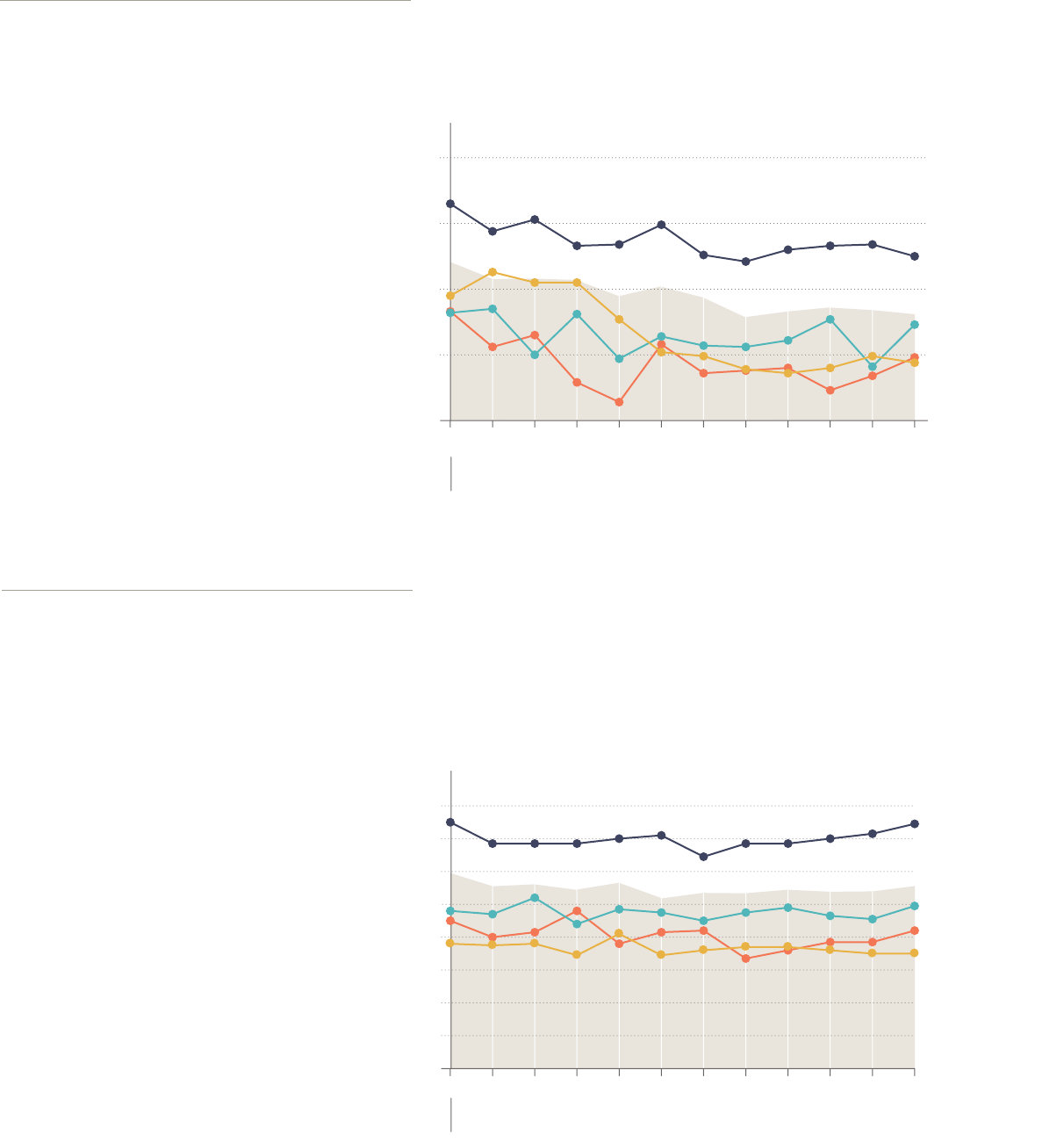
GROWING UP PHILLY: The Health and Well-being of Philadelphia’s Children 7
Age distribution
Race/Ethnicity
Leading cause of death among children
Child mortality rate
| per 100,000 children <18 years of age
Infant mortality rate
| per 1,000 live births
Children
ages 0-17
TOTAL POPULATION
OTHER*: 2.9%
ASIAN*
WHITE*
HISPANIC
BLACK*
0 200 400 600 800 1,000
Infectious Disease
Cancer
Drug Intoxication
Suicides
Motor
Vehicle Crashes
Cardiac Conditions
Congenital
Anomalies
Sleep-related
Infant Deaths
Homicides
Prematurity and
Perinatal Conditions
WHITE, ASIAN, OR OTHER
71.6%
BLACK OR HISPANIC
0 10 20 30 40 50 60 70 80
San Jose
San Diego
Los Angeles
New York County (NYC)
Kings County (NYC)
Bronx County (NYC)
Phoenix
Nationwide
San Antonio
Houston
Chicago
Dallas
Philadelphia
0
5
10
15
20
201820172016201520142013201220112010200920082007
Low birth weight
| by mother’s race/ethnicity
Preterm birth
| by mother’s race/ethnicity
Breastfeeding initiation
| by mother’s race/ethnicity
0%
2%
4%
6%
8%
10%
12%
14%
16%
201820172016201520142013201220112010200920082007
0%
2%
4%
6%
8%
10%
12%
14%
16%
18%
201820172016201520142013201220112010200920082007
0%
10%
20%
30%
40%
50%
60%
70%
80%
90%
100%
20172016201520142013201220112010200920082007
12.5
14.9%
7.3
9.9%
4.8
4.4
8.4%
7.0%
ASIAN*
HISPANIC
BLACK*
WHITE*
CITYWIDE
ASIAN*
HISPANIC
BLACK*
WHITE*
CITYWIDE
ASIAN*
HISPANIC
BLACK*
WHITE*
CITYWIDE
8.1
11.1%
14.1%
9.6%
8.4%
8.3%
11.1%
ASIAN*
HISPANIC
BLACK*
WHITE*
CITYWIDE
78.7%
79.6%
89.0%
86.0%
82.2%
Percent of population
that is under 18,
by zip code
0% 20% 40% 60% 80% 100%
47.3%
6.2%
20.7%
22.9%
19112
Children
12-17
34.1%
Children
6-11
30.4%
Children
<6
35.5%
Age distribution
Race/Ethnicity
Leading cause of death among children
Child mortality rate
| per 100,000 children <18 years of age
Infant mortality rate
| per 1,000 live births
Children
ages 0-17
TOTAL POPULATION
OTHER*: 2.9%
ASIAN*
WHITE*
HISPANIC
BLACK*
0 200 400 600 800 1,000
Infectious Disease
Cancer
Drug Intoxication
Suicides
Motor
Vehicle Crashes
Cardiac Conditions
Congenital
Anomalies
Sleep-related
Infant Deaths
Homicides
Prematurity and
Perinatal Conditions
WHITE, ASIAN, OR OTHER
71.6%
BLACK OR HISPANIC
0 10 20 30 40 50 60 70 80
San Jose
San Diego
Los Angeles
New York County (NYC)
Kings County (NYC)
Bronx County (NYC)
Phoenix
Nationwide
San Antonio
Houston
Chicago
Dallas
Philadelphia
0
5
10
15
20
201820172016201520142013201220112010200920082007
Low birth weight
| by mother’s race/ethnicity
Preterm birth
| by mother’s race/ethnicity
Breastfeeding initiation
| by mother’s race/ethnicity
0%
2%
4%
6%
8%
10%
12%
14%
16%
201820172016201520142013201220112010200920082007
0%
2%
4%
6%
8%
10%
12%
14%
16%
18%
201820172016201520142013201220112010200920082007
0%
10%
20%
30%
40%
50%
60%
70%
80%
90%
100%
20172016201520142013201220112010200920082007
12.5
14.9%
7.3
9.9%
4.8
4.4
8.4%
7.0%
ASIAN*
HISPANIC
BLACK*
WHITE*
CITYWIDE
ASIAN*
HISPANIC
BLACK*
WHITE*
CITYWIDE
ASIAN*
HISPANIC
BLACK*
WHITE*
CITYWIDE
8.1
11.1%
14.1%
9.6%
8.4%
8.3%
11.1%
ASIAN*
HISPANIC
BLACK*
WHITE*
CITYWIDE
78.7%
79.6%
89.0%
86.0%
82.2%
Percent of population
that is under 18,
by zip code
0% 20% 40% 60% 80% 100%
47.3%
6.2%
20.7%
22.9%
19112
Children
12-17
34.1%
Children
6-11
30.4%
Children
<6
35.5%
INFANT MORTALITY
Infant mortality is the death of an infant before his or her first birthday.
In Philadelphia, infant deaths
accounted for 55 percent of all
child deaths in 2011-2017. After
declining for several years, infant
mortality rates have remained
stable in recent years. In 2018,
the infant mortality rate was 8.1
per 1,000 live births, nearly 40
percent higher than the national
rate (5.8 per 1000 live births).
Despite advances in obstetrics,
pediatric care, and public health
efforts, the mortality rates
of black infants have been
consistently higher than the
rates of other racial and ethnic
groups. Many of these deaths
were due to prematurity and
perinatal conditions (65 percent)
and sleep-related deaths
(16 percent).
LOW BIRTH WEIGHT
In 2018, 1 in 11 infants was born low birth weight (weighing less than 2,500 grams at birth).
Infants with low birth weight are at risk for short- and long-term complications, including
sleep-related deaths and developmental delays.
1
Low birth weight is most
common among racial
minorities in Philadelphia,
especially black and African-
American mothers. There are
many contributing factors to
low birth weight, including
health conditions of mothers
and chronic stress associated
with racial discrimination.
2
SOURCE: 2007-2018 Vital Statistics, PDPH *Non-Hispanic
SOURCE: 2007- 2018 Vital Statistics, PDPH *Non-Hispanic
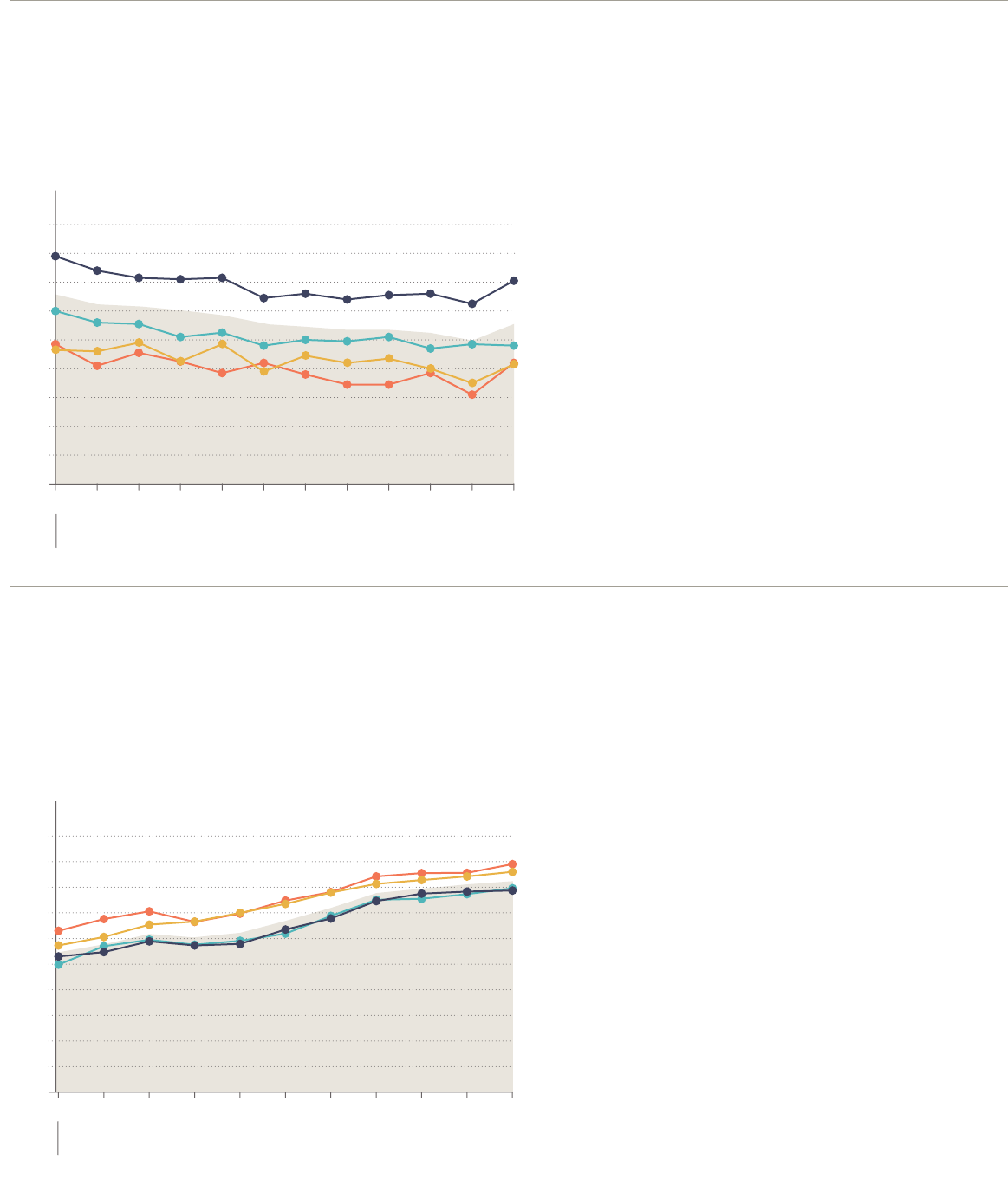
8 GROWING UP PHILLY: The Health and Well-being of Philadelphia’s Children
Age distribution
Race/Ethnicity
Leading cause of death among children
Child mortality rate
| per 100,000 children <18 years of age
Infant mortality rate
| per 1,000 live births
Children
ages 0-17
TOTAL POPULATION
OTHER*: 2.9%
ASIAN*
WHITE*
HISPANIC
BLACK*
0 200 400 600 800 1,000
Infectious Disease
Cancer
Drug Intoxication
Suicides
Motor
Vehicle Crashes
Cardiac Conditions
Congenital
Anomalies
Sleep-related
Infant Deaths
Homicides
Prematurity and
Perinatal Conditions
WHITE, ASIAN, OR OTHER
71.6%
BLACK OR HISPANIC
0 10 20 30 40 50 60 70 80
San Jose
San Diego
Los Angeles
New York County (NYC)
Kings County (NYC)
Bronx County (NYC)
Phoenix
Nationwide
San Antonio
Houston
Chicago
Dallas
Philadelphia
0
5
10
15
20
201820172016201520142013201220112010200920082007
Low birth weight
| by mother’s race/ethnicity
Preterm birth
| by mother’s race/ethnicity
Breastfeeding initiation
| by mother’s race/ethnicity
0%
2%
4%
6%
8%
10%
12%
14%
16%
201820172016201520142013201220112010200920082007
0%
2%
4%
6%
8%
10%
12%
14%
16%
18%
201820172016201520142013201220112010200920082007
0%
10%
20%
30%
40%
50%
60%
70%
80%
90%
100%
20172016201520142013201220112010200920082007
12.5
14.9%
7.3
9.9%
4.8
4.4
8.4%
7.0%
ASIAN*
HISPANIC
BLACK*
WHITE*
CITYWIDE
ASIAN*
HISPANIC
BLACK*
WHITE*
CITYWIDE
ASIAN*
HISPANIC
BLACK*
WHITE*
CITYWIDE
8.1
11.1%
14.1%
9.6%
8.4%
8.3%
11.1%
ASIAN*
HISPANIC
BLACK*
WHITE*
CITYWIDE
78.7%
79.6%
89.0%
86.0%
82.2%
Percent of population
that is under 18,
by zip code
0% 20%
40% 60% 80% 100%
47.3%
6.2%
20.7%
22.9%
19112
Children
12-17
34.1%
Children
6-11
30.4%
Children
<6
35.5%
Age distribution
Race/Ethnicity
Leading cause of death among children
Child mortality rate
| per 100,000 children <18 years of age
Infant mortality rate
| per 1,000 live births
Children
ages 0-17
TOTAL POPULATION
OTHER*: 2.9%
ASIAN*
WHITE*
HISPANIC
BLACK*
0 200 400 600 800 1,000
Infectious Disease
Cancer
Drug Intoxication
Suicides
Motor
Vehicle Crashes
Cardiac Conditions
Congenital
Anomalies
Sleep-related
Infant Deaths
Homicides
Prematurity and
Perinatal Conditions
WHITE, ASIAN, OR OTHER
71.6%
BLACK OR HISPANIC
0 10 20 30 40 50 60 70 80
San Jose
San Diego
Los Angeles
New York County (NYC)
Kings County (NYC)
Bronx County (NYC)
Phoenix
Nationwide
San Antonio
Houston
Chicago
Dallas
Philadelphia
0
5
10
15
20
201820172016201520142013201220112010200920082007
Low birth weight
| by mother’s race/ethnicity
Preterm birth
| by mother’s race/ethnicity
Breastfeeding initiation
| by mother’s race/ethnicity
0%
2%
4%
6%
8%
10%
12%
14%
16%
201820172016201520142013201220112010200920082007
0%
2%
4%
6%
8%
10%
12%
14%
16%
18%
201820172016201520142013201220112010200920082007
0%
10%
20%
30%
40%
50%
60%
70%
80%
90%
100%
20172016201520142013201220112010200920082007
12.5
14.9%
7.3
9.9%
4.8
4.4
8.4%
7.0%
ASIAN*
HISPANIC
BLACK*
WHITE*
CITYWIDE
ASIAN*
HISPANIC
BLACK*
WHITE*
CITYWIDE
ASIAN*
HISPANIC
BLACK*
WHITE*
CITYWIDE
8.1
11.1%
14.1%
9.6%
8.4%
8.3%
11.1%
ASIAN*
HISPANIC
BLACK*
WHITE*
CITYWIDE
78.7%
79.6%
89.0%
86.0%
82.2%
Percent of population
that is under 18,
by zip code
0% 20% 40% 60% 80% 100%
47.3%
6.2%
20.7%
22.9%
19112
Children
12-17
34.1%
Children
6-11
30.4%
Children
<6
35.5%
PRETERM BIRTH
The earlier an infant is born, the higher the risk of serious
disability and death. Infants born prematurely can have
serious complications, including difficulty breathing and
bleeding in their brains.
3
Preterm birth (when an
infant is born before 37
weeks of pregnancy) has
slowly declined in Philadelphia.
However, the prevalence
remained the highest among
non-Hispanic black women.
BREASTFEEDING INITIATION
The American Academy of Pediatrics recommends that
infants be exclusively breastfed for the first 6 months of
life.
4
Infants who are breastfed have a decreased risk of
asthma, obesity, ear and respiratory infections, and sudden
infant death syndrome.
5
The percentage of new mothers
in Philadelphia who initiated
breastfeeding has increased
over the past decade, with the
majority of mothers (82.2 percent)
breastfeeding in 2017. Overall,
breastfeeding initiation rates were
similar among all racial/ethnic
groups. The citywide estimate
was also similar to the state
(81.8 percent) and national (83.8
percent) prevalence estimates.
6
SOURCE: 2007-2018 Vital Statistics, PDPH *Non-Hispanic
SOURCE: 2007-2017 PA EDDIE; Vital Statistics, PDPH *Non-Hispanic
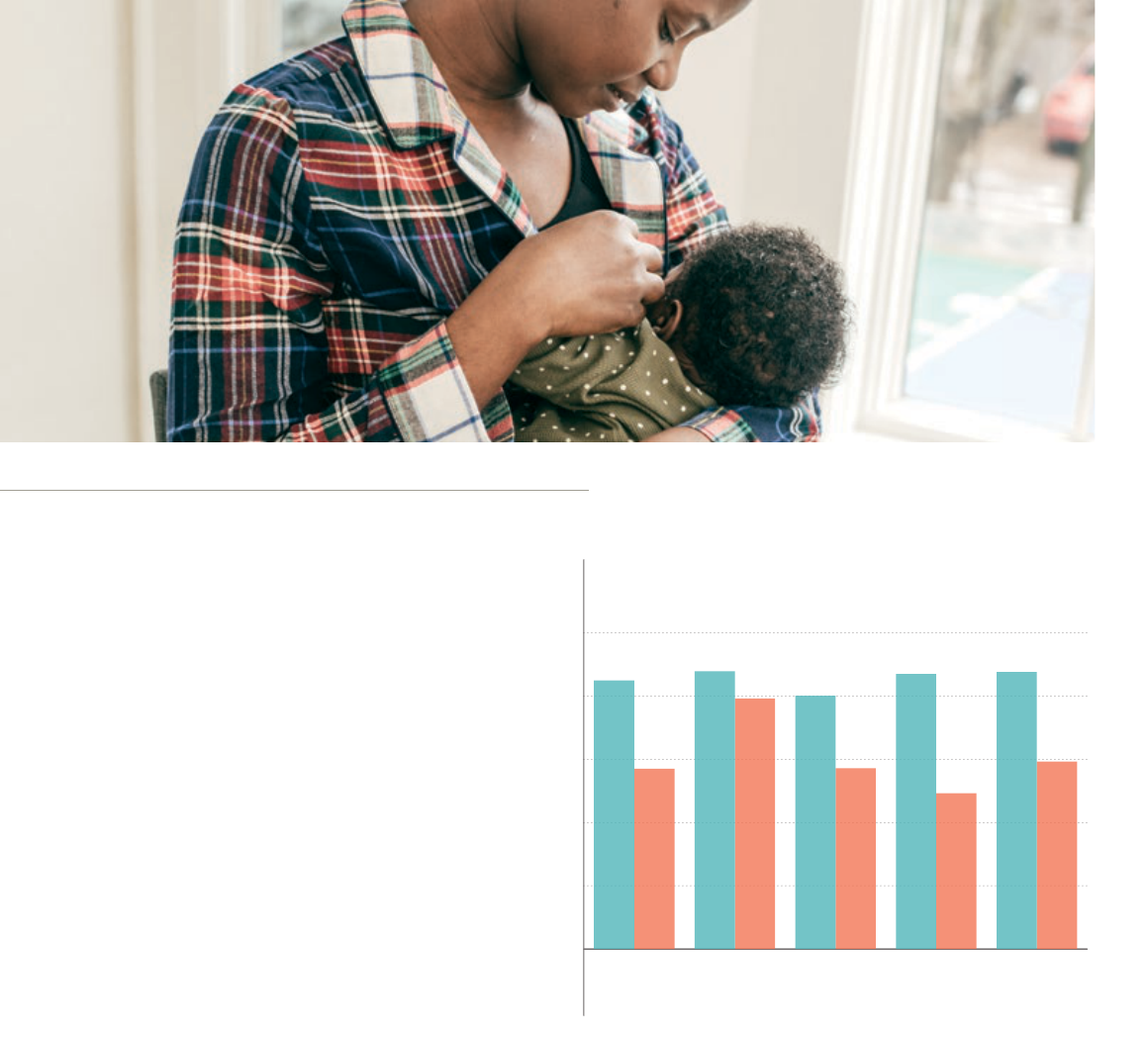
GROWING UP PHILLY: The Health and Well-being of Philadelphia’s Children 9
Kindergartners scoring at or above benchmarks
for competencies
| by race/ethnicity
21.4%
27.4%
37.1%
51.9%
32.1%
27.7%
25.1%
25.2%
31.4%
22.7%
43.3%
41.9%
5.3%
37.4%
23.8%
40.3%
83.2%
1.2%
1.0%
1.2%
2.2%
1.0%
12.4%
4.7%
21.6%
16.4%
59.3%
0%
20%
40%
60%
80%
100%
HispanicWhite*Black*
Depressive symptoms among teens
| by race/ethnicity and sex
Infant sleep chracteristics
Prenatal substance use among
Philly PRAMS respondents
MALE FEMALE
MALE FEMALE
13-15 year olds who have received
HPV vaccine
| by race/ethnicity
Adequate Prenatal Care
| by race/ethnicity
6,048
6,537
0%
10%
20%
30%
40%
50%
60%
70%
80%
Asian*Hispanic White* Black*Citywide
67.3%
71.9%
63.8%
73.6%
72.9%
0% 5% 10% 15% 20% 25% 30% 35%
White*
Multi-
racial*
Hispanic
Black*
Asian*
Learning
Engagement
Emerging
Academic
Learning
Engagement
Emerging
Academic
Learning
Engagement
Emerging
Academic
Learning
Engagement
Emerging
Academic
Learning
Engagement
Emerging
Academic
18.6%
18.6%
16.2%
10.8%
17.6%
14.6%
16.4%
17.3%
27.0%
22.0%
12.6%
19.4%
23.7%
25.1%
0%
20%
40%
60%
80%
100%
USUALLY
RARELY
NEVER
On their stomachOn their sideOn their back
10.9%
0% 3% 6% 9% 12% 15%
Prescription
pain relievers
Marijuana or hash
Synthetic
marijuana
Methadone, naxolone,
subutex, or Suboxone
Heroin
Amphetamines
Cocaine
Suicide attempts
| by sex and race/ethnicity
Breastfeeding duration 2–6 months postpartum
Breastfeeding indicators
16.2%
8.8%
12.8%
33.3%
57.0%
84.9%
87.8%
80.1%
87.0%
87.6%
79.2%
57.2%
49.3%
59.3%
44.4%
22.2%
10.1%
7.3%
11.1%
0%
5%
10%
15%
FEMALE
MALE
Hispanic White* Black*
0%
10%
20%
30%
40%
50%
17 weeks or more16 weeks< 16 weeks
0%
20%
40%
60%
80%
100%
Any breastfeeding or feeding
pumped milk at 8 weeks
Ever breastfed or
pumped breast milk
ASIAN*HISPANICBLACK*WHITE*ALL
0%
25%
50%
75%
100%
ASIAN*
AMERICAN INDIAN/
ALASKAN NATIVE*
HISPANIC
BLACK*
WHITE*
CITYWIDE
20182017201620152014201320122011201020092008
57.3%
57.3%
55.0%
54.5%
53.2%
52.8%
BREASTFEEDING DURATION
57 percent of Philadelphia
women were still breastfeeding
at the time they participated in
the Philadelphia Pregnancy Risk
Assessment Monitoring System,
a survey that asks portpartum
mothers about their behaviors and
experiences before, during, and
after pregnancy.
Note:
Reported estimates for non-Hispanic
Asian women may not be reliable due
to small sample sizes.
SOURCE: 2018 Philadelphia Pregnancy Risk Assessment Monitoring System
*Non-Hispanic
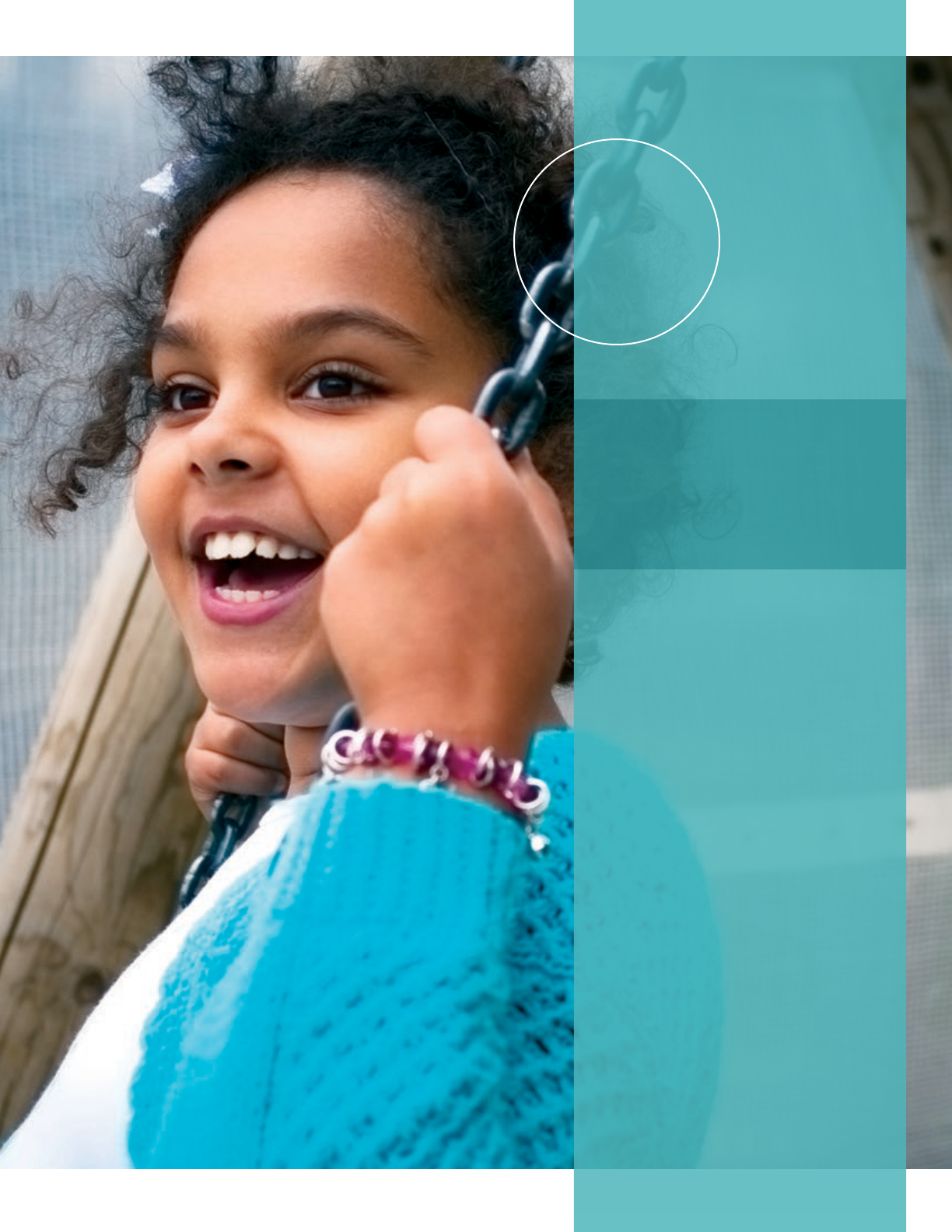
10 GROWING UP PHILLY: The Health and Well-being of Philadelphia’s Children
Health
Outcomes
1
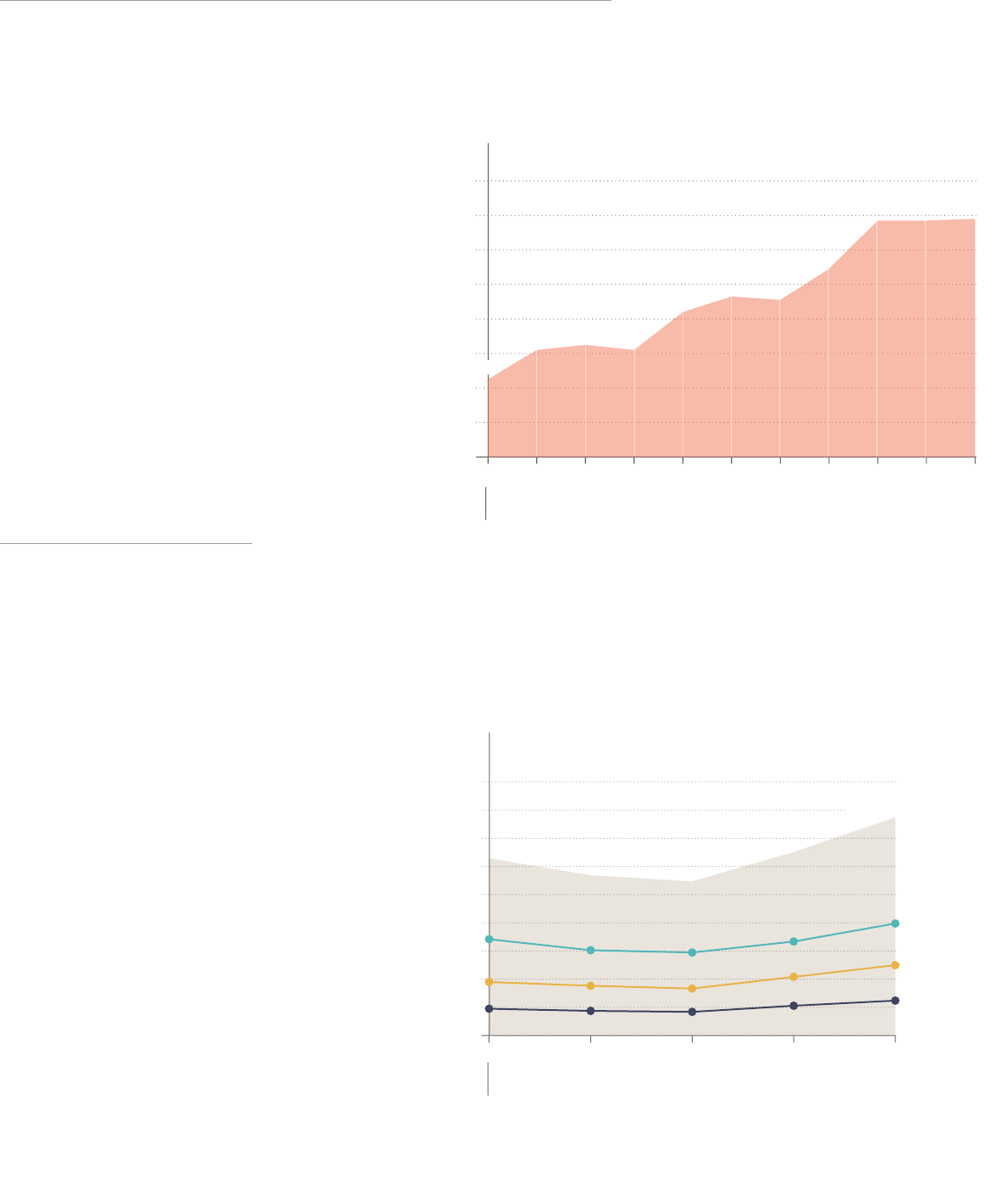
GROWING UP PHILLY: The Health and Well-being of Philadelphia’s Children 11
NEONATAL ABSTINENCE SYNDROME
Neonatal Abstinence Syndrome (NAS) is a condition that occurs when infants experience
withdrawal symptoms after being exposed to drugs in the womb.
7
The reported incidence rate
of NAS more than quadrupled
during 2002-2018 (from 3.1
per 1,000 live births to 13.8).
The substantial increase in
recent years is due to the use
of prescribed and illicit opioids
among pregnant women.
In 2018, the rate of NAS was
13.8 per 1,000 live births, nearly
two times the national rate and
four times the rate a decade ago
in Philadelphia.
8
0%
5%
10%
15%
20%
25%
30%
35%
40%
Attempted Suicide
Suicidal Thoughts
Heterosexual Teens LGBTQ+ TeensCitywide
Neonatal Abstinence Syndrome
| rate per 1,000 live births
Asthma-related
Emergency Department visits
| by age group
Asthma-related
Emergency Department visits
| by age group and sex
Asthma hospitalizations
| per 10,000 children by race/ethnicity
Asthma hospitalizations
among children
| by insurance status
Injury-related Emergency
Department visits
| by age group
Injury-related Emergency
Room visits
| by age group and sex
Youth entering an out-of-home placement
| by age* group
Asthma hospitalizations
| per 10,000 children (under age 18)
ASIAN
HISPANIC
BLACK
WHITE
CITYWIDE
7,951
4,992
2,447
13.8
13.713.7
10.9
17.4%
15,540
34.9%
13.8%
0
2,000
4,000
6,000
8,000
10,000
12,000
14,000
16,000
18,000
CITYWIDE
13-19 YRS
6-12 YRS
<6 YRS
13-19 YRS
6-12 YRS
<6 YRS
13-19 YRS
6-12 YRS
<6 YRS
20182017201620152014
0
2,000
4,000
6,000
8,000
10,000
12,000
14,000
16,000
18,000
13-19 yrs
6-12 yrs
< 6 yrs
TotalFemale Male
2,477
1,410
1,067
2,947
4,922
2,045
3,028
4,992
7,951
0
20
40
60
80
100
2018201720162015201420132012201120102009
0
10
20
30
40
50
60
70
80
ASIAN*HISPANICBLACK*WHITE*
12.9
0
300
600
900
1,200
1,500
UninsuredOtherMedicaid Private
Insurance
284
70.5
1,497
45
63.2
18.3
69
43,058
15,684
14,057
13,194
5,000
CITYWIDE
13-19 YRS
6-12 YRS
<6 YRS
10,000
15,000
20,000
25,000
30,000
35,000
40,000
45,000
50,000
Citywide
13-19 yrs
6-12 yrs
<6 yrs
20182017201620152014
0
10,000
20,000
30,000
40,000
50,000
13-19 yrs
6-12 yrs
< 6 yrs
TotalFemale Male
7,599
15,684
13,194
14,057
7,877
7,320
8,084
5,874
6,180
0
300
600
900
1,200
1,500
18+ years13-18 years6-12 years0-5 years
1,412
664
1,033
30
Obesity among children ages 5-18
| by race/ethnicity and sex
Teens who experienced cyberbullying
| by sex
0%
5%
10%
15%
20%
25%
30%
FEMALE
MALE
Asian*HispanicWhite*Black*Citywide
22.0%
20.4%
21.4%
27.5%
18.5%
21.8%
23.8%
20.3%
23.2%
10.3%
3%
6%
9%
12%
15%
FEMALE
MALE
CITYWIDE
CITYWIDE
FEMALE
MALE
20192017201520132011
10.3%
10.7%
11.8%
Depressive symptoms among teens
| by race/ethnicity
Depressive symptoms among teens
| by sexual orientation
Suicidal ideation and suicide attempts among teens
Suicidal ideation
| by sex and race/ethnicity
Suicidal ideation and attempts
| by sexual orientation
20%
30%
40%
50%
Hispanic/Latino
White
Black
201920172015201320112009200720032001
39.8%
41.6%
45.7%
22.0%
20.8%
11.6%
25.7%
20.2%
14.6%
22.0%
9.8%
17.5%
13.1%
38.3%
15.2%
12.6%
36.3%
59.0%
31.5%
29.8%
50.5%
40.3%
Depressive symptoms among teens
| by sex
20%
30%
40%
50%
60%
Citywide
Female %
Male %
201920172015201320112009200720032001
HISPANIC
BLACK*
WHITE*
0% 10% 20% 30% 40% 50% 60% 70%
Heterosexual Teens
LGBTQ+ Teens
Citywide
5%
10%
15%
20%
25%
Attempt
Thoughts
2019201720152013201120092007200520032001
0%
5%
10%
15%
20%
25%
FEMALE
MALE
Hispanic White* Black*
8.3%
Suicide-related Emergency Department
visits
| by age group and sex
0
100
200
300
400
500
600
<10 YRS
10-14 YRS
15-19 YRS
TotalMaleFemale
202
275
243
63
73
70
41
173
22
Opioid-related Emergency Department
visits
| by age group and sex
Tobacco use in the past 30 days among teens
Teens currently using vaping products
| by race/ethnicity
Current teen marijuana use
| by year
Opioid-related Emergency Department visits
among youth
0
200
400
600
800
1,000
<10
10-14
15-19
TotalMaleFemale
506
789
60
125
283
23
70
37
55
15.8%
2.1%
3.5%
7.2%
2.8%
4.7%
10.5%
8.6%
6.0%
6.6%
6.8%
5.2%
7.3%
21.0%
17.9%
21.6%
25.1%
21.3%
19.0%
18.8%
23.9%
160
232
201
224
161
21.4%
Prescription pain medication
misuse amoung teens
| by race/ethnicity
0%
3%
6%
9%
12%
15%
HispanicWhiteBlackCitywide
13.7%
14.7%
4.9%
9.9%
CITYWIDE
HISPANIC
BLACK*
WHITE*
<10 YRS
10-14 YRS
15-19 YRS
0%
5%
10%
15%
20%
Cigar Use
Cigarette Use
2019201720152013201120092007200520032001
0%
3%
6%
9%
12%
15%
HispanicWhite*Black*Citywide
7.1%
5.1%
14.3%
10.4%
10%
15%
20%
25%
30%
2019201720152013201120092007200520032001
58.8
59.5
71
85.6
97.1
98.8
94.6
71.2
55.1
0
2
4
6
8
10
12
14
16
20182017201620152014201320122011201020092008
9.1
9.3
8.4
6.2
6.5
6.2
4.5
SUICIDE
ATTEMPTS
SUICIDAL
IDEATION
SUICIDE
ATTEMPTS
SUICIDAL
IDEATION
0
100
200
300
400
20182017201620152014
13.9%
10.7% 10.8%
9.6%
7.5%
ASTHMA
Asthma is one of the most
common chronic diseases
during childhood and
causes wheezing, coughing,
and difficulty breathing.
While some children may
have mild symptoms,
others may suffer serious
asthma exacerbations
that result in visits to
the emergency room,
hospitalizations, or rarely,
death. Children living in
homes free of smoke, pests
and mold and with access
to asthma medications will
usually not need hospital
care for their asthma.
The number of asthma-
related visits to the emergency
department (ED) declined from
2014-2016 and was followed by
a 19 percent increase from 2017
to 2018.
In 2018, there were 15,450
asthma-related visits, with ED
visits being the highest among
children under the age of six.
0%
5%
10%
15%
20%
25%
30%
35%
40%
Attempted Suicide
Suicidal Thoughts
Heterosexual Teens LGBTQ+ TeensCitywide
Neonatal Abstinence Syndrome
| rate per 1,000 live births
Asthma-related
Emergency Department visits
| by age group
Asthma-related
Emergency Department visits
| by age group and sex
Asthma hospitalizations
| per 10,000 children by race/ethnicity
Asthma hospitalizations
among children
| by insurance status
Injury-related Emergency
Department visits
| by age group
Injury-related Emergency
Room visits
| by age group and sex
Youth entering an out-of-home placement
| by age* group
Asthma hospitalizations
| per 10,000 children (under age 18)
ASIAN
HISPANIC
BLACK
WHITE
CITYWIDE
7,951
4,992
2,447
13.8
13.713.7
10.9
17.4%
15,540
34.9%
13.8%
0
2,000
4,000
6,000
8,000
10,000
12,000
14,000
16,000
18,000
CITYWIDE
13-19 YRS
6-12 YRS
<6 YRS
13-19 YRS
6-12 YRS
<6 YRS
13-19 YRS
6-12 YRS
<6 YRS
20182017201620152014
0
2,000
4,000
6,000
8,000
10,000
12,000
14,000
16,000
18,000
13-19 yrs
6-12 yrs
< 6 yrs
TotalFemale Male
2,477
1,410
1,067
2,947
4,922
2,045
3,028
4,992
7,951
0
20
40
60
80
100
2018201720162015201420132012201120102009
0
10
20
30
40
50
60
70
80
ASIAN*HISPANICBLACK*WHITE*
12.9
0
300
600
900
1,200
1,500
UninsuredOtherMedicaid Private
Insurance
284
70.5
1,497
45
63.2
18.3
69
43,058
15,684
14,057
13,194
5,000
CITYWIDE
13-19 YRS
6-12 YRS
<6 YRS
10,000
15,000
20,000
25,000
30,000
35,000
40,000
45,000
50,000
Citywide
13-19 yrs
6-12 yrs
<6 yrs
20182017201620152014
0
10,000
20,000
30,000
40,000
50,000
13-19 yrs
6-12 yrs
< 6 yrs
TotalFemale Male
7,599
15,684
13,194
14,057
7,877
7,320
8,084
5,874
6,180
0
300
600
900
1,200
1,500
18+ years13-18 years6-12 years0-5 years
1,412
664
1,033
30
Obesity among children ages 5-18
| by race/ethnicity and sex
Teens who experienced cyberbullying
| by sex
0%
5%
10%
15%
20%
25%
30%
FEMALE
MALE
Asian*HispanicWhite*Black*Citywide
22.0%
20.4%
21.4%
27.5%
18.5%
21.8%
23.8%
20.3%
23.2%
10.3%
3%
6%
9%
12%
15%
FEMALE
MALE
CITYWIDE
CITYWIDE
FEMALE
MALE
20192017201520132011
10.3%
10.7%
11.8%
Depressive symptoms among teens
| by race/ethnicity
Depressive symptoms among teens
| by sexual orientation
Suicidal ideation and suicide attempts among teens
Suicidal ideation
| by sex and race/ethnicity
Suicidal ideation and attempts
| by sexual orientation
20%
30%
40%
50%
Hispanic/Latino
White
Black
201920172015201320112009200720032001
39.8%
41.6%
45.7%
22.0%
20.8%
11.6%
25.7%
20.2%
14.6%
22.0%
9.8%
17.5%
13.1%
38.3%
15.2%
12.6%
36.3%
59.0%
31.5%
29.8%
50.5%
40.3%
Depressive symptoms among teens
| by sex
20%
30%
40%
50%
60%
Citywide
Female %
Male %
201920172015201320112009200720032001
HISPANIC
BLACK*
WHITE*
0% 10% 20% 30% 40% 50% 60% 70%
Heterosexual Teens
LGBTQ+ Teens
Citywide
5%
10%
15%
20%
25%
Attempt
Thoughts
2019201720152013201120092007200520032001
0%
5%
10%
15%
20%
25%
FEMALE
MALE
Hispanic White* Black*
8.3%
Suicide-related Emergency Department
visits
| by age group and sex
0
100
200
300
400
500
600
<10 YRS
10-14 YRS
15-19 YRS
TotalMaleFemale
202
275
243
63
73
70
41
173
22
Opioid-related Emergency Department
visits
| by age group and sex
Tobacco use in the past 30 days among teens
Teens currently using vaping products
| by race/ethnicity
Current teen marijuana use
| by year
Opioid-related Emergency Department visits
among youth
0
200
400
600
800
1,000
<10
10-14
15-19
TotalMaleFemale
506
789
60
125
283
23
70
37
55
15.8%
2.1%
3.5%
7.2%
2.8%
4.7%
10.5%
8.6%
6.0%
6.6%
6.8%
5.2%
7.3%
21.0%
17.9%
21.6%
25.1%
21.3%
19.0%
18.8%
23.9%
160
232
201
224
161
21.4%
Prescription pain medication
misuse amoung teens
| by race/ethnicity
0%
3%
6%
9%
12%
15%
HispanicWhiteBlackCitywide
13.7%
14.7%
4.9%
9.9%
CITYWIDE
HISPANIC
BLACK*
WHITE*
<10 YRS
10-14 YRS
15-19 YRS
0%
5%
10%
15%
20%
Cigar Use
Cigarette Use
2019201720152013201120092 007200520032001
0%
3%
6%
9%
12%
15%
HispanicWhite*Black*Citywide
7.1%
5.1%
14.3%
10.4%
10%
15%
20%
25%
30%
2019201720152013201120092007200520032001
58.8
59.5
71
85.6
97.1
98.8
94.6
71.2
55.1
0
2
4
6
8
10
12
14
16
20182017201620152014201320122011201020092008
9.1
9.3
8.4
6.2
6.5
6.2
4.5
SUICIDE
ATTEMPTS
SUICIDAL
IDEATION
SUICIDE
ATTEMPTS
SUICIDAL
IDEATION
0
100
200
300
400
20182017201620152014
13.9%
10.7% 10.8%
9.6%
7.5%
SOURCE: 2014-2018 Syndromic Surveillance, PDPH
SOURCE: 2008-2018 Hospital Discharges, PA Health Care Cost Containment Council
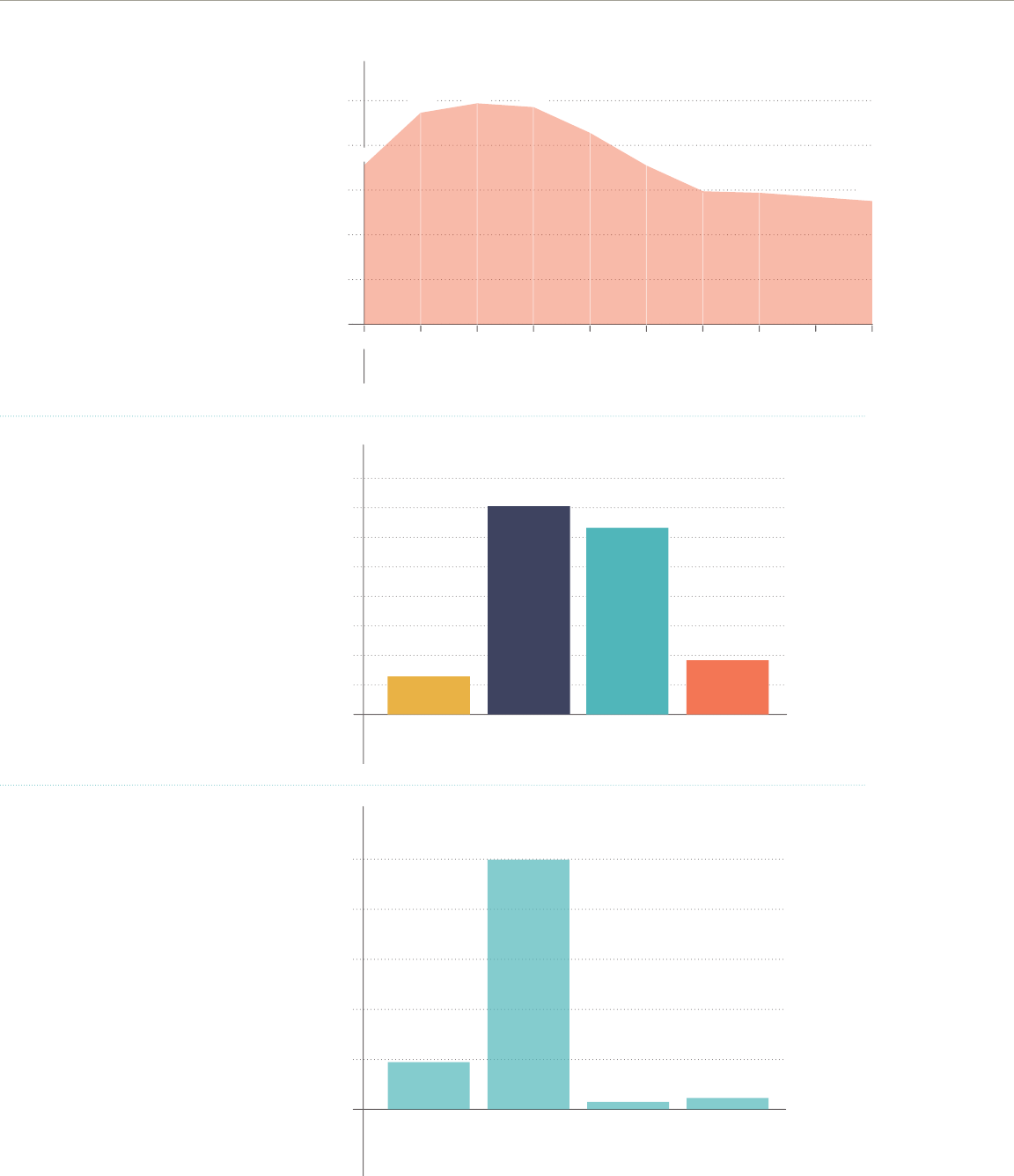
12 GROWING UP PHILLY: The Health and Well-being of Philadelphia’s Children
ASTHMA HOSPITALIZATIONS
Hospitalizations for asthma
reflect in part the severity
of asthma attacks and
in part the patterns of
medical practice.
In 2018, while ED visits
for asthma were increasing,
the rate of asthma-related
hospitalizations among children
in Philadelphia declined to a
low of 55.1 hospitalizations
per 10,000 children.
0%
5%
10%
15%
20%
25%
30%
35%
40%
Attempted Suicide
Suicidal Thoughts
Heterosexual Teens LGBTQ+ TeensCitywide
Neonatal Abstinence Syndrome
| rate per 1,000 live births
Asthma-related
Emergency Department visits
| by age group
Asthma-related
Emergency Department visits
| by age group and sex
Asthma hospitalizations
| per 10,000 children by race/ethnicity
Asthma hospitalizations
among children
| by insurance status
Injury-related Emergency
Department visits
| by age group
Injury-related Emergency
Room visits
| by age group and sex
Youth entering an out-of-home placement
| by age* group
Asthma hospitalizations
| per 10,000 children (under age 18)
ASIAN
HISPANIC
BLACK
WHITE
CITYWIDE
7,951
4,992
2,447
13.8
13.713.7
10.9
17.4%
15,540
34.9%
13.8%
0
2,000
4,000
6,000
8,000
10,000
12,000
14,000
16,000
18,000
CITYWIDE
13-19 YRS
6-12 YRS
<6 YRS
13-19 YRS
6-12 YRS
<6 YRS
13-19 YRS
6-12 YRS
<6 YRS
20182017201620152014
0
2,000
4,000
6,000
8,000
10,000
12,000
14,000
16,000
18,000
13-19 yrs
6-12 yrs
< 6 yrs
TotalFemale Male
2,477
1,410
1,067
2,947
4,922
2,045
3,028
4,992
7,951
0
20
40
60
80
100
2018201720162015201420132012201120102009
0
10
20
30
40
50
60
70
80
ASIAN*HISPANICBLACK*WHITE*
12.9
0
300
600
900
1,200
1,500
UninsuredOtherMedicaid Private
Insurance
284
70.5
1,497
45
63.2
18.3
69
43,058
15,684
14,057
13,194
5,000
CITYWIDE
13-19 YRS
6-12 YRS
<6 YRS
10,000
15,000
20,000
25,000
30,000
35,000
40,000
45,000
50,000
Citywide
13-19 yrs
6-12 yrs
<6 yrs
20182017201620152014
0
10,000
20,000
30,000
40,000
50,000
13-19 yrs
6-12 yrs
< 6 yrs
TotalFemale Male
7,599
15,684
13,194
14,057
7,877
7,320
8,084
5,874
6,180
0
300
600
900
1,200
1,500
18+ years13-18 years6-12 years0-5 years
1,412
664
1,033
30
Obesity among children ages 5-18
| by race/ethnicity and sex
Teens who experienced cyberbullying
| by sex
0%
5%
10%
15%
20%
25%
30%
FEMALE
MALE
Asian*HispanicWhite*Black*Citywide
22.0%
20.4%
21.4%
27.5%
18.5%
21.8%
23.8%
20.3%
23.2%
10.3%
3%
6%
9%
12%
15%
FEMALE
MALE
CITYWIDE
CITYWIDE
FEMALE
MALE
20192017201520132011
10.3%
10.7%
11.8%
Depressive symptoms among teens
| by race/ethnicity
Depressive symptoms among teens
| by sexual orientation
Suicidal ideation and suicide attempts among teens
Suicidal ideation
| by sex and race/ethnicity
Suicidal ideation and attempts
| by sexual orientation
20%
30%
40%
50%
Hispanic/Latino
White
Black
201920172015201320112009200720032001
39.8%
41.6%
45.7%
22.0%
20.8%
11.6%
25.7%
20.2%
14.6%
22.0%
9.8%
17.5%
13.1%
38.3%
15.2%
12.6%
36.3%
59.0%
31.5%
29.8%
50.5%
40.3%
Depressive symptoms among teens
| by sex
20%
30%
40%
50%
60%
Citywide
Female %
Male %
201920172015201320112009200720032001
HISPANIC
BLACK*
WHITE*
0% 10% 20% 30% 40% 50% 60% 70%
Heterosexual Teens
LGBTQ+ Teens
Citywide
5%
10%
15%
20%
25%
Attempt
Thoughts
2019201720152013201120092007200520032001
0%
5%
10%
15%
20%
25%
FEMALE
MALE
Hispanic White* Black*
8.3%
Suicide-related Emergency Department
visits
| by age group and sex
0
100
200
300
400
500
600
<10 YRS
10-14 YRS
15-19 YRS
TotalMaleFemale
202
275
243
63
73
70
41
173
22
Opioid-related Emergency Department
visits
| by age group and sex
Tobacco use in the past 30 days among teens
Teens currently using vaping products
| by race/ethnicity
Current teen marijuana use
| by year
Opioid-related Emergency Department visits
among youth
0
200
400
600
800
1,000
<10
10-14
15-19
TotalMaleFemale
506
789
60
125
283
23
70
37
55
15.8%
2.1%
3.5%
7.2%
2.8%
4.7%
10.5%
8.6%
6.0%
6.6%
6.8%
5.2%
7.3%
21.0%
17.9%
21.6%
25.1%
21.3%
19.0%
18.8%
23.9%
160
232
201
224
161
21.4%
Prescription pain medication
misuse amoung teens
| by race/ethnicity
0%
3%
6%
9%
12%
15%
HispanicWhiteBlackCitywide
13.7%
14.7%
4.9%
9.9%
CITYWIDE
HISPANIC
BLACK*
WHITE*
<10 YRS
10-14 YRS
15-19 YRS
0%
5%
10%
15%
20%
Cigar Use
Cigarette Use
2019201720152013201120092 007200520032001
0%
3%
6%
9%
12%
15%
HispanicWhite*Black*Citywide
7.1%
5.1%
14.3%
10.4%
10%
15%
20%
25%
30%
2019201720152013201120092007200520032001
58.8
59.5
71
85.6
97.1
98.8
94.6
71.2
55.1
0
2
4
6
8
10
12
14
16
20182017201620152014201320122011201020092008
9.1
9.3
8.4
6.2
6.5
6.2
4.5
SUICIDE
ATTEMPTS
SUICIDAL
IDEATION
SUICIDE
ATTEMPTS
SUICIDAL
IDEATION
0
100
200
300
400
20182017201620152014
13.9%
10.7% 10.8%
9.6%
7.5%
SOURCE: 2009-2018 Hospital Discharges, PA Health Care Cost Containment Council
In 2018, non-Hispanic black
and Hispanic children had the
highest rates of asthma-related
hospitalizations - with rates 5 to
6 times higher than non-Hispanic
white children.
Racial/ethnic differences in
asthma frequency, illness and
death are highly connected with
poverty, housing quality, and
indoor asthma triggers.
0%
5%
10%
15%
20%
25%
30%
35%
40%
Attempted Suicide
Suicidal Thoughts
Heterosexual Teens LGBTQ+ TeensCitywide
Neonatal Abstinence Syndrome
| rate per 1,000 live births
Asthma-related
Emergency Department visits
| by age group
Asthma-related
Emergency Department visits
| by age group and sex
Asthma hospitalizations
| per 10,000 children by race/ethnicity
Asthma hospitalizations
among children
| by insurance status
Injury-related Emergency
Department visits
| by age group
Injury-related Emergency
Room visits
| by age group and sex
Youth entering an out-of-home placement
| by age* group
Asthma hospitalizations
| per 10,000 children (under age 18)
ASIAN
HISPANIC
BLACK
WHITE
CITYWIDE
7,951
4,992
2,447
13.8
13.713.7
10.9
17.4%
15,540
34.9%
13.8%
0
2,000
4,000
6,000
8,000
10,000
12,000
14,000
16,000
18,000
CITYWIDE
13-19 YRS
6-12 YRS
<6 YRS
13-19 YRS
6-12 YRS
<6 YRS
13-19 YRS
6-12 YRS
<6 YRS
20182017201620152014
0
2,000
4,000
6,000
8,000
10,000
12,000
14,000
16,000
18,000
13-19 yrs
6-12 yrs
< 6 yrs
TotalFemale Male
2,477
1,410
1,067
2,947
4,922
2,045
3,028
4,992
7,951
0
20
40
60
80
100
2018201720162015201420132012201120102009
0
10
20
30
40
50
60
70
80
ASIAN*HISPANICBLACK*WHITE*
12.9
0
300
600
900
1,200
1,500
UninsuredOtherMedicaid Private
Insurance
284
70.5
1,497
45
63.2
18.3
69
43,058
15,684
14,057
13,194
5,000
CITYWIDE
13-19 YRS
6-12 YRS
<6 YRS
10,000
15,000
20,000
25,000
30,000
35,000
40,000
45,000
50,000
Citywide
13-19 yrs
6-12 yrs
<6 yrs
20182017201620152014
0
10,000
20,000
30,000
40,000
50,000
13-19 yrs
6-12 yrs
< 6 yrs
TotalFemale Male
7,599
15,684
13,194
14,057
7,877
7,320
8,084
5,874
6,180
0
300
600
900
1,200
1,500
18+ years13-18 years6-12 years0-5 years
1,412
664
1,033
30
Obesity among children ages 5-18
| by race/ethnicity and sex
Teens who experienced cyberbullying
| by sex
0%
5%
10%
15%
20%
25%
30%
FEMALE
MALE
Asian*HispanicWhite*Black*Citywide
22.0%
20.4%
21.4%
27.5%
18.5%
21.8%
23.8%
20.3%
23.2%
10.3%
3%
6%
9%
12%
15%
FEMALE
MALE
CITYWIDE
CITYWIDE
FEMALE
MALE
20192017201520132011
10.3%
10.7%
11.8%
Depressive symptoms among teens
| by race/ethnicity
Depressive symptoms among teens
| by sexual orientation
Suicidal ideation and suicide attempts among teens
Suicidal ideation
| by sex and race/ethnicity
Suicidal ideation and attempts
| by sexual orientation
20%
30%
40%
50%
Hispanic/Latino
White
Black
201920172015201320112009200720032001
39.8%
41.6%
45.7%
22.0%
20.8%
11.6%
25.7%
20.2%
14.6%
22.0%
9.8%
17.5%
13.1%
38.3%
15.2%
12.6%
36.3%
59.0%
31.5%
29.8%
50.5%
40.3%
Depressive symptoms among teens
| by sex
20%
30%
40%
50%
60%
Citywide
Female %
Male %
201920172015201320112009200720032001
HISPANIC
BLACK*
WHITE*
0% 10% 20% 30% 40% 50% 60% 70%
Heterosexual Teens
LGBTQ+ Teens
Citywide
5%
10%
15%
20%
25%
Attempt
Thoughts
2019201720152013201120092007200520032001
0%
5%
10%
15%
20%
25%
FEMALE
MALE
Hispanic White* Black*
8.3%
Suicide-related Emergency Department
visits
| by age group and sex
0
100
200
300
400
500
600
<10 YRS
10-14 YRS
15-19 YRS
TotalMaleFemale
202
275
243
63
73
70
41
173
22
Opioid-related Emergency Department
visits
| by age group and sex
Tobacco use in the past 30 days among teens
Teens currently using vaping products
| by race/ethnicity
Current teen marijuana use
| by year
Opioid-related Emergency Department visits
among youth
0
200
400
600
800
1,000
<10
10-14
15-19
TotalMaleFemale
506
789
60
125
283
23
70
37
55
15.8%
2.1%
3.5%
7.2%
2.8%
4.7%
10.5%
8.6%
6.0%
6.6%
6.8%
5.2%
7.3%
21.0%
17.9%
21.6%
25.1%
21.3%
19.0%
18.8%
23.9%
160
232
201
224
161
21.4%
Prescription pain medication
misuse amoung teens
| by race/ethnicity
0%
3%
6%
9%
12%
15%
HispanicWhiteBlackCitywide
13.7%
14.7%
4.9%
9.9%
CITYWIDE
HISPANIC
BLACK*
WHITE*
<10 YRS
10-14 YRS
15-19 YRS
0%
5%
10%
15%
20%
Cigar Use
Cigarette Use
2019201720152013201120092 007200520032001
0%
3%
6%
9%
12%
15%
HispanicWhite*Black*Citywide
7.1%
5.1%
14.3%
10.4%
10%
15%
20%
25%
30%
2019201720152013201120092007200520032001
58.8
59.5
71
85.6
97.1
98.8
94.6
71.2
55.1
0
2
4
6
8
10
12
14
16
20182017201620152014201320122011201020092008
9.1
9.3
8.4
6.2
6.5
6.2
4.5
SUICIDE
ATTEMPTS
SUICIDAL
IDEATION
SUICIDE
ATTEMPTS
SUICIDAL
IDEATION
0
100
200
300
400
20182017201620152014
13.9%
10.7% 10.8%
9.6%
7.5%
SOURCE: 2018 Syndromic Surveillance, PDPH *Non-Hispanic
0%
5%
10%
15%
20%
25%
30%
35%
40%
Attempted Suicide
Suicidal Thoughts
Heterosexual Teens LGBTQ+ TeensCitywide
Neonatal Abstinence Syndrome
| rate per 1,000 live births
Asthma-related
Emergency Department visits
| by age group
Asthma-related
Emergency Department visits
| by age group and sex
Asthma hospitalizations
| per 10,000 children by race/ethnicity
Asthma hospitalizations
among children
| by insurance status
Injury-related Emergency
Department visits
| by age group
Injury-related Emergency
Room visits
| by age group and sex
Youth entering an out-of-home placement
| by age* group
Asthma hospitalizations
| per 10,000 children (under age 18)
ASIAN
HISPANIC
BLACK
WHITE
CITYWIDE
7,951
4,992
2,447
13.8
13.713.7
10.9
17.4%
15,540
34.9%
13.8%
0
2,000
4,000
6,000
8,000
10,000
12,000
14,000
16,000
18,000
CITYWIDE
13-19 YRS
6-12 YRS
<6 YRS
13-19 YRS
6-12 YRS
<6 YRS
13-19 YRS
6-12 YRS
<6 YRS
20182017201620152014
0
2,000
4,000
6,000
8,000
10,000
12,000
14,000
16,000
18,000
13-19 yrs
6-12 yrs
< 6 yrs
TotalFemale Male
2,477
1,410
1,067
2,947
4,922
2,045
3,028
4,992
7,951
0
20
40
60
80
100
2018201720162015201420132012201120102009
0
10
20
30
40
50
60
70
80
ASIAN*HISPANICBLACK*WHITE*
12.9
0
300
600
900
1,200
1,500
UninsuredOtherMedicaid Private
Insurance
284
70.5
1,497
45
63.2
18.3
69
43,058
15,684
14,057
13,194
5,000
CITYWIDE
13-19 YRS
6-12 YRS
<6 YRS
10,000
15,000
20,000
25,000
30,000
35,000
40,000
45,000
50,000
Citywide
13-19 yrs
6-12 yrs
<6 yrs
20182017201620152014
0
10,000
20,000
30,000
40,000
50,000
13-19 yrs
6-12 yrs
< 6 yrs
TotalFemale Male
7,599
15,684
13,194
14,057
7,877
7,320
8,084
5,874
6,180
0
300
600
900
1,200
1,500
18+ years13-18 years6-12 years0-5 years
1,412
664
1,033
30
Obesity among children ages 5-18
| by race/ethnicity and sex
Teens who experienced cyberbullying
| by sex
0%
5%
10%
15%
20%
25%
30%
FEMALE
MALE
Asian*HispanicWhite*Black*Citywide
22.0%
20.4%
21.4%
27.5%
18.5%
21.8%
23.8%
20.3%
23.2%
10.3%
3%
6%
9%
12%
15%
FEMALE
MALE
CITYWIDE
CITYWIDE
FEMALE
MALE
20192017201520132011
10.3%
10.7%
11.8%
Depressive symptoms among teens
| by race/ethnicity
Depressive symptoms among teens
| by sexual orientation
Suicidal ideation and suicide attempts among teens
Suicidal ideation
| by sex and race/ethnicity
Suicidal ideation and attempts
| by sexual orientation
20%
30%
40%
50%
Hispanic/Latino
White
Black
201920172015201320112009200720032001
39.8%
41.6%
45.7%
22.0%
20.8%
11.6%
25.7%
20.2%
14.6%
22.0%
9.8%
17.5%
13.1%
38.3%
15.2%
12.6%
36.3%
59.0%
31.5%
29.8%
50.5%
40.3%
Depressive symptoms among teens
| by sex
20%
30%
40%
50%
60%
Citywide
Female %
Male %
201920172015201320112009200720032001
HISPANIC
BLACK*
WHITE*
0% 10% 20% 30% 40% 50% 60% 70%
Heterosexual Teens
LGBTQ+ Teens
Citywide
5%
10%
15%
20%
25%
Attempt
Thoughts
2019201720152013201120092007200520032001
0%
5%
10%
15%
20%
25%
FEMALE
MALE
Hispanic White* Black*
8.3%
Suicide-related Emergency Department
visits
| by age group and sex
0
100
200
300
400
500
600
<10 YRS
10-14 YRS
15-19 YRS
TotalMaleFemale
202
275
243
63
73
70
41
173
22
Opioid-related Emergency Department
visits
| by age group and sex
Tobacco use in the past 30 days among teens
Teens currently using vaping products
| by race/ethnicity
Current teen marijuana use
| by year
Opioid-related Emergency Department visits
among youth
0
200
400
600
800
1,000
<10
10-14
15-19
TotalMaleFemale
506
789
60
125
283
23
70
37
55
15.8%
2.1%
3.5%
7.2%
2.8%
4.7%
10.5%
8.6%
6.0%
6.6%
6.8%
5.2%
7.3%
21.0%
17.9%
21.6%
25.1%
21.3%
19.0%
18.8%
23.9%
160
232
201
224
161
21.4%
Prescription pain medication
misuse amoung teens
| by race/ethnicity
0%
3%
6%
9%
12%
15%
HispanicWhiteBlackCitywide
13.7%
14.7%
4.9%
9.9%
CITYWIDE
HISPANIC
BLACK*
WHITE*
<10 YRS
10-14 YRS
15-19 YRS
0%
5%
10%
15%
20%
Cigar Use
Cigarette Use
2019201720152013201120092 007200520032001
0%
3%
6%
9%
12%
15%
HispanicWhite*Black*Citywide
7.1%
5.1%
14.3%
10.4%
10%
15%
20%
25%
30%
2019201720152013201120092007200520032001
58.8
59.5
71
85.6
97.1
98.8
94.6
71.2
55.1
0
2
4
6
8
10
12
14
16
20182017201620152014201320122011201020092008
9.1
9.3
8.4
6.2
6.5
6.2
4.5
SUICIDE
ATTEMPTS
SUICIDAL
IDEATION
SUICIDE
ATTEMPTS
SUICIDAL
IDEATION
0
100
200
300
400
20182017201620152014
13.9%
10.7% 10.8%
9.6%
7.5%
Among the 1,865 asthma
hospitalizations for children in
2018, 1,497 of the cases were
covered under Medicaid public
health insurance.
SOURCE: 2018 Syndromic Surveillance, PDPH
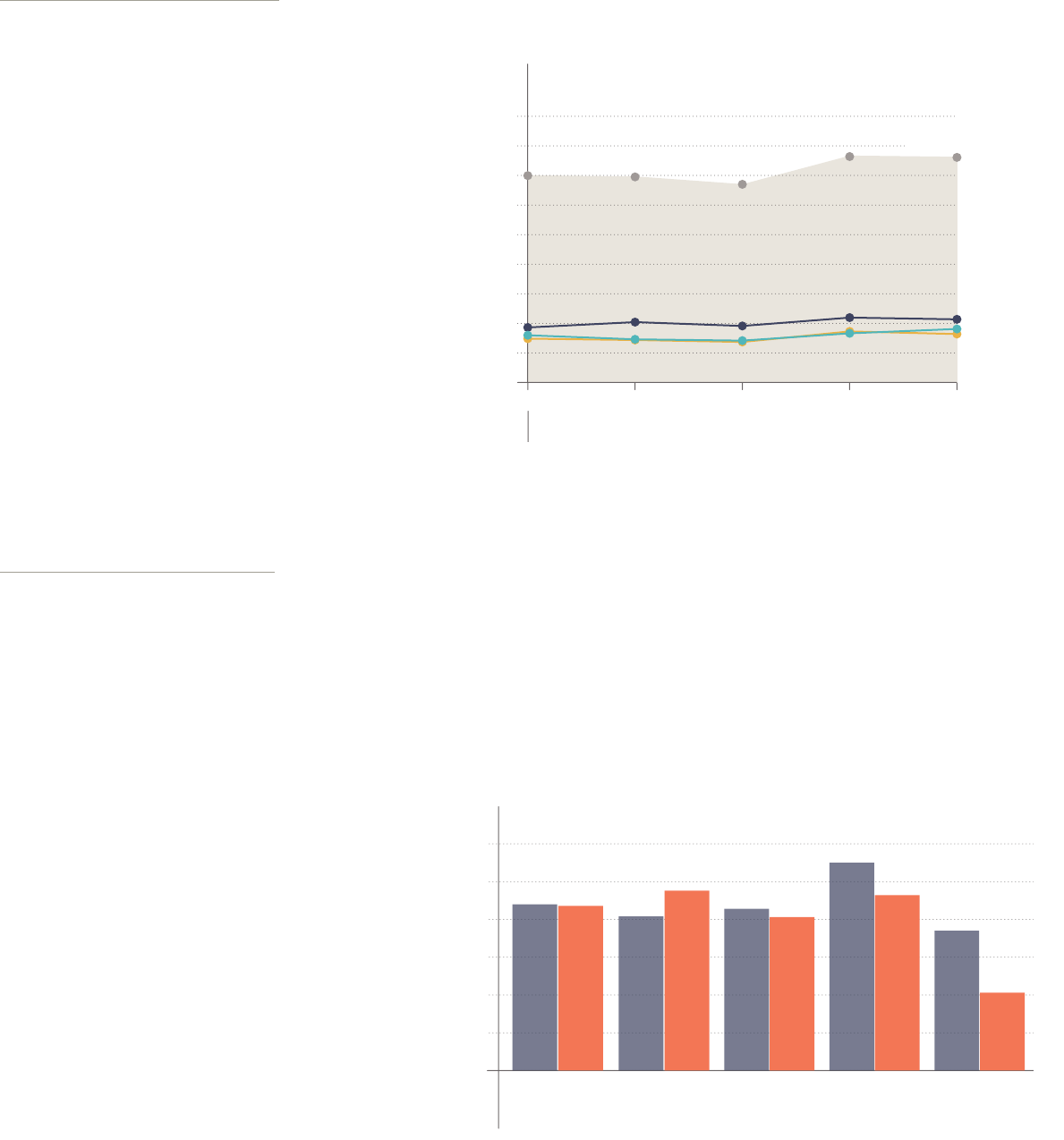
GROWING UP PHILLY: The Health and Well-being of Philadelphia’s Children 13
INJURIES
Unintentional injuries,
including falls, suffocation,
and motor vehicle accidents
among others, are a leading
cause of morbidity and
mortality for children.
Unintentional injuries can
often be fatal, especially
for children under the age
of six.
The number of injury-related
emergency department visits
among children in Philadelphia
remained stable from 2014 to 2016
and has risen from 2016 to 2018,
with 43,058 injury-related ED
visits in 2018.
0%
5%
10%
15%
20%
25%
30%
35%
40%
Attempted Suicide
Suicidal Thoughts
Heterosexual Teens LGBTQ+ TeensCitywide
Neonatal Abstinence Syndrome
| rate per 1,000 live births
Asthma-related
Emergency Department visits
| by age group
Asthma-related
Emergency Department visits
| by age group and sex
Asthma hospitalizations
| per 10,000 children by race/ethnicity
Asthma hospitalizations
among children
| by insurance status
Injury-related Emergency
Department visits
| by age group
Injury-related Emergency
Room visits
| by age group and sex
Youth entering an out-of-home placement
| by age* group
Asthma hospitalizations
| per 10,000 children (under age 18)
ASIAN
HISPANIC
BLACK
WHITE
CITYWIDE
7,951
4,992
2,447
13.8
13.713.7
10.9
17.4%
15,540
34.9%
13.8%
0
2,000
4,000
6,000
8,000
10,000
12,000
14,000
16,000
18,000
CITYWIDE
13-19 YRS
6-12 YRS
<6 YRS
13-19 YRS
6-12 YRS
<6 YRS
13-19 YRS
6-12 YRS
<6 YRS
20182017201620152014
0
2,000
4,000
6,000
8,000
10,000
12,000
14,000
16,000
18,000
13-19 yrs
6-12 yrs
< 6 yrs
TotalFemale Male
2,477
1,410
1,067
2,947
4,922
2,045
3,028
4,992
7,951
0
20
40
60
80
100
2018201720162015201420132012201120102009
0
10
20
30
40
50
60
70
80
ASIAN*HISPANICBLACK*WHITE*
12.9
0
300
600
900
1,200
1,500
UninsuredOtherMedicaid Private
Insurance
284
70.5
1,497
45
63.2
18.3
69
43,058
15,684
14,057
13,194
5,000
CITYWIDE
13-19 YRS
6-12 YRS
<6 YRS
10,000
15,000
20,000
25,000
30,000
35,000
40,000
45,000
50,000
Citywide
13-19 yrs
6-12 yrs
<6 yrs
20182017201620152014
0
10,000
20,000
30,000
40,000
50,000
13-19 yrs
6-12 yrs
< 6 yrs
TotalFemale Male
7,599
15,684
13,194
14,057
7,877
7,320
8,084
5,874
6,180
0
300
600
900
1,200
1,500
18+ years13-18 years6-12 years0-5 years
1,412
664
1,033
30
Obesity among children ages 5-18
| by race/ethnicity and sex
Teens who experienced cyberbullying
| by sex
0%
5%
10%
15%
20%
25%
30%
FEMALE
MALE
Asian*HispanicWhite*Black*Citywide
22.0%
20.4%
21.4%
27.5%
18.5%
21.8%
23.8%
20.3%
23.2%
10.3%
3%
6%
9%
12%
15%
FEMALE
MALE
CITYWIDE
CITYWIDE
FEMALE
MALE
20192017201520132011
10.3%
10.7%
11.8%
Depressive symptoms among teens
| by race/ethnicity
Depressive symptoms among teens
| by sexual orientation
Suicidal ideation and suicide attempts among teens
Suicidal ideation
| by sex and race/ethnicity
Suicidal ideation and attempts
| by sexual orientation
20%
30%
40%
50%
Hispanic/Latino
White
Black
201920172015201320112009200720032001
39.8%
41.6%
45.7%
22.0%
20.8%
11.6%
25.7%
20.2%
14.6%
22.0%
9.8%
17.5%
13.1%
38.3%
15.2%
12.6%
36.3%
59.0%
31.5%
29.8%
50.5%
40.3%
Depressive symptoms among teens
| by sex
20%
30%
40%
50%
60%
Citywide
Female %
Male %
201920172015201320112009200720032001
HISPANIC
BLACK*
WHITE*
0% 10% 20% 30% 40% 50% 60% 70%
Heterosexual Teens
LGBTQ+ Teens
Citywide
5%
10%
15%
20%
25%
Attempt
Thoughts
2019201720152013201120092007200520032001
0%
5%
10%
15%
20%
25%
FEMALE
MALE
Hispanic White* Black*
8.3%
Suicide-related Emergency Department
visits
| by age group and sex
0
100
200
300
400
500
600
<10 YRS
10-14 YRS
15-19 YRS
TotalMaleFemale
202
275
243
63
73
70
41
173
22
Opioid-related Emergency Department
visits
| by age group and sex
Tobacco use in the past 30 days among teens
Teens currently using vaping products
| by race/ethnicity
Current teen marijuana use
| by year
Opioid-related Emergency Department visits
among youth
0
200
400
600
800
1,000
<10
10-14
15-19
TotalMaleFemale
506
789
60
125
283
23
70
37
55
15.8%
2.1%
3.5%
7.2%
2.8%
4.7%
10.5%
8.6%
6.0%
6.6%
6.8%
5.2%
7.3%
21.0%
17.9%
21.6%
25.1%
21.3%
19.0%
18.8%
23.9%
160
232
201
224
161
21.4%
Prescription pain medication
misuse amoung teens
| by race/ethnicity
0%
3%
6%
9%
12%
15%
HispanicWhiteBlackCitywide
13.7%
14.7%
4.9%
9.9%
CITYWIDE
HISPANIC
BLACK*
WHITE*
<10 YRS
10-14 YRS
15-19 YRS
0%
5%
10%
15%
20%
Cigar Use
Cigarette Use
2019201720152013201120092 007200520032001
0%
3%
6%
9%
12%
15%
HispanicWhite*Black*Citywide
7.1%
5.1%
14.3%
10.4%
10%
15%
20%
25%
30%
2019201720152013201120092007200520032001
58.8
59.5
71
85.6
97.1
98.8
94.6
71.2
55.1
0
2
4
6
8
10
12
14
16
20182017201620152014201320122011201020092008
9.1
9.3
8.4
6.2
6.5
6.2
4.5
SUICIDE
ATTEMPTS
SUICIDAL
IDEATION
SUICIDE
ATTEMPTS
SUICIDAL
IDEATION
0
100
200
300
400
20182017201620152014
13.9%
10.7% 10.8%
9.6%
7.5%
SOURCE: 2014-2018 Syndromic Surveillance, PDPH
0%
5%
10%
15%
20%
25%
30%
35%
40%
Attempted Suicide
Suicidal Thoughts
Heterosexual Teens LGBTQ+ TeensCitywide
Neonatal Abstinence Syndrome
| rate per 1,000 live births
Asthma-related
Emergency Department visits
| by age group
Asthma-related
Emergency Department visits
| by age group and sex
Asthma hospitalizations
| per 10,000 children by race/ethnicity
Asthma hospitalizations
among children
| by insurance status
Injury-related Emergency
Department visits
| by age group
Injury-related Emergency
Room visits
| by age group and sex
Youth entering an out-of-home placement
| by age* group
Asthma hospitalizations
| per 10,000 children (under age 18)
ASIAN
HISPANIC
BLACK
WHITE
CITYWIDE
7,951
4,992
2,447
13.8
13.713.7
10.9
17.4%
15,540
34.9%
13.8%
0
2,000
4,000
6,000
8,000
10,000
12,000
14,000
16,000
18,000
CITYWIDE
13-19 YRS
6-12 YRS
<6 YRS
13-19 YRS
6-12 YRS
<6 YRS
13-19 YRS
6-12 YRS
<6 YRS
20182017201620152014
0
2,000
4,000
6,000
8,000
10,000
12,000
14,000
16,000
18,000
13-19 yrs
6-12 yrs
< 6 yrs
TotalFemale Male
2,477
1,410
1,067
2,947
4,922
2,045
3,028
4,992
7,951
0
20
40
60
80
100
2018201720162015201420132012201120102009
0
10
20
30
40
50
60
70
80
ASIAN*HISPANICBLACK*WHITE*
12.9
0
300
600
900
1,200
1,500
UninsuredOtherMedicaid Private
Insurance
284
70.5
1,497
45
63.2
18.3
69
43,058
15,684
14,057
13,194
5,000
CITYWIDE
13-19 YRS
6-12 YRS
<6 YRS
10,000
15,000
20,000
25,000
30,000
35,000
40,000
45,000
50,000
Citywide
13-19 yrs
6-12 yrs
<6 yrs
20182017201620152014
0
10,000
20,000
30,000
40,000
50,000
13-19 yrs
6-12 yrs
< 6 yrs
TotalFemale Male
7,599
15,684
13,194
14,057
7,877
7,320
8,084
5,874
6,180
0
300
600
900
1,200
1,500
18+ years13-18 years6-12 years0-5 years
1,412
664
1,033
30
Obesity among children ages 5-18
| by race/ethnicity and sex
Teens who experienced cyberbullying
| by sex
0%
5%
10%
15%
20%
25%
30%
FEMALE
MALE
Asian*HispanicWhite*Black*Citywide
22.0%
20.4%
21.4%
27.5%
18.5%
21.8%
23.8%
20.3%
23.2%
10.3%
3%
6%
9%
12%
15%
FEMALE
MALE
CITYWIDE
CITYWIDE
FEMALE
MALE
20192017201520132011
10.3%
10.7%
11.8%
Depressive symptoms among teens
| by race/ethnicity
Depressive symptoms among teens
| by sexual orientation
Suicidal ideation and suicide attempts among teens
Suicidal ideation
| by sex and race/ethnicity
Suicidal ideation and attempts
| by sexual orientation
20%
30%
40%
50%
Hispanic/Latino
White
Black
201920172015201320112009200720032001
39.8%
41.6%
45.7%
22.0%
20.8%
11.6%
25.7%
20.2%
14.6%
22.0%
9.8%
17.5%
13.1%
38.3%
15.2%
12.6%
36.3%
59.0%
31.5%
29.8%
50.5%
40.3%
Depressive symptoms among teens
| by sex
20%
30%
40%
50%
60%
Citywide
Female %
Male %
201920172015201320112009200720032001
HISPANIC
BLACK*
WHITE*
0% 10% 20% 30% 40% 50% 60% 70%
Heterosexual Teens
LGBTQ+ Teens
Citywide
5%
10%
15%
20%
25%
Attempt
Thoughts
2019201720152013201120092007200520032001
0%
5%
10%
15%
20%
25%
FEMALE
MALE
Hispanic White* Black*
8.3%
Suicide-related Emergency Department
visits
| by age group and sex
0
100
200
300
400
500
600
<10 YRS
10-14 YRS
15-19 YRS
TotalMaleFemale
202
275
243
63
73
70
41
173
22
Opioid-related Emergency Department
visits
| by age group and sex
Tobacco use in the past 30 days among teens
Teens currently using vaping products
| by race/ethnicity
Current teen marijuana use
| by year
Opioid-related Emergency Department visits
among youth
0
200
400
600
800
1,000
<10
10-14
15-19
TotalMaleFemale
506
789
60
125
283
23
70
37
55
15.8%
2.1%
3.5%
7.2%
2.8%
4.7%
10.5%
8.6%
6.0%
6.6%
6.8%
5.2%
7.3%
21.0%
17.9%
21.6%
25.1%
21.3%
19.0%
18.8%
23.9%
160
232
201
224
161
21.4%
Prescription pain medication
misuse amoung teens
| by race/ethnicity
0%
3%
6%
9%
12%
15%
HispanicWhiteBlackCitywide
13.7%
14.7%
4.9%
9.9%
CITYWIDE
HISPANIC
BLACK*
WHITE*
<10 YRS
10-14 YRS
15-19 YRS
0%
5%
10%
15%
20%
Cigar Use
Cigarette Use
2019201720152013201120092 007200520032001
0%
3%
6%
9%
12%
15%
HispanicWhite*Black*Citywide
7.1%
5.1%
14.3%
10.4%
10%
15%
20%
25%
30%
2019201720152013201120092007200520032001
58.8
59.5
71
85.6
97.1
98.8
94.6
71.2
55.1
0
2
4
6
8
10
12
14
16
20182017201620152014201320122011201020092008
9.1
9.3
8.4
6.2
6.5
6.2
4.5
SUICIDE
ATTEMPTS
SUICIDAL
IDEATION
SUICIDE
ATTEMPTS
SUICIDAL
IDEATION
0
100
200
300
400
20182017201620152014
13.9%
10.7% 10.8%
9.6%
7.5%
SOURCE: 2015-2016 School District of Philadelphia *Non-Hispanic
OBESITY
Obesity in childhood is
defined as a body mass
index at or above the 95th
percentile for children of the
same age and sex. Children
who have obesity are
more likely to be obese as
adults. Childhood obesity
is also associated with a
higher risk of chronic health
outcomes, including heart
disease, type 2 diabetes,
and asthma.
9
The high proportion of obese
children in Philadelphia contributes
to the adult obesity epidemic in
the region.
21.9 percent of children in
Philadelphia aged 5 to 18
were obese in 2016. Obesity
was more common among both
non-Hispanic black girls and
Hispanic/Latino boys.
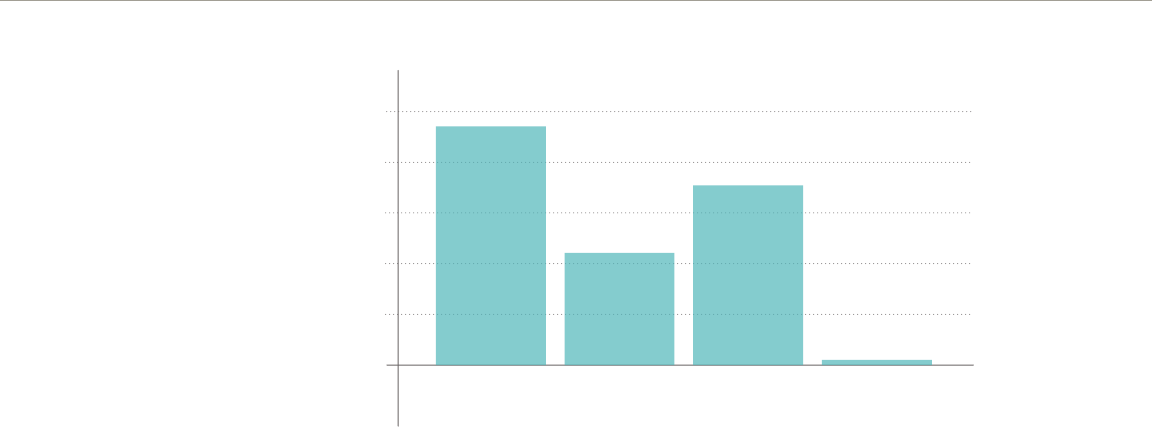
14 GROWING UP PHILLY: The Health and Well-being of Philadelphia’s Children
0%
5%
10%
15%
20%
25%
30%
35%
40%
Attempted Suicide
Suicidal Thoughts
Heterosexual Teens LGBTQ+ TeensCitywide
Neonatal Abstinence Syndrome
| rate per 1,000 live births
Asthma-related
Emergency Department visits
| by age group
Asthma-related
Emergency Department visits
| by age group and sex
Asthma hospitalizations
| per 10,000 children by race/ethnicity
Asthma hospitalizations
among children
| by insurance status
Injury-related Emergency
Department visits
| by age group
Injury-related Emergency
Room visits
| by age group and sex
Youth entering an out-of-home placement
| by age* group
Asthma hospitalizations
| per 10,000 children (under age 18)
ASIAN
HISPANIC
BLACK
WHITE
CITYWIDE
7,951
4,992
2,447
13.8
13.713.7
10.9
17.4%
15,540
34.9%
13.8%
0
2,000
4,000
6,000
8,000
10,000
12,000
14,000
16,000
18,000
CITYWIDE
13-19 YRS
6-12 YRS
<6 YRS
13-19 YRS
6-12 YRS
<6 YRS
13-19 YRS
6-12 YRS
<6 YRS
20182017201620152014
0
2,000
4,000
6,000
8,000
10,000
12,000
14,000
16,000
18,000
13-19 yrs
6-12 yrs
< 6 yrs
TotalFemale Male
2,477
1,410
1,067
2,947
4,922
2,045
3,028
4,992
7,951
0
20
40
60
80
100
2018201720162015201420132012201120102009
0
10
20
30
40
50
60
70
80
ASIAN*HISPANICBLACK*WHITE*
12.9
0
300
600
900
1,200
1,500
UninsuredOtherMedicaid Private
Insurance
284
70.5
1,497
45
63.2
18.3
69
43,058
15,684
14,057
13,194
5,000
CITYWIDE
13-19 YRS
6-12 YRS
<6 YRS
10,000
15,000
20,000
25,000
30,000
35,000
40,000
45,000
50,000
Citywide
13-19 yrs
6-12 yrs
<6 yrs
20182017201620152014
0
10,000
20,000
30,000
40,000
50,000
13-19 yrs
6-12 yrs
< 6 yrs
TotalFemale Male
7,599
15,684
13,194
14,057
7,877
7,320
8,084
5,874
6,180
0
300
600
900
1,200
1,500
18+ years13-18 years6-12 years0-5 years
1,412
664
1,033
30
Obesity among children ages 5-18
| by race/ethnicity and sex
Teens who experienced cyberbullying
| by sex
0%
5%
10%
15%
20%
25%
30%
FEMALE
MALE
Asian*HispanicWhite*Black*Citywide
22.0%
20.4%
21.4%
27.5%
18.5%
21.8%
23.8%
20.3%
23.2%
10.3%
3%
6%
9%
12%
15%
FEMALE
MALE
CITYWIDE
CITYWIDE
FEMALE
MALE
20192017201520132011
10.3%
10.7%
11.8%
Depressive symptoms among teens
| by race/ethnicity
Depressive symptoms among teens
| by sexual orientation
Suicidal ideation and suicide attempts among teens
Suicidal ideation
| by sex and race/ethnicity
Suicidal ideation and attempts
| by sexual orientation
20%
30%
40%
50%
Hispanic/Latino
White
Black
201920172015201320112009200720032001
39.8%
41.6%
45.7%
22.0%
20.8%
11.6%
25.7%
20.2%
14.6%
22.0%
9.8%
17.5%
13.1%
38.3%
15.2%
12.6%
36.3%
59.0%
31.5%
29.8%
50.5%
40.3%
Depressive symptoms among teens
| by sex
20%
30%
40%
50%
60%
Citywide
Female %
Male %
201920172015201320112009200720032001
HISPANIC
BLACK*
WHITE*
0% 10% 20% 30% 40% 50% 60% 70%
Heterosexual Teens
LGBTQ+ Teens
Citywide
5%
10%
15%
20%
25%
Attempt
Thoughts
2019201720152013201120092007200520032001
0%
5%
10%
15%
20%
25%
FEMALE
MALE
Hispanic White* Black*
8.3%
Suicide-related Emergency Department
visits
| by age group and sex
0
100
200
300
400
500
600
<10 YRS
10-14 YRS
15-19 YRS
TotalMaleFemale
202
275
243
63
73
70
41
173
22
Opioid-related Emergency Department
visits
| by age group and sex
Tobacco use in the past 30 days among teens
Teens currently using vaping products
| by race/ethnicity
Current teen marijuana use
| by year
Opioid-related Emergency Department visits
among youth
0
200
400
600
800
1,000
<10
10-14
15-19
TotalMaleFemale
506
789
60
125
283
23
70
37
55
15.8%
2.1%
3.5%
7.2%
2.8%
4.7%
10.5%
8.6%
6.0%
6.6%
6.8%
5.2%
7.3%
21.0%
17.9%
21.6%
25.1%
21.3%
19.0%
18.8%
23.9%
160
232
201
224
161
21.4%
Prescription pain medication
misuse amoung teens
| by race/ethnicity
0%
3%
6%
9%
12%
15%
HispanicWhiteBlackCitywide
13.7%
14.7%
4.9%
9.9%
CITYWIDE
HISPANIC
BLACK*
WHITE*
<10 YRS
10-14 YRS
15-19 YRS
0%
5%
10%
15%
20%
Cigar Use
Cigarette Use
2019201720152013201120092 007200520032001
0%
3%
6%
9%
12%
15%
HispanicWhite*Black*Citywide
7.1%
5.1%
14.3%
10.4%
10%
15%
20%
25%
30%
2019201720152013201120092007200520032001
58.8
59.5
71
85.6
97.1
98.8
94.6
71.2
55.1
0
2
4
6
8
10
12
14
16
20182017201620152014201320122011201020092008
9.1
9.3
8.4
6.2
6.5
6.2
4.5
SUICIDE
ATTEMPTS
SUICIDAL
IDEATION
SUICIDE
ATTEMPTS
SUICIDAL
IDEATION
0
100
200
300
400
20182017201620152014
13.9%
10.7% 10.8%
9.6%
7.5%
SOURCE: 2018 Philadelphia Department of Human Services
*Age at first dependent placement start date in 2018
CHILD MALTREATMENT
Child maltreatment
constitutes the physical,
sexual, and emotional
abuse, or neglect of a child.
Child maltreatment has
been linked to mental
health conditions,
substance use disorders,
suicide attempts, and risky
sexual behavior later in
life. Although child victims
of maltreatment have an
increased risk for poor
health outcomes across
the lifespan, this risk
may be mitigated through
the presence of strong,
stable, supportive, and
protective adults.
Philadelphia’s Department of
Human Services provides an
array of services to keep families
together and prevent the removal
of children from their homes.
When prevention services are not
sufficient to ensure child safety,
Philadelphia’s Department of
Human Services utilizes out-of-
home placement services, such as
foster care, to address unmitigated
safety threats. Children who
enter out-of-home placement
represent a particularly vulnerable
population and are at highest risk
for poor outcomes associated with
maltreatment.
In 2018, 2,649 children entered
an out-of-home placement for the
first time because of active and
unmitigated safety threats in their
homes. The largest fraction of
children who entered placement
in 2018 were aged 13 - 18 years (39
percent), followed by children aged
0 - 5 (35 percent).
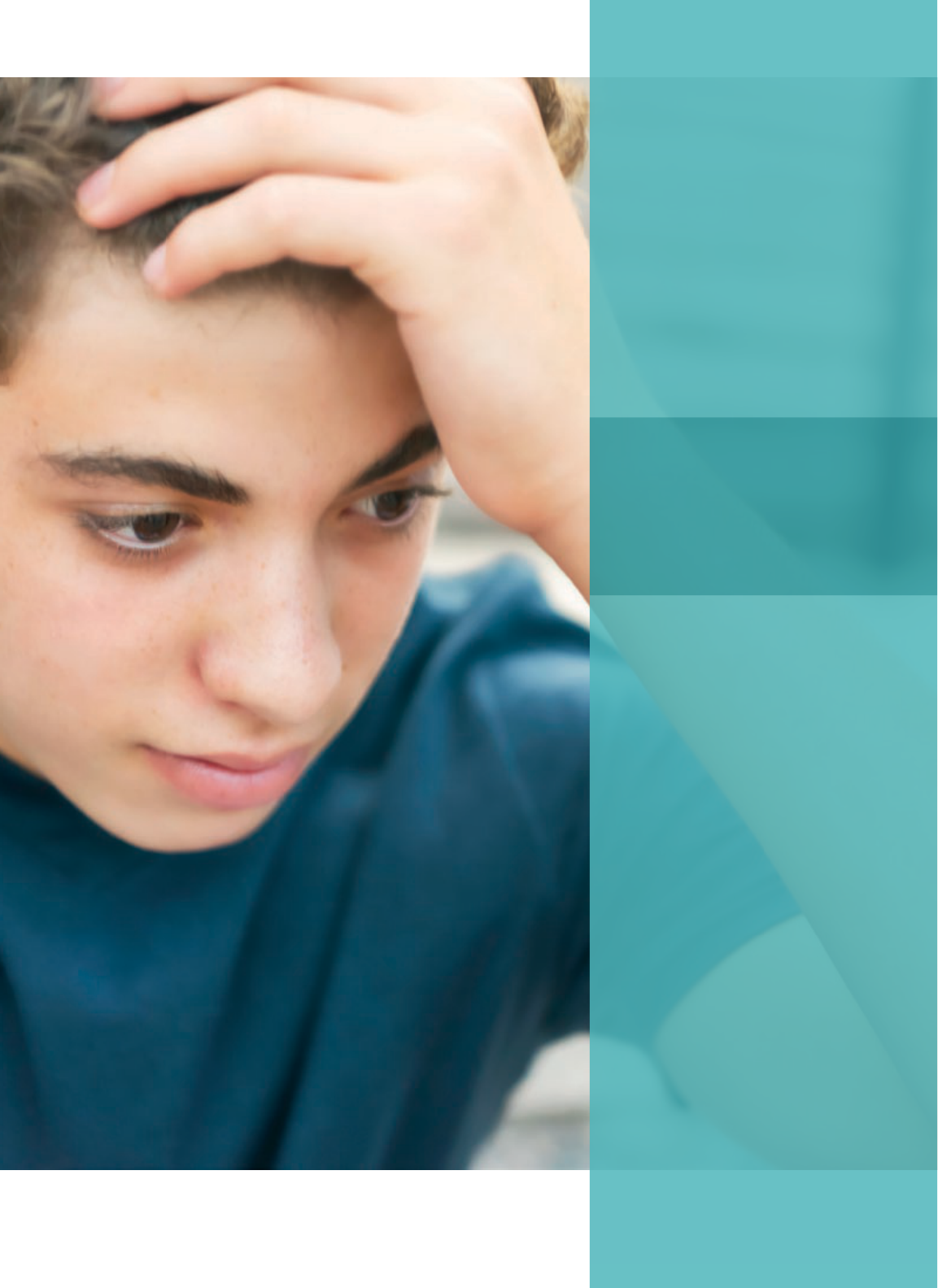
GROWING UP PHILLY: The Health and Well-being of Philadelphia’s Children 15
Behavioral
Health
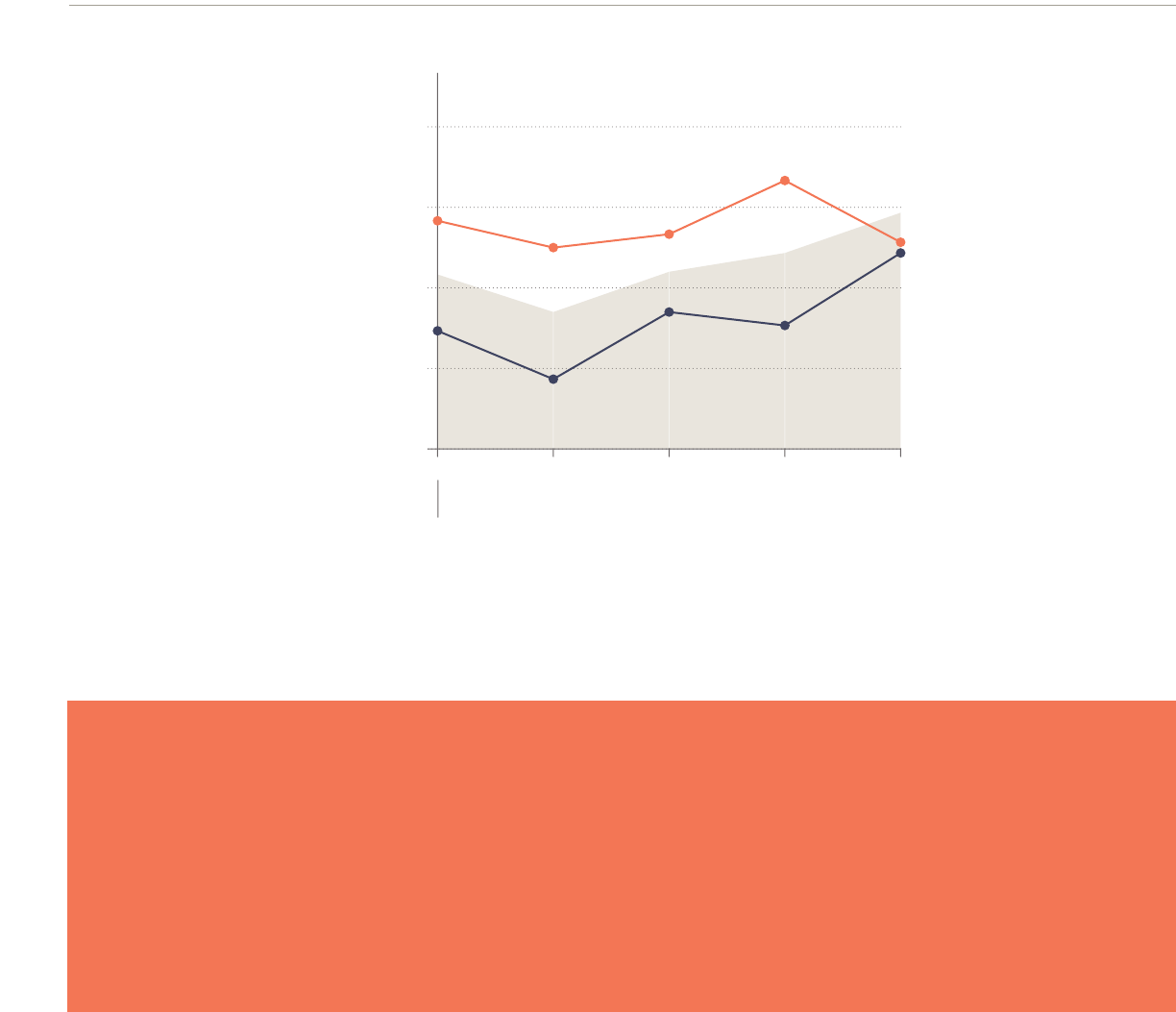
16 GROWING UP PHILLY: The Health and Well-being of Philadelphia’s Children
0%
5%
10%
15%
20%
25%
30%
35%
40%
Attempted Suicide
Suicidal Thoughts
Heterosexual Teens LGBTQ+ TeensCitywide
Neonatal Abstinence Syndrome
| rate per 1,000 live births
Asthma-related
Emergency Department visits
| by age group
Asthma-related
Emergency Department visits
| by age group and sex
Asthma hospitalizations
| per 10,000 children by race/ethnicity
Asthma hospitalizations
among children
| by insurance status
Injury-related Emergency
Department visits
| by age group
Injury-related Emergency
Room visits
| by age group and sex
Youth entering an out-of-home placement
| by age* group
Asthma hospitalizations
| per 10,000 children (under age 18)
ASIAN
HISPANIC
BLACK
WHITE
CITYWIDE
7,951
4,992
2,447
13.8
13.713.7
10.9
17.4%
15,540
34.9%
13.8%
0
2,000
4,000
6,000
8,000
10,000
12,000
14,000
16,000
18,000
CITYWIDE
13-19 YRS
6-12 YRS
<6 YRS
13-19 YRS
6-12 YRS
<6 YRS
13-19 YRS
6-12 YRS
<6 YRS
20182017201620152014
0
2,000
4,000
6,000
8,000
10,000
12,000
14,000
16,000
18,000
13-19 yrs
6-12 yrs
< 6 yrs
TotalFemale Male
2,477
1,410
1,067
2,947
4,922
2,045
3,028
4,992
7,951
0
20
40
60
80
100
2018201720162015201420132012201120102009
0
10
20
30
40
50
60
70
80
ASIAN*HISPANICBLACK*WHITE*
12.9
0
300
600
900
1,200
1,500
UninsuredOtherMedicaid Private
Insurance
284
70.5
1,497
45
63.2
18.3
69
43,058
15,684
14,057
13,194
5,000
CITYWIDE
13-19 YRS
6-12 YRS
<6 YRS
10,000
15,000
20,000
25,000
30,000
35,000
40,000
45,000
50,000
Citywide
13-19 yrs
6-12 yrs
<6 yrs
20182017201620152014
0
10,000
20,000
30,000
40,000
50,000
13-19 yrs
6-12 yrs
< 6 yrs
TotalFemale Male
7,599
15,684
13,194
14,057
7,877
7,320
8,084
5,874
6,180
0
300
600
900
1,200
1,500
18+ years13-18 years6-12 years0-5 years
1,412
664
1,033
30
Obesity among children ages 5-18
| by race/ethnicity and sex
Teens who experienced cyberbullying
| by sex
0%
5%
10%
15%
20%
25%
30%
FEMALE
MALE
Asian*HispanicWhite*Black*Citywide
22.0%
20.4%
21.4%
27.5%
18.5%
21.8%
23.8%
20.3%
23.2%
10.3%
3%
6%
9%
12%
15%
FEMALE
MALE
CITYWIDE
CITYWIDE
FEMALE
MALE
20192017201520132011
10.3%
10.7%
11.8%
Depressive symptoms among teens
| by race/ethnicity
Depressive symptoms among teens
| by sexual orientation
Suicidal ideation and suicide attempts among teens
Suicidal ideation
| by sex and race/ethnicity
Suicidal ideation and attempts
| by sexual orientation
20%
30%
40%
50%
Hispanic/Latino
White
Black
201920172015201320112009200720032001
39.8%
41.6%
45.7%
22.0%
20.8%
11.6%
25.7%
20.2%
14.6%
22.0%
9.8%
17.5%
13.1%
38.3%
15.2%
12.6%
36.3%
59.0%
31.5%
29.8%
50.5%
40.3%
Depressive symptoms among teens
| by sex
20%
30%
40%
50%
60%
Citywide
Female %
Male %
201920172015201320112009200720032001
HISPANIC
BLACK*
WHITE*
0% 10% 20% 30% 40% 50% 60% 70%
Heterosexual Teens
LGBTQ+ Teens
Citywide
5%
10%
15%
20%
25%
Attempt
Thoughts
2019201720152013201120092007200520032001
0%
5%
10%
15%
20%
25%
FEMALE
MALE
Hispanic White* Black*
8.3%
Suicide-related Emergency Department
visits
| by age group and sex
0
100
200
300
400
500
600
<10 YRS
10-14 YRS
15-19 YRS
TotalMaleFemale
202
275
243
63
73
70
41
173
22
Opioid-related Emergency Department
visits
| by age group and sex
Tobacco use in the past 30 days among teens
Teens currently using vaping products
| by race/ethnicity
Current teen marijuana use
| by year
Opioid-related Emergency Department visits
among youth
0
200
400
600
800
1,000
<10
10-14
15-19
TotalMaleFemale
506
789
60
125
283
23
70
37
55
15.8%
2.1%
3.5%
7.2%
2.8%
4.7%
10.5%
8.6%
6.0%
6.6%
6.8%
5.2%
7.3%
21.0%
17.9%
21.6%
25.1%
21.3%
19.0%
18.8%
23.9%
160
232
201
224
161
21.4%
Prescription pain medication
misuse amoung teens
| by race/ethnicity
0%
3%
6%
9%
12%
15%
HispanicWhiteBlackCitywide
13.7%
14.7%
4.9%
9.9%
CITYWIDE
HISPANIC
BLACK*
WHITE*
<10 YRS
10-14 YRS
15-19 YRS
0%
5%
10%
15%
20%
Cigar Use
Cigarette Use
2019201720152013201120092 007200520032001
0%
3%
6%
9%
12%
15%
HispanicWhite*Black*Citywide
7.1%
5.1%
14.3%
10.4%
10%
15%
20%
25%
30%
2019201720152013201120092007200520032001
58.8
59.5
71
85.6
97.1
98.8
94.6
71.2
55.1
0
2
4
6
8
10
12
14
16
20182017201620152014201320122011201020092008
9.1
9.3
8.4
6.2
6.5
6.2
4.5
SUICIDE
ATTEMPTS
SUICIDAL
IDEATION
SUICIDE
ATTEMPTS
SUICIDAL
IDEATION
0
100
200
300
400
20182017201620152014
13.9%
10.7% 10.8%
9.6%
7.5%
Behavioral Health
CYBER-BULLYING
The Centers for Disease
Control and Prevention
define cyber-bullying or
electronic bullying as
being bullied through text
message or social media
sites. Cyber-bullying and
bullying in general can
contribute to symptoms
of depression and suicidal
ideation among teens.
10
The percentage of youth
experiencing cyber-bullying
increased from 2013 to 2019.
Female teens were more likely
to report cyber-bullying.
SOURCE: 2011-2019 Philadelphia Youth Risk Behavior Surveillance System
“ I feel like a lot of that stems into mental health, too, because a
lot of the things that we see on social media, like people doing
drugs, people overdosing, people getting into fights, fighting
and stuff like that — our generation, that’s normal to us.”
— Resident from Philadelphia Community Needs Assessment
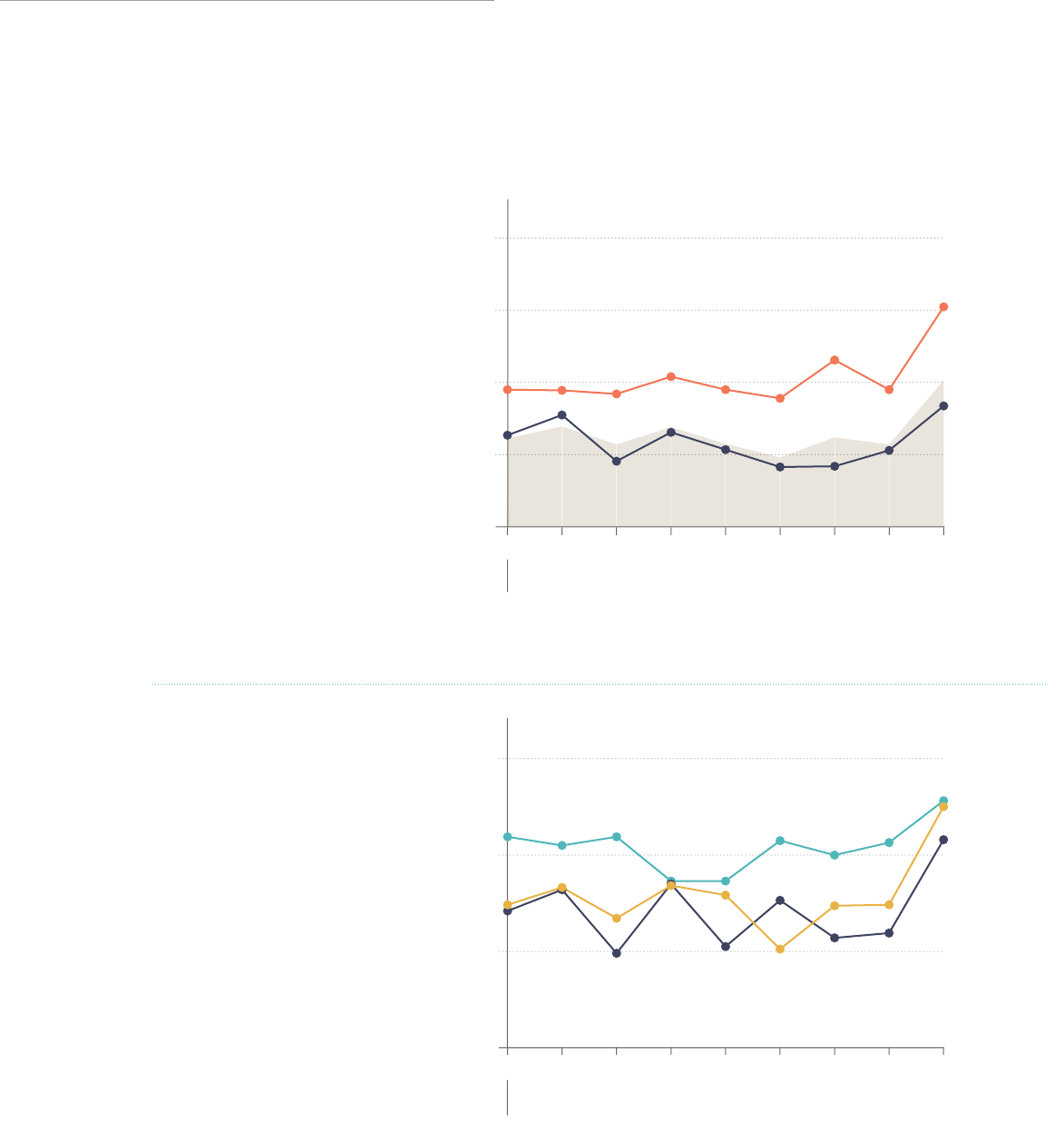
GROWING UP PHILLY: The Health and Well-being of Philadelphia’s Children 17
0%
5%
10%
15%
20%
25%
30%
35%
40%
Attempted Suicide
Suicidal Thoughts
Heterosexual Teens LGBTQ+ TeensCitywide
Neonatal Abstinence Syndrome
| rate per 1,000 live births
Asthma-related
Emergency Department visits
| by age group
Asthma-related
Emergency Department visits
| by age group and sex
Asthma hospitalizations
| per 10,000 children by race/ethnicity
Asthma hospitalizations
among children
| by insurance status
Injury-related Emergency
Department visits
| by age group
Injury-related Emergency
Room visits
| by age group and sex
Youth entering an out-of-home placement
| by age* group
Asthma hospitalizations
| per 10,000 children (under age 18)
ASIAN
HISPANIC
BLACK
WHITE
CITYWIDE
7,951
4,992
2,447
13.8
13.713.7
10.9
17.4%
15,540
34.9%
13.8%
0
2,000
4,000
6,000
8,000
10,000
12,000
14,000
16,000
18,000
CITYWIDE
13-19 YRS
6-12 YRS
<6 YRS
13-19 YRS
6-12 YRS
<6 YRS
13-19 YRS
6-12 YRS
<6 YRS
20182017201620152014
0
2,000
4,000
6,000
8,000
10,000
12,000
14,000
16,000
18,000
13-19 yrs
6-12 yrs
< 6 yrs
TotalFemale Male
2,477
1,410
1,067
2,947
4,922
2,045
3,028
4,992
7,951
0
20
40
60
80
100
2018201720162015201420132012201120102009
0
10
20
30
40
50
60
70
80
ASIAN*HISPANICBLACK*WHITE*
12.9
0
300
600
900
1,200
1,500
UninsuredOtherMedicaid Private
Insurance
284
70.5
1,497
45
63.2
18.3
69
43,058
15,684
14,057
13,194
5,000
CITYWIDE
13-19 YRS
6-12 YRS
<6 YRS
10,000
15,000
20,000
25,000
30,000
35,000
40,000
45,000
50,000
Citywide
13-19 yrs
6-12 yrs
<6 yrs
20182017201620152014
0
10,000
20,000
30,000
40,000
50,000
13-19 yrs
6-12 yrs
< 6 yrs
TotalFemale Male
7,599
15,684
13,194
14,057
7,877
7,320
8,084
5,874
6,180
0
300
600
900
1,200
1,500
18+ years13-18 years6-12 years0-5 years
1,412
664
1,033
30
Obesity among children ages 5-18
| by race/ethnicity and sex
Teens who experienced cyberbullying
| by sex
0%
5%
10%
15%
20%
25%
30%
FEMALE
MALE
Asian*HispanicWhite*Black*Citywide
22.0%
20.4%
21.4%
27.5%
18.5%
21.8%
23.8%
20.3%
23.2%
10.3%
3%
6%
9%
12%
15%
FEMALE
MALE
CITYWIDE
CITYWIDE
FEMALE
MALE
20192017201520132011
10.3%
10.7%
11.8%
Depressive symptoms among teens
| by race/ethnicity
Depressive symptoms among teens
| by sexual orientation
Suicidal ideation and suicide attempts among teens
Suicidal ideation
| by sex and race/ethnicity
Suicidal ideation and attempts
| by sexual orientation
20%
30%
40%
50%
Hispanic/Latino
White
Black
201920172015201320112009200720032001
39.8%
41.6%
45.7%
22.0%
20.8%
11.6%
25.7%
20.2%
14.6%
22.0%
9.8%
17.5%
13.1%
38.3%
15.2%
12.6%
36.3%
59.0%
31.5%
29.8%
50.5%
40.3%
Depressive symptoms among teens
| by sex
20%
30%
40%
50%
60%
Citywide
Female %
Male %
201920172015201320112009200720032001
HISPANIC
BLACK*
WHITE*
0% 10% 20% 30% 40% 50% 60% 70%
Heterosexual Teens
LGBTQ+ Teens
Citywide
5%
10%
15%
20%
25%
Attempt
Thoughts
2019201720152013201120092007200520032001
0%
5%
10%
15%
20%
25%
FEMALE
MALE
Hispanic White* Black*
8.3%
Suicide-related Emergency Department
visits
| by age group and sex
0
100
200
300
400
500
600
<10 YRS
10-14 YRS
15-19 YRS
TotalMaleFemale
202
275
243
63
73
70
41
173
22
Opioid-related Emergency Department
visits
| by age group and sex
Tobacco use in the past 30 days among teens
Teens currently using vaping products
| by race/ethnicity
Current teen marijuana use
| by year
Opioid-related Emergency Department visits
among youth
0
200
400
600
800
1,000
<10
10-14
15-19
TotalMaleFemale
506
789
60
125
283
23
70
37
55
15.8%
2.1%
3.5%
7.2%
2.8%
4.7%
10.5%
8.6%
6.0%
6.6%
6.8%
5.2%
7.3%
21.0%
17.9%
21.6%
25.1%
21.3%
19.0%
18.8%
23.9%
160
232
201
224
161
21.4%
Prescription pain medication
misuse amoung teens
| by race/ethnicity
0%
3%
6%
9%
12%
15%
HispanicWhiteBlackCitywide
13.7%
14.7%
4.9%
9.9%
CITYWIDE
HISPANIC
BLACK*
WHITE*
<10 YRS
10-14 YRS
15-19 YRS
0%
5%
10%
15%
20%
Cigar Use
Cigarette Use
2019201720152013201120092 007200520032001
0%
3%
6%
9%
12%
15%
HispanicWhite*Black*Citywide
7.1%
5.1%
14.3%
10.4%
10%
15%
20%
25%
30%
2019201720152013201120092007200520032001
58.8
59.5
71
85.6
97.1
98.8
94.6
71.2
55.1
0
2
4
6
8
10
12
14
16
20182017201620152014201320122011201020092008
9.1
9.3
8.4
6.2
6.5
6.2
4.5
SUICIDE
ATTEMPTS
SUICIDAL
IDEATION
SUICIDE
ATTEMPTS
SUICIDAL
IDEATION
0
100
200
300
400
20182017201620152014
13.9%
10.7% 10.8%
9.6%
7.5%
0%
5%
10%
15%
20%
25%
30%
35%
40%
Attempted Suicide
Suicidal Thoughts
Heterosexual Teens LGBTQ+ TeensCitywide
Neonatal Abstinence Syndrome
| rate per 1,000 live births
Asthma-related
Emergency Department visits
| by age group
Asthma-related
Emergency Department visits
| by age group and sex
Asthma hospitalizations
| per 10,000 children by race/ethnicity
Asthma hospitalizations
among children
| by insurance status
Injury-related Emergency
Department visits
| by age group
Injury-related Emergency
Room visits
| by age group and sex
Youth entering an out-of-home placement
| by age* group
Asthma hospitalizations
| per 10,000 children (under age 18)
ASIAN
HISPANIC
BLACK
WHITE
CITYWIDE
7,951
4,992
2,447
13.8
13.713.7
10.9
17.4%
15,540
34.9%
13.8%
0
2,000
4,000
6,000
8,000
10,000
12,000
14,000
16,000
18,000
CITYWIDE
13-19 YRS
6-12 YRS
<6 YRS
13-19 YRS
6-12 YRS
<6 YRS
13-19 YRS
6-12 YRS
<6 YRS
20182017201620152014
0
2,000
4,000
6,000
8,000
10,000
12,000
14,000
16,000
18,000
13-19 yrs
6-12 yrs
< 6 yrs
TotalFemale Male
2,477
1,410
1,067
2,947
4,922
2,045
3,028
4,992
7,951
0
20
40
60
80
100
2018201720162015201420132012201120102009
0
10
20
30
40
50
60
70
80
ASIAN*HISPANICBLACK*WHITE*
12.9
0
300
600
900
1,200
1,500
UninsuredOtherMedicaid Private
Insurance
284
70.5
1,497
45
63.2
18.3
69
43,058
15,684
14,057
13,194
5,000
CITYWIDE
13-19 YRS
6-12 YRS
<6 YRS
10,000
15,000
20,000
25,000
30,000
35,000
40,000
45,000
50,000
Citywide
13-19 yrs
6-12 yrs
<6 yrs
20182017201620152014
0
10,000
20,000
30,000
40,000
50,000
13-19 yrs
6-12 yrs
< 6 yrs
TotalFemale Male
7,599
15,684
13,194
14,057
7,877
7,320
8,084
5,874
6,180
0
300
600
900
1,200
1,500
18+ years13-18 years6-12 years0-5 years
1,412
664
1,033
30
Obesity among children ages 5-18
| by race/ethnicity and sex
Teens who experienced cyberbullying
| by sex
0%
5%
10%
15%
20%
25%
30%
FEMALE
MALE
Asian*HispanicWhite*Black*Citywide
22.0%
20.4%
21.4%
27.5%
18.5%
21.8%
23.8%
20.3%
23.2%
10.3%
3%
6%
9%
12%
15%
FEMALE
MALE
CITYWIDE
CITYWIDE
FEMALE
MALE
20192017201520132011
10.3%
10.7%
11.8%
Depressive symptoms among teens
| by race/ethnicity
Depressive symptoms among teens
| by sexual orientation
Suicidal ideation and suicide attempts among teens
Suicidal ideation
| by sex and race/ethnicity
Suicidal ideation and attempts
| by sexual orientation
20%
30%
40%
50%
Hispanic/Latino
White
Black
201920172015201320112009200720032001
39.8%
41.6%
45.7%
22.0%
20.8%
11.6%
25.7%
20.2%
14.6%
22.0%
9.8%
17.5%
13.1%
38.3%
15.2%
12.6%
36.3%
59.0%
31.5%
29.8%
50.5%
40.3%
Depressive symptoms among teens
| by sex
20%
30%
40%
50%
60%
Citywide
Female %
Male %
201920172015201320112009200720032001
HISPANIC
BLACK*
WHITE*
0% 10% 20% 30% 40% 50% 60% 70%
Heterosexual Teens
LGBTQ+ Teens
Citywide
5%
10%
15%
20%
25%
Attempt
Thoughts
2019201720152013201120092007200520032001
0%
5%
10%
15%
20%
25%
FEMALE
MALE
Hispanic White* Black*
8.3%
Suicide-related Emergency Department
visits
| by age group and sex
0
100
200
300
400
500
600
<10 YRS
10-14 YRS
15-19 YRS
TotalMaleFemale
202
275
243
63
73
70
41
173
22
Opioid-related Emergency Department
visits
| by age group and sex
Tobacco use in the past 30 days among teens
Teens currently using vaping products
| by race/ethnicity
Current teen marijuana use
| by year
Opioid-related Emergency Department visits
among youth
0
200
400
600
800
1,000
<10
10-14
15-19
TotalMaleFemale
506
789
60
125
283
23
70
37
55
15.8%
2.1%
3.5%
7.2%
2.8%
4.7%
10.5%
8.6%
6.0%
6.6%
6.8%
5.2%
7.3%
21.0%
17.9%
21.6%
25.1%
21.3%
19.0%
18.8%
23.9%
160
232
201
224
161
21.4%
Prescription pain medication
misuse amoung teens
| by race/ethnicity
0%
3%
6%
9%
12%
15%
HispanicWhiteBlackCitywide
13.7%
14.7%
4.9%
9.9%
CITYWIDE
HISPANIC
BLACK*
WHITE*
<10 YRS
10-14 YRS
15-19 YRS
0%
5%
10%
15%
20%
Cigar Use
Cigarette Use
2019201720152013201120092 007200520032001
0%
3%
6%
9%
12%
15%
HispanicWhite*Black*Citywide
7.1%
5.1%
14.3%
10.4%
10%
15%
20%
25%
30%
2019201720152013201120092007200520032001
58.8
59.5
71
85.6
97.1
98.8
94.6
71.2
55.1
0
2
4
6
8
10
12
14
16
20182017201620152014201320122011201020092008
9.1
9.3
8.4
6.2
6.5
6.2
4.5
SUICIDE
ATTEMPTS
SUICIDAL
IDEATION
SUICIDE
ATTEMPTS
SUICIDAL
IDEATION
0
100
200
300
400
20182017201620152014
13.9%
10.7% 10.8%
9.6%
7.5%
SOURCE: 2001-2019 Philadelphia Youth Risk Behavior Surveillance System
SOURCE: 2001-2019 Philadelphia Youth Risk Behavior Surveillance System
*Non-Hispanic
DEPRESSIVE SYMPTOMS
Depressive symptoms, measured as experiencing feelings of sadness and hopelessness for
two or more weeks, are important indicators of psychological distress among youth. If left
untreated, depressive symptoms can lead to a diagnosis of major depressive disorder and
also contribute to suicidal thoughts, plans, and suicide attempts.
11
From 2001 to 2019, depressive
symptoms among teens have
remained relatively constant, at
40.3 percent in 2019, higher
than the national average
(31.5 percent).
Depressive symptoms were
highest among female teens.
Nationally, diagnoses of
depression are more common
among females compared to
males, which may be due to
stressors related to limited social
power and gender differences in
stress responses.
12
Lower percentages of depressive
symptoms among males may be
due to underreporting and stigma
surrounding mental health among
boys and men.
13
From 2001 to 2019, depressive
symptoms were more common
among Hispanic teens at 45
percent. This was higher than the
national percentage among this
population (34 percent).
Racial/ethnic discrimination,
alienation, and stress associated
with acculturation to U.S. society
may contribute to depression
among Hispanic teens.
14
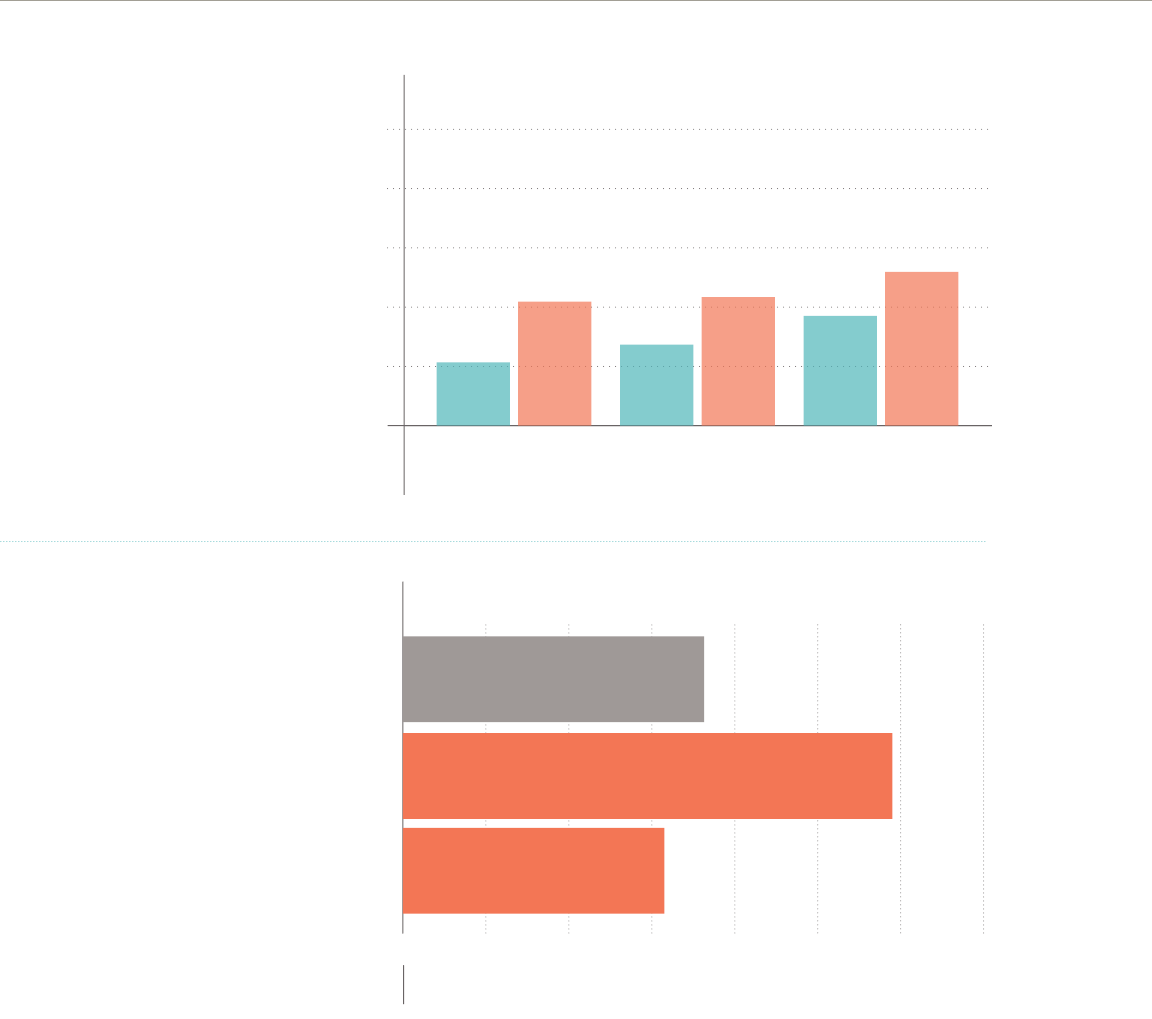
18 GROWING UP PHILLY: The Health and Well-being of Philadelphia’s Children
Kindergartners scoring at or above benchmarks
for competencies
| by race/ethnicity
21.4%
27.4%
37.1%
51.9%
32.1%
27.7%
25.1%
25.2%
31.4%
22.7%
43.3%
41.9%
5.3%
37.4%
23.8%
40.3%
83.2%
1.2%
1.0%
1.2%
2.2%
1.0%
12.4%
4.7%
21.6%
16.4%
59.3%
0%
20%
40%
60%
80%
100%
HispanicWhite*Black*
Depressive symptoms among teens
| by race/ethnicity and sex
Infant sleep chracteristics
Prenatal substance use among
Philly PRAMS respondents
MALE FEMALE
MALE FEMALE
13-15 year olds who have received
HPV vaccine
| by race/ethnicity
Adequate Prenatal Care
| by race/ethnicity
6,048
6,537
0%
10%
20%
30%
40%
50%
60%
70%
80%
Asian*Hispanic White* Black*Citywide
67.3%
71.9%
63.8%
73.6%
72.9%
0% 5% 10% 15% 20% 25% 30% 35%
White*
Multi-
racial*
Hispanic
Black*
Asian*
Learning
Engagement
Emerging
Academic
Learning
Engagement
Emerging
Academic
Learning
Engagement
Emerging
Academic
Learning
Engagement
Emerging
Academic
Learning
Engagement
Emerging
Academic
18.6%
18.6%
16.2%
10.8%
17.6%
14.6%
16.4%
17.3%
27.0%
22.0%
12.6%
19.4%
23.7%
25.1%
0%
20%
40%
60%
80%
100%
USUALLY
RARELY
NEVER
On their stomachOn their sideOn their back
10.9%
0% 3% 6% 9% 12% 15%
Prescription
pain relievers
Marijuana or hash
Synthetic
marijuana
Methadone, naxolone,
subutex, or Suboxone
Heroin
Amphetamines
Cocaine
Suicide attempts
| by sex and race/ethnicity
Breastfeeding duration 2–6 months postpartum
Breastfeeding indicators
16.2%
8.8%
12.8%
33.3%
57.0%
84.9%
87.8%
80.1%
87.0%
87.6%
79.2%
57.2%
49.3%
59.3%
44.4%
22.2%
10.1%
7.3%
11.1%
0%
5%
10%
15%
FEMALE
MALE
Hispanic White* Black*
0%
10%
20%
30%
40%
50%
17 weeks or more16 weeks< 16 weeks
0%
20%
40%
60%
80%
100%
Any breastfeeding or feeding
pumped milk at 8 weeks
Ever breastfed or
pumped breast milk
ASIAN*HISPANICBLACK*WHITE*ALL
0%
25%
50%
75%
100%
ASIAN*
AMERICAN INDIAN/
ALASKAN NATIVE*
HISPANIC
BLACK*
WHITE*
CITYWIDE
20182017201620152014201320122011201020092008
57.3%
57.3%
55.0%
54.5%
53.2%
52.8%
DEPRESSIVE SYMPTOMS, continued
Depressive symptoms were
highest among Hispanic male
teens at 37.1 percent and Hispanic
female teens at 51.9 percent.
In 2017 through 2019, depressive
symptoms were more common
among youth that identify
as lesbian, bisexual, gay, or
transgender, or LGBTQ+,
(59 percent) compared to
heterosexual youth (36 percent).
This is similar to the national
percentage of depressive
symptoms among LGBTQ+ teens
(63 percent).
High percentages of depressive
symptoms among LGBTQ+ teens
are likely due to societal stigma
and discrimination that members
of the LGBTQ+ community face.
15
0%
5%
10%
15%
20%
25%
30%
35%
40%
Attempted Suicide
Suicidal Thoughts
Heterosexual Teens LGBTQ+ TeensCitywide
Neonatal Abstinence Syndrome
| rate per 1,000 live births
Asthma-related
Emergency Department visits
| by age group
Asthma-related
Emergency Department visits
| by age group and sex
Asthma hospitalizations
| per 10,000 children by race/ethnicity
Asthma hospitalizations
among children
| by insurance status
Injury-related Emergency
Department visits
| by age group
Injury-related Emergency
Room visits
| by age group and sex
Youth entering an out-of-home placement
| by age* group
Asthma hospitalizations
| per 10,000 children (under age 18)
ASIAN
HISPANIC
BLACK
WHITE
CITYWIDE
7,951
4,992
2,447
13.8
13.713.7
10.9
17.4%
15,540
34.9%
13.8%
0
2,000
4,000
6,000
8,000
10,000
12,000
14,000
16,000
18,000
CITYWIDE
13-19 YRS
6-12 YRS
<6 YRS
13-19 YRS
6-12 YRS
<6 YRS
13-19 YRS
6-12 YRS
<6 YRS
20182017201620152014
0
2,000
4,000
6,000
8,000
10,000
12,000
14,000
16,000
18,000
13-19 yrs
6-12 yrs
< 6 yrs
TotalFemale Male
2,477
1,410
1,067
2,947
4,922
2,045
3,028
4,992
7,951
0
20
40
60
80
100
2018201720162015201420132012201120102009
0
10
20
30
40
50
60
70
80
ASIAN*HISPANICBLACK*WHITE*
12.9
0
300
600
900
1,200
1,500
UninsuredOtherMedicaid Private
Insurance
284
70.5
1,497
45
63.2
18.3
69
43,058
15,684
14,057
13,194
5,000
CITYWIDE
13-19 YRS
6-12 YRS
<6 YRS
10,000
15,000
20,000
25,000
30,000
35,000
40,000
45,000
50,000
Citywide
13-19 yrs
6-12 yrs
<6 yrs
20182017201620152014
0
10,000
20,000
30,000
40,000
50,000
13-19 yrs
6-12 yrs
< 6 yrs
TotalFemale Male
7,599
15,684
13,194
14,057
7,877
7,320
8,084
5,874
6,180
0
300
600
900
1,200
1,500
18+ years13-18 years6-12 years0-5 years
1,412
664
1,033
30
Obesity among children ages 5-18
| by race/ethnicity and sex
Teens who experienced cyberbullying
| by sex
0%
5%
10%
15%
20%
25%
30%
FEMALE
MALE
Asian*HispanicWhite*Black*Citywide
22.0%
20.4%
21.4%
27.5%
18.5%
21.8%
23.8%
20.3%
23.2%
10.3%
3%
6%
9%
12%
15%
FEMALE
MALE
CITYWIDE
CITYWIDE
FEMALE
MALE
20192017201520132011
10.3%
10.7%
11.8%
Depressive symptoms among teens
| by race/ethnicity
Depressive symptoms among teens
| by sexual orientation
Suicidal ideation and suicide attempts among teens
Suicidal ideation
| by sex and race/ethnicity
Suicidal ideation and attempts
| by sexual orientation
20%
30%
40%
50%
Hispanic/Latino
White
Black
201920172015201320112009200720032001
39.8%
41.6%
45.7%
22.0%
20.8%
11.6%
25.7%
20.2%
14.6%
22.0%
9.8%
17.5%
13.1%
38.3%
15.2%
12.6%
36.3%
59.0%
31.5%
29.8%
50.5%
40.3%
Depressive symptoms among teens
| by sex
20%
30%
40%
50%
60%
Citywide
Female %
Male %
201920172015201320112009200720032001
HISPANIC
BLACK*
WHITE*
0% 10% 20% 30% 40% 50% 60% 70%
Heterosexual Teens
LGBTQ+ Teens
Citywide
5%
10%
15%
20%
25%
Attempt
Thoughts
2019201720152013201120092007200520032001
0%
5%
10%
15%
20%
25%
FEMALE
MALE
Hispanic White* Black*
8.3%
Suicide-related Emergency Department
visits
| by age group and sex
0
100
200
300
400
500
600
<10 YRS
10-14 YRS
15-19 YRS
TotalMaleFemale
202
275
243
63
73
70
41
173
22
Opioid-related Emergency Department
visits
| by age group and sex
Tobacco use in the past 30 days among teens
Teens currently using vaping products
| by race/ethnicity
Current teen marijuana use
| by year
Opioid-related Emergency Department visits
among youth
0
200
400
600
800
1,000
<10
10-14
15-19
TotalMaleFemale
506
789
60
125
283
23
70
37
55
15.8%
2.1%
3.5%
7.2%
2.8%
4.7%
10.5%
8.6%
6.0%
6.6%
6.8%
5.2%
7.3%
21.0%
17.9%
21.6%
25.1%
21.3%
19.0%
18.8%
23.9%
160
232
201
224
161
21.4%
Prescription pain medication
misuse amoung teens
| by race/ethnicity
0%
3%
6%
9%
12%
15%
HispanicWhiteBlackCitywide
13.7%
14.7%
4.9%
9.9%
CITYWIDE
HISPANIC
BLACK*
WHITE*
<10 YRS
10-14 YRS
15-19 YRS
0%
5%
10%
15%
20%
Cigar Use
Cigarette Use
2019201720152013201120092 007200520032001
0%
3%
6%
9%
12%
15%
HispanicWhite*Black*Citywide
7.1%
5.1%
14.3%
10.4%
10%
15%
20%
25%
30%
2019201720152013201120092007200520032001
58.8
59.5
71
85.6
97.1
98.8
94.6
71.2
55.1
0
2
4
6
8
10
12
14
16
20182017201620152014201320122011201020092008
9.1
9.3
8.4
6.2
6.5
6.2
4.5
SUICIDE
ATTEMPTS
SUICIDAL
IDEATION
SUICIDE
ATTEMPTS
SUICIDAL
IDEATION
0
100
200
300
400
20182017201620152014
13.9%
10.7% 10.8%
9.6%
7.5%
SOURCE: 2017-2019 Philadelphia Youth Risk Behavior Surveillance System
SOURCE: 2001-2019 Philadelphia Youth Risk Behavior Surveillance System *Non-Hispanic
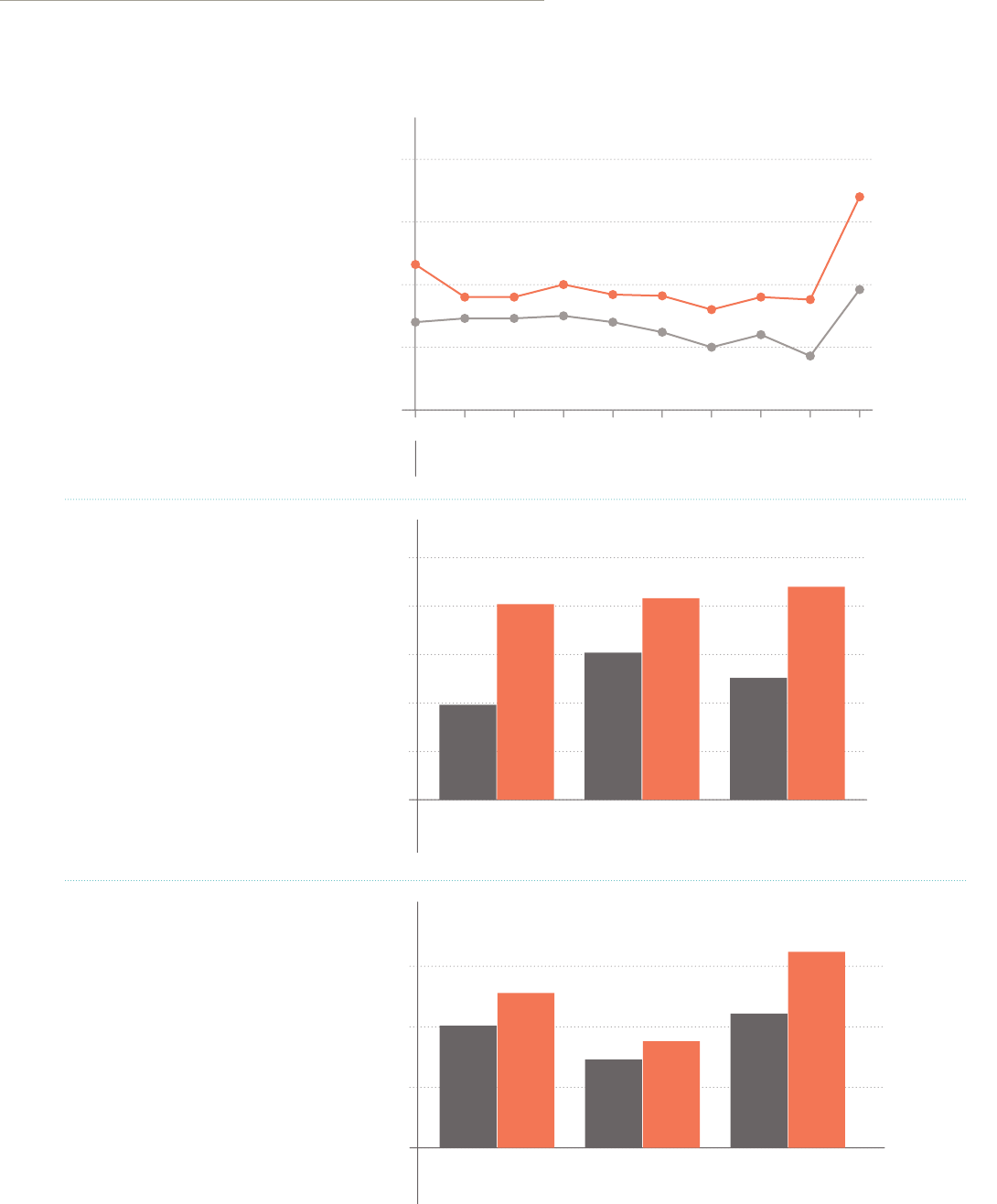
GROWING UP PHILLY: The Health and Well-being of Philadelphia’s Children 19
0%
5%
10%
15%
20%
25%
30%
35%
40%
Attempted Suicide
Suicidal Thoughts
Heterosexual Teens LGBTQ+ TeensCitywide
Neonatal Abstinence Syndrome
| rate per 1,000 live births
Asthma-related
Emergency Department visits
| by age group
Asthma-related
Emergency Department visits
| by age group and sex
Asthma hospitalizations
| per 10,000 children by race/ethnicity
Asthma hospitalizations
among children
| by insurance status
Injury-related Emergency
Department visits
| by age group
Injury-related Emergency
Room visits
| by age group and sex
Youth entering an out-of-home placement
| by age* group
Asthma hospitalizations
| per 10,000 children (under age 18)
ASIAN
HISPANIC
BLACK
WHITE
CITYWIDE
7,951
4,992
2,447
13.8
13.713.7
10.9
17.4%
15,540
34.9%
13.8%
0
2,000
4,000
6,000
8,000
10,000
12,000
14,000
16,000
18,000
CITYWIDE
13-19 YRS
6-12 YRS
<6 YRS
13-19 YRS
6-12 YRS
<6 YRS
13-19 YRS
6-12 YRS
<6 YRS
20182017201620152014
0
2,000
4,000
6,000
8,000
10,000
12,000
14,000
16,000
18,000
13-19 yrs
6-12 yrs
< 6 yrs
TotalFemale Male
2,477
1,410
1,067
2,947
4,922
2,045
3,028
4,992
7,951
0
20
40
60
80
100
2018201720162015201420132012201120102009
0
10
20
30
40
50
60
70
80
ASIAN*HISPANICBLACK*WHITE*
12.9
0
300
600
900
1,200
1,500
UninsuredOtherMedicaid Private
Insurance
284
70.5
1,497
45
63.2
18.3
69
43,058
15,684
14,057
13,194
5,000
CITYWIDE
13-19 YRS
6-12 YRS
<6 YRS
10,000
15,000
20,000
25,000
30,000
35,000
40,000
45,000
50,000
Citywide
13-19 yrs
6-12 yrs
<6 yrs
20182017201620152014
0
10,000
20,000
30,000
40,000
50,000
13-19 yrs
6-12 yrs
< 6 yrs
TotalFemale Male
7,599
15,684
13,194
14,057
7,877
7,320
8,084
5,874
6,180
0
300
600
900
1,200
1,500
18+ years13-18 years6-12 years0-5 years
1,412
664
1,033
30
Obesity among children ages 5-18
| by race/ethnicity and sex
Teens who experienced cyberbullying
| by sex
0%
5%
10%
15%
20%
25%
30%
FEMALE
MALE
Asian*HispanicWhite*Black*Citywide
22.0%
20.4%
21.4%
27.5%
18.5%
21.8%
23.8%
20.3%
23.2%
10.3%
3%
6%
9%
12%
15%
FEMALE
MALE
CITYWIDE
CITYWIDE
FEMALE
MALE
20192017201520132011
10.3%
10.7%
11.8%
Depressive symptoms among teens
| by race/ethnicity
Depressive symptoms among teens
| by sexual orientation
Suicidal ideation and suicide attempts among teens
Suicidal ideation
| by sex and race/ethnicity
Suicidal ideation and attempts
| by sexual orientation
20%
30%
40%
50%
Hispanic/Latino
White
Black
201920172015201320112009200720032001
39.8%
41.6%
45.7%
22.0%
20.8%
11.6%
25.7%
20.2%
14.6%
22.0%
9.8%
17.5%
13.1%
38.3%
15.2%
12.6%
36.3%
59.0%
31.5%
29.8%
50.5%
40.3%
Depressive symptoms among teens
| by sex
20%
30%
40%
50%
60%
Citywide
Female %
Male %
201920172015201320112009200720032001
HISPANIC
BLACK*
WHITE*
0% 10% 20% 30% 40% 50% 60% 70%
Heterosexual Teens
LGBTQ+ Teens
Citywide
5%
10%
15%
20%
25%
Attempt
Thoughts
2019201720152013201120092007200520032001
0%
5%
10%
15%
20%
25%
FEMALE
MALE
Hispanic White* Black*
8.3%
Suicide-related Emergency Department
visits
| by age group and sex
0
100
200
300
400
500
600
<10 YRS
10-14 YRS
15-19 YRS
TotalMaleFemale
202
275
243
63
73
70
41
173
22
Opioid-related Emergency Department
visits
| by age group and sex
Tobacco use in the past 30 days among teens
Teens currently using vaping products
| by race/ethnicity
Current teen marijuana use
| by year
Opioid-related Emergency Department visits
among youth
0
200
400
600
800
1,000
<10
10-14
15-19
TotalMaleFemale
506
789
60
125
283
23
70
37
55
15.8%
2.1%
3.5%
7.2%
2.8%
4.7%
10.5%
8.6%
6.0%
6.6%
6.8%
5.2%
7.3%
21.0%
17.9%
21.6%
25.1%
21.3%
19.0%
18.8%
23.9%
160
232
201
224
161
21.4%
Prescription pain medication
misuse amoung teens
| by race/ethnicity
0%
3%
6%
9%
12%
15%
HispanicWhiteBlackCitywide
13.7%
14.7%
4.9%
9.9%
CITYWIDE
HISPANIC
BLACK*
WHITE*
<10 YRS
10-14 YRS
15-19 YRS
0%
5%
10%
15%
20%
Cigar Use
Cigarette Use
2019201720152013201120092 007200520032001
0%
3%
6%
9%
12%
15%
HispanicWhite*Black*Citywide
7.1%
5.1%
14.3%
10.4%
10%
15%
20%
25%
30%
2019201720152013201120092007200520032001
58.8
59.5
71
85.6
97.1
98.8
94.6
71.2
55.1
0
2
4
6
8
10
12
14
16
20182017201620152014201320122011201020092008
9.1
9.3
8.4
6.2
6.5
6.2
4.5
SUICIDE
ATTEMPTS
SUICIDAL
IDEATION
SUICIDE
ATTEMPTS
SUICIDAL
IDEATION
0
100
200
300
400
20182017201620152014
13.9%
10.7% 10.8%
9.6%
7.5%
SUICIDAL IDEATION AND ATTEMPT
Suicide is one of the leading causes of death among young people.
The percentage of teens that
have experienced suicidal ideation
in the past year remained stable
from 2001 to 2017 but increased
to 22 percent in 2019.
In Philadelphia, the percentage
of youth who have attempted
suicide has remained stable
from 2001 to 2019. In 2019, 14.6
percent of teens in Philadelphia
attempted suicide.
Suicidal ideation among
teens was most common
among female youth. Suicidal
ideation was slightly higher
among Hispanic females and
non-Hispanic white males.
Reports of suicidal ideation and
attempts were higher among
females than males. Reported
suicide ideation was common
among all racial/ethnic groups,
with female Hispanic youths
having a higher proportion of
reported suicide attempts at
16.2 percent.
0%
5%
10%
15%
20%
25%
30%
35%
40%
Attempted Suicide
Suicidal Thoughts
Heterosexual Teens LGBTQ+ TeensCitywide
Neonatal Abstinence Syndrome
| rate per 1,000 live births
Asthma-related
Emergency Department visits
| by age group
Asthma-related
Emergency Department visits
| by age group and sex
Asthma hospitalizations
| per 10,000 children by race/ethnicity
Asthma hospitalizations
among children
| by insurance status
Injury-related Emergency
Department visits
| by age group
Injury-related Emergency
Room visits
| by age group and sex
Youth entering an out-of-home placement
| by age* group
Asthma hospitalizations
| per 10,000 children (under age 18)
ASIAN
HISPANIC
BLACK
WHITE
CITYWIDE
7,951
4,992
2,447
13.8
13.713.7
10.9
17.4%
15,540
34.9%
13.8%
0
2,000
4,000
6,000
8,000
10,000
12,000
14,000
16,000
18,000
CITYWIDE
13-19 YRS
6-12 YRS
<6 YRS
13-19 YRS
6-12 YRS
<6 YRS
13-19 YRS
6-12 YRS
<6 YRS
20182017201620152014
0
2,000
4,000
6,000
8,000
10,000
12,000
14,000
16,000
18,000
13-19 yrs
6-12 yrs
< 6 yrs
TotalFemale Male
2,477
1,410
1,067
2,947
4,922
2,045
3,028
4,992
7,951
0
20
40
60
80
100
2018201720162015201420132012201120102009
0
10
20
30
40
50
60
70
80
ASIAN*HISPANICBLACK*WHITE*
12.9
0
300
600
900
1,200
1,500
UninsuredOtherMedicaid Private
Insurance
284
70.5
1,497
45
63.2
18.3
69
43,058
15,684
14,057
13,194
5,000
CITYWIDE
13-19 YRS
6-12 YRS
<6 YRS
10,000
15,000
20,000
25,000
30,000
35,000
40,000
45,000
50,000
Citywide
13-19 yrs
6-12 yrs
<6 yrs
20182017201620152014
0
10,000
20,000
30,000
40,000
50,000
13-19 yrs
6-12 yrs
< 6 yrs
TotalFemale Male
7,599
15,684
13,194
14,057
7,877
7,320
8,084
5,874
6,180
0
300
600
900
1,200
1,500
18+ years13-18 years6-12 years0-5 years
1,412
664
1,033
30
Obesity among children ages 5-18
| by race/ethnicity and sex
Teens who experienced cyberbullying
| by sex
0%
5%
10%
15%
20%
25%
30%
FEMALE
MALE
Asian*HispanicWhite*Black*Citywide
22.0%
20.4%
21.4%
27.5%
18.5%
21.8%
23.8%
20.3%
23.2%
10.3%
3%
6%
9%
12%
15%
FEMALE
MALE
CITYWIDE
CITYWIDE
FEMALE
MALE
20192017201520132011
10.3%
10.7%
11.8%
Depressive symptoms among teens
| by race/ethnicity
Depressive symptoms among teens
| by sexual orientation
Suicidal ideation and suicide attempts among teens
Suicidal ideation
| by sex and race/ethnicity
Suicidal ideation and attempts
| by sexual orientation
20%
30%
40%
50%
Hispanic/Latino
White
Black
201920172015201320112009200720032001
39.8%
41.6%
45.7%
22.0%
20.8%
11.6%
25.7%
20.2%
14.6%
22.0%
9.8%
17.5%
13.1%
38.3%
15.2%
12.6%
36.3%
59.0%
31.5%
29.8%
50.5%
40.3%
Depressive symptoms among teens
| by sex
20%
30%
40%
50%
60%
Citywide
Female %
Male %
201920172015201320112009200720032001
HISPANIC
BLACK*
WHITE*
0% 10% 20% 30% 40% 50% 60% 70%
Heterosexual Teens
LGBTQ+ Teens
Citywide
5%
10%
15%
20%
25%
Attempt
Thoughts
2019201720152013201120092007200520032001
0%
5%
10%
15%
20%
25%
FEMALE
MALE
Hispanic White* Black*
8.3%
Suicide-related Emergency Department
visits
| by age group and sex
0
100
200
300
400
500
600
<10 YRS
10-14 YRS
15-19 YRS
TotalMaleFemale
202
275
243
63
73
70
41
173
22
Opioid-related Emergency Department
visits
| by age group and sex
Tobacco use in the past 30 days among teens
Teens currently using vaping products
| by race/ethnicity
Current teen marijuana use
| by year
Opioid-related Emergency Department visits
among youth
0
200
400
600
800
1,000
<10
10-14
15-19
TotalMaleFemale
506
789
60
125
283
23
70
37
55
15.8%
2.1%
3.5%
7.2%
2.8%
4.7%
10.5%
8.6%
6.0%
6.6%
6.8%
5.2%
7.3%
21.0%
17.9%
21.6%
25.1%
21.3%
19.0%
18.8%
23.9%
160
232
201
224
161
21.4%
Prescription pain medication
misuse amoung teens
| by race/ethnicity
0%
3%
6%
9%
12%
15%
HispanicWhiteBlackCitywide
13.7%
14.7%
4.9%
9.9%
CITYWIDE
HISPANIC
BLACK*
WHITE*
<10 YRS
10-14 YRS
15-19 YRS
0%
5%
10%
15%
20%
Cigar Use
Cigarette Use
2019201720152013201120092 007200520032001
0%
3%
6%
9%
12%
15%
HispanicWhite*Black*Citywide
7.1%
5.1%
14.3%
10.4%
10%
15%
20%
25%
30%
2019201720152013201120092007200520032001
58.8
59.5
71
85.6
97.1
98.8
94.6
71.2
55.1
0
2
4
6
8
10
12
14
16
20182017201620152014201320122011201020092008
9.1
9.3
8.4
6.2
6.5
6.2
4.5
SUICIDE
ATTEMPTS
SUICIDAL
IDEATION
SUICIDE
ATTEMPTS
SUICIDAL
IDEATION
0
100
200
300
400
20182017201620152014
13.9%
10.7% 10.8%
9.6%
7.5%
Kindergartners scoring at or above benchmarks
for competencies
| by race/ethnicity
21.4%
27.4%
37.1%
51.9%
32.1%
27.7%
25.1%
25.2%
31.4%
22.7%
43.3%
41.9%
5.3%
37.4%
23.8%
40.3%
83.2%
1.2%
1.0%
1.2%
2.2%
1.0%
12.4%
4.7%
21.6%
16.4%
59.3%
0%
20%
40%
60%
80%
100%
HispanicWhite*Black*
Depressive symptoms among teens
| by race/ethnicity and sex
Infant sleep chracteristics
Prenatal substance use among
Philly PRAMS respondents
MALE FEMALE
MALE FEMALE
13-15 year olds who have received
HPV vaccine
| by race/ethnicity
Adequate Prenatal Care
| by race/ethnicity
6,048
6,537
0%
10%
20%
30%
40%
50%
60%
70%
80%
Asian*Hispanic White* Black*Citywide
67.3%
71.9%
63.8%
73.6%
72.9%
0% 5% 10% 15% 20% 25% 30% 35%
White*
Multi-
racial*
Hispanic
Black*
Asian*
Learning
Engagement
Emerging
Academic
Learning
Engagement
Emerging
Academic
Learning
Engagement
Emerging
Academic
Learning
Engagement
Emerging
Academic
Learning
Engagement
Emerging
Academic
18.6%
18.6%
16.2%
10.8%
17.6%
14.6%
16.4%
17.3%
27.0%
22.0%
12.6%
19.4%
23.7%
25.1%
0%
20%
40%
60%
80%
100%
USUALLY
RARELY
NEVER
On their stomachOn their sideOn their back
10.9%
0% 3% 6% 9% 12% 15%
Prescription
pain relievers
Marijuana or hash
Synthetic
marijuana
Methadone, naxolone,
subutex, or Suboxone
Heroin
Amphetamines
Cocaine
Suicide attempts
| by sex and race/ethnicity
Breastfeeding duration 2–6 months postpartum
Breastfeeding indicators
16.2%
8.8%
12.8%
33.3%
57.0%
84.9%
87.8%
80.1%
87.0%
87.6%
79.2%
57.2%
49.3%
59.3%
44.4%
22.2%
10.1%
7.3%
11.1%
0%
5%
10%
15%
FEMALE
MALE
Hispanic White* Black*
0%
10%
20%
30%
40%
50%
17 weeks or more16 weeks< 16 weeks
0%
20%
40%
60%
80%
100%
Any breastfeeding or feeding
pumped milk at 8 weeks
Ever breastfed or
pumped breast milk
ASIAN*HISPANICBLACK*WHITE*ALL
0%
25%
50%
75%
100%
ASIAN*
AMERICAN INDIAN/
ALASKAN NATIVE*
HISPANIC
BLACK*
WHITE*
CITYWIDE
20182017201620152014201320122011201020092008
57.3%
57.3%
55.0%
54.5%
53.2%
52.8%
SOURCE: 2017-2019 Philadelphia Youth Risk Behavior Surveillance System *Non-Hispanic
SOURCE: 2017-2019 Philadelphia Youth Risk Behavior Surveillance System *Non-Hispanic
SOURCE: 2001-2019 Philadelphia Youth Risk Behavior Surveillance System
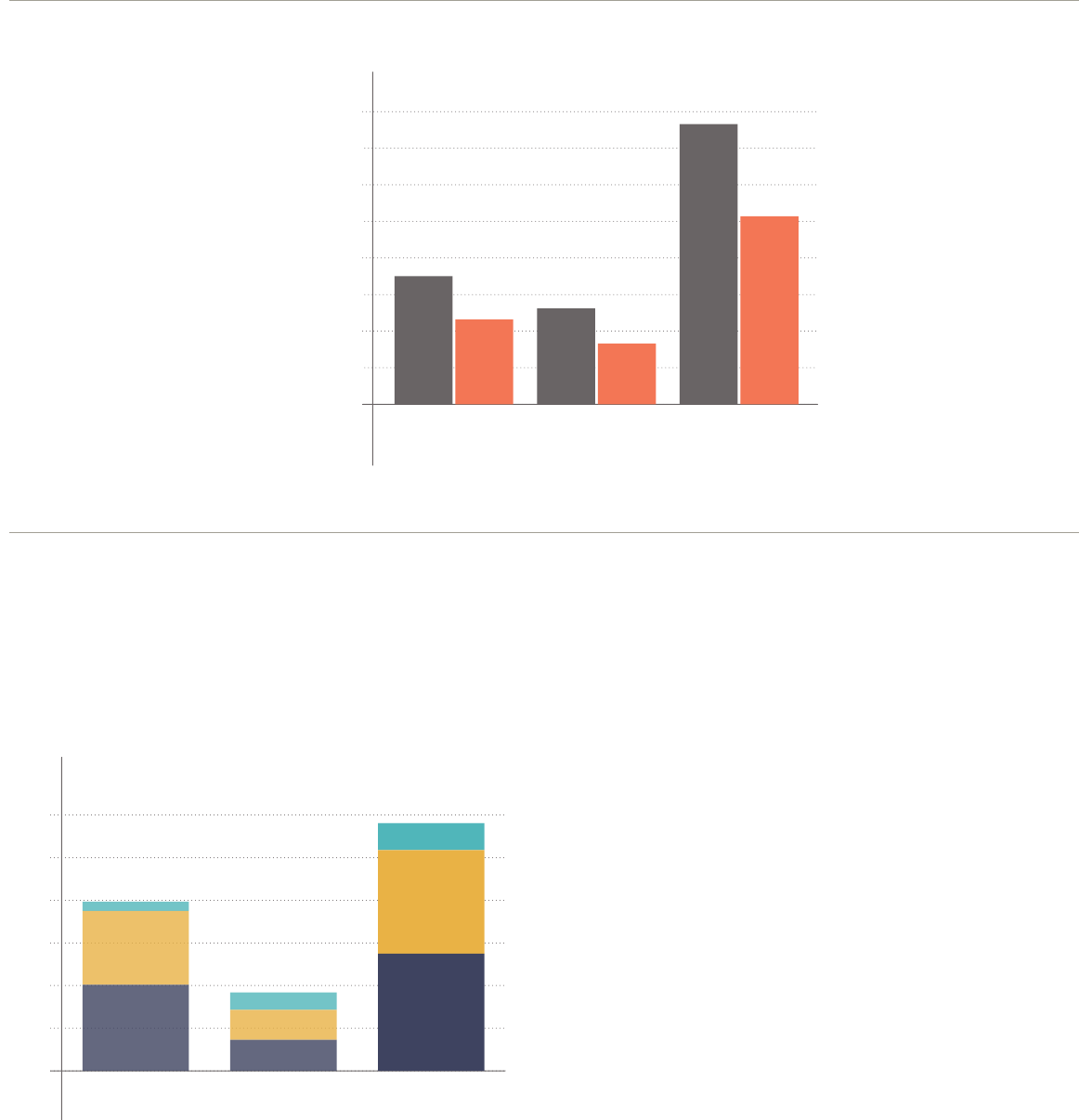
20 GROWING UP PHILLY: The Health and Well-being of Philadelphia’s Children
SUICIDAL IDEATION AND ATTEMPT, continued
Both suicidal ideation and
suicide attempts were also
higher among LGBTQ+ youth
than heterosexual youth and
the citywide youth population.
0%
5%
10%
15%
20%
25%
30%
35%
40%
Attempted Suicide
Suicidal Thoughts
Heterosexual Teens LGBTQ+ TeensCitywide
Neonatal Abstinence Syndrome
| rate per 1,000 live births
Asthma-related
Emergency Department visits
| by age group
Asthma-related
Emergency Department visits
| by age group and sex
Asthma hospitalizations
| per 10,000 children by race/ethnicity
Asthma hospitalizations
among children
| by insurance status
Injury-related Emergency
Department visits
| by age group
Injury-related Emergency
Room visits
| by age group and sex
Youth entering an out-of-home placement
| by age* group
Asthma hospitalizations
| per 10,000 children (under age 18)
ASIAN
HISPANIC
BLACK
WHITE
CITYWIDE
7,951
4,992
2,447
13.8
13.713.7
10.9
17.4%
15,540
34.9%
13.8%
0
2,000
4,000
6,000
8,000
10,000
12,000
14,000
16,000
18,000
CITYWIDE
13-19 YRS
6-12 YRS
<6 YRS
13-19 YRS
6-12 YRS
<6 YRS
13-19 YRS
6-12 YRS
<6 YRS
20182017201620152014
0
2,000
4,000
6,000
8,000
10,000
12,000
14,000
16,000
18,000
13-19 yrs
6-12 yrs
< 6 yrs
TotalFemale Male
2,477
1,410
1,067
2,947
4,922
2,045
3,028
4,992
7,951
0
20
40
60
80
100
2018201720162015201420132012201120102009
0
10
20
30
40
50
60
70
80
ASIAN*HISPANICBLACK*WHITE*
12.9
0
300
600
900
1,200
1,500
UninsuredOtherMedicaid Private
Insurance
284
70.5
1,497
45
63.2
18.3
69
43,058
15,684
14,057
13,194
5,000
CITYWIDE
13-19 YRS
6-12 YRS
<6 YRS
10,000
15,000
20,000
25,000
30,000
35,000
40,000
45,000
50,000
Citywide
13-19 yrs
6-12 yrs
<6 yrs
20182017201620152014
0
10,000
20,000
30,000
40,000
50,000
13-19 yrs
6-12 yrs
< 6 yrs
TotalFemale Male
7,599
15,684
13,194
14,057
7,877
7,320
8,084
5,874
6,180
0
300
600
900
1,200
1,500
18+ years13-18 years6-12 years0-5 years
1,412
664
1,033
30
Obesity among children ages 5-18
| by race/ethnicity and sex
Teens who experienced cyberbullying
| by sex
0%
5%
10%
15%
20%
25%
30%
FEMALE
MALE
Asian*HispanicWhite*Black*Citywide
22.0%
20.4%
21.4%
27.5%
18.5%
21.8%
23.8%
20.3%
23.2%
10.3%
3%
6%
9%
12%
15%
FEMALE
MALE
CITYWIDE
CITYWIDE
FEMALE
MALE
20192017201520132011
10.3%
10.7%
11.8%
Depressive symptoms among teens
| by race/ethnicity
Depressive symptoms among teens
| by sexual orientation
Suicidal ideation and suicide attempts among teens
Suicidal ideation
| by sex and race/ethnicity
Suicidal ideation and attempts
| by sexual orientation
20%
30%
40%
50%
Hispanic/Latino
White
Black
201920172015201320112009200720032001
39.8%
41.6%
45.7%
22.0%
20.8%
11.6%
25.7%
20.2%
14.6%
22.0%
9.8%
17.5%
13.1%
38.3%
15.2%
12.6%
36.3%
59.0%
31.5%
29.8%
50.5%
40.3%
Depressive symptoms among teens
| by sex
20%
30%
40%
50%
60%
Citywide
Female %
Male %
201920172015201320112009200720032001
HISPANIC
BLACK*
WHITE*
0% 10% 20% 30% 40% 50% 60% 70%
Heterosexual Teens
LGBTQ+ Teens
Citywide
5%
10%
15%
20%
25%
Attempt
Thoughts
2019201720152013201120092007200520032001
0%
5%
10%
15%
20%
25%
FEMALE
MALE
Hispanic White* Black*
8.3%
Suicide-related Emergency Department
visits
| by age group and sex
0
100
200
300
400
500
600
<10 YRS
10-14 YRS
15-19 YRS
TotalMaleFemale
202
275
243
63
73
70
41
173
22
Opioid-related Emergency Department
visits
| by age group and sex
Tobacco use in the past 30 days among teens
Teens currently using vaping products
| by race/ethnicity
Current teen marijuana use
| by year
Opioid-related Emergency Department visits
among youth
0
200
400
600
800
1,000
<10
10-14
15-19
TotalMaleFemale
506
789
60
125
283
23
70
37
55
15.8%
2.1%
3.5%
7.2%
2.8%
4.7%
10.5%
8.6%
6.0%
6.6%
6.8%
5.2%
7.3%
21.0%
17.9%
21.6%
25.1%
21.3%
19.0%
18.8%
23.9%
160
232
201
224
161
21.4%
Prescription pain medication
misuse amoung teens
| by race/ethnicity
0%
3%
6%
9%
12%
15%
HispanicWhiteBlackCitywide
13.7%
14.7%
4.9%
9.9%
CITYWIDE
HISPANIC
BLACK*
WHITE*
<10 YRS
10-14 YRS
15-19 YRS
0%
5%
10%
15%
20%
Cigar Use
Cigarette Use
2019201720152013201120092 007200520032001
0%
3%
6%
9%
12%
15%
HispanicWhite*Black*Citywide
7.1%
5.1%
14.3%
10.4%
10%
15%
20%
25%
30%
2019201720152013201120092007200520032001
58.8
59.5
71
85.6
97.1
98.8
94.6
71.2
55.1
0
2
4
6
8
10
12
14
16
20182017201620152014201320122011201020092008
9.1
9.3
8.4
6.2
6.5
6.2
4.5
SUICIDE
ATTEMPTS
SUICIDAL
IDEATION
SUICIDE
ATTEMPTS
SUICIDAL
IDEATION
0
100
200
300
400
20182017201620152014
13.9%
10.7% 10.8%
9.6%
7.5%
SOURCE: 2017-2019 Philadelphia Youth Risk Behavior Surveillance System
0%
5%
10%
15%
20%
25%
30%
35%
40%
Attempted Suicide
Suicidal Thoughts
Heterosexual Teens LGBTQ+ TeensCitywide
Neonatal Abstinence Syndrome
| rate per 1,000 live births
Asthma-related
Emergency Department visits
| by age group
Asthma-related
Emergency Department visits
| by age group and sex
Asthma hospitalizations
| per 10,000 children by race/ethnicity
Asthma hospitalizations
among children
| by insurance status
Injury-related Emergency
Department visits
| by age group
Injury-related Emergency
Room visits
| by age group and sex
Youth entering an out-of-home placement
| by age* group
Asthma hospitalizations
| per 10,000 children (under age 18)
ASIAN
HISPANIC
BLACK
WHITE
CITYWIDE
7,951
4,992
2,447
13.8
13.713.7
10.9
17.4%
15,540
34.9%
13.8%
0
2,000
4,000
6,000
8,000
10,000
12,000
14,000
16,000
18,000
CITYWIDE
13-19 YRS
6-12 YRS
<6 YRS
13-19 YRS
6-12 YRS
<6 YRS
13-19 YRS
6-12 YRS
<6 YRS
20182017201620152014
0
2,000
4,000
6,000
8,000
10,000
12,000
14,000
16,000
18,000
13-19 yrs
6-12 yrs
< 6 yrs
TotalFemale Male
2,477
1,410
1,067
2,947
4,922
2,045
3,028
4,992
7,951
0
20
40
60
80
100
2018201720162015201420132012201120102009
0
10
20
30
40
50
60
70
80
ASIAN*HISPANICBLACK*WHITE*
12.9
0
300
600
900
1,200
1,500
UninsuredOtherMedicaid Private
Insurance
284
70.5
1,497
45
63.2
18.3
69
43,058
15,684
14,057
13,194
5,000
CITYWIDE
13-19 YRS
6-12 YRS
<6 YRS
10,000
15,000
20,000
25,000
30,000
35,000
40,000
45,000
50,000
Citywide
13-19 yrs
6-12 yrs
<6 yrs
20182017201620152014
0
10,000
20,000
30,000
40,000
50,000
13-19 yrs
6-12 yrs
< 6 yrs
TotalFemale Male
7,599
15,684
13,194
14,057
7,877
7,320
8,084
5,874
6,180
0
300
600
900
1,200
1,500
18+ years13-18 years6-12 years0-5 years
1,412
664
1,033
30
Obesity among children ages 5-18
| by race/ethnicity and sex
Teens who experienced cyberbullying
| by sex
0%
5%
10%
15%
20%
25%
30%
FEMALE
MALE
Asian*HispanicWhite*Black*Citywide
22.0%
20.4%
21.4%
27.5%
18.5%
21.8%
23.8%
20.3%
23.2%
10.3%
3%
6%
9%
12%
15%
FEMALE
MALE
CITYWIDE
CITYWIDE
FEMALE
MALE
20192017201520132011
10.3%
10.7%
11.8%
Depressive symptoms among teens
| by race/ethnicity
Depressive symptoms among teens
| by sexual orientation
Suicidal ideation and suicide attempts among teens
Suicidal ideation
| by sex and race/ethnicity
Suicidal ideation and attempts
| by sexual orientation
20%
30%
40%
50%
Hispanic/Latino
White
Black
201920172015201320112009200720032001
39.8%
41.6%
45.7%
22.0%
20.8%
11.6%
25.7%
20.2%
14.6%
22.0%
9.8%
17.5%
13.1%
38.3%
15.2%
12.6%
36.3%
59.0%
31.5%
29.8%
50.5%
40.3%
Depressive symptoms among teens
| by sex
20%
30%
40%
50%
60%
Citywide
Female %
Male %
201920172015201320112009200720032001
HISPANIC
BLACK*
WHITE*
0% 10% 20% 30% 40% 50% 60% 70%
Heterosexual Teens
LGBTQ+ Teens
Citywide
5%
10%
15%
20%
25%
Attempt
Thoughts
2019201720152013201120092007200520032001
0%
5%
10%
15%
20%
25%
FEMALE
MALE
Hispanic White* Black*
8.3%
Suicide-related Emergency Department
visits
| by age group and sex
0
100
200
300
400
500
600
<10 YRS
10-14 YRS
15-19 YRS
TotalMaleFemale
202
275
243
63
73
70
41
173
22
Opioid-related Emergency Department
visits
| by age group and sex
Tobacco use in the past 30 days among teens
Teens currently using vaping products
| by race/ethnicity
Current teen marijuana use
| by year
Opioid-related Emergency Department visits
among youth
0
200
400
600
800
1,000
<10
10-14
15-19
TotalMaleFemale
506
789
60
125
283
23
70
37
55
15.8%
2.1%
3.5%
7.2%
2.8%
4.7%
10.5%
8.6%
6.0%
6.6%
6.8%
5.2%
7.3%
21.0%
17.9%
21.6%
25.1%
21.3%
19.0%
18.8%
23.9%
160
232
201
224
161
21.4%
Prescription pain medication
misuse amoung teens
| by race/ethnicity
0%
3%
6%
9%
12%
15%
HispanicWhiteBlackCitywide
13.7%
14.7%
4.9%
9.9%
CITYWIDE
HISPANIC
BLACK*
WHITE*
<10 YRS
10-14 YRS
15-19 YRS
0%
5%
10%
15%
20%
Cigar Use
Cigarette Use
2019201720152013201120092 007200520032001
0%
3%
6%
9%
12%
15%
HispanicWhite*Black*Citywide
7.1%
5.1%
14.3%
10.4%
10%
15%
20%
25%
30%
2019201720152013201120092007200520032001
58.8
59.5
71
85.6
97.1
98.8
94.6
71.2
55.1
0
2
4
6
8
10
12
14
16
20182017201620152014201320122011201020092008
9.1
9.3
8.4
6.2
6.5
6.2
4.5
SUICIDE
ATTEMPTS
SUICIDAL
IDEATION
SUICIDE
ATTEMPTS
SUICIDAL
IDEATION
0
100
200
300
400
20182017201620152014
13.9%
10.7% 10.8%
9.6%
7.5%
SUICIDE-RELATED EMERGENCY DEPARTMENT VISITS
Suicide-related emergency department visits were highest among females aged 15 to
19. This follows a national trend that a higher percentage of female teens are more likely
than male teens to attempt suicide (9 percent) and experience suicide-related emergency
department visits (3 percent).
Suicide-related emergency
department visits for females are
likely higher due to use of less
lethal means; males are more
likely to use firearms for suicide
whereas females are more likely
to use other less lethal means.
16
As a result, females are more likely
to survive a suicide attempt and
require medical attention or be
hospitalized for their attempts.
SOURCE: 2018 Syndromic Surveillance, PDPH
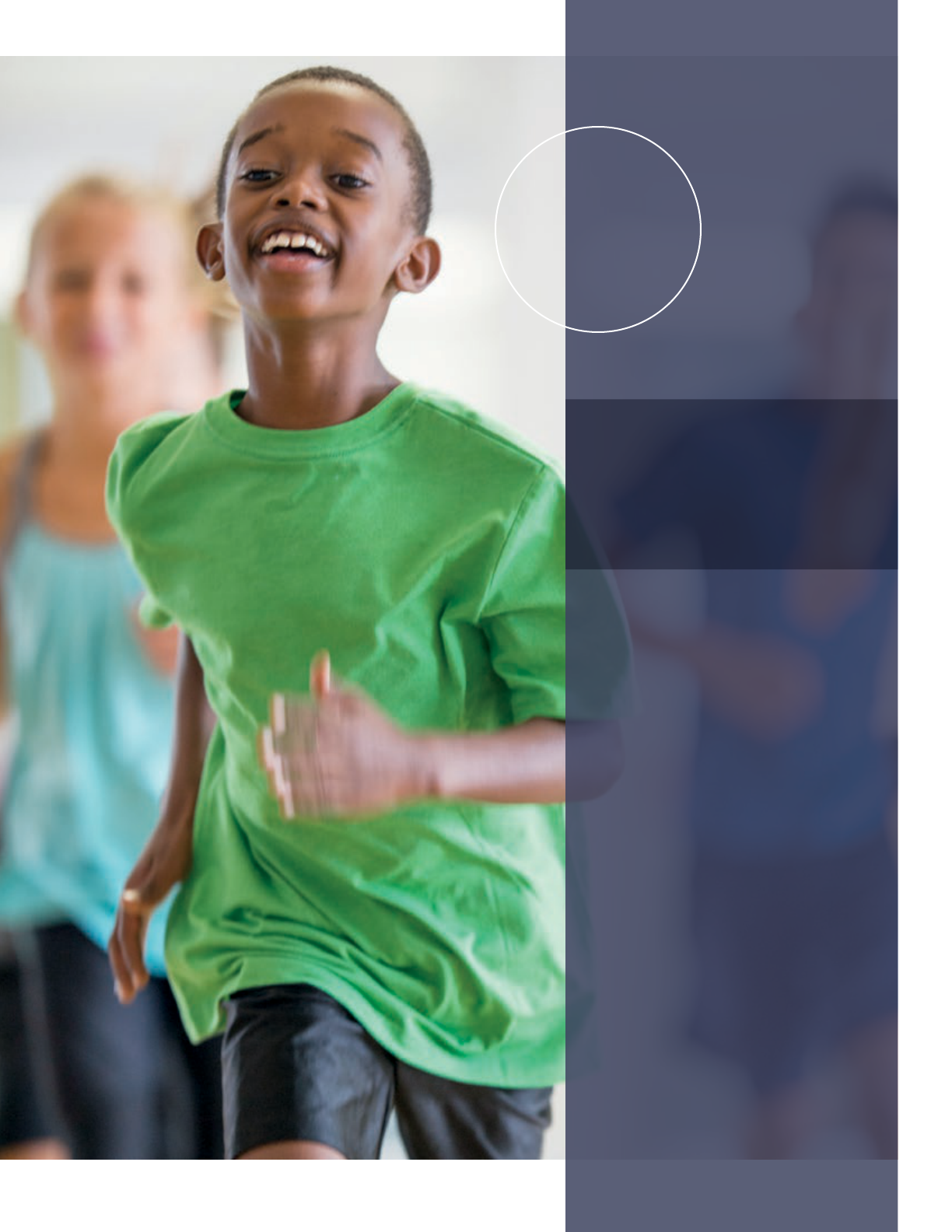
GROWING UP PHILLY: The Health and Well-being of Philadelphia’s Children 21
Health
Behaviors
2
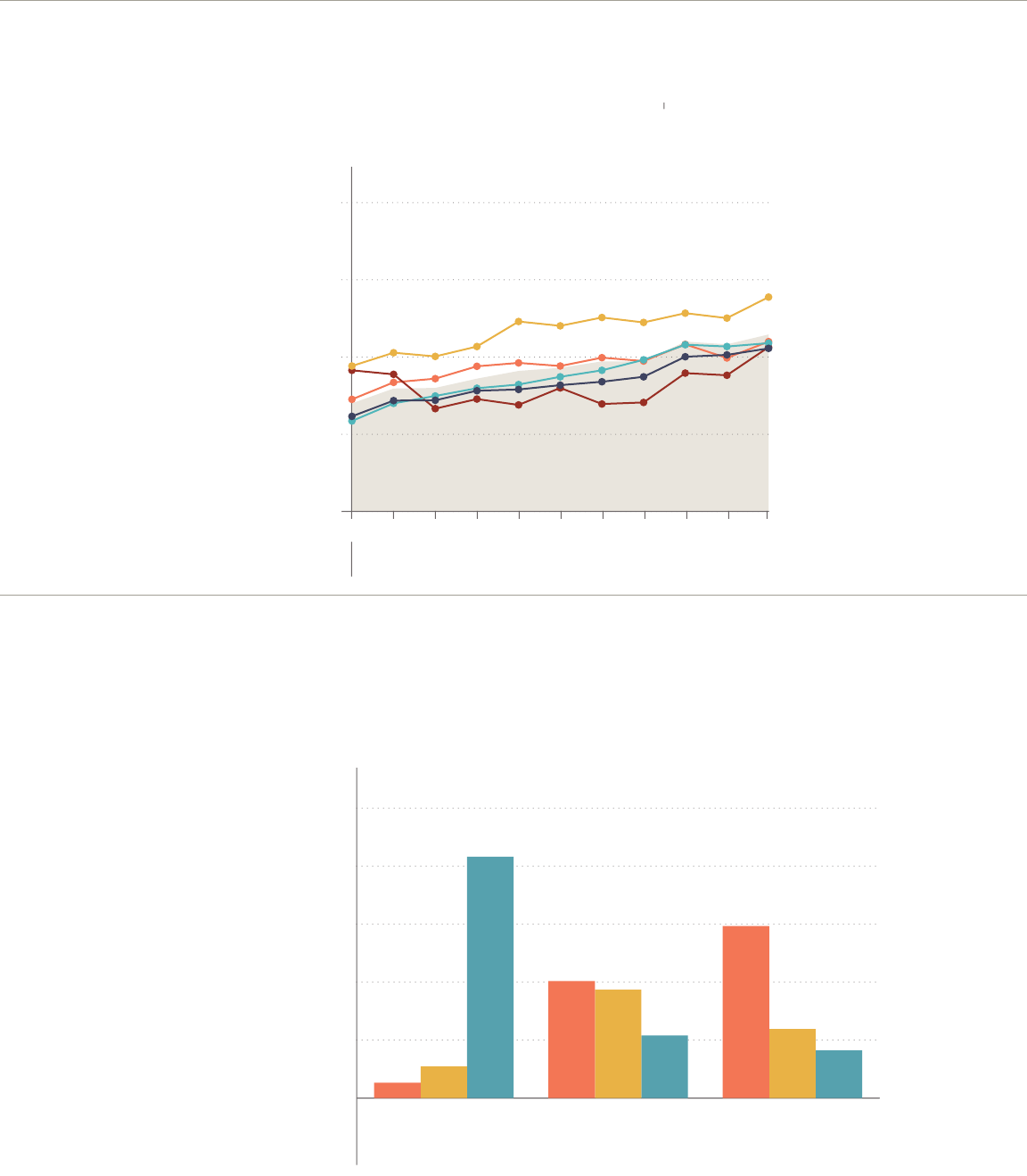
22 GROWING UP PHILLY: The Health and Well-being of Philadelphia’s Children
Kindergartners scoring at or above benchmarks
for competencies
| by race/ethnicity
21.4%
27.4%
37.1%
51.9%
32.1%
27.7%
25.1%
25.2%
31.4%
22.7%
43.3%
41.9%
5.3%
37.4%
23.8%
40.3%
83.2%
1.2%
1.0%
1.2%
2.2%
1.0%
12.4%
4.7%
21.6%
16.4%
59.3%
0%
20%
40%
60%
80%
100%
HispanicWhite*Black*
Depressive symptoms among teens
| by race/ethnicity and sex
Infant sleep chracteristics
Prenatal substance use among
Philly PRAMS respondents
MALE FEMALE
MALE FEMALE
13-15 year olds who have received
HPV vaccine
| by race/ethnicity
Adequate Prenatal Care
| by race/ethnicity
6,048
6,537
0%
10%
20%
30%
40%
50%
60%
70%
80%
Asian*Hispanic White* Black*Citywide
67.3%
71.9%
63.8%
73.6%
72.9%
0% 5% 10% 15% 20% 25% 30% 35%
White*
Multi-
racial*
Hispanic
Black*
Asian*
Learning
Engagement
Emerging
Academic
Learning
Engagement
Emerging
Academic
Learning
Engagement
Emerging
Academic
Learning
Engagement
Emerging
Academic
Learning
Engagement
Emerging
Academic
18.6%
18.6%
16.2%
10.8%
17.6%
14.6%
16.4%
17.3%
27.0%
22.0%
12.6%
19.4%
23.7%
25.1%
0%
20%
40%
60%
80%
100%
USUALLY
RARELY
NEVER
On their stomachOn their sideOn their back
10.9%
0% 3% 6% 9% 12% 15%
Prescription
pain relievers
Marijuana or hash
Synthetic
marijuana
Methadone, naxolone,
subutex, or Suboxone
Heroin
Amphetamines
Cocaine
Suicide attempts
| by sex and race/ethnicity
Breastfeeding duration 2–6 months postpartum
Breastfeeding indicators
16.2%
8.8%
12.8%
33.3%
57.0%
84.9%
87.8%
80.1%
87.0%
87.6%
79.2%
57.2%
49.3%
59.3%
44.4%
22.2%
10.1%
7.3%
11.1%
0%
5%
10%
15%
FEMALE
MALE
Hispanic White* Black*
0%
10%
20%
30%
40%
50%
17 weeks or more16 weeks< 16 weeks
0%
20%
40%
60%
80%
100%
Any breastfeeding or feeding
pumped milk at 8 weeks
Ever breastfed or
pumped breast milk
ASIAN*HISPANICBLACK*WHITE*ALL
0%
25%
50%
75%
100%
ASIAN*
AMERICAN INDIAN/
ALASKAN NATIVE*
HISPANIC
BLACK*
WHITE*
CITYWIDE
20182017201620152014201320122011201020092008
57.3%
57.3%
55.0%
54.5%
53.2%
52.8%
Kindergartners scoring at or above benchmarks
for competencies
| by race/ethnicity
21.4%
27.4%
37.1%
51.9%
32.1%
27.7%
25.1%
25.2%
31.4%
22.7%
43.3%
41.9%
5.3%
37.4%
23.8%
40.3%
83.2%
1.2%
1.0%
1.2%
2.2%
1.0%
12.4%
4.7%
21.6%
16.4%
59.3%
0%
20%
40%
60%
80%
100%
HispanicWhite*Black*
Depressive symptoms among teens
| by race/ethnicity and sex
Infant sleep chracteristics
Prenatal substance use among
Philly PRAMS respondents
MALE FEMALE
MALE FEMALE
13-15 year olds who have received
HPV vaccine
| by race/ethnicity
Adequate Prenatal Care
| by race/ethnicity
6,048
6,537
0%
10%
20%
30%
40%
50%
60%
70%
80%
Asian*Hispanic White* Black*Citywide
67.3%
71.9%
63.8%
73.6%
72.9%
0% 5% 10% 15% 20% 25% 30% 35%
White*
Multi-
racial*
Hispanic
Black*
Asian*
Learning
Engagement
Emerging
Academic
Learning
Engagement
Emerging
Academic
Learning
Engagement
Emerging
Academic
Learning
Engagement
Emerging
Academic
Learning
Engagement
Emerging
Academic
18.6%
18.6%
16.2%
10.8%
17.6%
14.6%
16.4%
17.3%
27.0%
22.0%
12.6%
19.4%
23.7%
25.1%
0%
20%
40%
60%
80%
100%
USUALLY
RARELY
NEVER
On their stomachOn their sideOn their back
10.9%
0% 3% 6% 9% 12% 15%
Prescription
pain relievers
Marijuana or hash
Synthetic
marijuana
Methadone, naxolone,
subutex, or Suboxone
Heroin
Amphetamines
Cocaine
Suicide attempts
| by sex and race/ethnicity
Breastfeeding duration 2–6 months postpartum
Breastfeeding indicators
16.2%
8.8%
12.8%
33.3%
57.0%
84.9%
87.8%
80.1%
87.0%
87.6%
79.2%
57.2%
49.3%
59.3%
44.4%
22.2%
10.1%
7.3%
11.1%
0%
5%
10%
15%
FEMALE
MALE
Hispanic White* Black*
0%
10%
20%
30%
40%
50%
17 weeks or more16 weeks< 16 weeks
0%
20%
40%
60%
80%
100%
Any breastfeeding or feeding
pumped milk at 8 weeks
Ever breastfed or
pumped breast milk
ASIAN*HISPANICBLACK*WHITE*ALL
0%
25%
50%
75%
100%
ASIAN*
AMERICAN INDIAN/
ALASKAN NATIVE*
HISPANIC
BLACK*
WHITE*
CITYWIDE
20182017201620152014201320122011201020092008
57.3%
57.3%
55.0%
54.5%
53.2%
52.8%
ADEQUATE PRENATAL CARE
Adequate and early
prenatal care can lead
to improved health
outcomes for both mothers
and their infants. Early
prenatal care is important
because mothers can
receive information and
guidance on steps they can
take to ensure the healthiest
pregnancy possible.
17
The percentage of mothers in Philadelphia who received adequate
prenatal care has increased over the past decade, with 57. 3 percent of
mothers receiving care. Generally, the prevalence estimates were similar
among all racial/ethnic groups.
SAFE SLEEP
To reduce risk factors for
sleep-related infant deaths,
the American Academy of
Pediatrics recommends
placing infants to sleep on
their backs, room sharing
but not bed sharing, and
keeping soft objects and
loose bedding out of the
infant’s sleep environment.
In 2018, 83.2 percent of mothers that were surveyed 2 to 6 months
after delivery reported that they usually placed their infant on their
back. This estimate was higher than the Healthy People 2020 target
(75.8 percent).
SOURCE: 2008-2018 Vital Statistics, PDPH *Non-Hispanic
SOURCE: 2018 Philadelphia Pregnancy Risk Assessment Monitoring System
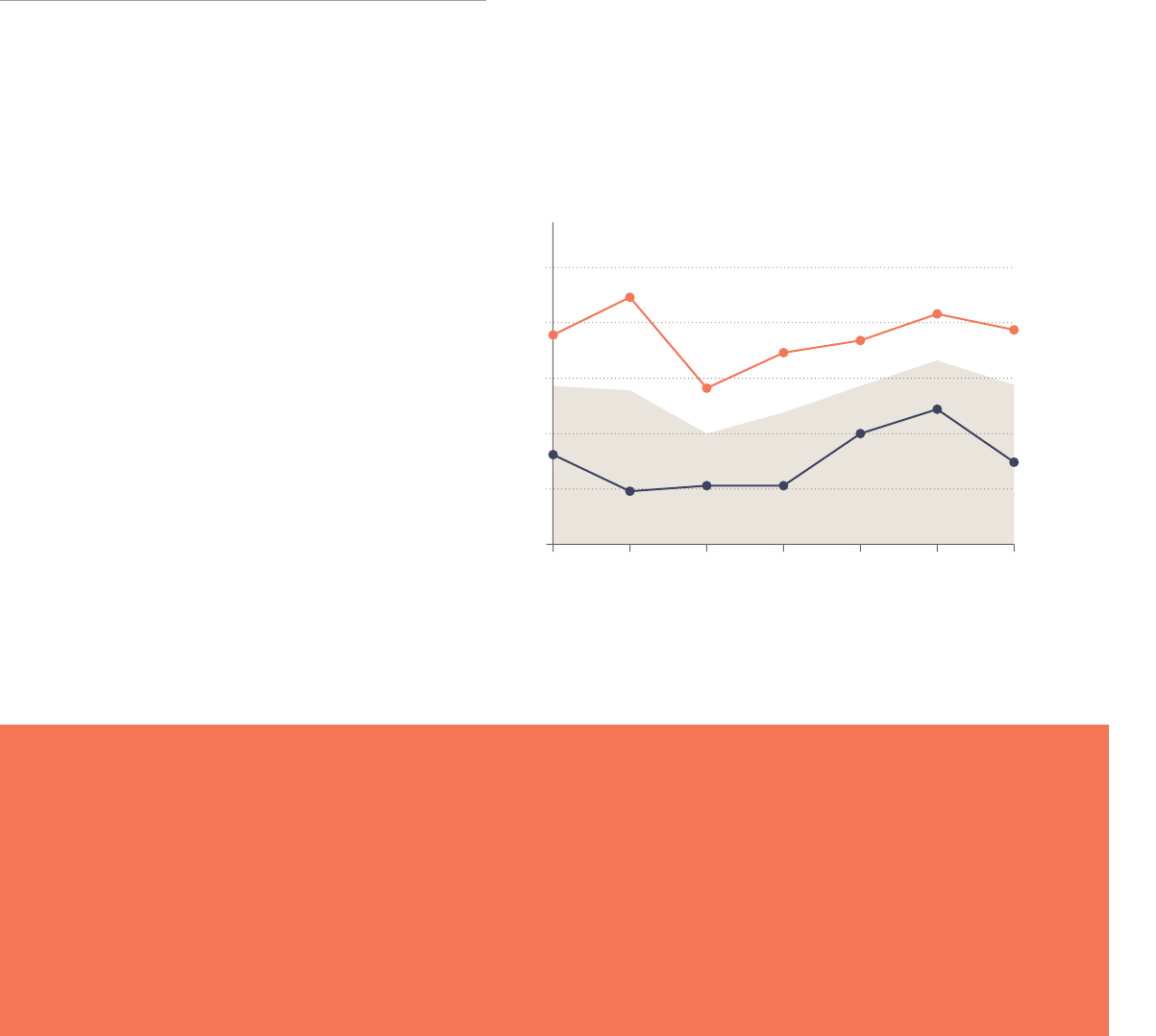
GROWING UP PHILLY: The Health and Well-being of Philadelphia’s Children 23
PHYSICAL INACTIVITY
The Centers for Disease Control and Prevention recommends that school-aged children
and adolescents engage in one hour or more of moderate exercise daily. This includes
aerobic exercise daily, muscle-strengthening activities at least 3 days per week and bone-
strengthening activities (like jumping rope or running) at least three days per week.
18
Children are considered inactive
if they do not exercise for 60
minutes at least one day per week.
Physical inactivity among teens
remained relatively constant from
2007 to 2019, at 24.4 percent
in 2017. Physical inactivity was
higher among females (29.4
percent) than males (17.4 percent)
in 2019.
Physical inactivity among teens
| by race/ethnicity
Physical inactivity among teens
| by sex
Soda consumption among teens
once or more per day
10%
15%
20%
25%
30%
HISPANIC
WHITE*
BLACK*
2019201720152013201120092007
10%
15%
20%
25%
30%
35%
FEMALE
MALE
CITYWIDE
2019201720152013201120092007
29.4%
22.6%
17.0%
27.3%
17.4%
13.4%
13.5%
11.7%
9.2%
33.9%
18.7%
17.1%
17.2%
24.4%
5%
10%
15%
20%
25%
30%
35%
HISPANIC
WHITE*
BLACK*
CITYWIDE
2019201720152013201120092007
Current alcohol consumption in the last
30 days
| by race/ethnicity
Current alcohol
consumption in the last
30 days
| by sexual orientation
10%
20%
30%
40%
50%
60%
70%
80%
HISPANIC
WHITE*
BLACK*
CITYWIDE
201920172015201320112009200720032001
0% 5% 10% 15% 20% 25% 30% 35%
Currently Drink Binge Drink
LGBTQ+
Teens
Heterosexual
Teens
13.8%
4.3%
15.9%
34.9%
Teen condom use during last sexual encounter
Teen births among women aged 15-19
| per 1,000
women by race/ethnicity
48.7%
55.2%
41.1
29.6
24.3
7.3
5.6
40%
50%
60%
70%
80%
2019201720152013201120092007200520032001
Secondhand smoke exposure at home
Children screened for lead exposure
before the age of 24 months
People living in poverty
| by age group and location
Childhood poverty
| by race/ethnicity
0%
10%
20%
201820172016201520142013201220112010
0
20
40
60
80
100
120
asian
hispanic
black
white
citywide
20172016201520142013201220112010200920082007
ASIAN*
WHITE*
HISPANIC
BLACK*
CITYWIDE
15.0%
13.7%
15.4%
75.1%
20%
30%
40%
50%
60%
70%
80%
201620152014201320122011201020092008200720062005
PHILADELPHIA
PENNSYLVANIA
UNITED STATES
0%
5%
10%
15%
20%
25%
30%
35%
40%
Children <5Children age 5-17Children <18Total Population: All Ages
18.0%
17.0%
19.5%
13.1%
17.6%
16.0%
16.8%
12.2%
24.5%
34.6%
35.9%
30.8%
55.9%
57.8%
59.6%
62.8%
64.4%
70.2%
64.3%
0%
10%
20%
30%
40%
50%
Asian*HispanicBlack*White*
Citywide: 35%
16%
38%
49%
21%
17.5%
SOURCE: 2007-2019 Philadelphia Youth Risk Behavior Surveillance System
“ A lot of kids are kept indoors nowadays because of the crime rates.
Kids used to go outside and play, now they’re stuck indoors playing
videogames, and not getting the exercise they need. They’re not being
socially active and that’s why there’s more obesity.”
— Resident from Philadelphia Community Needs Assessment

24 GROWING UP PHILLY: The Health and Well-being of Philadelphia’s Children
Physical inactivity among teens
| by race/ethnicity
Physical inactivity among teens
| by sex
Soda consumption among teens
once or more per day
10%
15%
20%
25%
30%
HISPANIC
WHITE*
BLACK*
2019201720152013201120092007
10%
15%
20%
25%
30%
35%
FEMALE
MALE
CITYWIDE
2019201720152013201120092007
29.4%
22.6%
17.0%
27.3%
17.4%
13.4%
13.5%
11.7%
9.2%
33.9%
18.7%
17.1%
17.2%
24.4%
5%
10%
15%
20%
25%
30%
35%
HISPANIC
WHITE*
BLACK*
CITYWIDE
2019201720152013201120092007
Current alcohol consumption in the last
30 days
| by race/ethnicity
Current alcohol
consumption in the last
30 days
| by sexual orientation
10%
20%
30%
40%
50%
60%
70%
80%
HISPANIC
WHITE*
BLACK*
CITYWIDE
201920172015201320112009200720032001
0% 5% 10% 15% 20% 25% 30% 35%
Currently Drink Binge Drink
LGBTQ+
Teens
Heterosexual
Teens
13.8%
4.3%
15.9%
34.9%
Teen condom use during last sexual encounter
Teen births among women aged 15-19
| per 1,000
women by race/ethnicity
48.7%
55.2%
41.1
29.6
24.3
7.3
5.6
40%
50%
60%
70%
80%
2019201720152013201120092007200520032001
Secondhand smoke exposure at home
Children screened for lead exposure
before the age of 24 months
People living in poverty
| by age group and location
Childhood poverty
| by race/ethnicity
0%
10%
20%
201820172016201520142013201220112010
0
20
40
60
80
100
120
asian
hispanic
black
white
citywide
20172016201520142013201220112010200920082007
ASIAN*
WHITE*
HISPANIC
BLACK*
CITYWIDE
15.0%
13.7%
15.4%
75.1%
20%
30%
40%
50%
60%
70%
80%
201620152014201320122011201020092008200720062005
PHILADELPHIA
PENNSYLVANIA
UNITED STATES
0%
5%
10%
15%
20%
25%
30%
35%
40%
Children <5Children age 5-17Children <18Total Population: All Ages
18.0%
17.0%
19.5%
13.1%
17.6%
16.0%
16.8%
12.2%
24.5%
34.6%
35.9%
30.8%
55.9%
57.8%
59.6%
62.8%
64.4%
70.2%
64.3%
0%
10%
20%
30%
40%
50%
Asian*HispanicBlack*White*
Citywide: 35%
16%
38%
49%
21%
17.5%
PHYSICAL INACTIVITY, continued
Physical inactivity was also higher
among racial/ethnic minorities,
including black/African-American
teens and Hispanic teens than
among white teens.
Physical inactivity among teens
| by race/ethnicity
Physical inactivity among teens
| by sex
Soda consumption among teens
once or more per day
10%
15%
20%
25%
30%
HISPANIC
WHITE*
BLACK*
2019201720152013201120092007
10%
15%
20%
25%
30%
35%
FEMALE
MALE
CITYWIDE
2019201720152013201120092007
29.4%
22.6%
17.0%
27.3%
17.4%
13.4%
13.5%
11.7%
9.2%
33.9%
18.7%
17.1%
17.2%
24.4%
5%
10%
15%
20%
25%
30%
35%
HISPANIC
WHITE*
BLACK*
CITYWIDE
2019201720152013201120092007
Current alcohol consumption in the last
30 days
| by race/ethnicity
Current alcohol
consumption in the last
30 days
| by sexual orientation
10%
20%
30%
40%
50%
60%
70%
80%
HISPANIC
WHITE*
BLACK*
CITYWIDE
201920172015201320112009200720032001
0% 5% 10% 15% 20% 25% 30% 35%
Currently Drink Binge Drink
LGBTQ+
Teens
Heterosexual
Teens
13.8%
4.3%
15.9%
34.9%
Teen condom use during last sexual encounter
Teen births among women aged 15-19
| per 1,000
women by race/ethnicity
48.7%
55.2%
41.1
29.6
24.3
7.3
5.6
40%
50%
60%
70%
80%
2019201720152013201120092007200520032001
Secondhand smoke exposure at home
Children screened for lead exposure
before the age of 24 months
People living in poverty
| by age group and location
Childhood poverty
| by race/ethnicity
0%
10%
20%
201820172016201520142013201220112010
0
20
40
60
80
100
120
asian
hispanic
black
white
citywide
20172016201520142013201220112010200920082007
ASIAN*
WHITE*
HISPANIC
BLACK*
CITYWIDE
15.0%
13.7%
15.4%
75.1%
20%
30%
40%
50%
60%
70%
80%
201620152014201320122011201020092008200720062005
PHILADELPHIA
PENNSYLVANIA
UNITED STATES
0%
5%
10%
15%
20%
25%
30%
35%
40%
Children <5Children age 5-17Children <18Total Population: All Ages
18.0%
17.0%
19.5%
13.1%
17.6%
16.0%
16.8%
12.2%
24.5%
34.6%
35.9%
30.8%
55.9%
57.8%
59.6%
62.8%
64.4%
70.2%
64.3%
0%
10%
20%
30%
40%
50%
Asian*HispanicBlack*White*
Citywide: 35%
16%
38%
49%
21%
17.5%
SOURCE: 2007-2019 Philadelphia Youth Risk Behavior Surveillance System
*Non-Hispanic
SOURCE: 2007-2019 Philadelphia Youth Risk Behavior Surveillance System
*Non-Hispanic
SODA CONSUMPTION
Sugar-sweetened beverages are the main source of added sugar for children and
adolescents and increase the risk of obesity and diabetes.
19
In Philadelphia, soda consumption
has declined sharply citywide
among teens and among all major
racial/ethnic groups, especially
after implementation of the
Philadelphia Beverage Tax in 2017.
The drop in soda consumption
was steepest among non-Hispanic
black and Hispanic teens, who
had the highest consumption at
baseline. This was potentially due
to a concentration of convenience
stores selling soft drinks in
Philadelphia’s predominantly
black and low-income
neighborhoods in North
Philadelphia.
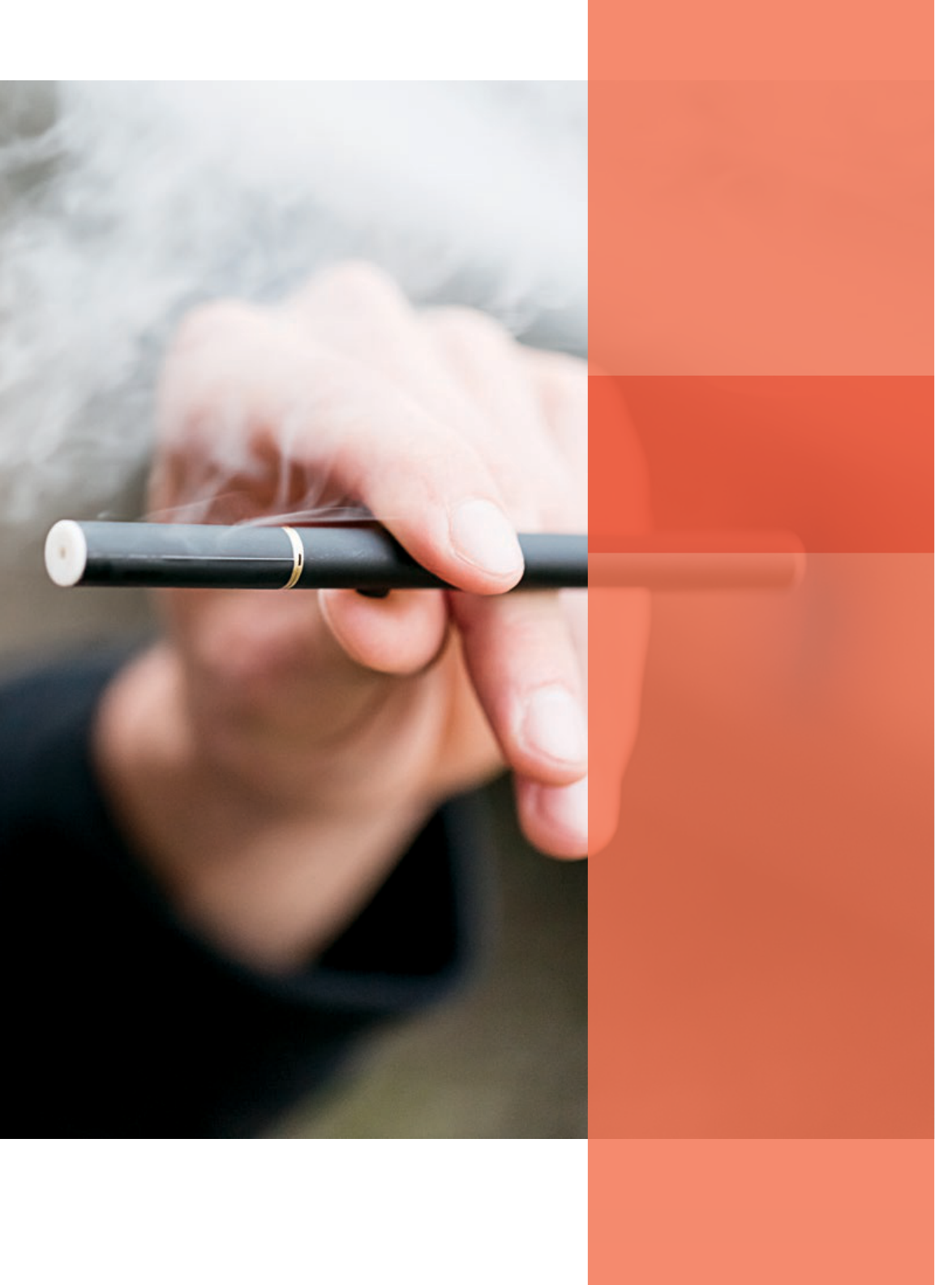
GROWING UP PHILLY: The Health and Well-being of Philadelphia’s Children 25
Substance
Use
Substance use and abuse
among youth and adolescents
can impair both their physical
and intellectual growth.
Substance use places teens
at greater risk for unprotected
sexual activity, driving while
intoxicated, problems in
school, and legal system
involvement, along with other
adverse outcomes.
20
Risk
factors for teen substance
use can include family
history of substance use,
mental health issues, history
of sexual abuse, and low
academic achievement.
21
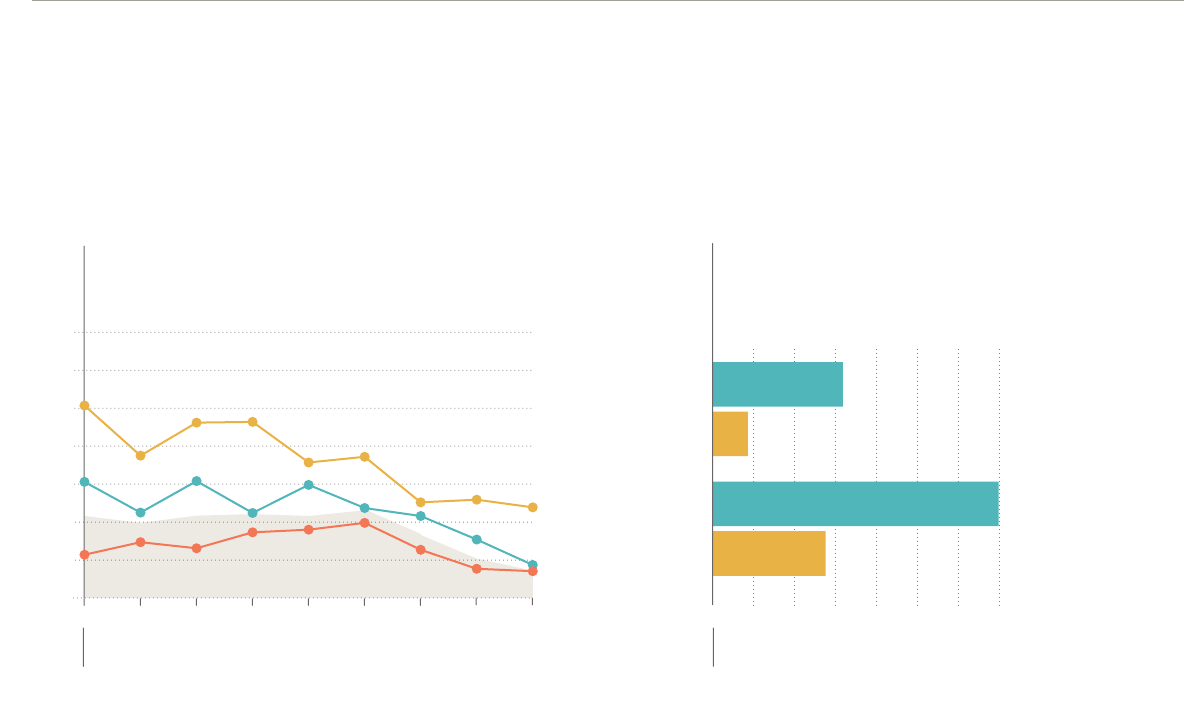
26 GROWING UP PHILLY: The Health and Well-being of Philadelphia’s Children
ALCOHOL USE
Negative consequences of alcohol use include engaging in risky sexual behaviors and
injuries of all types.
22
Alcohol use among teens can impair brain areas associated with
motivation, impulse control, and addiction.
From 2001 to 2013, self-reported
alcohol consumption within
the past 30 days among teens
remained stable. From 2013 to
2019, alcohol consumption among
this population decreased from
33 percent to 17 percent.
The percentage of teens in
Philadelphia consuming alcohol
was lower than the national
percentage (30 percent) in 2019.
Alcohol consumption was
more common among non-
Hispanic white teens (34
percent) than among other
racial/ethnic groups (~19 percent
of Hispanic teens and 17 percent
of non-Hispanic black teens).
Binge drinking (consuming four
or more drinks at one time if
female and five or more drinks
if male) increases the risk for
car crashes, falls, violence, and
alcohol poisoning.
23
In 2019, 5.2 percent of teens in
Philadelphia reported frequent
binge drinking during the past 30
days. Both alcohol consumption
and binge drinking during the
past 30 days were more common
among LGBTQ+ teens compared
to heterosexual teens.
Physical inactivity among teens
| by race/ethnicity
Physical inactivity among teens
| by sex
Soda consumption among teens
once or more per day
10%
15%
20%
25%
30%
HISPANIC
WHITE*
BLACK*
2019201720152013201120092007
10%
15%
20%
25%
30%
35%
FEMALE
MALE
CITYWIDE
2019201720152013201120092007
29.4%
22.6%
17.0%
27.3%
17.4%
13.4%
13.5%
11.7%
9.2%
33.9%
18.7%
17.1%
17.2%
24.4%
5%
10%
15%
20%
25%
30%
35%
HISPANIC
WHITE*
BLACK*
CITYWIDE
2019201720152013201120092007
Current alcohol consumption in the last
30 days
| by race/ethnicity
Current alcohol
consumption in the last
30 days
| by sexual orientation
10%
20%
30%
40%
50%
60%
70%
80%
HISPANIC
WHITE*
BLACK*
CITYWIDE
201920172015201320112009200720032001
0% 5% 10% 15% 20% 25% 30% 35%
Currently Drink Binge Drink
LGBTQ+
Teens
Heterosexual
Teens
13.8%
4.3%
15.9%
34.9%
Teen condom use during last sexual encounter
Teen births among women aged 15-19
| per 1,000
women by race/ethnicity
48.7%
55.2%
41.1
29.6
24.3
7.3
5.6
40%
50%
60%
70%
80%
2019201720152013201120092007200520032001
Secondhand smoke exposure at home
Children screened for lead exposure
before the age of 24 months
People living in poverty
| by age group and location
Childhood poverty
| by race/ethnicity
0%
10%
20%
201820172016201520142013201220112010
0
20
40
60
80
100
120
asian
hispanic
black
white
citywide
20172016201520142013201220112010200920082007
ASIAN*
WHITE*
HISPANIC
BLACK*
CITYWIDE
15.0%
13.7%
15.4%
75.1%
20%
30%
40%
50%
60%
70%
80%
201620152014201320122011201020092008200720062005
PHILADELPHIA
PENNSYLVANIA
UNITED STATES
0%
5%
10%
15%
20%
25%
30%
35%
40%
Children <5Children age 5-17Children <18Total Population: All Ages
18.0%
17.0%
19.5%
13.1%
17.6%
16.0%
16.8%
12.2%
24.5%
34.6%
35.9%
30.8%
55.9%
57.8%
59.6%
62.8%
64.4%
70.2%
64.3%
0%
10%
20%
30%
40%
50%
Asian*HispanicBlack*White*
Citywide: 35%
16%
38%
49%
21%
17.5%
SOURCE: 2001-2019 Philadelphia Youth Risk Behavior Surveillance System SOURCE: 2017-2019 Philadelphia Youth Risk
Behavior Surveillance System
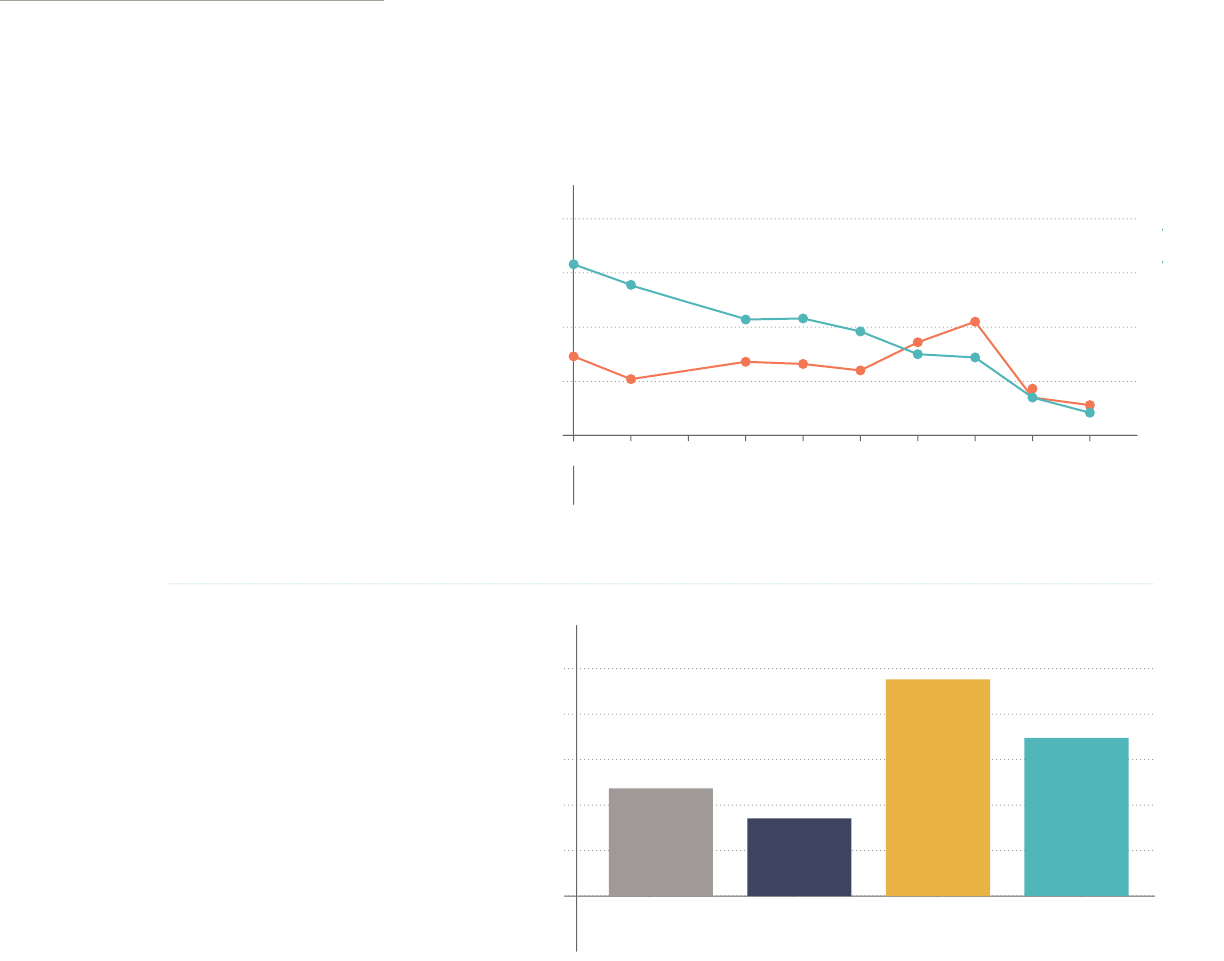
GROWING UP PHILLY: The Health and Well-being of Philadelphia’s Children 27
0%
5%
10%
15%
20%
25%
30%
35%
40%
Attempted Suicide
Suicidal Thoughts
Heterosexual Teens LGBTQ+ TeensCitywide
Neonatal Abstinence Syndrome
| rate per 1,000 live births
Asthma-related
Emergency Department visits
| by age group
Asthma-related
Emergency Department visits
| by age group and sex
Asthma hospitalizations
| per 10,000 children by race/ethnicity
Asthma hospitalizations
among children
| by insurance status
Injury-related Emergency
Department visits
| by age group
Injury-related Emergency
Room visits
| by age group and sex
Youth entering an out-of-home placement
| by age* group
Asthma hospitalizations
| per 10,000 children (under age 18)
ASIAN
HISPANIC
BLACK
WHITE
CITYWIDE
7,951
4,992
2,447
13.8
13.713.7
10.9
17.4%
15,540
34.9%
13.8%
0
2,000
4,000
6,000
8,000
10,000
12,000
14,000
16,000
18,000
CITYWIDE
13-19 YRS
6-12 YRS
<6 YRS
13-19 YRS
6-12 YRS
<6 YRS
13-19 YRS
6-12 YRS
<6 YRS
20182017201620152014
0
2,000
4,000
6,000
8,000
10,000
12,000
14,000
16,000
18,000
13-19 yrs
6-12 yrs
< 6 yrs
TotalFemale Male
2,477
1,410
1,067
2,947
4,922
2,045
3,028
4,992
7,951
0
20
40
60
80
100
2018201720162015201420132012201120102009
0
10
20
30
40
50
60
70
80
ASIAN*HISPANICBLACK*WHITE*
12.9
0
300
600
900
1,200
1,500
UninsuredOtherMedicaid Private
Insurance
284
70.5
1,497
45
63.2
18.3
69
43,058
15,684
14,057
13,194
5,000
CITYWIDE
13-19 YRS
6-12 YRS
<6 YRS
10,000
15,000
20,000
25,000
30,000
35,000
40,000
45,000
50,000
Citywide
13-19 yrs
6-12 yrs
<6 yrs
20182017201620152014
0
10,000
20,000
30,000
40,000
50,000
13-19 yrs
6-12 yrs
< 6 yrs
TotalFemale Male
7,599
15,684
13,194
14,057
7,877
7,320
8,084
5,874
6,180
0
300
600
900
1,200
1,500
18+ years13-18 years6-12 years0-5 years
1,412
664
1,033
30
Obesity among children ages 5-18
| by race/ethnicity and sex
Teens who experienced cyberbullying
| by sex
0%
5%
10%
15%
20%
25%
30%
FEMALE
MALE
Asian*HispanicWhite*Black*Citywide
22.0%
20.4%
21.4%
27.5%
18.5%
21.8%
23.8%
20.3%
23.2%
10.3%
3%
6%
9%
12%
15%
FEMALE
MALE
CITYWIDE
CITYWIDE
FEMALE
MALE
20192017201520132011
10.3%
10.7%
11.8%
Depressive symptoms among teens
| by race/ethnicity
Depressive symptoms among teens
| by sexual orientation
Suicidal ideation and suicide attempts among teens
Suicidal ideation
| by sex and race/ethnicity
Suicidal ideation and attempts
| by sexual orientation
20%
30%
40%
50%
Hispanic/Latino
White
Black
201920172015201320112009200720032001
39.8%
41.6%
45.7%
22.0%
20.8%
11.6%
25.7%
20.2%
14.6%
22.0%
9.8%
17.5%
13.1%
38.3%
15.2%
12.6%
36.3%
59.0%
31.5%
29.8%
50.5%
40.3%
Depressive symptoms among teens
| by sex
20%
30%
40%
50%
60%
Citywide
Female %
Male %
201920172015201320112009200720032001
HISPANIC
BLACK*
WHITE*
0% 10% 20% 30% 40% 50% 60% 70%
Heterosexual Teens
LGBTQ+ Teens
Citywide
5%
10%
15%
20%
25%
Attempt
Thoughts
2019201720152013201120092007200520032001
0%
5%
10%
15%
20%
25%
FEMALE
MALE
Hispanic White* Black*
8.3%
Suicide-related Emergency Department
visits
| by age group and sex
0
100
200
300
400
500
600
<10 YRS
10-14 YRS
15-19 YRS
TotalMaleFemale
202
275
243
63
73
70
41
173
22
Opioid-related Emergency Department
visits
| by age group and sex
Tobacco use in the past 30 days among teens
Teens currently using vaping products
| by race/ethnicity
Current teen marijuana use
| by year
Opioid-related Emergency Department visits
among youth
0
200
400
600
800
1,000
<10
10-14
15-19
TotalMaleFemale
506
789
60
125
283
23
70
37
55
15.8%
2.1%
3.5%
7.2%
2.8%
4.7%
10.5%
8.6%
6.0%
6.6%
6.8%
5.2%
7.3%
21.0%
17.9%
21.6%
25.1%
21.3%
19.0%
18.8%
23.9%
160
232
201
224
161
21.4%
Prescription pain medication
misuse amoung teens
| by race/ethnicity
0%
3%
6%
9%
12%
15%
HispanicWhiteBlackCitywide
13.7%
14.7%
4.9%
9.9%
CITYWIDE
HISPANIC
BLACK*
WHITE*
<10 YRS
10-14 YRS
15-19 YRS
0%
5%
10%
15%
20%
Cigar Use
Cigarette Use
2019201720152013201120092 007200520032001
0%
3%
6%
9%
12%
15%
HispanicWhite*Black*Citywide
7.1%
5.1%
14.3%
10.4%
10%
15%
20%
25%
30%
2019201720152013201120092007200520032001
58.8
59.5
71
85.6
97.1
98.8
94.6
71.2
55.1
0
2
4
6
8
10
12
14
16
20182017201620152014201320122011201020092008
9.1
9.3
8.4
6.2
6.5
6.2
4.5
SUICIDE
ATTEMPTS
SUICIDAL
IDEATION
SUICIDE
ATTEMPTS
SUICIDAL
IDEATION
0
100
200
300
400
20182017201620152014
13.9%
10.7% 10.8%
9.6%
7.5%
0%
5%
10%
15%
20%
25%
30%
35%
40%
Attempted Suicide
Suicidal Thoughts
Heterosexual Teens LGBTQ+ TeensCitywide
Neonatal Abstinence Syndrome
| rate per 1,000 live births
Asthma-related
Emergency Department visits
| by age group
Asthma-related
Emergency Department visits
| by age group and sex
Asthma hospitalizations
| per 10,000 children by race/ethnicity
Asthma hospitalizations
among children
| by insurance status
Injury-related Emergency
Department visits
| by age group
Injury-related Emergency
Room visits
| by age group and sex
Youth entering an out-of-home placement
| by age* group
Asthma hospitalizations
| per 10,000 children (under age 18)
ASIAN
HISPANIC
BLACK
WHITE
CITYWIDE
7,951
4,992
2,447
13.8
13.713.7
10.9
17.4%
15,540
34.9%
13.8%
0
2,000
4,000
6,000
8,000
10,000
12,000
14,000
16,000
18,000
CITYWIDE
13-19 YRS
6-12 YRS
<6 YRS
13-19 YRS
6-12 YRS
<6 YRS
13-19 YRS
6-12 YRS
<6 YRS
20182017201620152014
0
2,000
4,000
6,000
8,000
10,000
12,000
14,000
16,000
18,000
13-19 yrs
6-12 yrs
< 6 yrs
TotalFemale Male
2,477
1,410
1,067
2,947
4,922
2,045
3,028
4,992
7,951
0
20
40
60
80
100
2018201720162015201420132012201120102009
0
10
20
30
40
50
60
70
80
ASIAN*HISPANICBLACK*WHITE*
12.9
0
300
600
900
1,200
1,500
UninsuredOtherMedicaid Private
Insurance
284
70.5
1,497
45
63.2
18.3
69
43,058
15,684
14,057
13,194
5,000
CITYWIDE
13-19 YRS
6-12 YRS
<6 YRS
10,000
15,000
20,000
25,000
30,000
35,000
40,000
45,000
50,000
Citywide
13-19 yrs
6-12 yrs
<6 yrs
20182017201620152014
0
10,000
20,000
30,000
40,000
50,000
13-19 yrs
6-12 yrs
< 6 yrs
TotalFemale Male
7,599
15,684
13,194
14,057
7,877
7,320
8,084
5,874
6,180
0
300
600
900
1,200
1,500
18+ years13-18 years6-12 years0-5 years
1,412
664
1,033
30
Obesity among children ages 5-18
| by race/ethnicity and sex
Teens who experienced cyberbullying
| by sex
0%
5%
10%
15%
20%
25%
30%
FEMALE
MALE
Asian*HispanicWhite*Black*Citywide
22.0%
20.4%
21.4%
27.5%
18.5%
21.8%
23.8%
20.3%
23.2%
10.3%
3%
6%
9%
12%
15%
FEMALE
MALE
CITYWIDE
CITYWIDE
FEMALE
MALE
20192017201520132011
10.3%
10.7%
11.8%
Depressive symptoms among teens
| by race/ethnicity
Depressive symptoms among teens
| by sexual orientation
Suicidal ideation and suicide attempts among teens
Suicidal ideation
| by sex and race/ethnicity
Suicidal ideation and attempts
| by sexual orientation
20%
30%
40%
50%
Hispanic/Latino
White
Black
201920172015201320112009200720032001
39.8%
41.6%
45.7%
22.0%
20.8%
11.6%
25.7%
20.2%
14.6%
22.0%
9.8%
17.5%
13.1%
38.3%
15.2%
12.6%
36.3%
59.0%
31.5%
29.8%
50.5%
40.3%
Depressive symptoms among teens
| by sex
20%
30%
40%
50%
60%
Citywide
Female %
Male %
201920172015201320112009200720032001
HISPANIC
BLACK*
WHITE*
0% 10% 20% 30% 40% 50% 60% 70%
Heterosexual Teens
LGBTQ+ Teens
Citywide
5%
10%
15%
20%
25%
Attempt
Thoughts
2019201720152013201120092007200520032001
0%
5%
10%
15%
20%
25%
FEMALE
MALE
Hispanic White* Black*
8.3%
Suicide-related Emergency Department
visits
| by age group and sex
0
100
200
300
400
500
600
<10 YRS
10-14 YRS
15-19 YRS
TotalMaleFemale
202
275
243
63
73
70
41
173
22
Opioid-related Emergency Department
visits
| by age group and sex
Tobacco use in the past 30 days among teens
Teens currently using vaping products
| by race/ethnicity
Current teen marijuana use
| by year
Opioid-related Emergency Department visits
among youth
0
200
400
600
800
1,000
<10
10-14
15-19
TotalMaleFemale
506
789
60
125
283
23
70
37
55
15.8%
2.1%
3.5%
7.2%
2.8%
4.7%
10.5%
8.6%
6.0%
6.6%
6.8%
5.2%
7.3%
21.0%
17.9%
21.6%
25.1%
21.3%
19.0%
18.8%
23.9%
160
232
201
224
161
21.4%
Prescription pain medication
misuse amoung teens
| by race/ethnicity
0%
3%
6%
9%
12%
15%
HispanicWhiteBlackCitywide
13.7%
14.7%
4.9%
9.9%
CITYWIDE
HISPANIC
BLACK*
WHITE*
<10 YRS
10-14 YRS
15-19 YRS
0%
5%
10%
15%
20%
Cigar Use
Cigarette Use
2019201720152013201120092 007200520032001
0%
3%
6%
9%
12%
15%
HispanicWhite*Black*Citywide
7.1%
5.1%
14.3%
10.4%
10%
15%
20%
25%
30%
2019201720152013201120092007200520032001
58.8
59.5
71
85.6
97.1
98.8
94.6
71.2
55.1
0
2
4
6
8
10
12
14
16
20182017201620152014201320122011201020092008
9.1
9.3
8.4
6.2
6.5
6.2
4.5
SUICIDE
ATTEMPTS
SUICIDAL
IDEATION
SUICIDE
ATTEMPTS
SUICIDAL
IDEATION
0
100
200
300
400
20182017201620152014
13.9%
10.7% 10.8%
9.6%
7.5%
TOBACCO USE
Cigarette smoking among teens can become a life-long addiction and lead to serious health
consequences, including lung cancer and heart disease.
24
Similar to national trends, reported
current cigarette smoking (within
the past 30 days) continues
to decline among teens in
Philadelphia from 2001 to 2019.
Current cigarette use among teens
decreased by 70 percent between
2015 and 2019.
Cigar smoking within the past
30 days remained stable among
teens from 2001 to 2011 and
then increased from 2011 to
2015. Current cigar smoking has
declined since 2015, and 2.8
percent of teens reported
current cigar use in 2019.
Electronic cigarette use, or vaping,
has risen sharply among teens
in the United States. In 2019, 7.1
percent of teens in Philadelphia
reported using electronic vapor
products or e-cigarettes within
the past 30 days, compared to
2.1 percent of teens smoking
cigarettes. Vaping was most
common among white teens,
at 14.3 percent.
SOURCE: 2001-2019 Philadelphia Youth Risk Behavior Surveillance System
SOURCE: 2019 Philadelphia Youth Risk Behavior Surveillance System
*Non-Hispanic
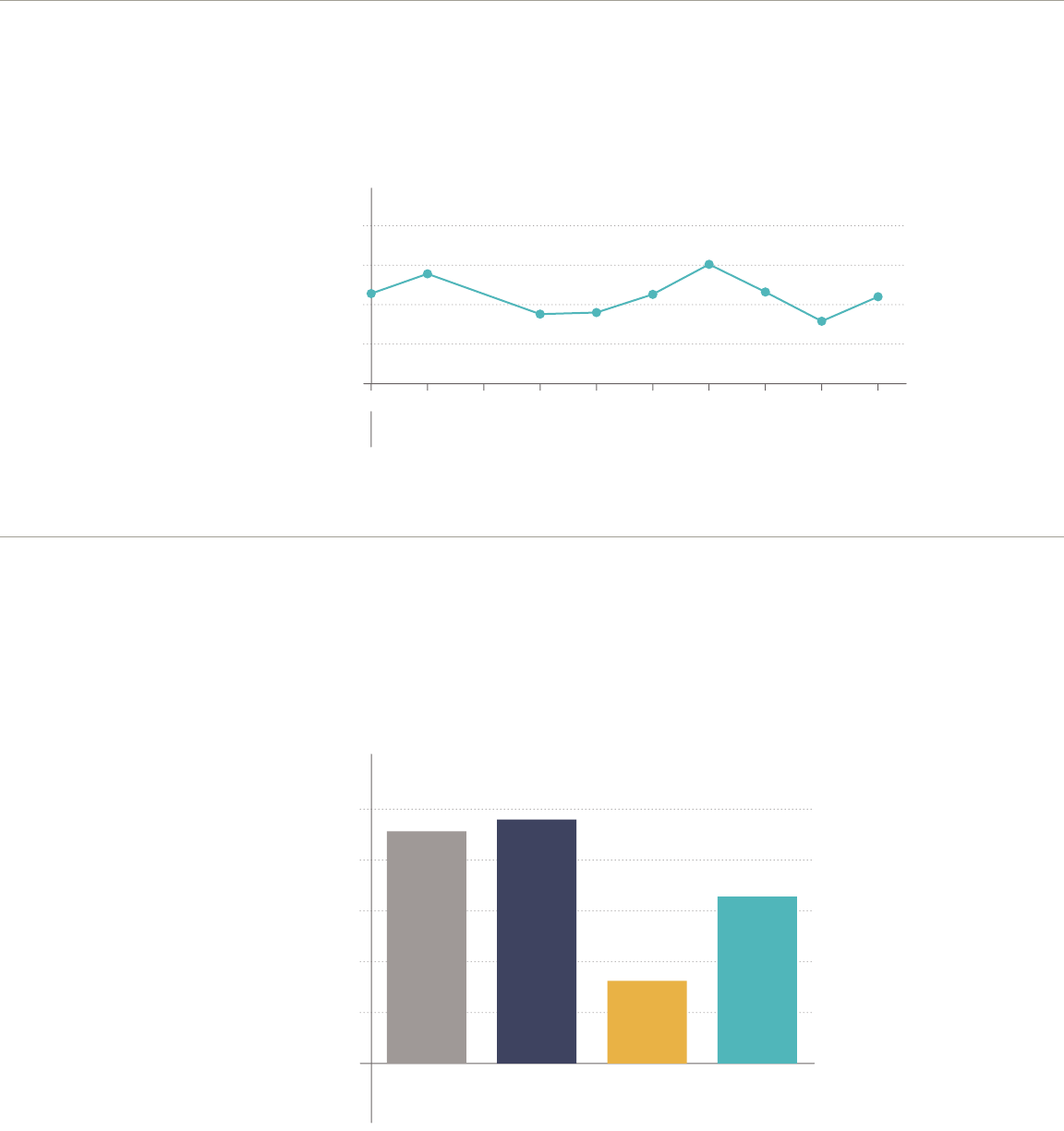
28 GROWING UP PHILLY: The Health and Well-being of Philadelphia’s Children
0%
5%
10%
15%
20%
25%
30%
35%
40%
Attempted Suicide
Suicidal Thoughts
Heterosexual Teens LGBTQ+ TeensCitywide
Neonatal Abstinence Syndrome
| rate per 1,000 live births
Asthma-related
Emergency Department visits
| by age group
Asthma-related
Emergency Department visits
| by age group and sex
Asthma hospitalizations
| per 10,000 children by race/ethnicity
Asthma hospitalizations
among children
| by insurance status
Injury-related Emergency
Department visits
| by age group
Injury-related Emergency
Room visits
| by age group and sex
Youth entering an out-of-home placement
| by age* group
Asthma hospitalizations
| per 10,000 children (under age 18)
ASIAN
HISPANIC
BLACK
WHITE
CITYWIDE
7,951
4,992
2,447
13.8
13.713.7
10.9
17.4%
15,540
34.9%
13.8%
0
2,000
4,000
6,000
8,000
10,000
12,000
14,000
16,000
18,000
CITYWIDE
13-19 YRS
6-12 YRS
<6 YRS
13-19 YRS
6-12 YRS
<6 YRS
13-19 YRS
6-12 YRS
<6 YRS
20182017201620152014
0
2,000
4,000
6,000
8,000
10,000
12,000
14,000
16,000
18,000
13-19 yrs
6-12 yrs
< 6 yrs
TotalFemale Male
2,477
1,410
1,067
2,947
4,922
2,045
3,028
4,992
7,951
0
20
40
60
80
100
2018201720162015201420132012201120102009
0
10
20
30
40
50
60
70
80
ASIAN*HISPANICBLACK*WHITE*
12.9
0
300
600
900
1,200
1,500
UninsuredOtherMedicaid Private
Insurance
284
70.5
1,497
45
63.2
18.3
69
43,058
15,684
14,057
13,194
5,000
CITYWIDE
13-19 YRS
6-12 YRS
<6 YRS
10,000
15,000
20,000
25,000
30,000
35,000
40,000
45,000
50,000
Citywide
13-19 yrs
6-12 yrs
<6 yrs
20182017201620152014
0
10,000
20,000
30,000
40,000
50,000
13-19 yrs
6-12 yrs
< 6 yrs
TotalFemale Male
7,599
15,684
13,194
14,057
7,877
7,320
8,084
5,874
6,180
0
300
600
900
1,200
1,500
18+ years13-18 years6-12 years0-5 years
1,412
664
1,033
30
Obesity among children ages 5-18
| by race/ethnicity and sex
Teens who experienced cyberbullying
| by sex
0%
5%
10%
15%
20%
25%
30%
FEMALE
MALE
Asian*HispanicWhite*Black*Citywide
22.0%
20.4%
21.4%
27.5%
18.5%
21.8%
23.8%
20.3%
23.2%
10.3%
3%
6%
9%
12%
15%
FEMALE
MALE
CITYWIDE
CITYWIDE
FEMALE
MALE
20192017201520132011
10.3%
10.7%
11.8%
Depressive symptoms among teens
| by race/ethnicity
Depressive symptoms among teens
| by sexual orientation
Suicidal ideation and suicide attempts among teens
Suicidal ideation
| by sex and race/ethnicity
Suicidal ideation and attempts
| by sexual orientation
20%
30%
40%
50%
Hispanic/Latino
White
Black
201920172015201320112009200720032001
39.8%
41.6%
45.7%
22.0%
20.8%
11.6%
25.7%
20.2%
14.6%
22.0%
9.8%
17.5%
13.1%
38.3%
15.2%
12.6%
36.3%
59.0%
31.5%
29.8%
50.5%
40.3%
Depressive symptoms among teens
| by sex
20%
30%
40%
50%
60%
Citywide
Female %
Male %
201920172015201320112009200720032001
HISPANIC
BLACK*
WHITE*
0% 10% 20% 30% 40% 50% 60% 70%
Heterosexual Teens
LGBTQ+ Teens
Citywide
5%
10%
15%
20%
25%
Attempt
Thoughts
2019201720152013201120092007200520032001
0%
5%
10%
15%
20%
25%
FEMALE
MALE
Hispanic White* Black*
8.3%
Suicide-related Emergency Department
visits
| by age group and sex
0
100
200
300
400
500
600
<10 YRS
10-14 YRS
15-19 YRS
TotalMaleFemale
202
275
243
63
73
70
41
173
22
Opioid-related Emergency Department
visits
| by age group and sex
Tobacco use in the past 30 days among teens
Teens currently using vaping products
| by race/ethnicity
Current teen marijuana use
| by year
Opioid-related Emergency Department visits
among youth
0
200
400
600
800
1,000
<10
10-14
15-19
TotalMaleFemale
506
789
60
125
283
23
70
37
55
15.8%
2.1%
3.5%
7.2%
2.8%
4.7%
10.5%
8.6%
6.0%
6.6%
6.8%
5.2%
7.3%
21.0%
17.9%
21.6%
25.1%
21.3%
19.0%
18.8%
23.9%
160
232
201
224
161
21.4%
Prescription pain medication
misuse amoung teens
| by race/ethnicity
0%
3%
6%
9%
12%
15%
HispanicWhiteBlackCitywide
13.7%
14.7%
4.9%
9.9%
CITYWIDE
HISPANIC
BLACK*
WHITE*
<10 YRS
10-14 YRS
15-19 YRS
0%
5%
10%
15%
20%
Cigar Use
Cigarette Use
2019201720152013201120092 007200520032001
0%
3%
6%
9%
12%
15%
HispanicWhite*Black*Citywide
7.1%
5.1%
14.3%
10.4%
10%
15%
20%
25%
30%
2019201720152013201120092007200520032001
58.8
59.5
71
85.6
97.1
98.8
94.6
71.2
55.1
0
2
4
6
8
10
12
14
16
20182017201620152014201320122011201020092008
9.1
9.3
8.4
6.2
6.5
6.2
4.5
SUICIDE
ATTEMPTS
SUICIDAL
IDEATION
SUICIDE
ATTEMPTS
SUICIDAL
IDEATION
0
100
200
300
400
20182017201620152014
13.9%
10.7% 10.8%
9.6%
7.5%
0%
5%
10%
15%
20%
25%
30%
35%
40%
Attempted Suicide
Suicidal Thoughts
Heterosexual Teens LGBTQ+ TeensCitywide
Neonatal Abstinence Syndrome
| rate per 1,000 live births
Asthma-related
Emergency Department visits
| by age group
Asthma-related
Emergency Department visits
| by age group and sex
Asthma hospitalizations
| per 10,000 children by race/ethnicity
Asthma hospitalizations
among children
| by insurance status
Injury-related Emergency
Department visits
| by age group
Injury-related Emergency
Room visits
| by age group and sex
Youth entering an out-of-home placement
| by age* group
Asthma hospitalizations
| per 10,000 children (under age 18)
ASIAN
HISPANIC
BLACK
WHITE
CITYWIDE
7,951
4,992
2,447
13.8
13.713.7
10.9
17.4%
15,540
34.9%
13.8%
0
2,000
4,000
6,000
8,000
10,000
12,000
14,000
16,000
18,000
CITYWIDE
13-19 YRS
6-12 YRS
<6 YRS
13-19 YRS
6-12 YRS
<6 YRS
13-19 YRS
6-12 YRS
<6 YRS
20182017201620152014
0
2,000
4,000
6,000
8,000
10,000
12,000
14,000
16,000
18,000
13-19 yrs
6-12 yrs
< 6 yrs
TotalFemale Male
2,477
1,410
1,067
2,947
4,922
2,045
3,028
4,992
7,951
0
20
40
60
80
100
2018201720162015201420132012201120102009
0
10
20
30
40
50
60
70
80
ASIAN*HISPANICBLACK*WHITE*
12.9
0
300
600
900
1,200
1,500
UninsuredOtherMedicaid Private
Insurance
284
70.5
1,497
45
63.2
18.3
69
43,058
15,684
14,057
13,194
5,000
CITYWIDE
13-19 YRS
6-12 YRS
<6 YRS
10,000
15,000
20,000
25,000
30,000
35,000
40,000
45,000
50,000
Citywide
13-19 yrs
6-12 yrs
<6 yrs
20182017201620152014
0
10,000
20,000
30,000
40,000
50,000
13-19 yrs
6-12 yrs
< 6 yrs
TotalFemale Male
7,599
15,684
13,194
14,057
7,877
7,320
8,084
5,874
6,180
0
300
600
900
1,200
1,500
18+ years13-18 years6-12 years0-5 years
1,412
664
1,033
30
Obesity among children ages 5-18
| by race/ethnicity and sex
Teens who experienced cyberbullying
| by sex
0%
5%
10%
15%
20%
25%
30%
FEMALE
MALE
Asian*HispanicWhite*Black*Citywide
22.0%
20.4%
21.4%
27.5%
18.5%
21.8%
23.8%
20.3%
23.2%
10.3%
3%
6%
9%
12%
15%
FEMALE
MALE
CITYWIDE
CITYWIDE
FEMALE
MALE
20192017201520132011
10.3%
10.7%
11.8%
Depressive symptoms among teens
| by race/ethnicity
Depressive symptoms among teens
| by sexual orientation
Suicidal ideation and suicide attempts among teens
Suicidal ideation
| by sex and race/ethnicity
Suicidal ideation and attempts
| by sexual orientation
20%
30%
40%
50%
Hispanic/Latino
White
Black
201920172015201320112009200720032001
39.8%
41.6%
45.7%
22.0%
20.8%
11.6%
25.7%
20.2%
14.6%
22.0%
9.8%
17.5%
13.1%
38.3%
15.2%
12.6%
36.3%
59.0%
31.5%
29.8%
50.5%
40.3%
Depressive symptoms among teens
| by sex
20%
30%
40%
50%
60%
Citywide
Female %
Male %
201920172015201320112009200720032001
HISPANIC
BLACK*
WHITE*
0% 10% 20% 30% 40% 50% 60% 70%
Heterosexual Teens
LGBTQ+ Teens
Citywide
5%
10%
15%
20%
25%
Attempt
Thoughts
2019201720152013201120092007200520032001
0%
5%
10%
15%
20%
25%
FEMALE
MALE
Hispanic White* Black*
8.3%
Suicide-related Emergency Department
visits
| by age group and sex
0
100
200
300
400
500
600
<10 YRS
10-14 YRS
15-19 YRS
TotalMaleFemale
202
275
243
63
73
70
41
173
22
Opioid-related Emergency Department
visits
| by age group and sex
Tobacco use in the past 30 days among teens
Teens currently using vaping products
| by race/ethnicity
Current teen marijuana use
| by year
Opioid-related Emergency Department visits
among youth
0
200
400
600
800
1,000
<10
10-14
15-19
TotalMaleFemale
506
789
60
125
283
23
70
37
55
15.8%
2.1%
3.5%
7.2%
2.8%
4.7%
10.5%
8.6%
6.0%
6.6%
6.8%
5.2%
7.3%
21.0%
17.9%
21.6%
25.1%
21.3%
19.0%
18.8%
23.9%
160
232
201
224
161
21.4%
Prescription pain medication
misuse amoung teens
| by race/ethnicity
0%
3%
6%
9%
12%
15%
HispanicWhiteBlackCitywide
13.7%
14.7%
4.9%
9.9%
CITYWIDE
HISPANIC
BLACK*
WHITE*
<10 YRS
10-14 YRS
15-19 YRS
0%
5%
10%
15%
20%
Cigar Use
Cigarette Use
2019201720152013201120092 007200520032001
0%
3%
6%
9%
12%
15%
HispanicWhite*Black*Citywide
7.1%
5.1%
14.3%
10.4%
10%
15%
20%
25%
30%
2019201720152013201120092007200520032001
58.8
59.5
71
85.6
97.1
98.8
94.6
71.2
55.1
0
2
4
6
8
10
12
14
16
20182017201620152014201320122011201020092008
9.1
9.3
8.4
6.2
6.5
6.2
4.5
SUICIDE
ATTEMPTS
SUICIDAL
IDEATION
SUICIDE
ATTEMPTS
SUICIDAL
IDEATION
0
100
200
300
400
20182017201620152014
13.9%
10.7% 10.8%
9.6%
7.5%
SOURCE: 2001-2019 Philadelphia Youth Risk Behavior Surveillance System
SOURCE: 2019 Philadelphia Youth Risk Behavior Surveillance System *Non-Hispanic
MARIJUANA USE
Marijuana can adversely impact the developing brain, especially areas related to attention,
memory, and learning skills. Marijuana use can also affect coordination and motor skills,
which can be unsafe for driving and impair athletic performance.
25
Self-reported marijuana use
among teens ranged between 19
percent and 25 percent in recent
years. In 2019, 21 percent of teens
reported current marijuana use.
PRESCRIPTION PAIN MEDICINE MISUSE
Prescription pain medicine misuse occurs when an individual takes prescription pain
medication without a doctor’s prescription or differently from a doctor’s instructions.
Prescription misuse, especially among young people, has been a major contributor to the
opioid crisis in Philadelphia.
In 2019, 13.7 percent of teens
aged 13 to 17 reported misusing
prescription pain medicine.
Prescription pain medication
misuse was highest among
non-Hispanic black teens, at
14.7 percent.
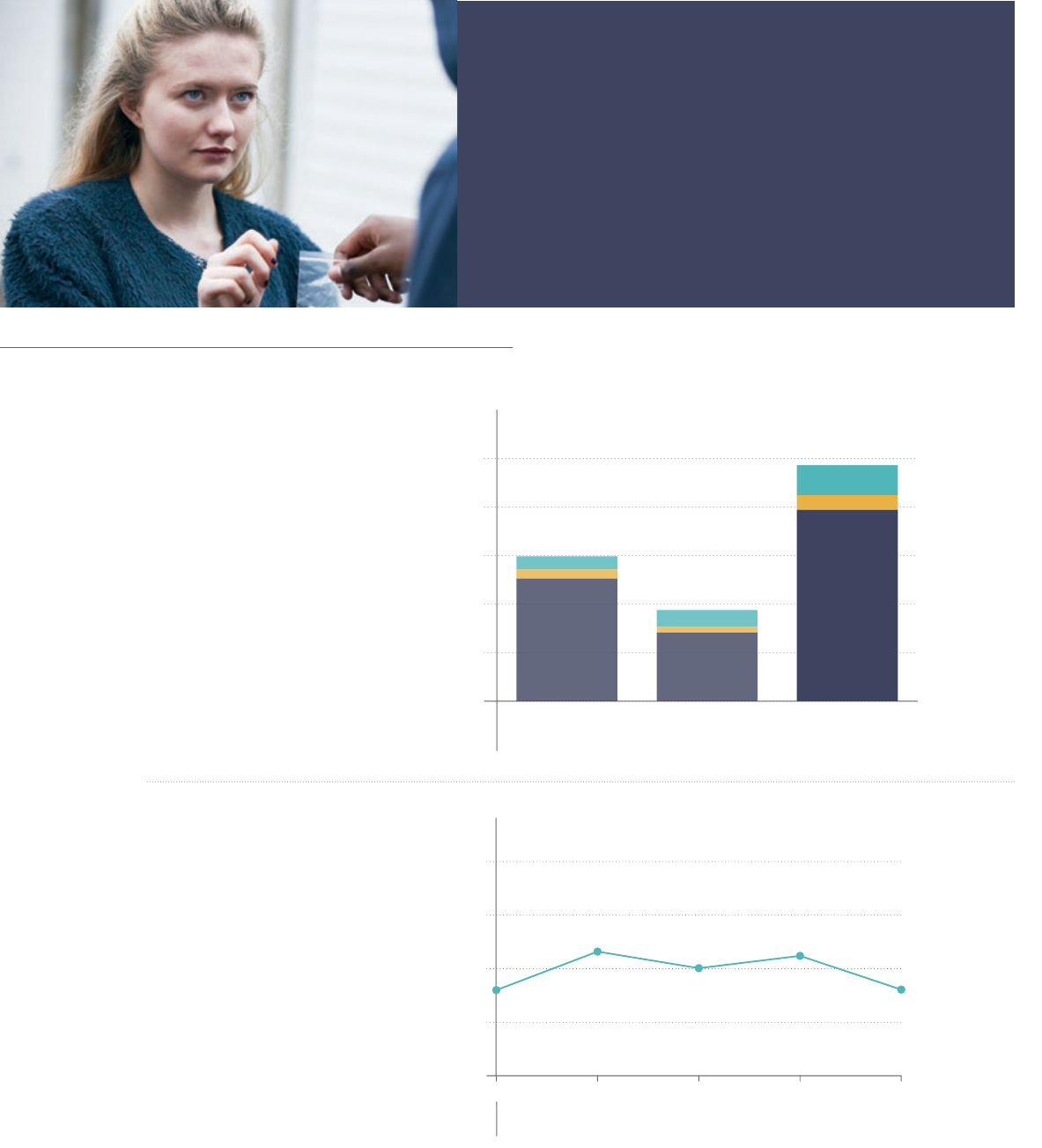
GROWING UP PHILLY: The Health and Well-being of Philadelphia’s Children 29
OPIOID-RELATED ED VISITS
The current opioid crisis
in Philadelphia continues
to affect youth through
nonfatal overdoses,
resulting in emergency
department visits.
From 2014 to 2018, there were
974 opioid-related emergency
department visits among
people under the age of 20 in
Philadelphia. The majority of these
emergency department visits were
among teens aged 15 to 19 and
among female youth.
The number of opioid-related
emergency department visits
among youth increased from
2014 to 2017 and declined from
2017 to 2018. In 2018, there were
161 opioid-related emergency
department visits involving youth.
0%
5%
10%
15%
20%
25%
30%
35%
40%
Attempted Suicide
Suicidal Thoughts
Heterosexual Teens LGBTQ+ TeensCitywide
Neonatal Abstinence Syndrome
| rate per 1,000 live births
Asthma-related
Emergency Department visits
| by age group
Asthma-related
Emergency Department visits
| by age group and sex
Asthma hospitalizations
| per 10,000 children by race/ethnicity
Asthma hospitalizations
among children
| by insurance status
Injury-related Emergency
Department visits
| by age group
Injury-related Emergency
Room visits
| by age group and sex
Youth entering an out-of-home placement
| by age* group
Asthma hospitalizations
| per 10,000 children (under age 18)
ASIAN
HISPANIC
BLACK
WHITE
CITYWIDE
7,951
4,992
2,447
13.8
13.713.7
10.9
17.4%
15,540
34.9%
13.8%
0
2,000
4,000
6,000
8,000
10,000
12,000
14,000
16,000
18,000
CITYWIDE
13-19 YRS
6-12 YRS
<6 YRS
13-19 YRS
6-12 YRS
<6 YRS
13-19 YRS
6-12 YRS
<6 YRS
20182017201620152014
0
2,000
4,000
6,000
8,000
10,000
12,000
14,000
16,000
18,000
13-19 yrs
6-12 yrs
< 6 yrs
TotalFemale Male
2,477
1,410
1,067
2,947
4,922
2,045
3,028
4,992
7,951
0
20
40
60
80
100
2018201720162015201420132012201120102009
0
10
20
30
40
50
60
70
80
ASIAN*HISPANICBLACK*WHITE*
12.9
0
300
600
900
1,200
1,500
UninsuredOtherMedicaid Private
Insurance
284
70.5
1,497
45
63.2
18.3
69
43,058
15,684
14,057
13,194
5,000
CITYWIDE
13-19 YRS
6-12 YRS
<6 YRS
10,000
15,000
20,000
25,000
30,000
35,000
40,000
45,000
50,000
Citywide
13-19 yrs
6-12 yrs
<6 yrs
20182017201620152014
0
10,000
20,000
30,000
40,000
50,000
13-19 yrs
6-12 yrs
< 6 yrs
TotalFemale Male
7,599
15,684
13,194
14,057
7,877
7,320
8,084
5,874
6,180
0
300
600
900
1,200
1,500
18+ years13-18 years6-12 years0-5 years
1,412
664
1,033
30
Obesity among children ages 5-18
| by race/ethnicity and sex
Teens who experienced cyberbullying
| by sex
0%
5%
10%
15%
20%
25%
30%
FEMALE
MALE
Asian*HispanicWhite*Black*Citywide
22.0%
20.4%
21.4%
27.5%
18.5%
21.8%
23.8%
20.3%
23.2%
10.3%
3%
6%
9%
12%
15%
FEMALE
MALE
CITYWIDE
CITYWIDE
FEMALE
MALE
20192017201520132011
10.3%
10.7%
11.8%
Depressive symptoms among teens
| by race/ethnicity
Depressive symptoms among teens
| by sexual orientation
Suicidal ideation and suicide attempts among teens
Suicidal ideation
| by sex and race/ethnicity
Suicidal ideation and attempts
| by sexual orientation
20%
30%
40%
50%
Hispanic/Latino
White
Black
201920172015201320112009200720032001
39.8%
41.6%
45.7%
22.0%
20.8%
11.6%
25.7%
20.2%
14.6%
22.0%
9.8%
17.5%
13.1%
38.3%
15.2%
12.6%
36.3%
59.0%
31.5%
29.8%
50.5%
40.3%
Depressive symptoms among teens
| by sex
20%
30%
40%
50%
60%
Citywide
Female %
Male %
201920172015201320112009200720032001
HISPANIC
BLACK*
WHITE*
0% 10% 20% 30% 40% 50% 60% 70%
Heterosexual Teens
LGBTQ+ Teens
Citywide
5%
10%
15%
20%
25%
Attempt
Thoughts
2019201720152013201120092007200520032001
0%
5%
10%
15%
20%
25%
FEMALE
MALE
Hispanic White* Black*
8.3%
Suicide-related Emergency Department
visits
| by age group and sex
0
100
200
300
400
500
600
<10 YRS
10-14 YRS
15-19 YRS
TotalMaleFemale
202
275
243
63
73
70
41
173
22
Opioid-related Emergency Department
visits
| by age group and sex
Tobacco use in the past 30 days among teens
Teens currently using vaping products
| by race/ethnicity
Current teen marijuana use
| by year
Opioid-related Emergency Department visits
among youth
0
200
400
600
800
1,000
<10
10-14
15-19
TotalMaleFemale
506
789
60
125
283
23
70
37
55
15.8%
2.1%
3.5%
7.2%
2.8%
4.7%
10.5%
8.6%
6.0%
6.6%
6.8%
5.2%
7.3%
21.0%
17.9%
21.6%
25.1%
21.3%
19.0%
18.8%
23.9%
160
232
201
224
161
21.4%
Prescription pain medication
misuse amoung teens
| by race/ethnicity
0%
3%
6%
9%
12%
15%
HispanicWhiteBlackCitywide
13.7%
14.7%
4.9%
9.9%
CITYWIDE
HISPANIC
BLACK*
WHITE*
<10 YRS
10-14 YRS
15-19 YRS
0%
5%
10%
15%
20%
Cigar Use
Cigarette Use
2019201720152013201120092 007200520032001
0%
3%
6%
9%
12%
15%
HispanicWhite*Black*Citywide
7.1%
5.1%
14.3%
10.4%
10%
15%
20%
25%
30%
2019201720152013201120092007200520032001
58.8
59.5
71
85.6
97.1
98.8
94.6
71.2
55.1
0
2
4
6
8
10
12
14
16
20182017201620152014201320122011201020092008
9.1
9.3
8.4
6.2
6.5
6.2
4.5
SUICIDE
ATTEMPTS
SUICIDAL
IDEATION
SUICIDE
ATTEMPTS
SUICIDAL
IDEATION
0
100
200
300
400
20182017201620152014
13.9%
10.7% 10.8%
9.6%
7.5%
0%
5%
10%
15%
20%
25%
30%
35%
40%
Attempted Suicide
Suicidal Thoughts
Heterosexual Teens LGBTQ+ TeensCitywide
Neonatal Abstinence Syndrome
| rate per 1,000 live births
Asthma-related
Emergency Department visits
| by age group
Asthma-related
Emergency Department visits
| by age group and sex
Asthma hospitalizations
| per 10,000 children by race/ethnicity
Asthma hospitalizations
among children
| by insurance status
Injury-related Emergency
Department visits
| by age group
Injury-related Emergency
Room visits
| by age group and sex
Youth entering an out-of-home placement
| by age* group
Asthma hospitalizations
| per 10,000 children (under age 18)
ASIAN
HISPANIC
BLACK
WHITE
CITYWIDE
7,951
4,992
2,447
13.8
13.713.7
10.9
17.4%
15,540
34.9%
13.8%
0
2,000
4,000
6,000
8,000
10,000
12,000
14,000
16,000
18,000
CITYWIDE
13-19 YRS
6-12 YRS
<6 YRS
13-19 YRS
6-12 YRS
<6 YRS
13-19 YRS
6-12 YRS
<6 YRS
20182017201620152014
0
2,000
4,000
6,000
8,000
10,000
12,000
14,000
16,000
18,000
13-19 yrs
6-12 yrs
< 6 yrs
TotalFemale Male
2,477
1,410
1,067
2,947
4,922
2,045
3,028
4,992
7,951
0
20
40
60
80
100
2018201720162015201420132012201120102009
0
10
20
30
40
50
60
70
80
ASIAN*HISPANICBLACK*WHITE*
12.9
0
300
600
900
1,200
1,500
UninsuredOtherMedicaid Private
Insurance
284
70.5
1,497
45
63.2
18.3
69
43,058
15,684
14,057
13,194
5,000
CITYWIDE
13-19 YRS
6-12 YRS
<6 YRS
10,000
15,000
20,000
25,000
30,000
35,000
40,000
45,000
50,000
Citywide
13-19 yrs
6-12 yrs
<6 yrs
20182017201620152014
0
10,000
20,000
30,000
40,000
50,000
13-19 yrs
6-12 yrs
< 6 yrs
TotalFemale Male
7,599
15,684
13,194
14,057
7,877
7,320
8,084
5,874
6,180
0
300
600
900
1,200
1,500
18+ years13-18 years6-12 years0-5 years
1,412
664
1,033
30
Obesity among children ages 5-18
| by race/ethnicity and sex
Teens who experienced cyberbullying
| by sex
0%
5%
10%
15%
20%
25%
30%
FEMALE
MALE
Asian*HispanicWhite*Black*Citywide
22.0%
20.4%
21.4%
27.5%
18.5%
21.8%
23.8%
20.3%
23.2%
10.3%
3%
6%
9%
12%
15%
FEMALE
MALE
CITYWIDE
CITYWIDE
FEMALE
MALE
20192017201520132011
10.3%
10.7%
11.8%
Depressive symptoms among teens
| by race/ethnicity
Depressive symptoms among teens
| by sexual orientation
Suicidal ideation and suicide attempts among teens
Suicidal ideation
| by sex and race/ethnicity
Suicidal ideation and attempts
| by sexual orientation
20%
30%
40%
50%
Hispanic/Latino
White
Black
201920172015201320112009200720032001
39.8%
41.6%
45.7%
22.0%
20.8%
11.6%
25.7%
20.2%
14.6%
22.0%
9.8%
17.5%
13.1%
38.3%
15.2%
12.6%
36.3%
59.0%
31.5%
29.8%
50.5%
40.3%
Depressive symptoms among teens
| by sex
20%
30%
40%
50%
60%
Citywide
Female %
Male %
201920172015201320112009200720032001
HISPANIC
BLACK*
WHITE*
0% 10% 20% 30% 40% 50% 60% 70%
Heterosexual Teens
LGBTQ+ Teens
Citywide
5%
10%
15%
20%
25%
Attempt
Thoughts
2019201720152013201120092007200520032001
0%
5%
10%
15%
20%
25%
FEMALE
MALE
Hispanic White* Black*
8.3%
Suicide-related Emergency Department
visits
| by age group and sex
0
100
200
300
400
500
600
<10 YRS
10-14 YRS
15-19 YRS
TotalMaleFemale
202
275
243
63
73
70
41
173
22
Opioid-related Emergency Department
visits
| by age group and sex
Tobacco use in the past 30 days among teens
Teens currently using vaping products
| by race/ethnicity
Current teen marijuana use
| by year
Opioid-related Emergency Department visits
among youth
0
200
400
600
800
1,000
<10
10-14
15-19
TotalMaleFemale
506
789
60
125
283
23
70
37
55
15.8%
2.1%
3.5%
7.2%
2.8%
4.7%
10.5%
8.6%
6.0%
6.6%
6.8%
5.2%
7.3%
21.0%
17.9%
21.6%
25.1%
21.3%
19.0%
18.8%
23.9%
160
232
201
224
161
21.4%
Prescription pain medication
misuse amoung teens
| by race/ethnicity
0%
3%
6%
9%
12%
15%
HispanicWhiteBlackCitywide
13.7%
14.7%
4.9%
9.9%
CITYWIDE
HISPANIC
BLACK*
WHITE*
<10 YRS
10-14 YRS
15-19 YRS
0%
5%
10%
15%
20%
Cigar Use
Cigarette Use
2019201720152013201120092 007200520032001
0%
3%
6%
9%
12%
15%
HispanicWhite*Black*Citywide
7.1%
5.1%
14.3%
10.4%
10%
15%
20%
25%
30%
2019201720152013201120092007200520032001
58.8
59.5
71
85.6
97.1
98.8
94.6
71.2
55.1
0
2
4
6
8
10
12
14
16
20182017201620152014201320122011201020092008
9.1
9.3
8.4
6.2
6.5
6.2
4.5
SUICIDE
ATTEMPTS
SUICIDAL
IDEATION
SUICIDE
ATTEMPTS
SUICIDAL
IDEATION
0
100
200
300
400
20182017201620152014
13.9%
10.7% 10.8%
9.6%
7.5%
SOURCE: 2014-2018 Syndromic Surveillance, PDPH
SOURCE: 2014-2018 Syndromic Surveillance, PDPH
“ The youth have been hit hard
with the opioid crisis... they suffer
sports injuries and are given
prescription drugs.”
— Resident from Philadelphia
Community Needs Assessment
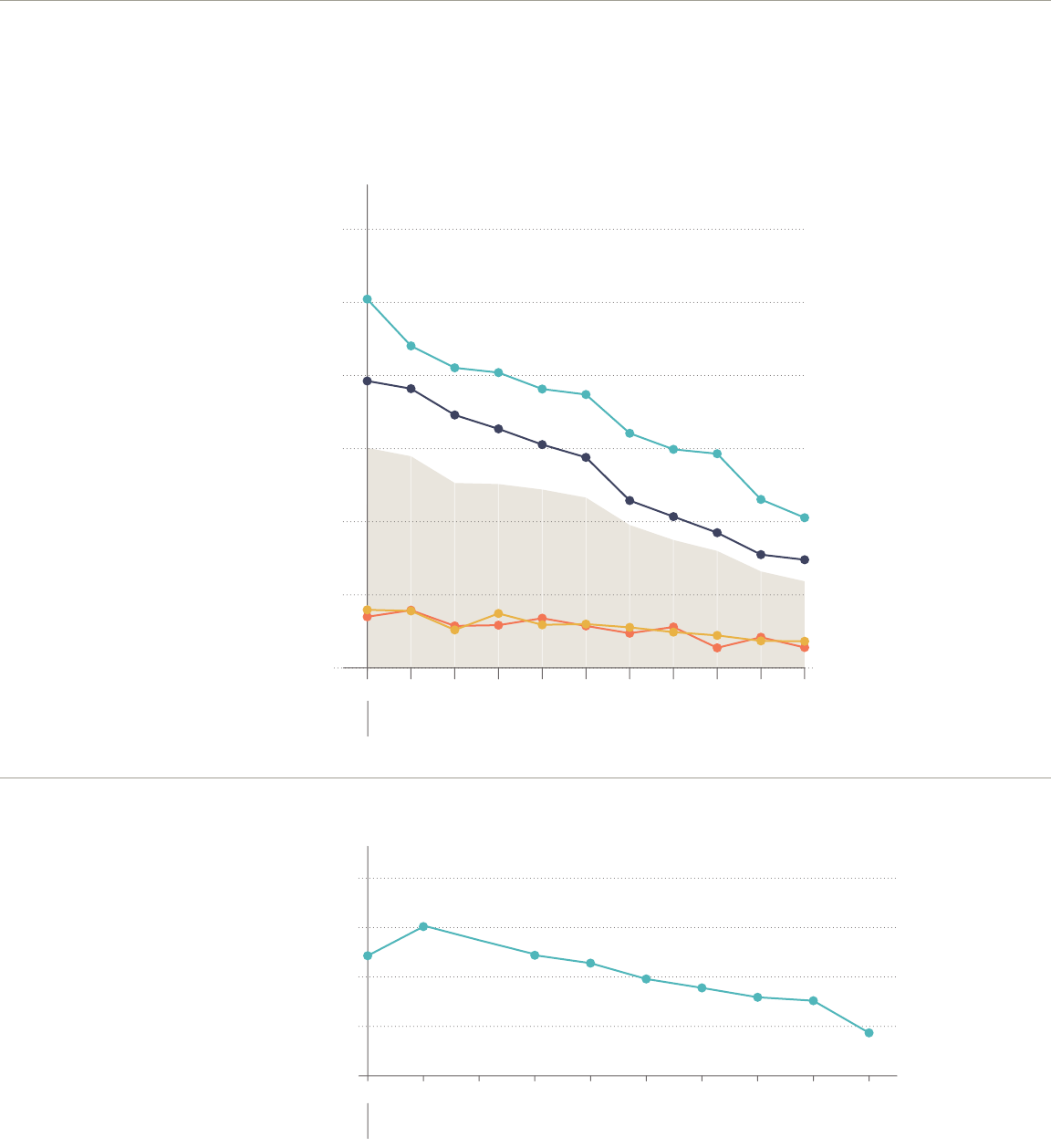
30 GROWING UP PHILLY: The Health and Well-being of Philadelphia’s Children
Physical inactivity among teens
| by race/ethnicity
Physical inactivity among teens
| by sex
Soda consumption among teens
once or more per day
10%
15%
20%
25%
30%
HISPANIC
WHITE*
BLACK*
2019201720152013201120092007
10%
15%
20%
25%
30%
35%
FEMALE
MALE
CITYWIDE
2019201720152013201120092007
29.4%
22.6%
17.0%
27.3%
17.4%
13.4%
13.5%
11.7%
9.2%
33.9%
18.7%
17.1%
17.2%
24.4%
5%
10%
15%
20%
25%
30%
35%
HISPANIC
WHITE*
BLACK*
CITYWIDE
2019201720152013201120092007
Current alcohol consumption in the last
30 days
| by race/ethnicity
Current alcohol
consumption in the last
30 days
| by sexual orientation
10%
20%
30%
40%
50%
60%
70%
80%
HISPANIC
WHITE*
BLACK*
CITYWIDE
201920172015201320112009200720032001
0% 5% 10% 15% 20% 25% 30% 35%
Currently Drink Binge Drink
LGBTQ+
Teens
Heterosexual
Teens
13.8%
4.3%
15.9%
34.9%
Teen condom use during last sexual encounter
Teen births among women aged 15-19
| per 1,000
women by race/ethnicity
48.7%
55.2%
41.1
29.6
24.3
7.3
5.6
40%
50%
60%
70%
80%
2019201720152013201120092007200520032001
Secondhand smoke exposure at home
Children screened for lead exposure
before the age of 24 months
People living in poverty
| by age group and location
Childhood poverty
| by race/ethnicity
0%
10%
20%
201820172016201520142013201220112010
0
20
40
60
80
100
120
asian
hispanic
black
white
citywide
20172016201520142013201220112010200920082007
ASIAN*
WHITE*
HISPANIC
BLACK*
CITYWIDE
15.0%
13.7%
15.4%
75.1%
20%
30%
40%
50%
60%
70%
80%
201620152014201320122011201020092008200720062005
PHILADELPHIA
PENNSYLVANIA
UNITED STATES
0%
5%
10%
15%
20%
25%
30%
35%
40%
Children <5Children age 5-17Children <18Total Population: All Ages
18.0%
17.0%
19.5%
13.1%
17.6%
16.0%
16.8%
12.2%
24.5%
34.6%
35.9%
30.8%
55.9%
57.8%
59.6%
62.8%
64.4%
70.2%
64.3%
0%
10%
20%
30%
40%
50%
Asian*HispanicBlack*White*
Citywide: 35%
16%
38%
49%
21%
17.5%
SOURCE: 2007-2017 Vital Statistics, PDPH *Non-Hispanic
TEEN BIRTHS
Infants born to teen mothers are more likely to have lower school achievement and to
drop out of high school, have more health problems, be incarcerated at some time during
adolescence, give birth as teenagers, and face unemployment as young adults.
26
During 2007-2017, the teen birth
rate fell by more than half from
60.2 to 25.7 births per 1,000
females. The birth rate for females
aged 15 to 19 in Philadelphia in
2017 was higher than the national
rate (18.8 births per 1,000
women). Although teen birth
rates have declined, racial/ethnic
disparities persist, with rates
consistently the highest among
Hispanic teens.
Physical inactivity among teens
| by race/ethnicity
Physical inactivity among teens
| by sex
Soda consumption among teens
once or more per day
10%
15%
20%
25%
30%
HISPANIC
WHITE*
BLACK*
2019201720152013201120092007
10%
15%
20%
25%
30%
35%
FEMALE
MALE
CITYWIDE
2019201720152013201120092007
29.4%
22.6%
17.0%
27.3%
17.4%
13.4%
13.5%
11.7%
9.2%
33.9%
18.7%
17.1%
17.2%
24.4%
5%
10%
15%
20%
25%
30%
35%
HISPANIC
WHITE*
BLACK*
CITYWIDE
2019201720152013201120092007
Current alcohol consumption in the last
30 days
| by race/ethnicity
Current alcohol
consumption in the last
30 days
| by sexual orientation
10%
20%
30%
40%
50%
60%
70%
80%
HISPANIC
WHITE*
BLACK*
CITYWIDE
201920172015201320112009200720032001
0% 5% 10% 15% 20% 25% 30% 35%
Currently Drink Binge Drink
LGBTQ+
Teens
Heterosexual
Teens
13.8%
4.3%
15.9%
34.9%
Teen condom use during last sexual encounter
Teen births among women aged 15-19
| per 1,000
women by race/ethnicity
48.7%
55.2%
41.1
29.6
24.3
7.3
5.6
40%
50%
60%
70%
80%
2019201720152013201120092007200520032001
Secondhand smoke exposure at home
Children screened for lead exposure
before the age of 24 months
People living in poverty
| by age group and location
Childhood poverty
| by race/ethnicity
0%
10%
20%
201820172016201520142013201220112010
0
20
40
60
80
100
120
asian
hispanic
black
white
citywide
20172016201520142013201220112010200920082007
ASIAN*
WHITE*
HISPANIC
BLACK*
CITYWIDE
15.0%
13.7%
15.4%
75.1%
20%
30%
40%
50%
60%
70%
80%
201620152014201320122011201020092008200720062005
PHILADELPHIA
PENNSYLVANIA
UNITED STATES
0%
5%
10%
15%
20%
25%
30%
35%
40%
Children <5Children age 5-17Children <18Total Population: All Ages
18.0%
17.0%
19.5%
13.1%
17.6%
16.0%
16.8%
12.2%
24.5%
34.6%
35.9%
30.8%
55.9%
57.8%
59.6%
62.8%
64.4%
70.2%
64.3%
0%
10%
20%
30%
40%
50%
Asian*HispanicBlack*White*
Citywide: 35%
16%
38%
49%
21%
17.5%
SOURCE: 2001-2019 Philadelphia Youth Risk Behavior Surveillance System
CONDOM USE
Using condoms can prevent
both unintended pregnancy
and the transmission
of sexually transmitted
diseases during sexual
intercourse.
From 2001 to 2019, condom use
among sexually active teens has
slowly declined. Only 49 percent
of teens reported using condoms
during their last sexual encounters
in 2019.
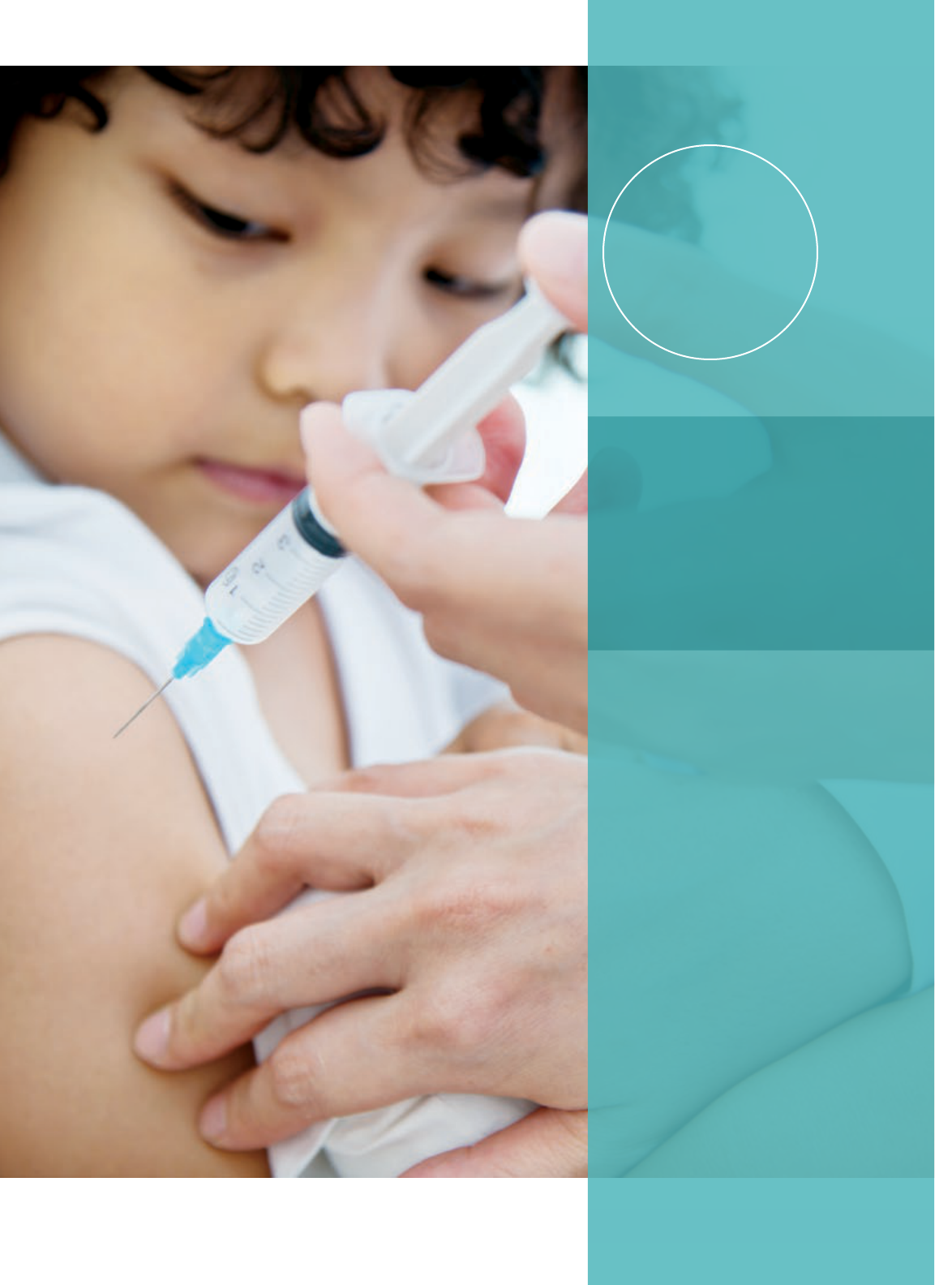
GROWING UP PHILLY: The Health and Well-being of Philadelphia’s Children 31
Clinical and
Preventive
Care
3
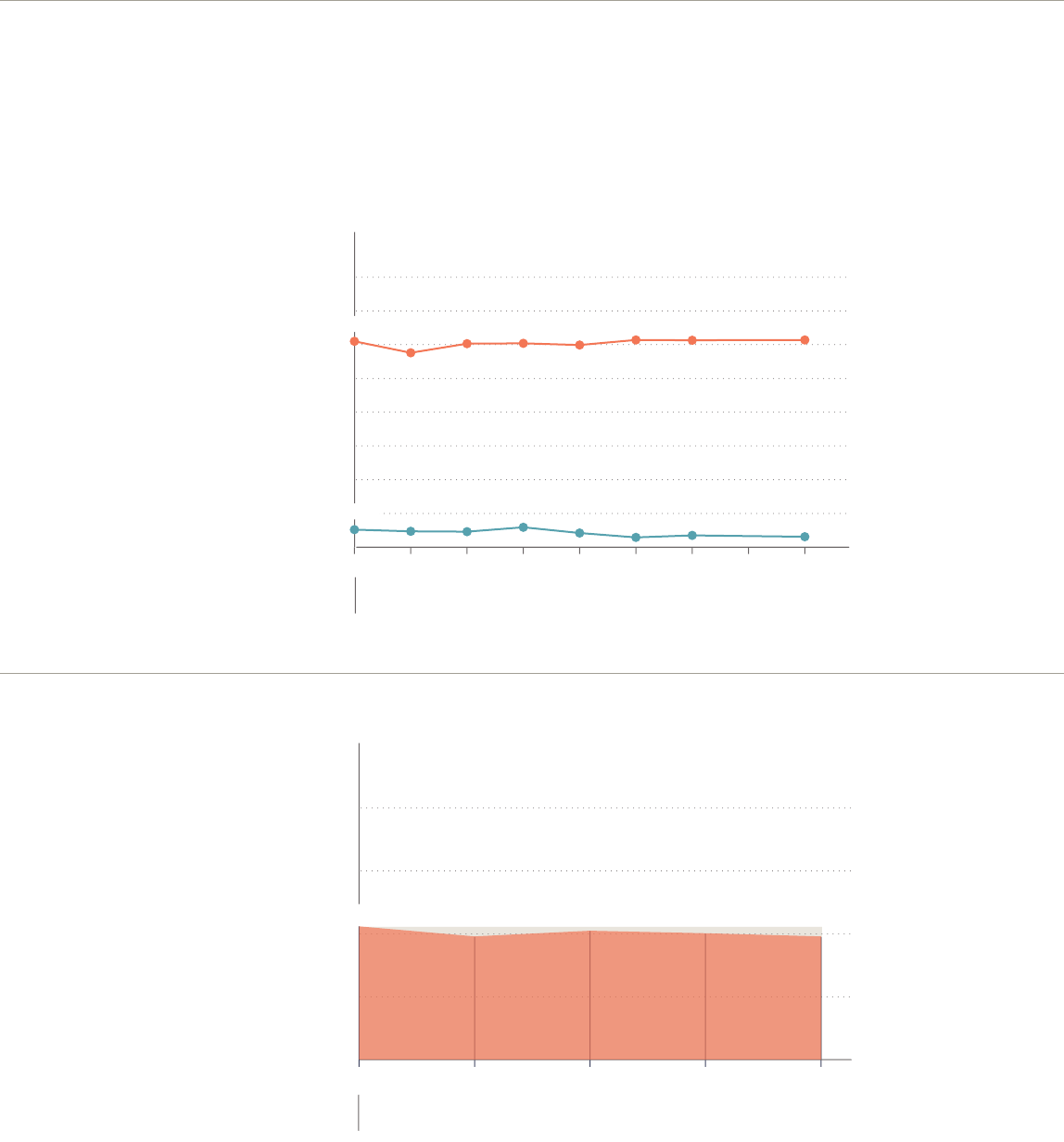
32 GROWING UP PHILLY: The Health and Well-being of Philadelphia’s Children
HEALTH INSURANCE COVERAGE
Those living without health insurance face greater difficulties in accessing medical care and
may delay treatment due to cost.
28
As a result, those without health insurance experience
poorer health outcomes compared to those with health insurance.
29
Health insurance coverage among children
NATIONAL AVERAGE: 70.4%
50%
60%
70%
80%
90%
20182017201620152014
Children 19-35 months with up-to-date combined
7-vaccine series
71.2%
69.6%
50.0%
31.0%
27.0%
52.2%
63.6%
73.4%
70.5%
70.1%
69.6%
61.4%61.3%61.4%
59.9%60.4%60.3%
57.6%
0
20%
40%
60%
80%
100%
13-17 years5-12 years6 months-2 years
Flu vaccination coverage,
Philadelphia and national averages
Children scoring below screening threshold
of well-being survey at 18 months
PHILADELPHIA NATIONAL
0
5%
10%
15%
20%
25%
30%
35%
40%
White*
Other
HispanicBlack*
Asian
All
children
24.7%
Children scoring below screening threshold
of well-being survey at 24 months
White*
Other
HispanicBlack*
Asian
21.3%
35.9%
23.6%
21.9%
31.8%
17.9%
All
children
23.8%
Number of infants and toddlers (0-<3)
receiving Early Intervention services
13-15 year olds who have received
HPV vaccine**
| by race/ethnicity
Number of preschool-aged children (3-5)
receiving Early Intervention services
Access to Nearby Parks
or Outdoor Space,
2012–2015
<70%
70.1-72%
72.1–74%
74.1–76%
>78.1%
74.7%
78.2%
77.3%
72.6%
81.9%
74.3%
60.7%
86%
71.7%
70%
74.2%
69.6%*
70.1%
66%
62.7%
70.6%
89.7%
0
2,000
4,000
6,000
8,000
10,000
FY18FY17FY16CY18CY17CY16
0
2,000
4,000
6,000
8,000
10,000
6,048
6,537
7,448
7,950
8,518
9,100
0%
10%
20%
30%
40%
50%
60%
70%
80%
Asian*Hispanic White* Black*Citywide
67.3%
71.9%
63.8%
73.6%
72.9%
0%
10%
20%
30%
40%
50%
60%
70%
80%
UNINSURED
MEDICAID
201820172016201520142013201220112010
61.0%
5.2%
4.7%
4.6%
5.9%
4.2%
2.9% 3.5% 3.1%
The percentage of children who
do not have health insurance
declined from 6 percent to 3
percent during 2013 to 2015 and
has since remained stable.
In 2018, 61.4 percent of children in
Philadelphia had health insurance
under Medicaid. Medicaid
coverage has remained stable
among children in Philadelphia.
SOURCE: 2010-2018 American Community Survey Estimates, US Census Bureau
IMMUNIZATIONS: Early Childhood
Immunizations are
considered one of the
greatest achievements in
public health.
Based on data from the PhilaVax
Immunization Registry, which
does not include all vaccinations
for children received outside of the
city, approximately 70 percent of
children ages 19-35-month have
received the recommended
seven-vaccine series.
Health insurance coverage among children
NATIONAL AVERAGE: 70.4%
50%
60%
70%
80%
90%
20182017201620152014
Children 19-35 months with up-to-date combined
7-vaccine series
71.2%
69.6%
50.0%
31.0%
27.0%
52.2%
63.6%
73.4%
70.5%
70.1%
69.6%
61.4%61.3%61.4%
59.9%60.4%60.3%
57.6%
0
20%
40%
60%
80%
100%
13-17 years5-12 years6 months-2 years
Flu vaccination coverage,
Philadelphia and national averages
Children scoring below screening threshold
of well-being survey at 18 months
PHILADELPHIA NATIONAL
0
5%
10%
15%
20%
25%
30%
35%
40%
White*
Other
HispanicBlack*
Asian
All
children
24.7%
Children scoring below screening threshold
of well-being survey at 24 months
White*
Other
HispanicBlack*
Asian
21.3%
35.9%
23.6%
21.9%
31.8%
17.9%
All
children
23.8%
Number of infants and toddlers (0-<3)
receiving Early Intervention services
13-15 year olds who have received
HPV vaccine**
| by race/ethnicity
Number of preschool-aged children (3-5)
receiving Early Intervention services
Access to Nearby Parks
or Outdoor Space,
2012–2015
<70%
70.1-72%
72.1–74%
74.1–76%
>78.1%
74.7%
78.2%
77.3%
72.6%
81.9%
74.3%
60.7%
86%
71.7%
70%
74.2%
69.6%*
70.1%
66%
62.7%
70.6%
89.7%
0
2,000
4,000
6,000
8,000
10,000
FY18FY17FY16CY18CY17CY16
0
2,000
4,000
6,000
8,000
10,000
6,048
6,537
7,448
7,950
8,518
9,100
0%
10%
20%
30%
40%
50%
60%
70%
80%
Asian*Hispanic White* Black*Citywide
67.3%
71.9%
63.8%
73.6%
72.9%
0%
10%
20%
30%
40%
50%
60%
70%
80%
UNINSURED
MEDICAID
201820172016201520142013201220112010
61.0%
5.2%
4.7%
4.6%
5.9%
4.2%
2.9% 3.5% 3.1%
SOURCE: 2018-2019 PhilaVax Immunization Registry, PDPH
* The combined 7-vaccine series (4:3:1:3*:3:1:4) includes ≥4 doses of DTaP, ≥3 doses of poliovirus vaccine, ≥1 dose of measles-containing vaccine,
the full series of Hib (≥3 or ≥4 doses, depending on product type), ≥3 doses of HepB, ≥1 dose of varicella vaccine, and
≥4 doses of pneumococcal vaccines.
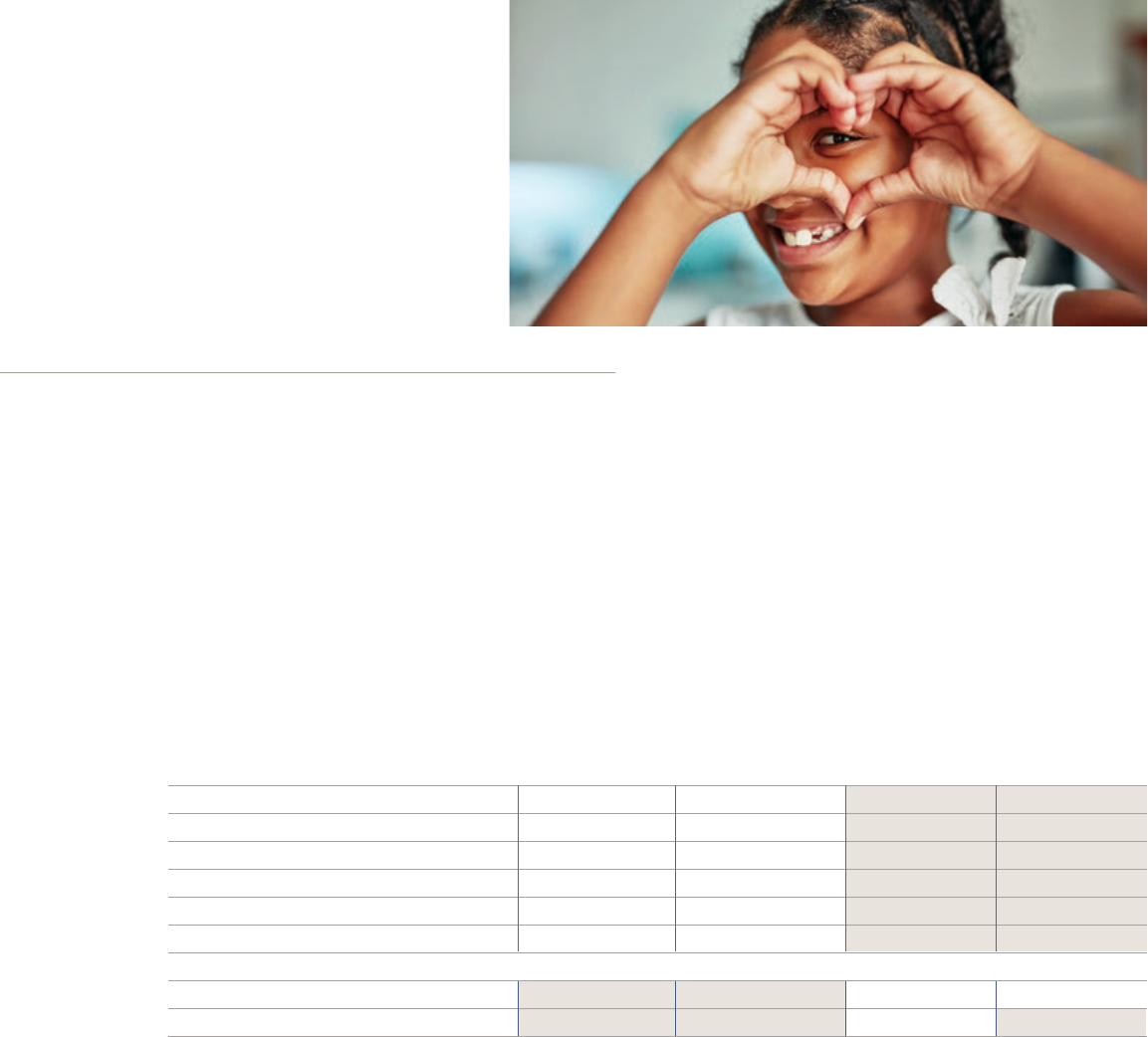
GROWING UP PHILLY: The Health and Well-being of Philadelphia’s Children 33
SOURCE: 2018-2019 PhilaVax Immunization Registry, PDPH
Kindergarten First day 7th Grade 12th Grade
to Grade 1 of School Entry Entry
Doses (5–6 years old) (5–17 years old) (13 years old) (17 years old)
DTP/Dtap/DT/Td, Tdap 4 doses 92% 89%
Polio 4 doses 95% 93%
MMR 2 doses 90% 90%
HepB 3 doses 93% 91%
Varicella 2 doses 80% 82%
All 5 vaccines up-to-date 77% 76%
MCV 4 1 dose 96% 96%
Tdap 1 dose 73%
Children with up-to-date
required immunizations
for school entry
IMMUNIZATIONS: School Entry
School vaccination
requirements help ensure
that all students are
protected against vaccine-
preventable diseases.
Based on data from the PhilaVax
Immunization Registry, more than
three-fourths of children were up-
to-date with all five recommended
vaccines upon school entry in the
2018-19 school year.
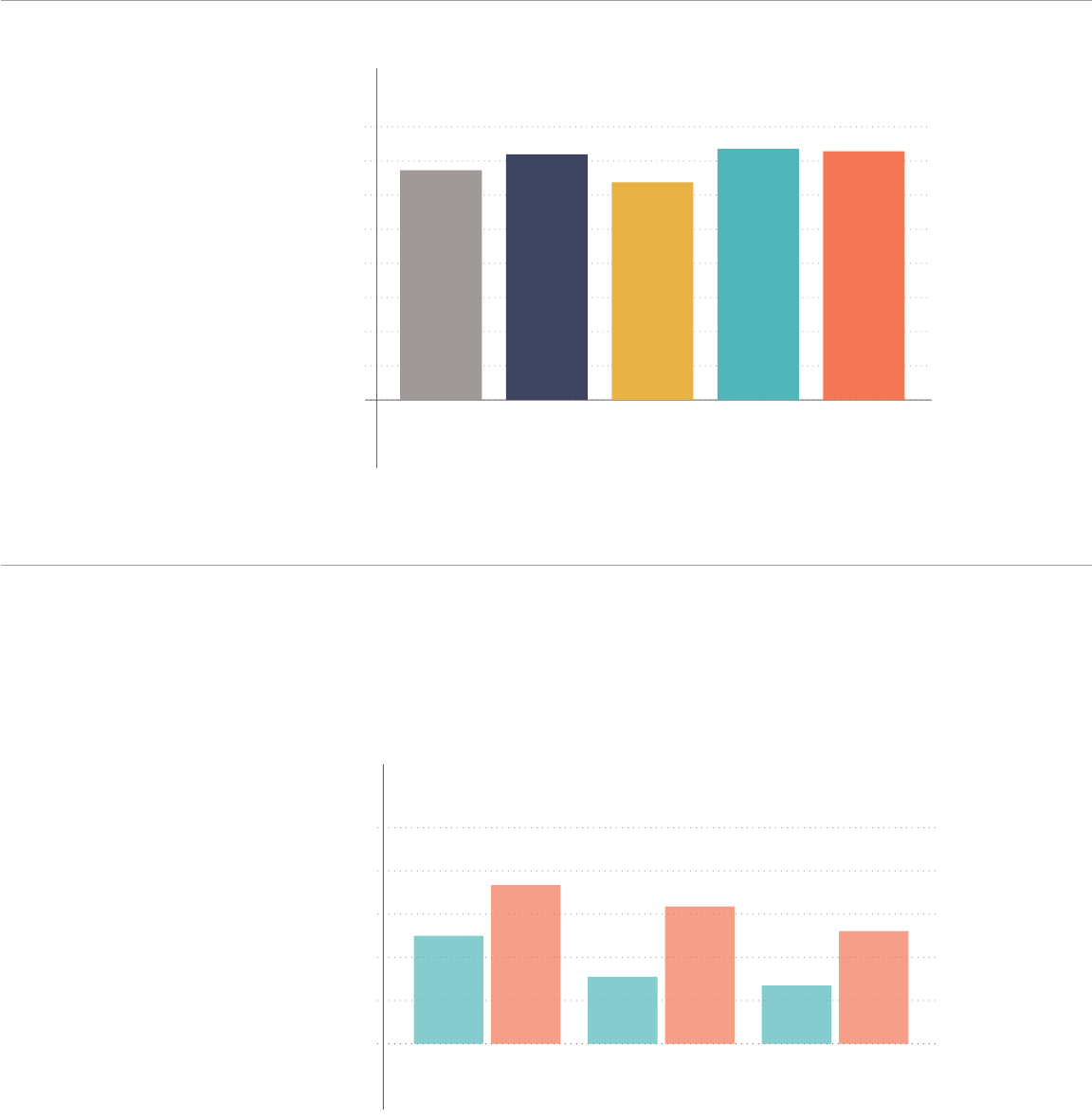
34 GROWING UP PHILLY: The Health and Well-being of Philadelphia’s Children
Health insurance coverage among children
NATIONAL AVERAGE: 70.4%
50%
60%
70%
80%
90%
20182017201620152014
Children 19-35 months with up-to-date combined
7-vaccine series
71.2%
69.6%
50.0%
31.0%
27.0%
52.2%
63.6%
73.4%
70.5%
70.1%
69.6%
61.4%61.3%61.4%
59.9%60.4%60.3%
57.6%
0
20%
40%
60%
80%
100%
13-17 years5-12 years6 months-2 years
Flu vaccination coverage,
Philadelphia and national averages
Children scoring below screening threshold
of well-being survey at 18 months
PHILADELPHIA NATIONAL
0
5%
10%
15%
20%
25%
30%
35%
40%
White*
Other
HispanicBlack*
Asian
All
children
24.7%
Children scoring below screening threshold
of well-being survey at 24 months
White*
Other
HispanicBlack*
Asian
21.3%
35.9%
23.6%
21.9%
31.8%
17.9%
All
children
23.8%
Number of infants and toddlers (0-<3)
receiving Early Intervention services
13-15 year olds who have received
HPV vaccine**
| by race/ethnicity
Number of preschool-aged children (3-5)
receiving Early Intervention services
Access to Nearby Parks
or Outdoor Space,
2012–2015
<70%
70.1-72%
72.1–74%
74.1–76%
>78.1%
74.7%
78.2%
77.3%
72.6%
81.9%
74.3%
60.7%
86%
71.7%
70%
74.2%
69.6%*
70.1%
66%
62.7%
70.6%
89.7%
0
2,000
4,000
6,000
8,000
10,000
FY18FY17FY16CY18CY17CY16
0
2,000
4,000
6,000
8,000
10,000
6,048
6,537
7,448
7,950
8,518
9,100
0%
10%
20%
30%
40%
50%
60%
70%
80%
Asian*Hispanic White* Black*Citywide
67.3%
71.9%
63.8%
73.6%
72.9%
0%
10%
20%
30%
40%
50%
60%
70%
80%
UNINSURED
MEDICAID
201820172016201520142013201220112010
61.0%
5.2%
4.7%
4.6%
5.9%
4.2%
2.9% 3.5% 3.1%
HUMAN PAPILLOMA VIRUS (HPV) VACCINE
It is recommended that
adolescents between the
ages of 11 and 15 years
old receive the Human
Papilloma Virus (HPV)
vaccine, which protects
against cervical cancer
and genital warts.
In Philadelphia, 67 percent of 13-
to 15-year olds have received HPV
vaccine, similar to the national
average of 68 percent. HPV
vaccination rates were lowest
among white youth, at 64 percent.
INFLUENZA VACCINATION COVERAGE
The American Academy of Pediatrics recommends an annual influenza vaccination
for all people 6 months and older.
30
Vaccination continues to be the primary way to
prevent sickness and death related to influenza.
Influenza vaccination coverage
among children decreased with
increasing age. This pattern was
also consistent with the national
influenza vaccination coverage
reported in the 2018-19 season.
Influenza vaccination coverage
was consistently lower in
Philadelphia than in the nation.
SOURCE: 2018-2019 PhilaVax Immunization Registry, PDPH
* Non-Hispanic
** These are children that received either the 2- or 3-dose HPV series and are considered
to be up-to-date.
Health insurance coverage among children
NATIONAL AVERAGE: 70.4%
50%
60%
70%
80%
90%
20182017201620152014
Children 19-35 months with up-to-date combined
7-vaccine series
71.2%
69.6%
50.0%
31.0%
27.0%
52.2%
63.6%
73.4%
70.5%
70.1%
69.6%
61.4%61.3%61.4%
59.9%60.4%60.3%
57.6%
0
20%
40%
60%
80%
100%
13-17 years5-12 years6 months-2 years
Flu vaccination coverage,
Philadelphia and national averages
Children scoring below screening threshold
of well-being survey at 18 months
PHILADELPHIA NATIONAL
0
5%
10%
15%
20%
25%
30%
35%
40%
White*
Other
HispanicBlack*
Asian
All
children
24.7%
Children scoring below screening threshold
of well-being survey at 24 months
White*
Other
HispanicBlack*
Asian
21.3%
35.9%
23.6%
21.9%
31.8%
17.9%
All
children
23.8%
Number of infants and toddlers (0-<3)
receiving Early Intervention services
13-15 year olds who have received
HPV vaccine**
| by race/ethnicity
Number of preschool-aged children (3-5)
receiving Early Intervention services
Access to Nearby Parks
or Outdoor Space,
2012–2015
<70%
70.1-72%
72.1–74%
74.1–76%
>78.1%
74.7%
78.2%
77.3%
72.6%
81.9%
74.3%
60.7%
86%
71.7%
70%
74.2%
69.6%*
70.1%
66%
62.7%
70.6%
89.7%
0
2,000
4,000
6,000
8,000
10,000
FY18FY17FY16CY18CY17CY16
0
2,000
4,000
6,000
8,000
10,000
6,048
6,537
7,448
7,950
8,518
9,100
0%
10%
20%
30%
40%
50%
60%
70%
80%
Asian*Hispanic White* Black*Citywide
67.3%
71.9%
63.8%
73.6%
72.9%
0%
10%
20%
30%
40%
50%
60%
70%
80%
UNINSURED
MEDICAID
201820172016201520142013201220112010
61.0%
5.2%
4.7%
4.6%
5.9%
4.2%
2.9% 3.5% 3.1%
SOURCE: 2018-2019 PhilaVax Immunization Registry, PDPH
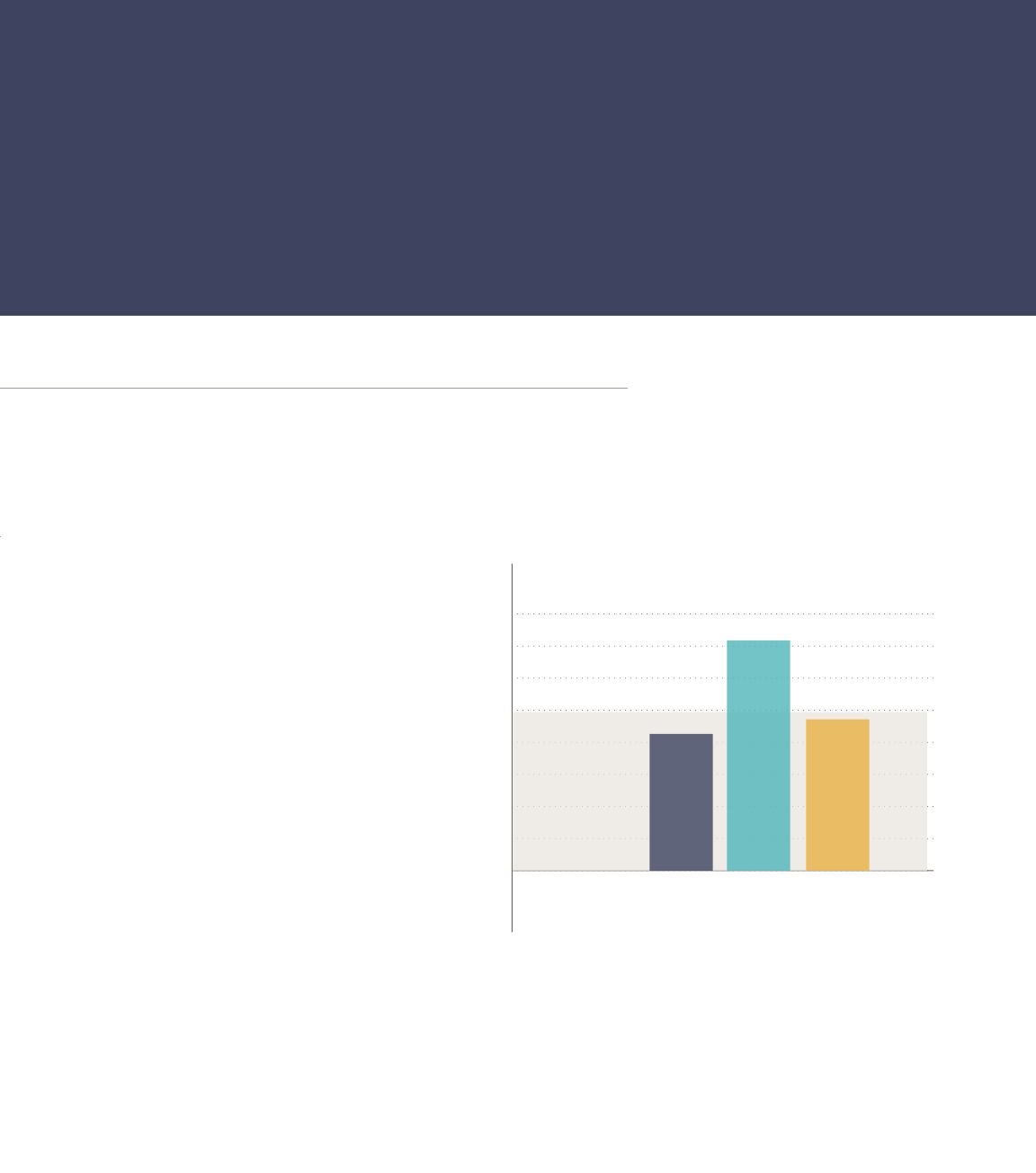
GROWING UP PHILLY: The Health and Well-being of Philadelphia’s Children 35
EARLY CHILDHOOD DEVELOPMENT
Children with delayed development may have higher risk for subsequent problems with
learning and health. The American Academy of Pediatrics recommends developmental
screening for all children during well-child visits at 18 and 30 months.
At these visits, screening tools
such as the Survey of Well-
being of Young Children (SWYC)
use parents’ reports of their
children’s capabilities to help
identify children with delayed
development. In 2018, the
Philadelphia Department of Public
Health began collecting data
on SWYC screening from local
pediatric practices, as part of a
long-term effort to track the health
and development of children
in the city. The first year, data
were available on 3,204 children.
24.7 percent and 23.8 percent
of children at 18-months and
24-months, respectively, scored
below the scoring threshold
established by SWYC developers
as needing further evaluation.
Health insurance coverage among children
NATIONAL AVERAGE: 70.4%
50%
60%
70%
80%
90%
20182017201620152014
Children 19-35 months with up-to-date combined
7-vaccine series
71.2%
69.6%
50.0%
31.0%
27.0%
52.2%
63.6%
73.4%
70.5%
70.1%
69.6%
61.4%61.3%61.4%
59.9%60.4%60.3%
57.6%
0
20%
40%
60%
80%
100%
13-17 years5-12 years6 months-2 years
Flu vaccination coverage,
Philadelphia and national averages
Children scoring below screening threshold
of well-being survey at 18 months
PHILADELPHIA NATIONAL
0
5%
10%
15%
20%
25%
30%
35%
40%
White*
Other
HispanicBlack*
Asian
All
children
24.7%
Children scoring below screening threshold
of well-being survey at 24 months
White*
Other
HispanicBlack*
Asian
21.3%
35.9%
23.6%
21.9%
31.8%
17.9%
All
children
23.8%
Number of infants and toddlers (0-<3)
receiving Early Intervention services
13-15 year olds who have received
HPV vaccine**
| by race/ethnicity
Number of preschool-aged children (3-5)
receiving Early Intervention services
Access to Nearby Parks
or Outdoor Space,
2012–2015
<70%
70.1-72%
72.1–74%
74.1–76%
>78.1%
74.7%
78.2%
77.3%
72.6%
81.9%
74.3%
60.7%
86%
71.7%
70%
74.2%
69.6%*
70.1%
66%
62.7%
70.6%
89.7%
0
2,000
4,000
6,000
8,000
10,000
FY18FY17FY16CY18CY17CY16
0
2,000
4,000
6,000
8,000
10,000
6,048
6,537
7,448
7,950
8,518
9,100
0%
10%
20%
30%
40%
50%
60%
70%
80%
Asian*Hispanic White* Black*Citywide
67.3%
71.9%
63.8%
73.6%
72.9%
0%
10%
20%
30%
40%
50%
60%
70%
80%
UNINSURED
MEDICAID
201820172016201520142013201220112010
61.0%
5.2%
4.7%
4.6%
5.9%
4.2%
2.9% 3.5% 3.1%
SOURCE: 2018 Childhood Developmental Delay Surveillance System, PDPH
*Non-Hispanic
“ you have to have a pretty severe [developmental] delay to be
eligible for therapy when they’re young. You can see the warning
signs and you just have to wait and watch your child fall farther
and farther behind, so that you’re playing catch up...”
— Resident from Philadelphia Community Needs Assessment
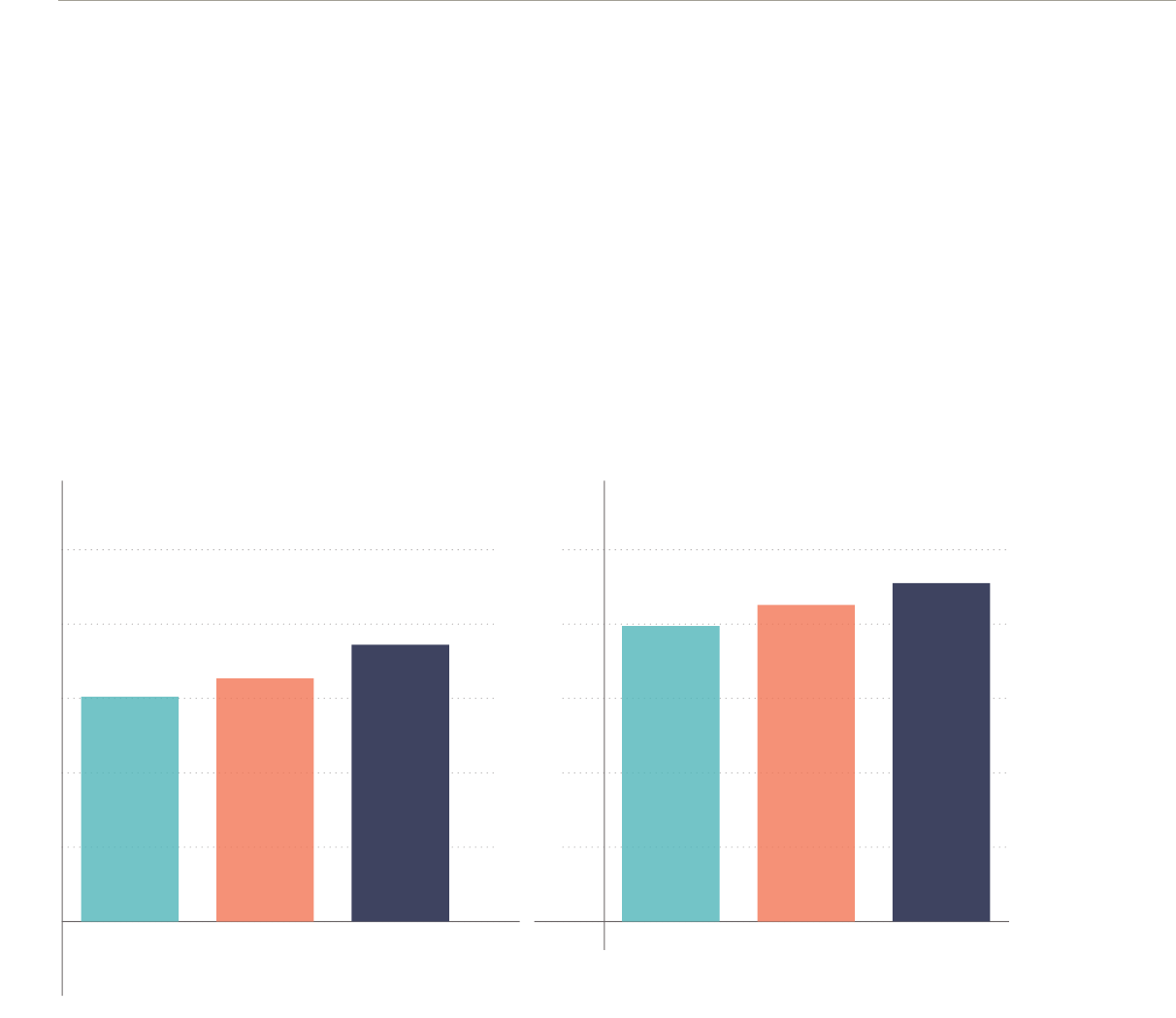
36 GROWING UP PHILLY: The Health and Well-being of Philadelphia’s Children
EARLY INTERVENTION SERVICES
Children identified as being at risk for a developmental delay are referred to Early
Intervention for evaluation by a team of specialists.
Based on the evaluation, Early
Intervention services, which
includes speech therapy, physical
therapy, and other types of
services, may then be provided
to children and their families.
Infants and toddlers with concern
for developmental delays are
referred to the Philadelphia
Infant Toddler Early Intervention
Program.
In the 2018 calendar year (CY),
7,448 children under age 3
received early intervention
services. Children 3-5 years old
were referred to Preschool Early
Intervention Program (Elwynn
SEEDS) for services and support.
Over the years, the number of
children served by Elwynn SEEDS
has increased, with 9,100 children
receiving services in the 2018
fiscal year (FY).
Health insurance coverage among children
NATIONAL AVERAGE: 70.4%
50%
60%
70%
80%
90%
20182017201620152014
Children 19-35 months with up-to-date combined
7-vaccine series
71.2%
69.6%
50.0%
31.0%
27.0%
52.2%
63.6%
73.4%
70.5%
70.1%
69.6%
61.4%61.3%61.4%
59.9%60.4%60.3%
57.6%
0
20%
40%
60%
80%
100%
13-17 years5-12 years6 months-2 years
Flu vaccination coverage,
Philadelphia and national averages
Children scoring below screening threshold
of well-being survey at 18 months
PHILADELPHIA NATIONAL
0
5%
10%
15%
20%
25%
30%
35%
40%
White*
Other
HispanicBlack*
Asian
All
children
24.7%
Children scoring below screening threshold
of well-being survey at 24 months
White*
Other
HispanicBlack*
Asian
21.3%
35.9%
23.6%
21.9%
31.8%
17.9%
All
children
23.8%
Number of infants and toddlers (0-<3)
receiving Early Intervention services
13-15 year olds who have received
HPV vaccine**
| by race/ethnicity
Number of preschool-aged children (3-5)
receiving Early Intervention services
Access to Nearby Parks
or Outdoor Space,
2012–2015
<70%
70.1-72%
72.1–74%
74.1–76%
>78.1%
74.7%
78.2%
77.3%
72.6%
81.9%
74.3%
60.7%
86%
71.7%
70%
74.2%
69.6%*
70.1%
66%
62.7%
70.6%
89.7%
0
2,000
4,000
6,000
8,000
10,000
FY18FY17FY16CY18CY17CY16
0
2,000
4,000
6,000
8,000
10,000
6,048
6,537
7,448
7,950
8,518
9,100
0%
10%
20%
30%
40%
50%
60%
70%
80%
Asian*Hispanic White* Black*Citywide
67.3%
71.9%
63.8%
73.6%
72.9%
0%
10%
20%
30%
40%
50%
60%
70%
80%
UNINSURED
MEDICAID
201820172016201520142013201220112010
61.0%
5.2%
4.7%
4.6%
5.9%
4.2%
2.9% 3.5% 3.1%
SOURCE: 2016-2018 Infant Toddler Early Intervention Program and Elwynn SEEDS

GROWING UP PHILLY: The Health and Well-being of Philadelphia’s Children 37
4
Physical
Environment
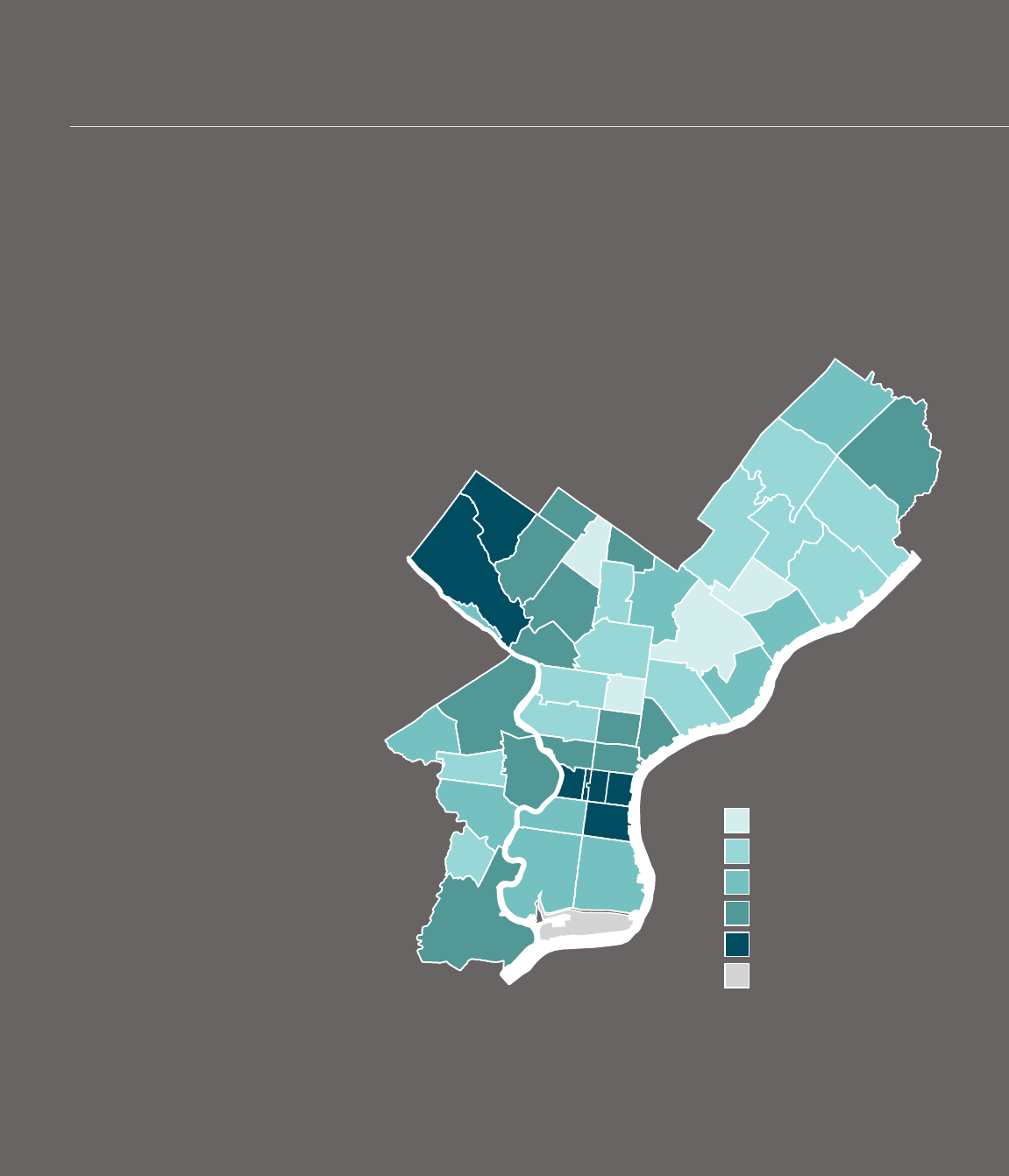
38 GROWING UP PHILLY: The Health and Well-being of Philadelphia’s Children
ACCESS TO GREEN SPACE & PUBLIC PARKS
Public parks and outdoor green spaces can help promote
physical activity in urban areas, especially among
children.
30
Access to safe parks and green spaces in
neighborhoods can also help alleviate stress and improve
mental health among residents.
31
In 2018, approximately 75
percent of adults reported
that they had access to a nearby
park or outdoor green space that
they were comfortable visiting.
Access was greatest in the
Northwest and Center City
and lowest in North Philadelphia
and the Lower Northeast.
STORE COUNT
0
1-5
6-10
11-20
21-25
Non-residential
% OF RESIDENTS
WITH A SAFE PARK
AVAILABLE
≤51.6%
≤70.2%
≤81.0%
≤93.0%
≤ 100%
Non-residential
19112
Self-reported access to
safe outdoor recreational spaces
by zip code
SOURCE: 2019 PHMC Household Health Survey
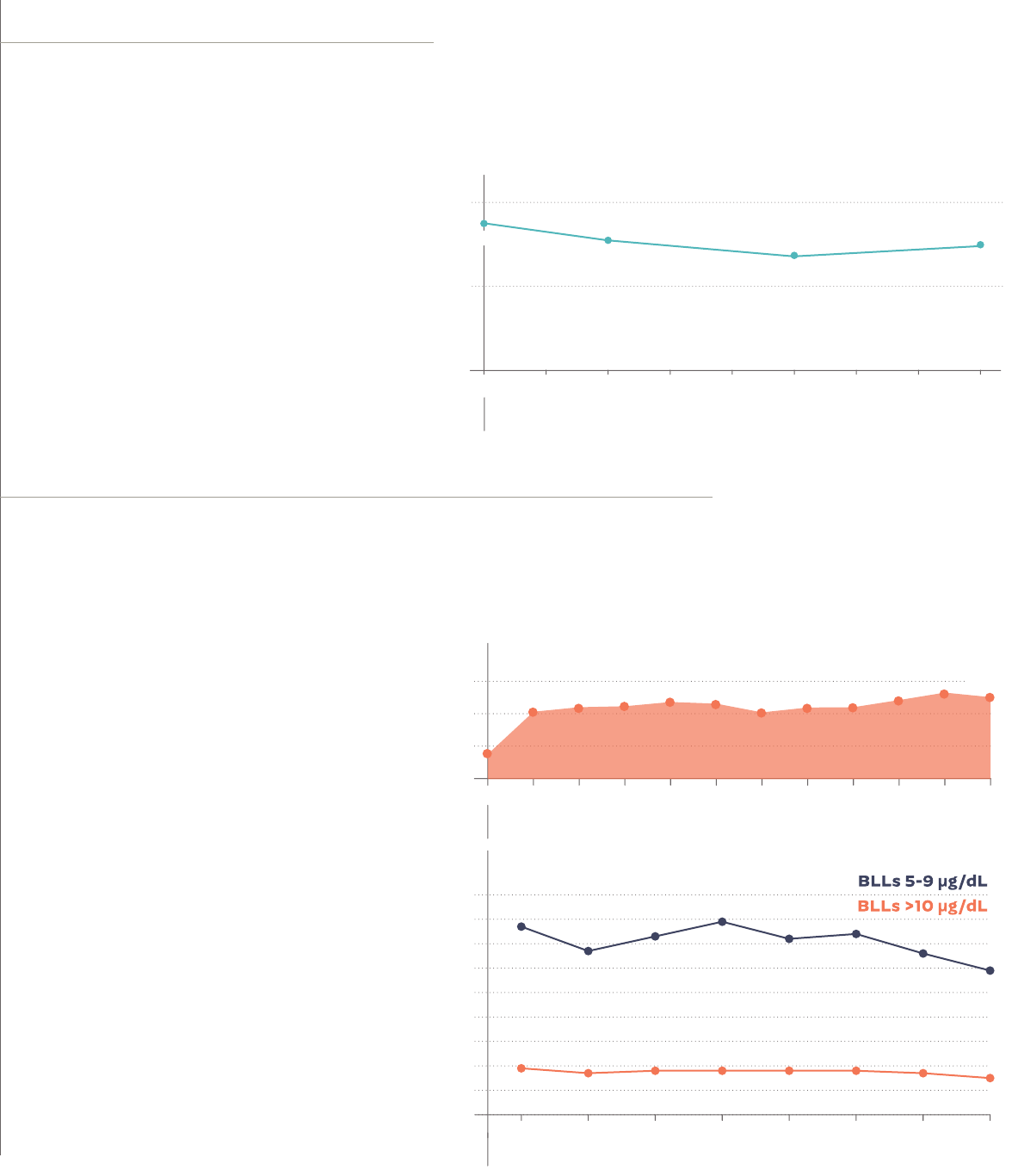
GROWING UP PHILLY: The Health and Well-being of Philadelphia’s Children 39
SECONDHAND SMOKE
Secondhand smoke
exposure is especially
dangerous for infants and
children. Secondhand
smoke contributes to
multiple health problems
in children, including
more frequent and severe
asthma attacks, respiratory
infections, ear infections,
and sudden infant death
syndrome (SIDS).
32
Secondhand smoke exposure at home among children in Philadelphia has
remained stable at about 15 percent from 2010 to 2018.
CHILDHOOD LEAD POISONING SCREENINGS
The Philadelphia Department of Public Health recommends that all children be screened
for lead exposure between the ages of 8-12 months and again at the age of 24 months.
In 2016, 75 percent of children
received at least one lead
screening test before they
turned 2 years old.
The percentage of children less
than 24 months of age who have
elevated blood lead levels (BLLs)
has decreased from 2011 to 2018.
In 2018, 5.9 percent of children
less than 2 years of age were
newly identified as having blood
lead levels between 5-9 µg/dL and
only 1.5 percent of children under
the age of 2 years had blood lead
levels greater than 10 µg/dL.
Physical inactivity among teens
| by race/ethnicity
Physical inactivity among teens
| by sex
Soda consumption among teens
once or more per day
10%
15%
20%
25%
30%
HISPANIC
WHITE*
BLACK*
2019201720152013201120092007
10%
15%
20%
25%
30%
35%
FEMALE
MALE
CITYWIDE
2019201720152013201120092007
29.4%
22.6%
17.0%
27.3%
17.4%
13.4%
13.5%
11.7%
9.2%
33.9%
18.7%
17.1%
17.2%
24.4%
5%
10%
15%
20%
25%
30%
35%
HISPANIC
WHITE*
BLACK*
CITYWIDE
2019201720152013201120092007
Current alcohol consumption in the last
30 days
| by race/ethnicity
Current alcohol
consumption in the last
30 days
| by sexual orientation
10%
20%
30%
40%
50%
60%
70%
80%
HISPANIC
WHITE*
BLACK*
CITYWIDE
201920172015201320112009200720032001
0% 5% 10% 15% 20% 25% 30% 35%
Currently Drink Binge Drink
LGBTQ+
Teens
Heterosexual
Teens
13.8%
4.3%
15.9%
34.9%
Teen condom use during last sexual encounter
Teen births among women aged 15-19
| per 1,000
women by race/ethnicity
48.7%
55.2%
41.1
29.6
24.3
7.3
5.6
40%
50%
60%
70%
80%
2019201720152013201120092007200520032001
Secondhand smoke exposure at home
Children screened for lead exposure
before the age of 24 months
People living in poverty
| by age group and location
Childhood poverty
| by race/ethnicity
0%
10%
20%
201820172016201520142013201220112010
0
20
40
60
80
100
120
asian
hispanic
black
white
citywide
20172016201520142013201220112010200920082007
ASIAN*
WHITE*
HISPANIC
BLACK*
CITYWIDE
15.0%
13.7%
15.4%
75.1%
20%
30%
40%
50%
60%
70%
80%
201620152014201320122011201020092008200720062005
PHILADELPHIA
PENNSYLVANIA
UNITED STATES
0%
5%
10%
15%
20%
25%
30%
35%
40%
Children <5Children age 5-17Children <18Total Population: All Ages
18.0%
17.0%
19.5%
13.1%
17.6%
16.0%
16.8%
12.2%
24.5%
34.6%
35.9%
30.8%
55.9%
57.8%
59.6%
62.8%
64.4%
70.2%
64.3%
0%
10%
20%
30%
40%
50%
Asian*HispanicBlack*White*
Citywide: 35%
16%
38%
49%
21%
17.5%
0%
10%
20%
30%
40%
50%
60%
201820172016201520142013201220112010
Percentage of households burdened
by financial costs of home
49.5%
48.1%
48.1%
52.8%
51.9%
53.2%53.1%
Children in single-parent households
Families receiving public benefits in past year
Homelessness
4th grade reading proficiency
Public school third-graders who
scored proficient or above in reading
| by city
High schoolers who graduated in 4 years during
the 2017–2018 school year
| by race/ethnicity and sex
On-time high school graduation
57.6%
51.3%
52.9%
26.6%
1,528
6
17
0
1,437
1,271
0%
10%
20%
30%
40%
50%
60%
70%
80%
201820172016201520142013201220112010
National
Average:
33.2%
National
Average:
31.0%
0%
10%
20%
30%
40%
50%
60%
70%
WIC
SNAP
201820172016201520142013201220112010
0
500
1,000
1,500
2,000
UNSHELTERED
SHELTERED
2019201820172016
1,753
0
20%
25%
30%
35%
2018201720162015
28.5%
28.4%
30.8%
31.2%
0% 10% 20% 30% 40% 50% 60% 70% 80%
Houston
Chicago
New York City
Philadelphia
34.0%
44.8%
31.6%
68.0%
0%
10%
20%
30%
40%
50%
60%
70%
80%
20182017201620152014201320122011
0%
20%
40%
60%
80%
100%
FemaleMaleAsian*HispanicWhite*Black*
Citywide
62.8%
60.6%
67.5%
55.6%
85.1%
65.4%
78.3%
Children screened for lead exposure before age 24 months
75.1%
50%
60%
70%
80%
201620152014201320122011201020092008200720062005
0%
1%
2%
3%
4%
5%
6%
7%
8%
9%
20182017201620152014201320122011
1.5%
5.9%
Children <24 months screened for lead
with elevated blood levels
50.3%
58.9%
58.1%
60.5%
58.2%
58.8%
60.2%
58.7%
58.4%
56.1%
22.1%
25.8%
26.2%
25.5%
23.5%
26.3%
25.1%
22.1%
56.3%
58.4%
61.3%61.2%
60.6%
ASIAN
HISPANIC
BLACK
WHITE
CITYWIDE
62.8%
67.2%
68.6%
64.8%
68.2%
70.1%
61.5%
55.2%
SOURCE: 2018 Childhood Lead Surveillance Report, PDPH
SOURCE: 2018 Childhood Lead Surveillance Report, PDPH
SOURCE: 2010-2018 Public Health Management Corporation Southeastern Pennsylvania
Household Health Survey

40 GROWING UP PHILLY: The Health and Well-being of Philadelphia’s Children
5
Social and
Economic
Factors
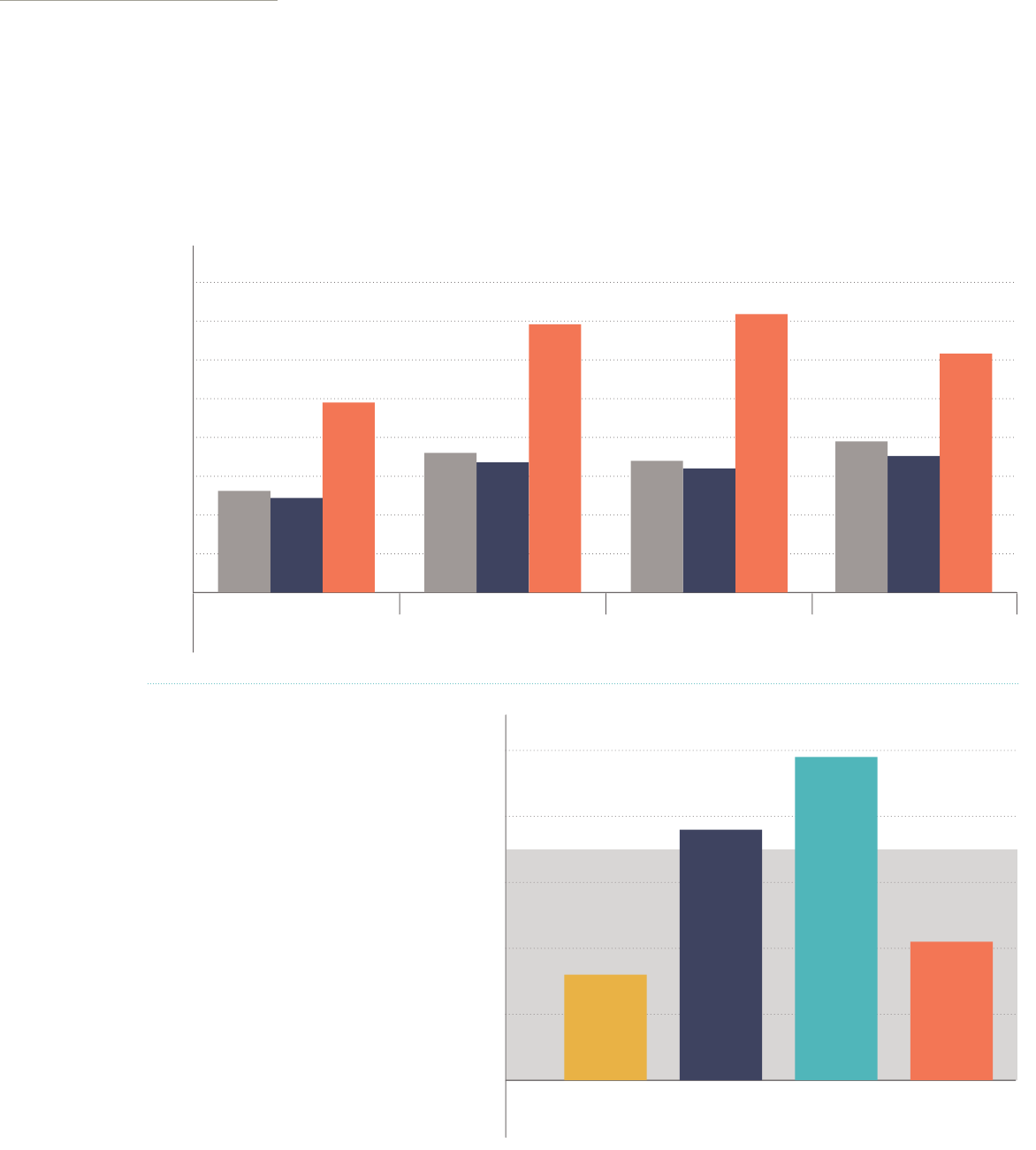
GROWING UP PHILLY: The Health and Well-being of Philadelphia’s Children 41
Physical inactivity among teens
| by race/ethnicity
Physical inactivity among teens
| by sex
Soda consumption among teens
once or more per day
10%
15%
20%
25%
30%
HISPANIC
WHITE*
BLACK*
2019201720152013201120092007
10%
15%
20%
25%
30%
35%
FEMALE
MALE
CITYWIDE
2019201720152013201120092007
29.4%
22.6%
17.0%
27.3%
17.4%
13.4%
13.5%
11.7%
9.2%
33.9%
18.7%
17.1%
17.2%
24.4%
5%
10%
15%
20%
25%
30%
35%
HISPANIC
WHITE*
BLACK*
CITYWIDE
2019201720152013201120092007
Current alcohol consumption in the last
30 days
| by race/ethnicity
Current alcohol
consumption in the last
30 days
| by sexual orientation
10%
20%
30%
40%
50%
60%
70%
80%
HISPANIC
WHITE*
BLACK*
CITYWIDE
201920172015201320112009200720032001
0% 5% 10% 15% 20% 25% 30% 35%
Currently Drink Binge Drink
LGBTQ+
Teens
Heterosexual
Teens
13.8%
4.3%
15.9%
34.9%
Teen condom use during last sexual encounter
Teen births among women aged 15-19
| per 1,000
women by race/ethnicity
48.7%
55.2%
41.1
29.6
24.3
7.3
5.6
40%
50%
60%
70%
80%
2019201720152013201120092007200520032001
Secondhand smoke exposure at home
Children screened for lead exposure
before the age of 24 months
People living in poverty
| by age group and location
Childhood poverty
| by race/ethnicity
0%
10%
20%
201820172016201520142013201220112010
0
20
40
60
80
100
120
asian
hispanic
black
white
citywide
20172016201520142013201220112010200920082007
ASIAN*
WHITE*
HISPANIC
BLACK*
CITYWIDE
15.0%
13.7%
15.4%
75.1%
20%
30%
40%
50%
60%
70%
80%
201620152014201320122011201020092008200720062005
PHILADELPHIA
PENNSYLVANIA
UNITED STATES
0%
5%
10%
15%
20%
25%
30%
35%
40%
Children <5Children age 5-17Children <18Total Population: All Ages
18.0%
17.0%
19.5%
13.1%
17.6%
16.0%
16.8%
12.2%
24.5%
34.6%
35.9%
30.8%
55.9%
57.8%
59.6%
62.8%
64.4%
70.2%
64.3%
0%
10%
20%
30%
40%
50%
Asian*HispanicBlack*White*
Citywide: 35%
16%
38%
49%
21%
17.5%
Physical inactivity among teens
| by race/ethnicity
Physical inactivity among teens
| by sex
Soda consumption among teens
once or more per day
10%
15%
20%
25%
30%
HISPANIC
WHITE*
BLACK*
2019201720152013201120092007
10%
15%
20%
25%
30%
35%
FEMALE
MALE
CITYWIDE
2019201720152013201120092007
29.4%
22.6%
17.0%
27.3%
17.4%
13.4%
13.5%
11.7%
9.2%
33.9%
18.7%
17.1%
17.2%
24.4%
5%
10%
15%
20%
25%
30%
35%
HISPANIC
WHITE*
BLACK*
CITYWIDE
2019201720152013201120092007
Current alcohol consumption in the last
30 days
| by race/ethnicity
Current alcohol
consumption in the last
30 days
| by sexual orientation
10%
20%
30%
40%
50%
60%
70%
80%
HISPANIC
WHITE*
BLACK*
CITYWIDE
201920172015201320112009200720032001
0% 5% 10% 15% 20% 25% 30% 35%
Currently Drink Binge Drink
LGBTQ+
Teens
Heterosexual
Teens
13.8%
4.3%
15.9%
34.9%
Teen condom use during last sexual encounter
Teen births among women aged 15-19
| per 1,000
women by race/ethnicity
48.7%
55.2%
41.1
29.6
24.3
7.3
5.6
40%
50%
60%
70%
80%
2019201720152013201120092007200520032001
Secondhand smoke exposure at home
Children screened for lead exposure
before the age of 24 months
People living in poverty
| by age group and location
Childhood poverty
| by race/ethnicity
0%
10%
20%
201820172016201520142013201220112010
0
20
40
60
80
100
120
asian
hispanic
black
white
citywide
20172016201520142013201220112010200920082007
ASIAN*
WHITE*
HISPANIC
BLACK*
CITYWIDE
15.0%
13.7%
15.4%
75.1%
20%
30%
40%
50%
60%
70%
80%
201620152014201320122011201020092008200720062005
PHILADELPHIA
PENNSYLVANIA
UNITED STATES
0%
5%
10%
15%
20%
25%
30%
35%
40%
Children <5Children age 5-17Children <18Total Population: All Ages
18.0%
17.0%
19.5%
13.1%
17.6%
16.0%
16.8%
12.2%
24.5%
34.6%
35.9%
30.8%
55.9%
57.8%
59.6%
62.8%
64.4%
70.2%
64.3%
0%
10%
20%
30%
40%
50%
Asian*HispanicBlack*White*
Citywide: 35%
16%
38%
49%
21%
17.5%
POVERTY
Growing up in poverty can lead to adverse health
outcomes in childhood, including hospitalizations,
asthma, and acute infections,
33
and have negative
impacts on health through adulthood.
34
The federal poverty level was
$25,701 in 2018 for a family of
four. In 2018, 34.6 percent of
children in Philadelphia under the
age of 18 (119,055 children) lived
in poverty, about twice the state
and national average.
The distribution of poverty
among children in Philadelphia
is concentrated among racial
and ethnic minorities. Almost
50 percent of Hispanic children
live in poverty and 38 percent of
non-Hispanic black children live
in poverty.
SOURCE: 2018 American Community Survey 1-Year Estimates, US Census Bureau
SOURCE: 2018 American Community Survey 1-Year Estimates, US Census Bureau
*Non-Hispanic
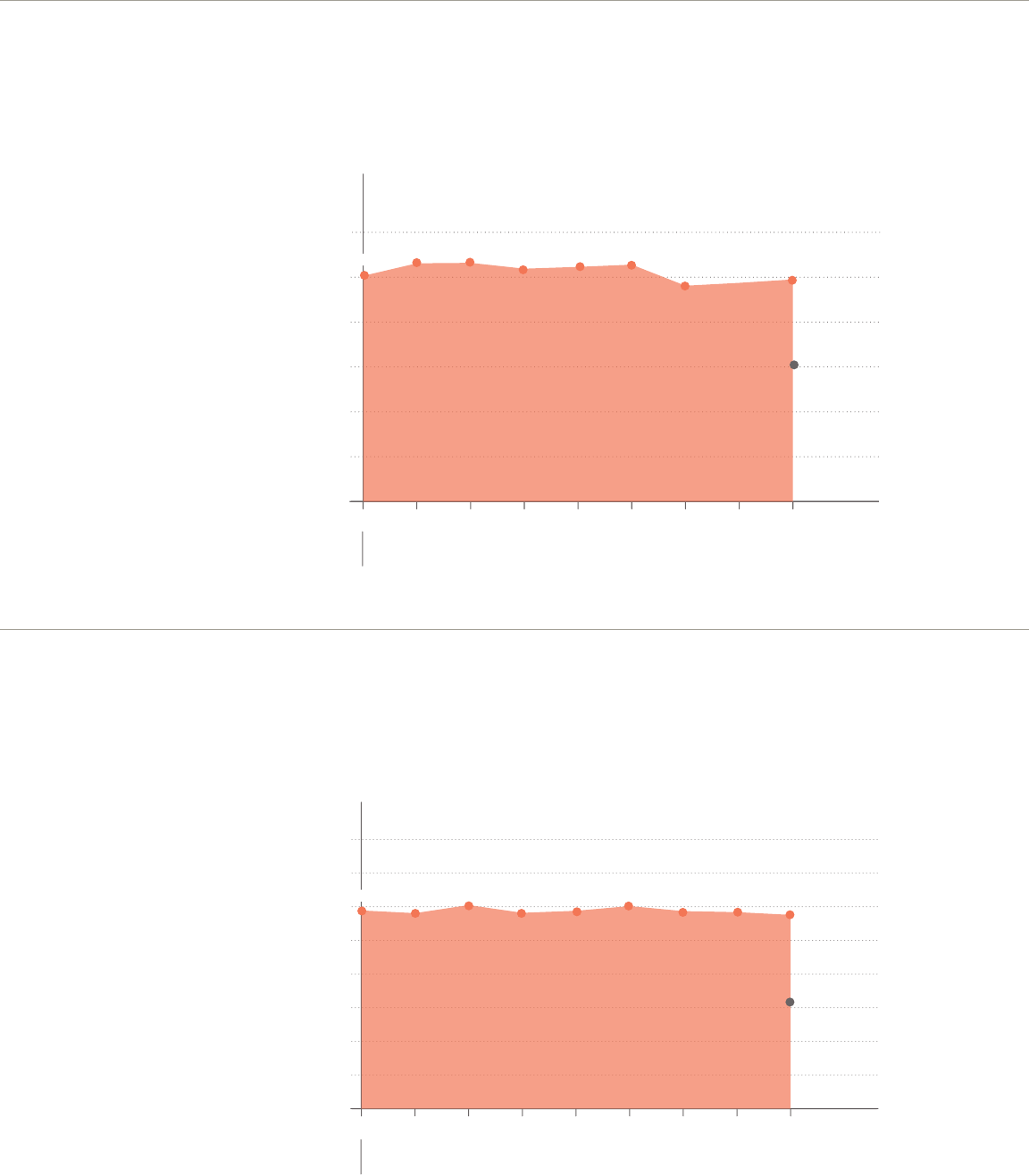
42 GROWING UP PHILLY: The Health and Well-being of Philadelphia’s Children
0%
10%
20%
30%
40%
50%
60%
201820172016201520142013201220112010
Percentage of households burdened
by financial costs of home
49.5%
48.1%
48.1%
52.8%
51.9%
53.2%53.1%
Children in single-parent households
Families receiving public benefits in past year
Homelessness
4th grade reading proficiency
Public school third-graders who
scored proficient or above in reading
| by city
High schoolers who graduated in 4 years during
the 2017–2018 school year
| by race/ethnicity and sex
On-time high school graduation
57.6%
51.3%
52.9%
26.6%
1,528
6
17
0
1,437
1,271
0%
10%
20%
30%
40%
50%
60%
70%
80%
201820172016201520142013201220112010
National
Average:
33.2%
National
Average:
31.0%
0%
10%
20%
30%
40%
50%
60%
70%
WIC
SNAP
201820172016201520142013201220112010
0
500
1,000
1,500
2,000
UNSHELTERED
SHELTERED
2019201820172016
1,753
0
20%
25%
30%
35%
2018201720162015
28.5%
28.4%
30.8%
31.2%
0% 10% 20% 30% 40% 50% 60% 70% 80%
Houston
Chicago
New York City
Philadelphia
34.0%
44.8%
31.6%
68.0%
0%
10%
20%
30%
40%
50%
60%
70%
80%
20182017201620152014201320122011
0%
20%
40%
60%
80%
100%
FemaleMaleAsian*HispanicWhite*Black*
Citywide
62.8%
60.6%
67.5%
55.6%
85.1%
65.4%
78.3%
Children screened for lead exposure before age 24 months
75.1%
50%
60%
70%
80%
201620152014201320122011201020092008200720062005
0%
1%
2%
3%
4%
5%
6%
7%
8%
9%
20182017201620152014201320122011
1.5%
5.9%
Children <24 months screened for lead
with elevated blood levels
50.3%
58.9%
58.1%
60.5%
58.2%
58.8%
60.2%
58.7%
58.4%
56.1%
22.1%
25.8%
26.2%
25.5%
23.5%
26.3%
25.1%
22.1%
56.3%
58.4%
61.3%61.2%
60.6%
ASIAN
HISPANIC
BLACK
WHITE
CITYWIDE
62.8%
67.2%
68.6%
64.8%
68.2%
70.1%
61.5%
55.2%
0%
10%
20%
30%
40%
50%
60%
201820172016201520142013201220112010
Percentage of households burdened
by financial costs of home
49.5%
48.1%
48.1%
52.8%
51.9%
53.2%53.1%
Children in single-parent households
Families receiving public benefits in past year
Homelessness
4th grade reading proficiency
Public school third-graders who
scored proficient or above in reading
| by city
High schoolers who graduated in 4 years during
the 2017–2018 school year
| by race/ethnicity and sex
On-time high school graduation
57.6%
51.3%
52.9%
26.6%
1,528
6
17
0
1,437
1,271
0%
10%
20%
30%
40%
50%
60%
70%
80%
201820172016201520142013201220112010
National
Average:
33.2%
National
Average:
31.0%
0%
10%
20%
30%
40%
50%
60%
70%
WIC
SNAP
201820172016201520142013201220112010
0
500
1,000
1,500
2,000
UNSHELTERED
SHELTERED
2019201820172016
1,753
0
20%
25%
30%
35%
2018201720162015
28.5%
28.4%
30.8%
31.2%
0% 10% 20% 30% 40% 50% 60% 70% 80%
Houston
Chicago
New York City
Philadelphia
34.0%
44.8%
31.6%
68.0%
0%
10%
20%
30%
40%
50%
60%
70%
80%
20182017201620152014201320122011
0%
20%
40%
60%
80%
100%
FemaleMaleAsian*HispanicWhite*Black*
Citywide
62.8%
60.6%
67.5%
55.6%
85.1%
65.4%
78.3%
Children screened for lead exposure before age 24 months
75.1%
50%
60%
70%
80%
201620152014201320122011201020092008200720062005
0%
1%
2%
3%
4%
5%
6%
7%
8%
9%
20182017201620152014201320122011
1.5%
5.9%
Children <24 months screened for lead
with elevated blood levels
50.3%
58.9%
58.1%
60.5%
58.2%
58.8%
60.2%
58.7%
58.4%
56.1%
22.1%
25.8%
26.2%
25.5%
23.5%
26.3%
25.1%
22.1%
56.3%
58.4%
61.3%61.2%
60.6%
ASIAN
HISPANIC
BLACK
WHITE
CITYWIDE
62.8%
67.2%
68.6%
64.8%
68.2%
70.1%
61.5%
55.2%
HOUSING COST BURDEN
Housing cost burden is defined as spending more than 30 percent of one’s monthly income
on housing costs, including rent, utilities, and mortgage costs. High housing costs can lead
to financial strain and can affect families’ ability to pay for essentials, including food.
35
In Philadelphia, the percentage
of households experiencing
cost burden was higher than the
national average of 31 percent,
and has remained stable, with
almost half (49.5 percent) of all
households experiencing housing
cost burden in 2018.
SINGLE-PARENT HOUSEHOLDS
Growing up in a single-parent household can lead to financial strain in families. Single-
parent families are twice as likely to be in poverty compared to married couple families,
which can in turn lead to adverse child and parent health outcomes.
36
From 2010 to 2018, the percentage
of children living in single-parent
households remained stable at
approximately 58 percent, nearly
twice the national average of
33.2 percent.
SOURCE: 2010-2018 American Community Survey 1-Year Estimates, US Census Bureau
SOURCE: 2010-2018 American Community Survey US Census Bureau
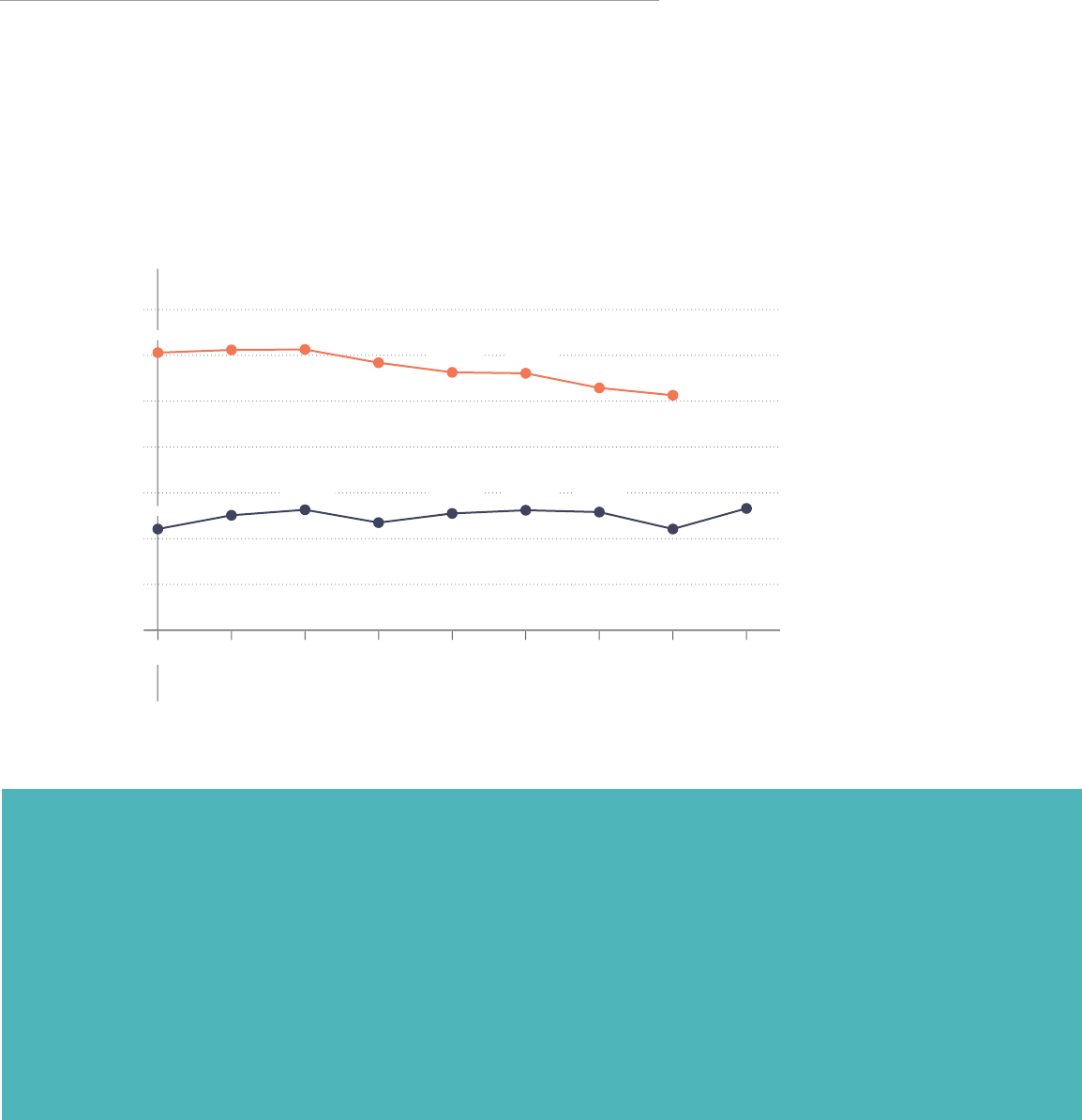
GROWING UP PHILLY: The Health and Well-being of Philadelphia’s Children 43
0%
10%
20%
30%
40%
50%
60%
201820172016201520142013201220112010
Percentage of households burdened
by financial costs of home
49.5%
48.1%
48.1%
52.8%
51.9%
53.2%53.1%
Children in single-parent households
Families receiving public benefits in past year
Homelessness
4th grade reading proficiency
Public school third-graders who
scored proficient or above in reading
| by city
High schoolers who graduated in 4 years during
the 2017–2018 school year
| by race/ethnicity and sex
On-time high school graduation
57.6%
51.3%
52.9%
26.6%
1,528
6
17
0
1,437
1,271
0%
10%
20%
30%
40%
50%
60%
70%
80%
201820172016201520142013201220112010
National
Average:
33.2%
National
Average:
31.0%
0%
10%
20%
30%
40%
50%
60%
70%
WIC
SNAP
201820172016201520142013201220112010
0
500
1,000
1,500
2,000
UNSHELTERED
SHELTERED
2019201820172016
1,753
0
20%
25%
30%
35%
2018201720162015
28.5%
28.4%
30.8%
31.2%
0% 10% 20% 30% 40% 50% 60% 70% 80%
Houston
Chicago
New York City
Philadelphia
34.0%
44.8%
31.6%
68.0%
0%
10%
20%
30%
40%
50%
60%
70%
80%
20182017201620152014201320122011
0%
20%
40%
60%
80%
100%
FemaleMaleAsian*HispanicWhite*Black*
Citywide
62.8%
60.6%
67.5%
55.6%
85.1%
65.4%
78.3%
Children screened for lead exposure before age 24 months
75.1%
50%
60%
70%
80%
201620152014201320122011201020092008200720062005
0%
1%
2%
3%
4%
5%
6%
7%
8%
9%
20182017201620152014201320122011
1.5%
5.9%
Children <24 months screened for lead
with elevated blood levels
50.3%
58.9%
58.1%
60.5%
58.2%
58.8%
60.2%
58.7%
58.4%
56.1%
22.1%
25.8%
26.2%
25.5%
23.5%
26.3%
25.1%
22.1%
56.3%
58.4%
61.3%61.2%
60.6%
ASIAN
HISPANIC
BLACK
WHITE
CITYWIDE
62.8%
67.2%
68.6%
64.8%
68.2%
70.1%
61.5%
55.2%
RECEIPT OF SAFETY-NET BENEFITS
To help reduce the burden of poverty, public assistance programs provide various forms of
support to low-income families. The federal Supplemental Nutrition Assistance Program
provides food stamps to low-income individuals and families to purchase food, and the
federal Supplemental Nutrition Program for Women, Infants, and Children (WIC) provides
nutrition education and services to low-income pregnant, breastfeeding, and postpartum
mothers with children under the age of five.
The percentage of households
who received food stamps
or SNAP benefits remained
relatively stable from 2010
to 2018, with 26.6 percent of
families in Philadelphia receiving
food stamps in 2018. This is
more than twice the national
average (11.3 percent).
The percentage of families
receiving WIC benefits has
slightly declined from 2010
to 2018, with more than half
(51.3 percent) of families in
Philadelphia receiving WIC
benefits. This is much higher
than the Pennsylvania state
average (34.1 percent).
SOURCE: 2010-2018 American Community Survey, US Census Bureau; PA Department of Health
Vital Statistics
“ You’re trying to make the kid an appointment,
but that’s over now, because now your utilities
are being shut off…It pushes the health and
welfare of your children down because you’ve
got to worry about their priorities.”
— Resident from Philadelphia Community Needs Assessment
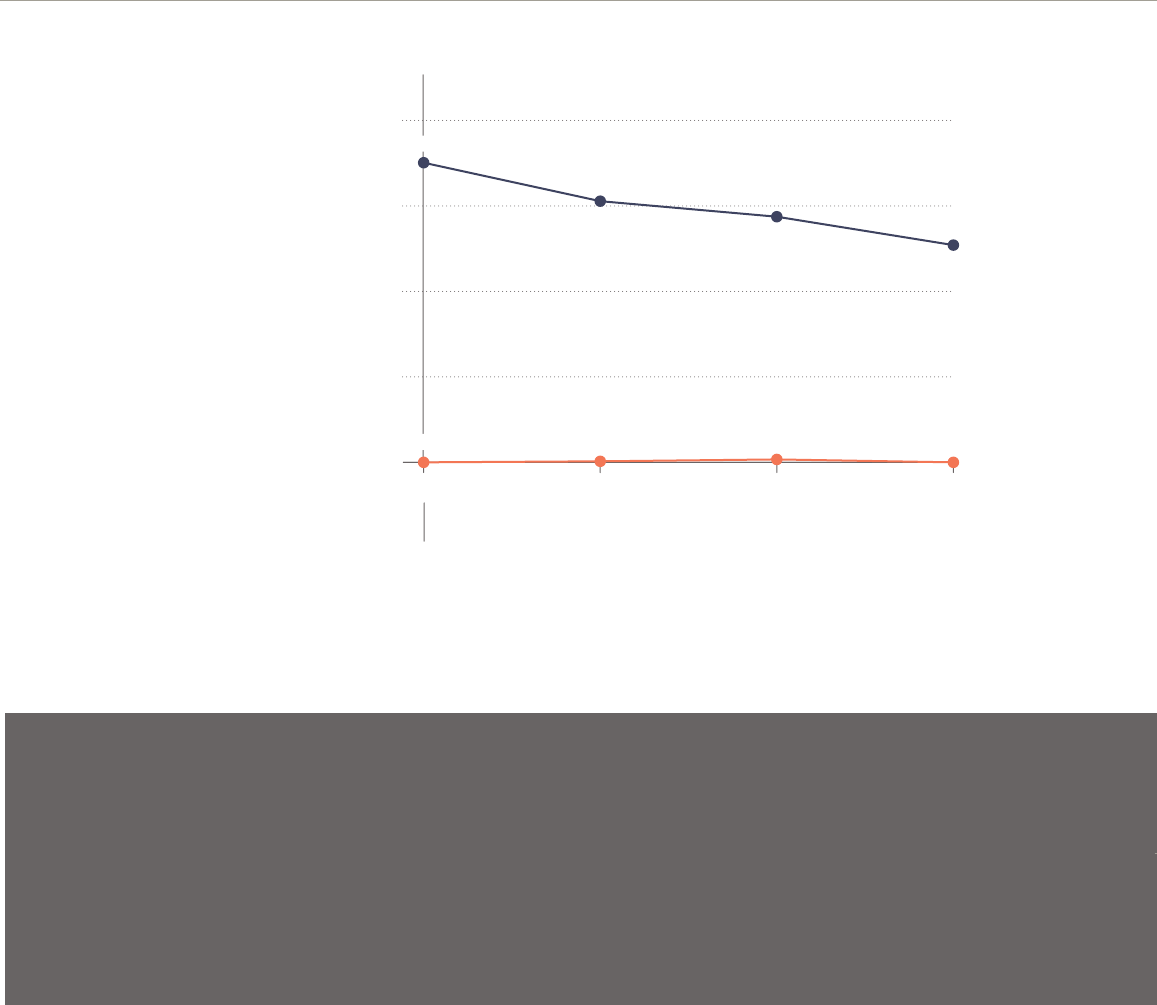
44 GROWING UP PHILLY: The Health and Well-being of Philadelphia’s Children
HOMELESSNESS
Homelessness impacts
every aspect of children’s
physical, cognitive,
and social-emotional
development, placing
children at higher risk for
poor health outcomes in
childhood and later in life.
37
The number of children
experiencing homelessness in
Philadelphia has slowly declined
from 2016 to 2019. The majority of
these children were sheltered, and
in 2019, there were no recorded
cases of unsheltered homeless
children in the point-in-time count.
0%
10%
20%
30%
40%
50%
60%
201820172016201520142013201220112010
Percentage of households burdened
by financial costs of home
49.5%
48.1%
48.1%
52.8%
51.9%
53.2%53.1%
Children in single-parent households
Families receiving public benefits in past year
Homelessness
4th grade reading proficiency
Public school third-graders who
scored proficient or above in reading
| by city
High schoolers who graduated in 4 years during
the 2017–2018 school year
| by race/ethnicity and sex
On-time high school graduation
57.6%
51.3%
52.9%
26.6%
1,528
6
17
0
1,437
1,271
0%
10%
20%
30%
40%
50%
60%
70%
80%
201820172016201520142013201220112010
National
Average:
33.2%
National
Average:
31.0%
0%
10%
20%
30%
40%
50%
60%
70%
WIC
SNAP
201820172016201520142013201220112010
0
500
1,000
1,500
2,000
UNSHELTERED
SHELTERED
2019201820172016
1,753
0
20%
25%
30%
35%
2018201720162015
28.5%
28.4%
30.8%
31.2%
0% 10% 20% 30% 40% 50% 60% 70% 80%
Houston
Chicago
New York City
Philadelphia
34.0%
44.8%
31.6%
68.0%
0%
10%
20%
30%
40%
50%
60%
70%
80%
20182017201620152014201320122011
0%
20%
40%
60%
80%
100%
FemaleMaleAsian*HispanicWhite*Black*
Citywide
62.8%
60.6%
67.5%
55.6%
85.1%
65.4%
78.3%
Children screened for lead exposure before age 24 months
75.1%
50%
60%
70%
80%
201620152014201320122011201020092008200720062005
0%
1%
2%
3%
4%
5%
6%
7%
8%
9%
20182017201620152014201320122011
1.5%
5.9%
Children <24 months screened for lead
with elevated blood levels
50.3%
58.9%
58.1%
60.5%
58.2%
58.8%
60.2%
58.7%
58.4%
56.1%
22.1%
25.8%
26.2%
25.5%
23.5%
26.3%
25.1%
22.1%
56.3%
58.4%
61.3%61.2%
60.6%
ASIAN
HISPANIC
BLACK
WHITE
CITYWIDE
62.8%
67.2%
68.6%
64.8%
68.2%
70.1%
61.5%
55.2%
SOURCE: 2016-2019 Point-in-Time Count, Philadelphia Office of Homelessness Services
“ It is a multigenerational problem—poor
living environment, lower education, and
low income all lead to poorer health.”
— Resident from Philadelphia Community Needs Assessment
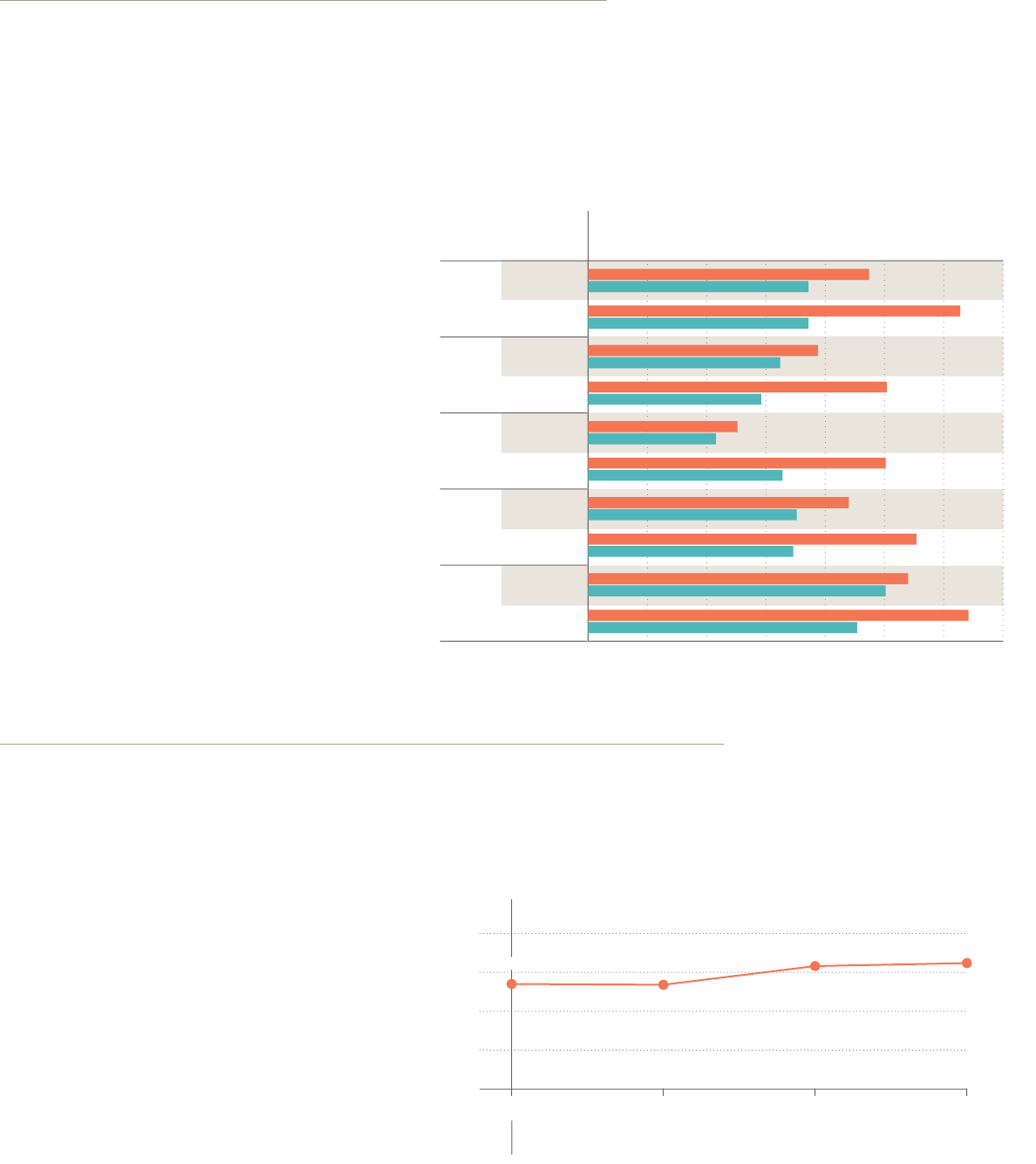
GROWING UP PHILLY: The Health and Well-being of Philadelphia’s Children 45
EDUCATION: Kindergarten Readiness
The School District of Philadelphia uses the Kindergarten Entry Inventory (KEI) tool to
evaluate the skills of incoming kindergarten students within the first 45 days of school.
The results are used by teachers to determine a student’s readiness to learn and decide
how best to meet the individual needs of each student.
The KEI focuses on two validated
dimensions: emerging academic
and learning engagement
competencies.
38,39
Emerging
Academic Competencies measure
children’s early literacy and
mathematics competencies, such
as recognizing letters and words
and counting and identifying
shapes. Learning Engagement
Competencies measure behavioral
regulation, approaches to learning,
and physical control of body
movements.
During the 2018-2019 school
year, the KEI was administered
to 9,127 kindergartners in 145
schools. There were differences in
performance across racial/ethnic
groups. Across all subgroups,
female students consistently
outperformed male students.
0%
10%
20%
30%
40%
50%
60%
201820172016201520142013201220112010
Percentage of households burdened
by financial costs of home
49.5%
48.1%
48.1%
52.8%
51.9%
53.2%53.1%
Children in single-parent households
Families receiving public benefits in past year
Homelessness
4th grade reading proficiency
Public school third-graders who
scored proficient or above in reading
| by city
High schoolers who graduated in 4 years during
the 2017–2018 school year
| by race/ethnicity and sex
On-time high school graduation
57.6%
51.3%
52.9%
26.6%
1,528
6
17
0
1,437
1,271
0%
10%
20%
30%
40%
50%
60%
70%
80%
201820172016201520142013201220112010
National
Average:
33.2%
National
Average:
31.0%
0%
10%
20%
30%
40%
50%
60%
70%
WIC
SNAP
201820172016201520142013201220112010
0
500
1,000
1,500
2,000
UNSHELTERED
SHELTERED
2019201820172016
1,753
0
20%
25%
30%
35%
2018201720162015
28.5%
28.4%
30.8%
31.2%
0% 10% 20% 30% 40% 50% 60% 70% 80%
Houston
Chicago
New York City
Philadelphia
34.0%
44.8%
31.6%
68.0%
0%
10%
20%
30%
40%
50%
60%
70%
80%
20182017201620152014201320122011
0%
20%
40%
60%
80%
100%
FemaleMaleAsian*HispanicWhite*Black*
Citywide
62.8%
60.6%
67.5%
55.6%
85.1%
65.4%
78.3%
Children screened for lead exposure before age 24 months
75.1%
50%
60%
70%
80%
201620152014201320122011201020092008200720062005
0%
1%
2%
3%
4%
5%
6%
7%
8%
9%
20182017201620152014201320122011
1.5%
5.9%
Children <24 months screened for lead
with elevated blood levels
50.3%
58.9%
58.1%
60.5%
58.2%
58.8%
60.2%
58.7%
58.4%
56.1%
22.1%
25.8%
26.2%
25.5%
23.5%
26.3%
25.1%
22.1%
56.3%
58.4%
61.3%61.2%
60.6%
ASIAN
HISPANIC
BLACK
WHITE
CITYWIDE
62.8%
67.2%
68.6%
64.8%
68.2%
70.1%
61.5%
55.2%
EDUCATION: Fourth-grade Reading Proficiency
Children who are not at a proficient reading level by fourth grade are at risk of repeating a
grade and also face educational challenges including risk for dropping out of school.
40
31 percent of Philadelphia’s
public school fourth-graders
scored proficient or above on
tests of reading during the
2018 school year.
Kindergartners scoring at or above benchmarks
for competencies
| by race/ethnicity
21.4%
27.4%
37.1%
51.9%
32.1%
27.7%
25.1%
25.2%
31.4%
22.7%
43.3%
41.9%
5.3%
37.4%
23.8%
40.3%
83.2%
1.2%
1.0%
1.2%
2.2%
1.0%
12.4%
4.7%
21.6%
16.4%
59.3%
0%
20%
40%
60%
80%
100%
HispanicWhite*Black*
Depressive symptoms among teens
| by race/ethnicity and sex
Infant sleep chracteristics
Prenatal substance use among
Philly PRAMS respondents
MALE FEMALE
MALE FEMALE
13-15 year olds who have received
HPV vaccine
| by race/ethnicity
Adequate Prenatal Care
| by race/ethnicity
6,048
6,537
0%
10%
20%
30%
40%
50%
60%
70%
80%
Asian*Hispanic White* Black*Citywide
67.3%
71.9%
63.8%
73.6%
72.9%
0% 5% 10% 15% 20% 25% 30% 35%
White*
Multi-
racial*
Hispanic
Black*
Asian*
Learning
Engagement
Emerging
Academic
Learning
Engagement
Emerging
Academic
Learning
Engagement
Emerging
Academic
Learning
Engagement
Emerging
Academic
Learning
Engagement
Emerging
Academic
18.6%
18.6%
16.2%
10.8%
17.6%
14.6%
16.4%
17.3%
27.0%
22.0%
12.6%
19.4%
23.7%
25.1%
0%
20%
40%
60%
80%
100%
USUALLY
RARELY
NEVER
On their stomachOn their sideOn their back
10.9%
0% 3% 6% 9% 12% 15%
Prescription
pain relievers
Marijuana or hash
Synthetic
marijuana
Methadone, naxolone,
subutex, or Suboxone
Heroin
Amphetamines
Cocaine
Suicide attempts
| by sex and race/ethnicity
Breastfeeding duration 2–6 months postpartum
Breastfeeding indicators
16.2%
8.8%
12.8%
33.3%
57.0%
84.9%
87.8%
80.1%
87.0%
87.6%
79.2%
57.2%
49.3%
59.3%
44.4%
22.2%
10.1%
7.3%
11.1%
0%
5%
10%
15%
FEMALE
MALE
Hispanic White* Black*
0%
10%
20%
30%
40%
50%
17 weeks or more16 weeks< 16 weeks
0%
20%
40%
60%
80%
100%
Any breastfeeding or feeding
pumped milk at 8 weeks
Ever breastfed or
pumped breast milk
ASIAN*HISPANICBLACK*WHITE*ALL
0%
25%
50%
75%
100%
ASIAN*
AMERICAN INDIAN/
ALASKAN NATIVE*
HISPANIC
BLACK*
WHITE*
CITYWIDE
20182017201620152014201320122011201020092008
57.3%
57.3%
55.0%
54.5%
53.2%
52.8%
SOURCE: 2015-2018 School District of Philadelphia *Non-Hispanic
SOURCE: 2015-2018 School District of Philadelphia

46 GROWING UP PHILLY: The Health and Well-being of Philadelphia’s Children
0%
10%
20%
30%
40%
50%
60%
201820172016201520142013201220112010
Percentage of households burdened
by financial costs of home
49.5%
48.1%
48.1%
52.8%
51.9%
53.2%53.1%
Children in single-parent households
Families receiving public benefits in past year
Homelessness
4th grade reading proficiency
Public school third-graders who
scored proficient or above in reading
| by city
High schoolers who graduated in 4 years during
the 2017–2018 school year
| by race/ethnicity and sex
On-time high school graduation
57.6%
51.3%
52.9%
26.6%
1,528
6
17
0
1,437
1,271
0%
10%
20%
30%
40%
50%
60%
70%
80%
201820172016201520142013201220112010
National
Average:
33.2%
National
Average:
31.0%
0%
10%
20%
30%
40%
50%
60%
70%
WIC
SNAP
201820172016201520142013201220112010
0
500
1,000
1,500
2,000
UNSHELTERED
SHELTERED
2019201820172016
1,753
0
20%
25%
30%
35%
2018201720162015
28.5%
28.4%
30.8%
31.2%
0% 10% 20% 30% 40% 50% 60% 70% 80%
Houston
Chicago
New York City
Philadelphia
34.0%
44.8%
31.6%
68.0%
0%
10%
20%
30%
40%
50%
60%
70%
80%
20182017201620152014201320122011
0%
20%
40%
60%
80%
100%
FemaleMaleAsian*HispanicWhite*Black*
Citywide
62.8%
60.6%
67.5%
55.6%
85.1%
65.4%
78.3%
Children screened for lead exposure before age 24 months
75.1%
50%
60%
70%
80%
201620152014201320122011201020092008200720062005
0%
1%
2%
3%
4%
5%
6%
7%
8%
9%
20182017201620152014201320122011
1.5%
5.9%
Children <24 months screened for lead
with elevated blood levels
50.3%
58.9%
58.1%
60.5%
58.2%
58.8%
60.2%
58.7%
58.4%
56.1%
22.1%
25.8%
26.2%
25.5%
23.5%
26.3%
25.1%
22.1%
56.3%
58.4%
61.3%61.2%
60.6%
ASIAN
HISPANIC
BLACK
WHITE
CITYWIDE
62.8%
67.2%
68.6%
64.8%
68.2%
70.1%
61.5%
55.2%
EDUCATION: On-time High School Graduation
Students who graduate
within four years of
beginning high school are
less likely to be incarcerated
or unemployed and have
better health and economic
outcomes later in life.
41,42
Improving high school graduation
and educational attainment rates
can help reduce health inequities,
especially among racial/ethnic
minority populations.
62.8 percent of high school
students in Philadelphia graduated
in four years during the 2017-2018
school year. Non-Hispanic black/
African-American students and
Hispanic students had lower on-
time graduation rates.
SOURCE: 2011-2018 PA Department of Education
0%
10%
20%
30%
40%
50%
60%
201820172016201520142013201220112010
Percentage of households burdened
by financial costs of home
49.5%
48.1%
48.1%
52.8%
51.9%
53.2%53.1%
Children in single-parent households
Families receiving public benefits in past year
Homelessness
4th grade reading proficiency
Public school third-graders who
scored proficient or above in reading
| by city
High schoolers who graduated in 4 years during
the 2017–2018 school year
| by race/ethnicity and sex
On-time high school graduation
57.6%
51.3%
52.9%
26.6%
1,528
6
17
0
1,437
1,271
0%
10%
20%
30%
40%
50%
60%
70%
80%
201820172016201520142013201220112010
National
Average:
33.2%
National
Average:
31.0%
0%
10%
20%
30%
40%
50%
60%
70%
WIC
SNAP
201820172016201520142013201220112010
0
500
1,000
1,500
2,000
UNSHELTERED
SHELTERED
2019201820172016
1,753
0
20%
25%
30%
35%
2018201720162015
28.5%
28.4%
30.8%
31.2%
0% 10% 20% 30% 40% 50% 60% 70% 80%
Houston
Chicago
New York City
Philadelphia
34.0%
44.8%
31.6%
68.0%
0%
10%
20%
30%
40%
50%
60%
70%
80%
20182017201620152014201320122011
0%
20%
40%
60%
80%
100%
FemaleMaleAsian*HispanicWhite*Black*
Citywide
62.8%
60.6%
67.5%
55.6%
85.1%
65.4%
78.3%
Children screened for lead exposure before age 24 months
75.1%
50%
60%
70%
80%
201620152014201320122011201020092008200720062005
0%
1%
2%
3%
4%
5%
6%
7%
8%
9%
20182017201620152014201320122011
1.5%
5.9%
Children <24 months screened for lead
with elevated blood levels
50.3%
58.9%
58.1%
60.5%
58.2%
58.8%
60.2%
58.7%
58.4%
56.1%
22.1%
25.8%
26.2%
25.5%
23.5%
26.3%
25.1%
22.1%
56.3%
58.4%
61.3%61.2%
60.6%
ASIAN
HISPANIC
BLACK
WHITE
CITYWIDE
62.8%
67.2%
68.6%
64.8%
68.2%
70.1%
61.5%
55.2%
“ [Education] is a really serious health issue because if someone
is in poverty, they’ll stay in poverty forever without access to a
good education system.”
— Resident from Philadelphia Community Health Needs Assessment
SOURCE: 2018 PA Department of Education *Non-Hispanic
GROWING UP PHILLY: The Health and Well-being of Philadelphia’s Children 47
REFERENCES
1 March of Dimes. (2018). Low Birth
Weight. Retrieved from: https://www.
marchofdimes.org/complications/low-
birthweight.aspx
2 Collins, J. W., Jr, David, R. J., Handler,
A., Wall, S., & Andes, S. (2004). Very low
birthweight in African American infants: the
role of maternal exposure to interpersonal
racial discrimination. American Journal
of Public Health, 94(12), 2132–2138.
doi:10.2105/ajph.94.12.2132
3 Centers for Disease Control and Prevention.
(2018). Premature Birth. Retrieved from:
www.cdc.gov/reproductivehealth/
features/prematurebirth/index.html
4 American Academy of Pediatrics Section
on Breastfeeding. (2012). Breastfeeding
and the Use of Human Milk. Pediatrics,
129(3):e827-841. 2011-3552.
5 Centers for Disease Control and
Prevention. (2019). About Breastfeeding.
Retrieved from: https://www.cdc.gov/
breastfeeding/about-breastfeeding/why-it-
matters.html
6 Centers for Disease Control and
Prevention. (2019). Breastfeeding Rates.
Retrieved from: https://www.cdc.gov/
breastfeeding/data/nis_data/index.htm
7 Kocherlakota, P. (2014). Neonatal
Abstinence Syndrome. Pediatrics, 134(2).
e547-e561. doi: 10.1542/peds.2013-3524
8 Jilani SM, Frey MT, Pepin D, et al. (2019).
Evaluation of State-Mandated Reporting
of Neonatal Abstinence Syndrome — Six
States, 2013–2017. Morbidity Mortality
Weekly Report, 68:6–10. DOI: 10.15585/
mmwr.mm6801a2
9 https://www.cdc.gov/obesity/childhood/
causes.html
10 Wang, J., Nansel, T. R., & Iannotti, R.
J. (2011). Cyber and traditional bullying:
differential association with depression.
Journal of Adolescent Health, 48(4), 415–
417. doi: 10.1016/j.jadohealth.2010.07.012
11 Centers for Disease Control and
Prevention. (2019). Risk and Protective
Factors for Suicide. Retrieved from:
https://www.cdc.gov/violenceprevention/
suicide/riskprotectivefactors.html
12 Nolen-Hoeksema, S. (2001). Gender
Differences in Depression. Current
Directions in Psychological Science, 10(5).
173-176.
13 National Institute of Mental Health.
(2017). Men and Depression. Retrieved
from: https://www.nimh.nih.gov/health/
publications/men-and-depression/index.
shtml
14 U.S. HHS Suicide Prevention Resource
Center. (2013). Suicide among Racial/
Ethnic Populations in the U.S.: Hispanics.
Retrieved from: https://www.sprc.
org/sites/default/files/migrate/library/
Hispanics%20Sheet%20Aug%2028%20
2013%20Final.pdf
15 The Trevor Project. (2019). The National
Survey on LGBTQ Youth Mental Health
2019. Retrieved from: https://www.
thetrevorproject.org/wp-content/
uploads/2019/06/The-Trevor-Project-
National-Survey-Results-2019.pdf
16 Tsirigotis, K., Gruszczynski, W., &
Tsirigotis, M. (2011). Gender differentiation
in methods of suicide attempts. Medical
Science Monitor: International Medical
Journal of Experimental and Clinical
Research, 17(8), PH65–PH70. doi:10.12659/
msm.881887
17 Moon RY; AAP Task Force on Sudden
Infant Death Syndrome. SIDS and other
sleep-related infant deaths: Evidence
base for 2016 updated recommendations
for a safe infant sleeping environment.
Pediatrics. 2016;138(5):e20162940.
18 Centers for Disease Control and
Prevention. (2019). Physical Activity
Guidelines for School-Aged Children and
Adolescents. Retrieved from: https://www.
cdc.gov/healthyschools/physicalactivity/
guidelines.htm
19 Keller, A., & Bucher Della Torre, S. (2015).
Sugar-Sweetened Beverages and Obesity
among Children and Adolescents: A
Review of Systematic Literature Reviews.
Childhood obesity (Print), 11(4), 338–346.
doi:10.1089/chi.2014.0117
20 Leslie K. (2008). Youth substance use
and abuse: challenges and strategies for
identification and intervention. CMAJ:
Canadian Medical Association Journal,
178(2), 145–148. doi:10.1503/cmaj.071410
21 Centers for Disease Control and
Prevention. (2019, April). High-risk
Substance Use Among Youth. Retrieved
from: https://www.cdc.gov/healthyyouth/
substance-use/index.htm
22 Hanes, M. (2012). Effects and
Consequences of Underage Drinking. U.S.
Department of Justice Office of Juvenile
Justice and Delinquency Prevention.
Retrieved from: https://ojjdp.ojp.gov/
sites/g/files/xyckuh176/files/pubs/237145.
pdf
23 Centers for Disease Control and
Prevention. (2018, Oct). Fact Sheets - Binge
Drinking. Retrieved from: https://www.cdc.
gov/alcohol/fact-sheets/binge-drinking.
html.
24 Centers for Disease Control and
Prevention. (2018). Smoking and Tobacco
Use: Health Effects. Retrieved from:
https://www.cdc.gov/tobacco/basic_
information/health_effects/index.htm
25 National Institute on Drug Abuse. (2017).
Marijuana: Facts for Teens. Retrieved from:
https://www.drugabuse.gov/publications/
marijuana-facts-teens/some-things-to-
think-about
26 Hoffman SD. (2008). Kids Having Kids:
Economic Costs and Social Consequences
of Teen Pregnancy. Washington, DC: The
Urban Institute Press, Print.
27 Hadley J. (2003). Sicker and Poorer—The
Consequences of Being Uninsured: A
Review of the Research on the Relationship
between Health Insurance, Medical Care
Use, Health, Work, and Income. Medical
Care Research and Review. 60(2_suppl):3S-
75S.
28 Weissman JS, Stern R, Fielding
SL, Epstein AM. Delayed access to
health care: risk factors, reasons, and
consequences. Annals of internal medicine.
1991;114(4):325-331.
29 American Academy of Pediatrics Policy
Statement: Recommendations for
Prevention and Control of Influenza in
Children, 2018-2019. Committee on
Infectious Diseases. Pediatrics (2018),
142:4 e20182367; DOI: 10.1542/
peds.2018-2367
30 Cohen, D. et al. (2007). Contribution of
Public Parks to Physical Activity. American
Journal of Public Health, 97, (3). 509-514.
Doi:10.2105/AJPH.2005.072447
31 Sturm, R., & Cohen, D. (2014). Proximity to
urban parks and mental health. Journal of
Mental Health Policy and Economics, 17(1),
19–24.
32 Centers for Disease Control and Prevention.
(2018). Health Effects of Secondhand
Smoke. Retrieved from: https://www.cdc.
gov/tobacco/data_statistics/fact_sheets/
secondhand_smoke/health_effects/index.
htm
33 Spencer, N.et al. (2013). Low income/
socio-economic status in early childhood
and physical health in later childhood/
adolescence: a systematic review. Maternal
and Child Health Journal, 17(3): 424-431.
doi: 10.1007/s10995-012-1010-2.
34 Galobardes, B., Lynch. J., & Smith,
G. (2004). Childhood Socioeconomic
Circumstances and Cause-specific
Mortality in Adulthood: Systematic Review
and Interpretation. Epidemiologic Review,
26(1). 7-21. doi: 10.1093/epirev/mxh008
35 Taylor, L. (2018). Housing And Health:
An Overview Of The Literature. Health
Affairs Health Policy Brief. DOI: 10.1377/
hpb20180313.396577
36 Stack, R. J., & Meredith, A. (2018). The
Impact of Financial Hardship on Single
Parents: An Exploration of the Journey
from Social Distress to Seeking Help.
Journal of Family and Economic Issues,
39(2), 233–242. doi:10.1007/s10834-017-
9551-6
37 Sandel, M. et al. (2018). Timing
and Duration of Pre- and Postnatal
Homelessness and the Health of Young
Children. Pediatrics, 142(4). doi: 10.1542/
peds.2017-4254.
38 Howard, E. C., Dahlke, K., Tucker, N. et al.
(2017). Evidence-based Kindergarten Entry
Inventory for the commonwealth: A journey
of ongoing improvement. Washington, DC:
American Institutes for Research.
39 A Guide to Using The Pennsylvania
Kindergarten Entry Inventory (2019).
Retrieved from: https://www.philasd.
org/earlychildhood/wp-content/uploads/
sites/835/2019/08/2019-KEI-Directions-
Manual.pdf.
40 Hernandez, D. (2012). Double Jeopardy:
How third-grade reading skills and poverty
influence high school graduation. The Annie
E. Casey Foundation. Retrieved from:
https://www.aecf.org/resources/double-
jeopardy/
41 Lansford J. et al. (2016). A Public Health
Perspective on School Dropout and Adult
Outcomes: A Prospective Study of Risk
and Protective Factors from Age 5 to 27.
Journal of Adolescent Health, 58(6). 652-
658.
42 Ibid.

48 GROWING UP PHILLY: The Health and Well-being of Philadelphia’s Children
ACKNOWLEDGEMENTS
REPORT AUTHORS:
Vanessa Assibey-Mensah, PhD, MPH
Thomas Farley, MD, MPH
Stacey Kallem, MD, MSHP
Taylor Sabol
Raynard Washington, PhD, MPH
REPORT CONTRIBUTORS:
Cheryl Bettigole, MD
Michael G. Eberhart, MPH
Chelsey George, MPH
Brittan Hallar, PhD
My-Phuong Huynh, MPH, CPH
Aras S. Islam, JD, MPH
Isaac Lief, MSPH
José Lojo, MPH
Lia Pizzicato, MPH
Allison Thompson, PhD
Jessica Whitley, MPH
DATA SOURCES:
Centers for Disease Control and Prevention
Childhood Developmental Delay Surveillance System, PDPH
Childhood Lead Surveillance Report
Elwynn SEEDS
Infant Toddler Early Intervention Program
Neighborhood Food Retail Access Report
Office of Child Development and Early Learning
Office of Homeless Services
Pennsylvania Department of Education
Pennsylvania Department of Health Vital Statistics
Pennsylvania Health Care Cost Containment Council
Philadelphia Department of Human Services
Philadelphia Youth Risk Behavior Surveillance System
PhilaVax Immunization Registry Data, PDPH
Public Health Management Corporation
School District of Philadelphia
Syndromic Surveillance, PDPH
US Census – American Community Survey
Design: Maskar Design, Philadelphia
1101 Market Street, 13th Floor
Philadelphia, PA 19107
(215) 686-5200
facebook.com/phillyhealth
twitter.com/PHLPublicHealth
